Business Fundamentals, 1st Edition Copyright © 2025 by Kerri Shields is licensed under a Creative Commons Attribution-NonCommercial-ShareAlike 4.0 International License, except where otherwise noted.
Business Fundamentals, 1st Edition Copyright © 2025 by Kerri Shields is licensed under a Creative Commons Attribution-NonCommercial-ShareAlike 4.0 International License, except where otherwise noted.
1
Business Fundamentals is an all-encompassing introductory textbook designed to introduce readers to the business world. Geared toward college and university students, especially those with little to no prior experience in business, this resource lays a strong foundation for individuals embarking on their academic journey with ambitions of pursuing a business career.
The book delves into key functional areas of business, illustrating how departments within organizations work together to generate sales, boost revenue, manage finances, develop innovative products and services, attract and retain customers, manage resources, and make sound decisions. It also addresses essential topics such as corporate social responsibility, business ethics, teamwork, risk management, personal finance, and strategies for academic and professional achievement. Furthermore, it provides an introduction to entrepreneurship and highlights the pivotal roles of managers and leaders in business operations.
Tailored for first-year students, the text includes Canadian-specific insights on economics and banking while maintaining a global outlook with examples from Canada, the United States, and other countries. By blending content from various open educational resources (OERs) with original material, this textbook offers a thorough and engaging overview of the business field.
My varied experiences throughout my career have provided me with insights in many industries, companies, and job roles. Some of the positions I have held include the following:
The variety of job roles I have held and the variety of business projects I have completed have permitted me to gain knowledge and skills from many different types of businesses. I have a keen understanding of business practices, operations management, project management, customer service, marketing practices, tracking revenue and expenses, starting an online business, and how global business in conducted.
I hope you find this OER book interesting and helpful. I will try my best to update it from time to time.
Sincerely,
Kerri Shields
Below is a record of edits and changes made to this book since its initial publication. Whenever edits or updates are made in the text, a record and description of those changes will be noted here. The edition number will only change when there is a major update to the book. The ancillary files (i.e., test bank, slides) that accompany this book always reflect the most recent version.
| Date of Publication | Edition | Revisions |
|---|---|---|
| January 2, 2025 | Business Fundamentals, 1st Edition |
|
Chapter Features and Bloom’s Taxonomy
eCampusOntario is a provincially-funded non-profit organization that leads a consortium of the province’s publicly-funded colleges, universities, and indigenous institutes to develop and test online learning tools to advance the use of education technology and digital learning environments.
This textbook is part of the eCampusOntario open textbook library, which provides free learning resources in a wide range of subject areas. These open textbooks can be assigned by instructors for their classes and can be downloaded by learners to electronic devices. These educational resources are customizable to meet a wide range of learning needs.
If you decide to adopt this book for a course or training program (or other) please report your adoption at the eCampus website. eCampusOntario is keen to report students’ savings and connect with successful OER adopters.
Every attempt has been made to make this OER accessible to all learners and compatible with assistive and adaptive technologies. The Pressbooks content management system was chosen for its commitment to built-in accessibility. The Web version of this resource has been designed to meet accessibility requirements under the Accessibility for Ontarians with Disabilities Act (AODA) and in the Web Content Accessibility Guidelines (WCAG 2.1). In addition to the web version, additional files are available in a number of file formats including PDF, EPUB (for eReaders), and Course Cartridge (for LMS).
If you are having problems accessing this resource, please contact kshields@centennialcollege.ca. Please include the following information: The location of the problem by providing a web address or page description. A description of the problem. The computer, software, browser, and any assistive technology you are using that can help us diagnose and solve your issue (e.g., Windows 10, Google Chrome (Version 65.0.3325.181), NVDA screen reader)
Each chapter has been evaluated using WAVE® and modified as needed to meet zero errors in accordance with WCAG AA. “WAVE® is a suite of evaluation tools that helps authors make their web content more accessible to individuals with disabilities. WAVE can identify many Web Content Accessibility Guideline (WCAG) errors, but also facilitates human evaluation of web content. Our philosophy is to focus on issues that we know impact end users, facilitate human evaluation, and to educate about web accessibility.”
This book is compiled through combining various chapters of different OERs to obtain much of each chapter’s content, although, new content has been added throughout and many statistics, charts, references, and examples have been updated for currency. Thank you to all those who contributed to the open educational resource platforms thereby creating a wealth of information and learning tools.
| Book Chapter | Adaptations from OER Sources | Level 1 Chapter Headings |
|---|---|---|
| Cover Page | Photograph by Ricky Esquivel | Pexels | URL: https://www.pexels.com/photo/high-rise-building-1662159/ | Cover Page |
| Chapter 1 | N/A | N/A |
| Chapter 2 | “Foundations of Business” in NSCC Fundamentals of Business Copyright © 2021 NSCC Edition by NSCC, Pamplin College of Business and Virgina Tech Libraries is licensed under a Creative Commons Attribution-NonCommercial-ShareAlike 4.0 International License, except where otherwise noted. | The Apple World of Business |
| Chapter 2 | “The Nature of Business” in Introduction to Business Copyright © 2023 Web Edition by OpenStax is licensed under Creative Commons Attribution License v4.0, except where otherwise noted. | Economic Benefits When Businesses Earn Profits Factors of Production: The Building Blocks of Business |
| Chapter 2 | “Teamwork in Business” in Fundamentals of Business Copyright © 2022 by Florence Daddey and Rachael Newton is licensed under a Creative Commons Attribution-NonCommercial-ShareAlike 4.0 International License, except where otherwise noted. | Business Participants, Stakeholders, and Functional Areas of Business Group Cohesion Factors that Erode Team Performance |
| Chapter 2 | “Foundations of Business” and “Teamwork in Business” in Fundamentals of Business: Canadian Edition Copyright © 2018 (Canadian Edition) by Pamplin College of Business and Virgina Tech Libraries is licensed under a Creative Commons Attribution-NonCommercial-ShareAlike 4.0 International License, except where otherwise noted. | Team Roles Blocking Roles H5P Class Team Projects Team Contract H5P |
| Chapter 3 | “Management and Leadership in Today’s Organizations” in Introduction to Business Copyright © 2023 by OpenStax is licensed under Creative Commons Attribution License v4.0 | Four Functions of Management Planning, Organizing, Leading |
| Chapter 3 | “Governance Board Membership” in Indigenous Lifeways in Canadian Business Copyright © 2022 by Russell Evans; Michael Mihalicz; and Maureen Sterling is licensed under a Creative Commons Attribution-NonCommercial 4.0 International License, except where otherwise noted. | Governance Board Membership |
| Chapter 3 | “The Role of Managers” in Fundamentals of Business Copyright © 2022 by Florence Daddey and Rachael Newton is licensed under a Creative Commons Attribution-NonCommercial-ShareAlike 4.0 International License, except where otherwise noted. | Controlling Managerial Skills SMART Goals A Six-step Approach to Decision Making |
| Chapter 3 | Fundamentals of Business: Canadian Edition Copyright © 2018 (Canadian Edition) by Pamplin College of Business and Virgina Tech Libraries is licensed under a Creative Commons Attribution-NonCommercial-ShareAlike 4.0 International License, except where otherwise noted. | Motivating Employees |
| Chapter 4 | “New Venture Innovation” in Leading Innovation, 2nd Edition Copyright © 2023 by Kerri Shields is licensed under a Creative Commons Attribution-NonCommercial-ShareAlike 4.0 International License, except where otherwise noted. | All with some adaptations |
| Chapter 4 | Fundamentals of Business Copyright © 2022 by Florence Daddey and Rachael Newton is licensed under a Creative Commons Attribution-NonCommercial-ShareAlike 4.0 International License, except where otherwise noted. | Business Structure (partial with adaptations) |
| Chapter 5 | “Indigenous Entrepreneurship” in Indigenous Lifeways in Canadian Business Copyright © 2022 by Russell Evans; Michael Mihalicz; and Maureen Sterling is licensed under a Creative Commons Attribution-NonCommercial 4.0 International License, except where otherwise noted. | Indigenous Entrepreneurship: Economic Leakage |
| Chapter 5 | “Economics and Business” and “Money and Banking” in Fundamentals of Business Copyright © 2022 by Florence Daddey and Rachael Newton is licensed under a Creative Commons Attribution-NonCommercial-ShareAlike 4.0 International License, except where otherwise noted. | All with some adaptations |
| Chapter 6 | Fundamentals of Business, 3rd edition Copyright © 2020 by Stephen J. Skripak and Ron Poff is licensed under a Creative Commons Attribution-NonCommercial-ShareAlike 4.0 International License, except where otherwise noted. | Personal and Business Ethics (partial with some adaptations) The Individual Approach to Ethics (partial with some adaptations) |
| Chapter 6 | Ethics and Social Responsibility Copyright © 2024 by Business Faculty from Ontario Colleges and eCampusOntario Program Managers is licensed under a Creative Commons Attribution-NonCommercial-ShareAlike 4.0 International License, except where otherwise noted. | Corporate Social Responsibility (CSR) (partial with some adaptations) CSR and Various Stakeholders (partial with some adaptations) Carroll’s Corporate Social Responsibility Pyramid (with adaptations) |
| Chapter 7 | Business in a Global Environment Copyright © 2024 by Business Faculty from Ontario Colleges and eCampusOntario Program Managers is licensed under a Creative Commons Attribution-NonCommercial-ShareAlike 4.0 International License, except where otherwise noted. | The Globalization of Business Why Do Nations Trade? (partial with some adaptations) The Global Environment (partial with some adaptations) Trade Controls (partial with some adaptations) Reducing International Trade Barriers (partial with some adaptations) |
| Chapter 7 | “Business in a Global Environment” in Fundamentals of Business Copyright © 2022 by Florence Daddey and Rachael Newton is licensed under a Creative Commons Attribution-NonCommercial-ShareAlike 4.0 International License, except where otherwise noted. | Why Do Nations Trade? (partial with some adaptations) Measuring Trade Between Nations (partial with some adaptations) Opportunities in International Business (partial with some adaptations) |
| Chapter 8 | “Authenticity and Indigenous Products” in Indigenous Lifeways in Canadian Business Copyright © 2022 by Russell Evans; Michael Mihalicz; and Maureen Sterling is licensed under a Creative Commons Attribution-NonCommercial 4.0 International License, except where otherwise noted. | Authenticity and Indigenous Products |
| Chapter 8 | Marketing: Providing Value Copyright © 2024 by Business Faculty from Ontario Colleges and eCampusOntario Program Managers is licensed under a Creative Commons Attribution-NonCommercial-ShareAlike 4.0 International License, except where otherwise noted. | What is Marketing? (with some adaptations) Target Markets (with some adaptations) The Marketing Mix (with some adaptions) |
| Chapter 9 | Operations Management Copyright © 2024 by Business Faculty from Ontario Colleges and eCampusOntario Program Managers is licensed under a Creative Commons Attribution-NonCommercial-ShareAlike 4.0 International License, except where otherwise noted. | Operations Management for Manufacturing (partial with some adaptations) Production Planning (partial with some adaptations) Production Control (partial with some adaptations) Graphical Tools: Gannt and PERT charts Production Process Technologies (with some adaptations) Operations Management for Service Providers (with some adaptations) Producing for Quality (with some adaptations) |
| Chapter 10 | “Overcoming Entrepreneurial Challenges” in Indigenous Lifeways in Canadian Business Copyright © 2022 by Russell Evans; Michael Mihalicz; and Maureen Sterling is licensed under a Creative Commons Attribution-NonCommercial 4.0 International License, except where otherwise noted. | Overcoming Entrepreneurial Challenges: Financing |
| Chapter 10 | “Accounting and Financial Information” in Fundamentals of Business, 3rd edition Copyright © 2020 by Stephen J. Skripak and Ron Poff is licensed under a Creative Commons Attribution-NonCommercial-ShareAlike 4.0 International License, except where otherwise noted. | The Role of Accounting
|
| Chapter 10 | “Money and Banking” in Fundamentals of Business Copyright © 2022 by Florence Daddey and Rachael Newton is licensed under a Creative Commons Attribution-NonCommercial-ShareAlike 4.0 International License, except where otherwise noted. | Sources of Funding |
| Chapter 10 | “Accounting and Financial Information” in Introduction to Canadian Business, Accounting and Financial Information Copyright © 2024 by Business Faculty from Ontario Colleges and eCampusOntario Program Managers is licensed under a Creative Commons Attribution-NonCommercial-ShareAlike 4.0 International License, except where otherwise noted. | The Functions of Financial Statements |
| Chapter 10 | “Accounting and Financial Information” in Fundamentals of Business: Canadian Edition Copyright © 2018 (Canadian Edition) by Pamplin College of Business and Virgina Tech Libraries is licensed under a Creative Commons Attribution-NonCommercial-ShareAlike 4.0 International License, except where otherwise noted. | Financial Statement Analysis |
| Chapter 11 | Corporate Indigenous Inclusion” in Indigenous Lifeways in Canadian Business Copyright © 2022 by Russell Evans; Michael Mihalicz; and Maureen Sterling is licensed under a Creative Commons Attribution-NonCommercial 4.0 International License, except where otherwise noted. | Corporate Indigenous Inclusion: Equity, Diversity, and Inclusion (EDI) |
| Chapter 11 | “Managing Human Resources” in Managing Human Resources Copyright © 2024 by Business Faculty from Ontario Colleges and eCampusOntario Program Managers is licensed under a Creative Commons Attribution-NonCommercial-ShareAlike 4.0 International License, except where otherwise noted. | All (except Unions) with some adaptations |
| Chapter 12 | Risk Management – Supply Chain and Operations Perspective Copyright © 2024 by Azim Abbas and Larry Watson is licensed under a Creative Commons Attribution-NonCommercial-ShareAlike 4.0 International License, except where otherwise noted. | What is Risk? (partial with adaptations)
|
| Chapter 13 | “Personal Finances” in Introduction to Canadian Business, Personal Finances Copyright © 2024 by Business Faculty from Ontario Colleges and eCampusOntario Program Managers is licensed under a Creative Commons Attribution-NonCommercial-ShareAlike 4.0 International License, except where otherwise noted. | All with some adaptations |
(Note: This reference list was produced using the auto-footnote and media citation features of Pressbooks)
eCampus Ontario. (2021). About. https://www.ecampusontario.ca/about/#:~:text=eCampusOntario%20is%20a%20provincially-funded%20non-profit%20organization%20that%20leads,use%20of%20education%20technology%20and%20digital%20learning%20environments.
WAVE. (n.d.). WAVE accessibility evaluation tool. https://wave.webaim.org/
1
After reading this chapter, you should be able to do the following:
Why should you enroll in a college or university program? One of the most compelling reasons to attend college or university is to obtain credentials, learn skills and gain knowledge that will help you earn more money than you could without a postsecondary credential than you could over your lifetime. Some of the other benefits of obtaining a higher education credential include the following:
Lifelong learning is the ongoing, voluntary, and self-motivated pursuit of knowledge for either personal or professional reasons. Lifelong learning is a workplace necessity for most employees. It can help employees adapt to changing work demands, improve their performance, and increase their job satisfaction. Many organizations will provide professional development funds for employees’ personal learning and growth. Some companies may require employees to commit to a set number of months or years with the company after completing a company-funded professional development program.
In addition to the above benefits of obtaining a college or university credential, you will also build new skills that will help you obtain a job, retain the position, and be successful in growing your career. Specific jobs may require specific hard skills, such as a Web Designer who needs hard skills in using software in order to build websites. Beyond hard skills, soft skills are required in order for you to communicate, work in teams, and manage yourself professionally in the workplace. Soft skills are considered transferrable skills and are often considered employability skills. Employability skills are the skills you need to enter, stay in, and progress in the world of work—whether you work on your own or as part of a team. Some of the most important employability skills you will need is the ability to work well with others, be a productive team member, and communicate well with others. Did you know that 90% of projects require team participation as opposed to individual responsibility, and 31% of companies say that miscommunications about project objectives is the number one reason why projects fail?
The Conference Board of Canada provides The Employability Skills Toolkit for download. The Toolkit is a guide to the skills needed to adapt and succeed in the world of work. It includes explanations and descriptions of these skills and ways to build them. The Toolkit includes key information about how to become job-ready and exercises to practice and apply what you have learned. These activities encourage thinking about which skills you have, which skills you may need to work on, and how you can improve them. The updated version of the Toolkit also includes information on how to prepare for and succeed in the future of work. To help you understand some of the skills that are in high demand by employers, you’ll find new content on digital skills and social and emotional skills. Given the impacts of technology and automation on the working world, this version of the Toolkit also includes a new section on how to develop a change-ready, lifelong learning mindset, which is essential to help you navigate job transitions.
Employability skills fall into four broad categories as shown in Figure 1.1 below.

According to a blog post by Matt Gavin at Harvard Business School Online, every professional should know the following business fundamentals:
The communication skills identified by the Conference Board of Canada include the following.
In every job you will be required to work with people. In college and university, you often work with your peers on group projects. Interacting with colleagues, managers, customers, and suppliers is part of everyday communication.
The teamwork skills identified by the Conference Board of Canada, Work with Others, include the following:
The teamwork skills identified by the Conference Board of Canada, Participate in Projects and Tasks, include the following:
Play the YouTube video below, “Employability Skills – Have You Got them?” to learn about the soft skills you need to succeed in your academic career as well as your business career. Transcript for “Employability Skills – Have You Got Them?” Video [PDF–New Tab]. Closed captioning is available on YouTube.
College and university can be challenging when it comes to allocating time for studying and completing assignments.

Below is a list of 10 study tips that will help get you through those long study sessions.
A technique you might apply to reduce reading time is the SQ4R reading system. The SQ4R reading system is designed to help you study your textbook and apply reading and notetaking skills. The letters in SQ4R stand for five steps: survey, question, read, reflect, recite, and review. These steps will help you gain more from what you read and be better prepared for quizzes and exams. In other words, you will maximize the return on your time investment for reading!
It is important for you to identify your learning style. Which way do you learn best? Do you learn best by doing, by observing, by listening, by watching, or through a combination of these things. Learning styles refers to the different methods of learning or understanding new information, the way a person takes in, understands, expresses and remembers information. There are 4 predominant learning styles: Visual, Auditory, Read/Write, and Kinaesthetic. Often colleges and universities have assessments you can take that will help you identify your learning style as well as your strengths and abilities. The majority of people have one dominant learning style, although most people benefit from several different learning styles. When learning is presented in a way that is consistent with someone’s dominant learning style, they tend to learn more quickly and with less frustration.
When you are enrolled in a course, and you find you are struggling to learn the concepts, you may need to make a plan to help yourself. For example, if the professor is teaching in lecture format and you need more examples and videos then after class you might search online for videos or examples that will help you understand what the professor’s lecture was about. You might also ask questions and request additional exercises or a meeting with the professor, or maybe, you would do better by obtaining a tutor. You need to be proactive in your education and feel free to discuss issues that you may have with the professor, your academic advisor and your peers. You may be able to form a learning-buddy relationship with a peer which may help you both understand the lessons better.
Identify what support the institution provides for students and utilize what you need to be successful. Ask yourself these questions:
You will need to find answers to your many questions. Use the college or university website and read about student experience, student support, student services that the institution provides. When you are in need of support ask for it. You academic advisor, international advisor, professor, program coordinator, and service areas at the college or university can help. Everyone working at the college or university is there to support your learning journey and provide you with the tools and resources you need to be successful.
One of the most important things you need to understand in each course is the course outline (also referred to as course syllabus). You need to review this the first week of class and ask your professor questions if you do not understand how you will be graded. The course outline should provide you with a breakdown of what you can expect to be taught in the course, what the course learning outcomes (sometime called objectives) are, and how you will be assessed on your learning. Often assessment due dates are provided in advance, and you should record these in a calendar and always, always, work ahead of due dates. When you leave assignments until the night before they are due to complete them you are not preparing for success. So many things may go wrong, such as a technology failure or you may find you do not understand some of the instructions or you may find the assignment is much more time consuming than you had thought. You should always plan ahead and be prepared for things that may go wrong. Plan to have your assignments completed a day or two ahead of the due date, that way if your technology does fail, you will be able to use another device, or if you don’t understand some instructions then you have time to clarify these with the professor.
It is important to keep your grades as high as you can. You do this by planning your time well, keeping a calendar and working ahead of due dates, asking questions when you need help, and completing the learning tasks you are assigned. When students do the readings assigned, watch the videos assigned, and attend and participate in class, they often do very well in achieving high grades. Your GPA score (Grade Point Average) is a cumulation of the grades across the courses throughout your program. To graduate your institution will have a minimum GPA score you must achieve, and should you wish to further your education in the future your GPA score may factor into whether or not you will be accepted for enrollment at specific colleges or universities. If you decide in the future to study another program at a different institution you may want to apply for transfer credit and most colleges and universities have minimum grade requirements for accepting transfer credits (this is often a C grade, but check with the institution). Many schools calculate GPAs differently, but you can usually find this information on the institution’s website.

Academic integrity is a commitment to acting with honesty, trust, fairness, respect, and responsibility in academic work and studies. A few questions to ask yourself when completing school assignments include the following.
The answer to each of these questions is generally, NO!
With that said, there may be occasions when your professor allows you to use generative AI to help you research or get started with a writing assignment. When you do use ChatGPT or other AI tools you will need to cite it as a source of information in the same way you would cite a website, video, book, or other source of information you may use. Remember that you may only use the resources permitted by the professor to aid you in completing assignments, otherwise, your work may be identified as plagiarized or in breach of the academic integrity policy. Be sure you familiarize yourself with the institution’s policies, and specifically the academic integrity policy.
Formatting standards for documentation are common in higher education as well as in the workplace. Most companies have documentation standards that apply to all correspondence that leaves the company, such as business letters, reports, flyers, brochures, marketing media, website media, and social media. Businesses work hard to portray a certain image to the public and they want that image to be consistent across all their communication channels. A citation style dictates the information necessary for a citation and how the information is ordered, as well as punctuation and other formatting. Popular citation styles such as APA and MLA provide guidelines to authors in how to format documents for professionalism, for crediting other people’s words and ideas via citations and references to avoid plagiarism, and for describing other people using inclusive, bias-free language.
Most college and university libraries provide style guides for APA, MLA and other document formats. The Online Writing Lab (OWL) Purdue Citation Chart provides examples of various citations for both in-text and reference list citations. Additional details are available at the OWL Purdue website. Review OWL Purdue APA Formatting Guidelines and the library guides from CSUDH are also very comprehensive.
Play the YouTube video below, “Introduction to Citation Styles: APA 7th ed.” to learn about the purpose and basic conventions of citing sources in-text and in a reference list using the American Psychological Association (APA) Style, 7th edition, 2019. Transcript for “Introduction to Citation Styles: APA 7th ed.” Video [PDF–New Tab]. Closed captioning is available on YouTube.
The book entitled “The 7 Habits of Highly Effective People” written by Stephen R. Covey is based on Covey’s belief that the way we see the world is entirely based on our own perceptions. In order to change a given situation, we much change ourselves, and in order to change ourselves, we must be able to change our perceptions.
Spend a little time researching the following seven habits to really understand what they mean:
Career success can be highly subjective, meaning each person gets to define what success looks like for them. For some people, a successful career is one that provides the most enjoyment. For others, a successful career is one that provides certain financial benefits. Regardless of how you define it, achieving your goal of a successful career can be an exciting and empowering experience.
Time management is an essential life skill and one that will make a huge difference in your career. Time management is the practice of planning and controlling how you use your time to be more productive and efficient. It involves prioritizing tasks, setting deadlines, and avoiding distractions. The goal of time management is to complete important tasks on time while also balancing your personal, professional, and academic responsibilities. Some benefits of effective time management include less stress, more time for creative or strategic projects, better work quality, and more self-confidence. Managing time is an essential part of every busy business professional’s job. Most professionals use an electronic calendar to track appointments, meetings, events, etc.
Play the YouTube video below, “Time Management Techniques for Stress Free Productivity” YouTube video below for some time management tips for stress-free productivity. Transcript for “Time Management Techniques for Stress Free Productivity” Video [PDF–New Tab]. Closed captioning is available on YouTube.
Stress is a part of everyone’s life. Stress is a physical, mental, and emotional response to a difficult event. Stress Management offers a range of ways to help you better deal with stress and difficulty in your life. Engaging in activities that support self-care may help reduce stress and anxiety. These can include exercise and mindfulness practices.
Listed below are 16 evidence-based ways to relieve stress:

Get more physical activity
Often students become stressed when there is a test to take. Your institution may provide some test-taking tips. Below are a few test-taking tips from various colleges and universities.
The chapter, “Managing Personal Finances”, goes into more detail on this subject, for now let’s get introduced to the concepts.
Students become stressed when they need to pay bills and don’t have enough funds to do so. Colleges and universities understand that students have complex lives and often need to work part-time jobs in order to pay their bills. With that said, as a full-time student, these institutions expect you to prioritize your studies since you have paid tuition fees to enroll. No student wants to fail a course and have to pay to re-take it, but if you do not focus on your studies this may happen. Planning your time effectively is a good way to ensure you are spending enough time on your studies.
Entering college is an exciting and sometimes intimidating venture for many young adults—often it’s the first time many leave the warmth and safety of their parent’s home and have to live and manage on their own. One specific area that causes young adults difficulty is learning to budget.
A budget is a financial plan that estimates how much money you’ll make and spend over a specific period of time. It can be used by individuals, families, businesses, and governments. The chapter, “Managing Personal Finances” goes into more detail on this subject, for now let’s get introduced to the concepts.
Below are a few suggestions on how college students can more effectively manage their money while furthering their education:
Creating and using a budget is not just for those who need to closely monitor their cash flows from month to month because money is tight. Almost everyone can benefit from budgeting. Building the right college student budget for your situation can help you stay on track for your financial life after graduation. Plus, learning to build and maintain a budget is an important skill to carry with you for the rest of your life. If you aren’t sure how to create the perfect college budget that works for you, then check out this free budgeting course. It will walk you through the steps of building a budget that actually sticks.
Play the YouTube video below, “Time Management Techniques for Stress Free Productivity” YouTube video below for some time management tips for stress-free productivity. Transcript for “How To: The Easiest and Simplest Way to Create a Monthly Budget! 6-Minute Process” Video [PDF–New Tab]. Closed captioning is available on YouTube.
College and university students often wonder how they will gain business work experience. Many work part-time jobs while attending school, but these jobs are usually entry-level service jobs paying minimum wage. Some students have no work experience or have never worked in Canada. Most students hope to work in the field they are studying after they graduate. So how can you gain business experience in your field of study that will help you obtain a job after you graduate?
Review the list below for some ideas on how to gain work experience:
The Careers and Co-op office within your institution may provide support and resources that will help you find part-time work while you are studying and/or a co-op placement (if this is an option within your program).
Business etiquette is a type of social and business behaviour that team members (whether at school or work) are expected to exhibit. It includes how people communicate, dress, and conduct themselves in meetings and social events. Adhering to business etiquette can help foster positive relationships and a harmonious work environment. Some examples of business etiquette include treating others with courtesy and consideration, controlling your emotions and actions, being accountable for your actions and obligations, and meeting deadlines and admitting mistakes.
So, what are some pet peeves you have? Pet peeves are the thing that annoy you, often things other people do that bother you. Check out this list of 87 Common Things That Annoy People. A good guideline is to try not to be the one who is annoying others, especially when working on a team or taking a potential customer out for lunch. Here are a few annoyances college students have shared with their professor over the years:
There are many things that annoy us all, but we need to remember that other people may have grown up with cultural norms that differ from your own. Cultural norms are the standards we live by. They are the shared expectations and rules that guide behavior of people within social groups. Cultural norms are learned and reinforced from parents, friends, teachers and others while growing up in a society. Norms often differ across cultures, contributing to cross-cultural misunderstandings. For example, it may be customary in certain parts of China and India to belch after a meal, but in Canada and the U.S. this would be considered rude. Punctuality around the world varies: Being on time is important in Canada and U.S. business settings, but being on time is not a concern in Greece, Brazil, or Mexico. In some cultures, they do not sit on toilet seats, so you may have noticed shoe prints on toilet seats or spillage, or unflushed toilets. This is a bathroom etiquette issue; in Canada toilet seats are expected to be clean and dry. The main thing with etiquette is respect the cultural norms of other people, and exercise professionalism, and practice business etiquette at the location you are in. You will learn more about cultural norms and inter-cultural communication when you complete a course in organizational behaviour or business communications.
Professionalism is a broad concept that includes a person’s attitude, work ethic, and conduct. It also involves being punctual, dressing appropriately, and having a positive attitude. Business etiquette is a key component of professionalism. Some of the traits of professionalism include being dependable and accountable, demonstrating a sense of etiquette, making ethical decisions, being a team player, and maintaining a positive outlook.
Watch “The Five Zones of Professional Etiquette” YouTube video below to learn about professional etiquette. Transcript for “The Five Zones of Professional Etiquette (Student Version)” Video [PDF–New Tab]. Closed captioning is available on YouTube.
To complete this exercise, you may need to do a little research on The 7 Habits of Highly Effective People:
An interactive H5P element has been excluded from this version of the text. You can view it online here:
https://ecampusontario.pressbooks.pub/businessfundamentals/?p=5#h5p-1
(Note: This reference list was produced using the auto-footnote and media citation features of Pressbooks)
Rego, A. (2021, February 23). Prepare for Canada. Higher education offers benefits to newcomers. https://www.prepareforcanada.com/before-you-arrive/settling-in-canada/higher-education-offers-benefits-to-newcomers/#:~:text=Three%20Benefits%20of%20Higher%20Education%20in%20Canada%201,in%20Canada.%20…%203%203.%20Network%20with%20Others
World Education Services. About WES credential evaluation. https://knowledge.wes.org/WES_Credential_Evaluations.html
Andrews, G. (2024, August 12). Is college worth it? Consider these factors before enrolling. Forbes. https://www.forbes.com/advisor/education/student-resources/is-a-college-degree-worth-it/
Statistics Canada. (2023, October 4). Employment income statistics by highest level of education: Canada, provinces and territories, census divisions and census subdivisions. https://www150.statcan.gc.ca/t1/tbl1/en/tv.action?pid=9810041101
Kumok, Z. (2023, June 14). 7 compelling reasons why you should go to college. Forbes. https://www.forbes.com/advisor/student-loans/why-should-you-go-to-college/
Kumok, Z. (2023, June 14). 7 compelling reasons why you should go to college. Forbes. https://www.forbes.com/advisor/student-loans/why-should-you-go-to-college/
Kumok, Z. (2023, June 14). 7 compelling reasons why you should go to college. Forbes. https://www.forbes.com/advisor/student-loans/why-should-you-go-to-college/
Stone, K. (2020, July 9). The state of project management in 2023 [42 statistics]. https://saaslist.com/blog/project-management-statistics/#:~:text=90%25%20of%20projects%20require%20team,participation%20as%20opposed%20to%20individual%20responsibility
Conference Board of Canada. (2023). Finding your employability skills. https://www.conferenceboard.ca/future-skills-centre/tools/finding-your-employability-skills/
Gavin, M. (2019, September 26). 7 business fundamentals professionals in every industry should know. https://online.hbs.edu/blog/post/business-fundamentals
The Conference Board of Canada. (2022). Finding your employability skills. https://www.conferenceboard.ca/future-skills-centre/tools/finding-your-employability-skills/
The Conference Board of Canada. (2022). Finding your employability skills. https://www.conferenceboard.ca/future-skills-centre/tools/finding-your-employability-skills/
The WOW Show. (2020). Employability skills – have you got them? [Video]. YouTube. https://www.youtube.com/watch?v=tKKPUYfOkvw
Claire. (2024, August 1). 12 insanely smart study hacks for college students. Collegesavvy. https://mycollegesavvy.com/study-hacks-for-college-students/
Utah State University. (n.d.). SQ4R reading system. [PDF]. https://www.usu.edu/academic-support/files/SQ4R_Reading_System.pdf
CSUDH Library. (2019, October 29). Introduction to citation styles: APA 7th ed. [Video]. YouTube. https://www.youtube.com/watch?v=_fVv2Jt0o18&t=2s
Nicholson, R. (2024, July 16). 7 habits of highly effective people. Hubspot. https://blog.hubspot.com/sales/habits-of-highly-effective-people-summary#7-habits-of-highly-effective-people
Herrity, J. (2024, August 15). 9 tips for building a successful career you enjoy. https://www.indeed.com/career-advice/career-development/building-career
Brower, T. (2024, October 31). How 5 mindfulness techniques can help your workplace productivity. https://www.forbes.com/sites/tracybrower/2024/10/28/how-5-mindfulness-techniques-can-help-your-workplace-productivity/
Greiser, C. (2018, April 26). Unleashing the power of mindfulness in corporations. https://www.bcg.com/publications/2018/unleashing-power-of-mindfulness-in-corporations
Mind Tools, (n.d.). Mindfulness in the workplace. https://www.mindtools.com/adzev6y/mindfulness-in-the-workplace
Brower, T. (2024, October 31). How 5 mindfulness techniques can help your workplace productivity. https://www.forbes.com/sites/tracybrower/2024/10/28/how-5-mindfulness-techniques-can-help-your-workplace-productivity/
Young Entrepreneurs Forum. (2016, August 15). Time management techniques for stress free productivity. [Video]. YouTube. https://youtu.be/IGVQPU-L7cQ
Kubala, J. (2023, July 12). 16 simple ways to relieve stress. https://www.healthline.com/nutrition/16-ways-relieve-stress-anxiety#3-Minimize-phone-use-and-screen-time
Segal, T. (2024, October 26). Money management for college students. https://www.investopedia.com/financial-edge/0712/money-management-for-college-students.aspx#:~:text=Key%20Takeaways%201%20College%20students%20need%20to%20set,purchases%20is%20also%20a%20key%20money%20management%20tactic.
Ganti, A. (2024, October 17). What is a budget? Plus 11 budgeting myths holding you back. https://www.investopedia.com/terms/b/budget.asp
Sharkey, S. (2024, September 27). How to create a college student budget you’ll actually use. https://www.clevergirlfinance.com/college-student-budget/
Budgets, S. (2019, July 19). How to: The easiest and simplest way to create a monthly budget! 6-Minute process. [Video]. YouTube. https://www.youtube.com/watch?v=3pslPbfpnzk
Bovee and Thill. (Young Entrepreneurs Forum. (2018, January 20). The five zones of professional etiquette (student version). [Video]. YouTube. https://www.youtube.com/watch?v=A9Q20hZ5ZX4
2
After reading this chapter, you should be able to do the following:
North American business history is divided into the following several distinct time periods:
Canada’s system of government is based on the British parliamentary model and is quite distinct from the presidential system operating in the United States. Canada’s legislative and executive jurisdiction is constitutionally divided between the federal government and the ten provincial governments. A business may be regulated at three levels: federal, provincial, and municipal. A business may also be affected by the policies and decisions of regulatory and administrative bodies and tribunals.
Government influences business activity through the roles it plays. Some of these include the following:
Take a moment to think about the many different types of businesses you come into contact with on a typical day. As you drive to class, you may stop at a gas station that is part of a major national oil company and grab lunch from a fast food chain such as Taco Bell, McDonald’s, or the neighbourhood pizza place. Need more cash? You can do your banking on a smartphone or another device via mobile apps. You don’t even have to visit the store anymore: online shopping brings the stores to you, offering everything from clothes to food, furniture, and concert tickets.
A business is an organization that strives for a profit by providing goods and services desired by its customers. Businesses meet the needs of consumers by providing medical care, automobiles, and countless other goods and services. Goods are tangible items manufactured by businesses, such as laptops. Services are intangible offerings of businesses that can’t be held, touched, or stored. Physicians, lawyers, hairstylists, car washes, and airlines all provide services. Businesses also serve other organizations, such as hospitals, retailers, and governments, by providing machinery, goods for resale, computers, and thousands of other items.
Revenue is the money a company receives by providing services or selling goods to customers. Costs are expenses including rent, salaries, supplies, transportation, and many other expenses a company incurs from creating and selling goods and services. For example, some of the costs Microsoft incurred by developing its software include salaries, facilities, and advertising. If Microsoft has money left over after it pays all costs, it has a profit. A company with costs greater than revenues incurs a loss. When a company such as Microsoft uses its resources intelligently, it can often increase sales, hold costs down, and earn a profit. Not all companies earn profits, but that is the risk of being in business. Risk is the potential to lose time and money or otherwise not be able to accomplish an organization’s goals. For example, the Canadian Red Cross faces the risk of not meeting the demand for victims of disaster (patients who need blood) if there are not enough blood donors. Businesses such as Microsoft face the risk of falling short of their revenue and profit goals. In Canadian business today, there is generally a direct relationship between risks and profit: the greater the risks, the greater the potential for profit (or loss).
The owner or shareholders of a business are not the only people who benefit from the business’s earned profits. A successful business provides employment opportunities, goods and services people need and want, tax payments to the government, and spends money buying resources which stimulates the economy. Socially responsible firms contribute even more by adopting policies that promote the well-being of society and the environment while lessening the negative impacts on them.
Not every organization that generates revenue and pays expenses is considered a for-profit business. Not all organizations strive to make a profit. A not-for-profit organization is an organization that exists to achieve some goal other than the usual business goal of profit at all costs. Often these organizations serve communities through social, educational, or political means. Organizations such as universities and colleges, hospitals, environmental groups, and charities are not-for-profit organizations. Charities such as Habitat for Humanity, the United Way, the Canadian Cancer Society, and the World Wildlife Fund are not-for-profit organizations, as are most hospitals, zoos, arts organizations, civic groups, and religious organizations. Over the last 20 years, the number of not-for-profit organizations—and the employees and volunteers who work for them—has increased considerably. Government is our largest and most pervasive not-for-profit group.
Like their for-profit counterparts, these groups set goals and require resources to meet those goals. However, their goals are not focused solely on profits. For example, a not-for-profit organization’s goal might be feeding the poor, preserving the environment, increasing attendance at the ballet, or preventing drunk driving. Not-for-profit organizations do not compete directly with one another in the same manner as, for example, Ford and Honda, but they do compete for talented employees, people’s limited volunteer time, and donations.
The boundaries that formerly separated not-for-profit and for-profit organizations have blurred, leading to a greater exchange of ideas between the sectors as for-profit businesses are now addressing social issues. Successful not-for-profits apply business principles to operate more effectively. Not-for-profit managers are concerned with the same concepts as their colleagues in for-profit companies: developing strategy, budgeting carefully, measuring performance, encouraging innovation, improving productivity, demonstrating accountability, and fostering an ethical workplace environment.
In addition to pursuing a museum’s artistic goals, for example, top executives manage the administrative and business side of the organization: human resources, finance, and legal concerns. Ticket revenues cover a fraction of the museum’s operating costs, so the director spends a great deal of time seeking major donations and memberships. Today’s museum boards of directors include both art patrons and business executives who want to see sound fiscal decision-making in a not-for-profit setting. Therefore, a museum director must walk a fine line between the institution’s artistic mission and financial policies.
Successful businesses help to raise a country’s standard of living because they create the goods and services that are the basis of our standard of living. The standard of living of any country is measured by the output of goods and services people can buy with the money they have. It’s the ease with which people living in a time or place are able to satisfy their needs and wants. It is generally measured by standards such as income per person and poverty rate. Other measures are also used, such as access to and quality of health care, income-growth inequity, availability of employment, environmental quality, and educational standards. One measure of the standard of living is the Human Development Index (HDI), which was developed by the United Nations. Canada was ranked #18 out of 193 countries and territories worldwide on the 2023/2024 HDI report (Refer to Table 2.1).
| Country | Rank |
|---|---|
| Canada | 18 |
| United States | 20 |
| Germany | 7 |
| United Kingdom | 15 |
| Switzerland | 1 |
| Norway | 2 |
| Hong Kong | 4 |
| China | 75 |
| Finland | 12 |
| India | 134 |
| Somalia | 193 |
| Pakistan | 164 |
| Yemen | 186 |
Businesses play a key role in determining our quality of life by providing jobs, goods, and services to society. Quality of life refers to the general level of human happiness based on factors including life expectancy, educational standards, health, sanitation, and leisure time. It takes into account not only the material standard of living, but also more intangible aspects that make up human life. Building a high quality of life is a combined effort between businesses, government, and not-for-profit organizations. In a Mercer Insights report for 2023, Vienna, Austria, ranked highest in quality of life, followed by Zurich, Switzerland; Auckland, New Zealand; and Copenhagen, Denmark. It may come as a surprise that not one of the world’s top cities is in the United States: seven of the top 10 locations are in western Europe, two are in Australia/New Zealand, and one is in Canada (#8 on the list). At the other end of the scale, Baghdad, Iraq, is the city scoring the lowest on the annual survey.
Businesses must observe trends in business as many trends stem from consumer demands and preferences. Companies must keep up with their competitors, observe changes in the business environment, and meet consumer demands if they wish to stay in business.
Some of the current business and consumer trends include the following:
Why is Apple so successful?
In 1976 Steve Jobs and Steve Wozniak created their first computer, the Apple I. They invested a mere $1,300 and set up business in Jobs’ garage. Three decades later, their business—Apple Inc.—has become one of the world’s most influential and successful companies. Jobs and Wozniak were successful entrepreneurs: those who take the risks and reap the rewards associated with starting a new business enterprise.

Did you ever wonder why Apple flourished while so many other young companies failed? How did it grow from a garage start-up to a company generating over $394 billion in sales in 2022? How was it able to transform itself from a nearly bankrupt firm to a multinational corporation with locations all around the world? You might conclude that it was the company’s products, such as the Apple I and II, the Macintosh, or more recently its wildly popular iPod, iPhone, and iPad. Alternatively, you could decide that it was its dedicated employees, management’s wiliness to take calculated risks, or just plain luck – that Apple simply was in the right place at the right time.
Before you draw any conclusions about what made Apple what it is today and what will propel it into a successful future, you might like to learn more about Steve Jobs, the company’s co-founder and former CEO. Jobs was instrumental in the original design of the Apple I and, after being ousted from his position with the company, returned to save the firm from destruction and lead it onto its current path. Growing up, Jobs had an interest in computers. He attended lectures at Hewlett-Packard after school and worked for the company during the summer months. He took a job at Atari after graduating from high school and saved his money to make a pilgrimage to India in search of spiritual enlightenment. Following his India trip, he attended Steve Wozniak’s “Homebrew Computer Club” meetings, where the idea for building a personal computer surfaced.
“Many colleagues describe Jobs as a brilliant man who could be a great motivator and positively charming. At the same time his drive for perfection was so strong that employees who did not meet his demands [were] faced with blistering verbal attacks.” Not everyone at Apple appreciated Jobs’ brilliance and ability to motivate. Nor did they all go along with his willingness to do whatever it took to produce an innovative, attractive, high-quality product. So, at age thirty, Jobs found himself ousted from Apple by John Sculley, whom Jobs himself had hired as president of the company several years earlier. It seems that Sculley wanted to cut costs and thought it would be easier to do so without Jobs around. Jobs sold $20 million of his stock and went on a two-month vacation to figure out what he would do for the rest of his life. His solution: start a new personal computer company called NextStep. In 1993, he was invited back to Apple (a good thing, because neither his new company nor Apple was doing well).
Steve Jobs was definitely not known for humility, but he was a visionary and had a right to be proud of his accomplishments. Some have commented that “Apple’s most successful days occurred with Steve Jobs at the helm.”
Jobs did what many successful CEOs and managers do: he learned, adjusted, and improvised. Perhaps the most important statement that can be made about him is this: he never gave up on the company that once turned its back on him. So now you have the facts. What do you think Apple’s success is due to? (a) its products, (b) its customers, (c) luck, (d) its willingness to take risks, (e) Steve Jobs, or (f) some combination of these options. What impact has Apple had on technological advances with its over 500 devices?
Businesses are often categorized into specific groupings called sectors, which can be based on business activities, how profits are managed, or the industry in which the business operates.
The public business sector includes goods and services produced, delivered, and allocated by the government and public sector organizations (publicly controlled government business enterprises). The government sector includes all federal, provincial, municipal, and territorial government ministries and departments. It also includes public school boards, public universities and colleges, and public health and social service institutions. Public sector organizations operate in the marketplace, often in competition with privately owned organizations. Government may have direct or indirect control over public sector organizations, which are also referred to as Crown corporations. The aim of the public sector is to provide services that benefit the public as a whole, either because it would be difficult to charge people for the goods and services concerned or because people may not be able to afford them. The government can provide these goods and services at a lower price than if they were provided by a for-profit company. Examples include public utilities, such as water and sewage, electricity, and gas, as well as nationalized industries such as coal and steel.
The private business sector includes goods and services produced and delivered by private individuals or groups as a means of enterprise for profit. The sector is not controlled by government. These businesses can be small firms owned by just one person, or large multinational businesses that operate globally. Large businesses may have many owners. A public (or publicly traded) company within the private business sector is not part of the public sector (government-provided services and government owned organizations); it is a particular kind of private sector company that can offer its shares for sale to the general public (i.e., Microsoft, Apple, Proctor & Gamble).
The non-profit or voluntary sector includes non-governmental, non-profit organizations that receive support from individual citizens, government, and businesses. Non-profit organizations (NPOs) are also referred to as private voluntary organizations (PVOs); not-for-profit organizations (NFPOs); or non-profit making, non-governmental organizations (NGOs). In the global business world, there is inconsistency in how these terms are defined. A non-profit organization could be a not-for-profit corporation or an unincorporated association. A not-for-profit corporation is usually created with a specific purpose in mind and could be a foundation or charity or other type of non-profit organization. A private voluntary association is a group of volunteers who enter an agreement to form an organized body to accomplish a purpose. For the purposes of this book, not-for-profit corporations, private voluntary organizations, and non-governmental organizations are classified in the non-profit and voluntary sector as non-profit organizations.
Non-profit organizations have the ability to respond to issues more quickly than government and are usually formed or expanded in reaction to a community need that is not being met by the government. The Canadian government recognizes the importance of the non-profit sector as a key partner in building a stronger Canada, and it supports the sector in a number of ways, such as partnering, streamlining funding practices and accountability, and developing knowledge on the non-profit sector.
Non-profit organizations operate in a variety of areas including sports, religion, arts, culture, fundraising, and housing. Various organizations include hospitals, universities and colleges, research organizations, business and professional associations, and unions. Non-profit organizations experience problems with planning for the future, recruiting the types of volunteers needed, and obtaining board members and funding. People who work in non-profit organizations may be paid employees or unpaid volunteers.
There can be confusion around which sector a business is in. Is a hospital in the public or private sector? Are all hospitals non-profit organizations? Is the private sector university a non-profit or a for-profit organization? This confusion exists because some types of organizations typically thought of as belonging to the non-profit sector can cross sectors. For example, in Ontario there are four types of hospitals, including public, private, federal and Cancer Care Ontario hospitals. Public sector hospitals are owned by the government and receive government funding. Private sector hospitals are privately owned, often by a for-profit company or a non-profit organization, and are funded through patient payments, insurers, grants, donations, and foreign embassies. Private hospitals and health care clinics are classified as being in either the private, for-profit or private, non-profit sectors and are quite common in the United States and Australia. Canada’s mix of public and private health care options leaves many people thinking that the hospitals in Canada belong to the public sector because hospital services are publicly delivered, funded, and governed, and hospitals are accountable to the public. In fact, hospital services in many provinces are delivered largely by private sector, non-profit organizations.
Similarly, Canada has private sector, for-profit and private sector, non-profit colleges and universities in addition to its many public, non-profit colleges and universities. Private colleges and universities are not operated by the government, although many have received public subsidies, and depending on the province they reside in, they may be subject to government regulations. Some of the world’s most renowned universities, such as Harvard University, Stanford University, and Massachusetts Institute of Technology (MIT), are private sector, non-profit universities.
Across the three sectors, businesses may be classified by industry, such as service-producing industries and goods-producing industries, using the North American Industry Classification System (NAICS).
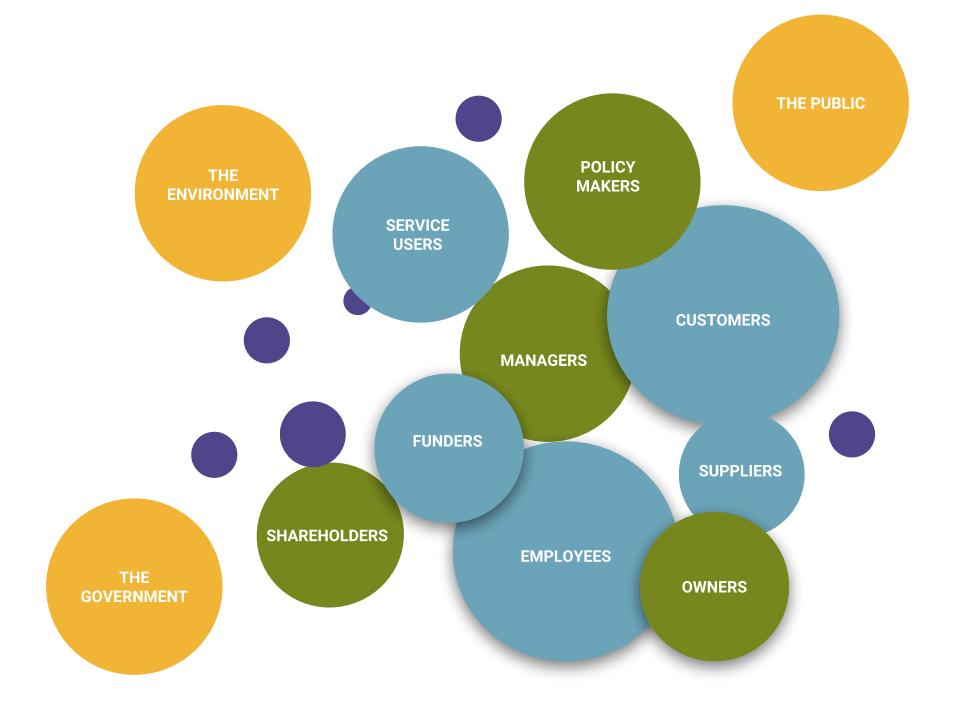
Business participants are the people who participate in conducting the work of the business. These always include the employees and managers, but often include suppliers, customers, and shareholders. Every business must have one or more owners whose primary role is to invest money in the business. When a business is being started, it is generally the owners who polish the business idea and bring together the resources (money and people) needed to turn the idea into a business. The owners also hire employees to work for the company and help it reach its goals. Owners and employees depend on a third group of participants— customers. Ultimately, the goal of any business is to satisfy the needs of its customers in order to generate a profit for the owners. Other participants can include suppliers and even competitors.
Stakeholders are those affected by the business’s operations and its decisions. Examples of stakeholders include shareholders, investors, suppliers, the community, customers, employees, competitors, and governmental agencies. Consider your favorite restaurant. It may be an outlet or franchise of a national chain (more on franchises in a later chapter) or a local “mom and pop shop” without affiliation to a larger entity. Whether national or local, every business has stakeholders – those with a legitimate interest in the success or failure of the business and the policies it adopts. Stakeholders include customers, vendors, employees, suppliers, landlords, competitors, bankers, and others (see Figure 2.1). Other stakeholders include the general public, the environment and all the various government departments that impact the business. All have a keen interest in how the business operates, in most cases for obvious reasons. If the business fails, employees will need new jobs, vendors will need new customers, and banks may have to write off loans they made to the business. Stakeholders do not always see things the same way — their interests sometimes conflict with each other. For example, lenders are more likely to appreciate high profit margins that ensure the loans they made will be repaid, while customers would probably appreciate the lowest possible prices. Pleasing stakeholders can be a real balancing act for any company.
Functional areas in a business refer to different departments or sections that perform specific tasks, such as human resources, operations, accounting, and finance. Each functional area has a unique role in achieving the overall business objectives, and they need to work in cooperation to ensure that the company operates smoothly and effectively. Depending on who you ask, you may receive different answers about how many functional areas there are in a business. It really depends on how the business is structured (more on this later). Some people will say there are four functional areas, some say five, some say six or even seven. Examples of functional areas include human resources, operations, marketing, accounting, finance, information technology, strategy, leadership, team, marketing and sales, production and operations, research and development, employment and human resources, insurance and risk management, and so on .
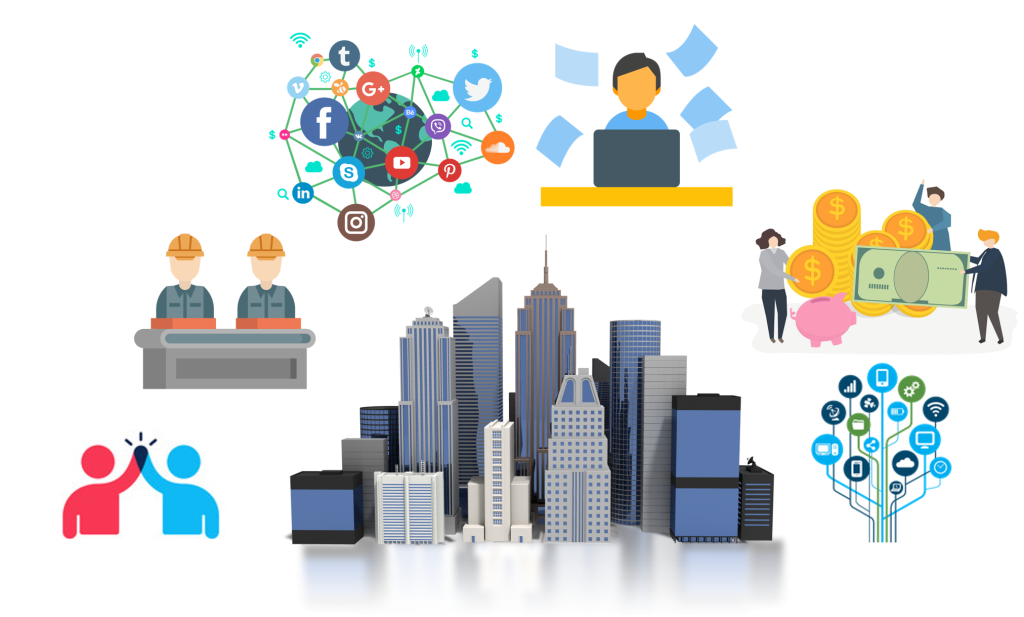
Let us briefly explore each of the six functional areas listed below (Shown in Figure 2.2). When we look at the functional area of business, we are organizing the work in terms of the type of work. In small businesses, the owner may do the finance, accounting, and human resource functions along with overseeing the operations. In large businesses, these functions are often broken down into departments that have large groups of people working within each function.
The Human Resources (HR) functional area is an organizational function that is about searching for, selecting, training, and maintaining workers. HR managers are responsible for ensuring that the organization has all of the skills and capabilities necessary to run the business. HR managers develop staffing plans, recruit and select new employees, monitor the performance management process, and develop succession plans for advancement and replacement. They develop standards for compensation and benefits and assist managers with staff issues.
Operations is the organizational function that is focused on producing the goods and/or services of the business. Operations involve managing the processes and resources that create goods and services in a business. It is responsible for ensuring efficiency, quality, and cost-effectiveness in production, distribution, and delivery to meet customer demand and achieve organizational objectives. All companies must convert resources (labour, materials, money, information, and so forth) into goods or services. Some companies, such as Apple, convert resources into tangible products — iPads, iPhones, etc. Others, such as hospitals, convert resources into intangible products, e.g., health care. The person who designs and oversees the transformation of resources into goods or services is called an operations manager. This individual is also responsible for ensuring that products are of high quality. In many organizations, operations management includes managing the supply chain which controls the delivery of raw materials and the distribution of finished goods.
Marketing plays a crucial role in a business by helping to identify, create, and satisfy customer needs and wants through the promotion of products or services. Effective marketing strategies can help businesses differentiate themselves from competitors, build brand awareness and loyalty, increase sales and revenue, and ultimately, achieve their business goals. Marketing consists of everything that a company does to identify customers’ needs (i.e., market research and consumer analysis) and ensure that products are designed to meet those needs. Marketers develop the benefits and features of products, including price and quality. They also decide on the best method of delivering products and the best means of promoting them to attract and keep customers. They manage relationships with customers and make customers aware of the organization’s desire and ability to satisfy their needs.
Accounting is the organizational function that is focused on recording, keeping, analyzing and communicating financial information. Managers need accurate, relevant and timely financial information, which is provided by accountants. Accountants measure, summarize, and communicate financial and managerial information and advise other managers on financial matters. There are two fields of accounting. Financial accountants prepare financial statements to help users, both inside and outside the organization, assess the financial strength of the company. Managerial accountants prepare information, such as reports on the cost of materials used in the production process, for internal use only.
The financial functional area of a business is responsible for managing the company’s financial resources, including budgeting, accounting, financial reporting, cash flow management, and investment decisions. Its role is to ensure the financial stability and growth of the organization by optimizing financial performance and minimizing risks. Finance involves planning for, obtaining, and managing a company’s funds while maintaining the financial health of the business.
Financial managers address such questions as:
Information technology is the organizational function that aims to understand the information and data needs of the company in terms of obtaining, analyzing, and protecting information. Information is one of the critical assets of most businesses. Businesses such as Facebook are entirely information-based businesses. Information technology (IT) managers are concerned with building computer and network infrastructure, implementing security and privacy protocols, and developing user interfaces and apps for customers. Usually, there is a high level of integration between the business’s website or application and other departments within the business, such as finance, marketing and operations. Often, businesses must develop interfaces to send and receive information from other companies, including suppliers, and logistics and shipping providers. The global pandemic has also made it necessary for businesses to establish and improve their virtual presences. As the use of technology increases so do the number of threats and vulnerabilities. The number of potential risks involved in using information technology is rising, creating a security gap between the expectations of users and the ability of technology suppliers to meet those expectations. Data privacy concerns, protection and security now play an important role. Cybersecurity is changing the way things are done today more than ever before.
To provide goods and services, regardless of whether they operate in the for-profit or not-for-profit sector, organizations require inputs in the form of resources called factors of production. Four traditional factors of production are common to all productive activity: natural resources, labour (human resources), capital, and entrepreneurship. Many experts now include knowledge a fifth factor, acknowledging its key role in business success (Shown in Figure 2.3). By using the factors of production efficiently, a company can produce more goods and services with the same resources.
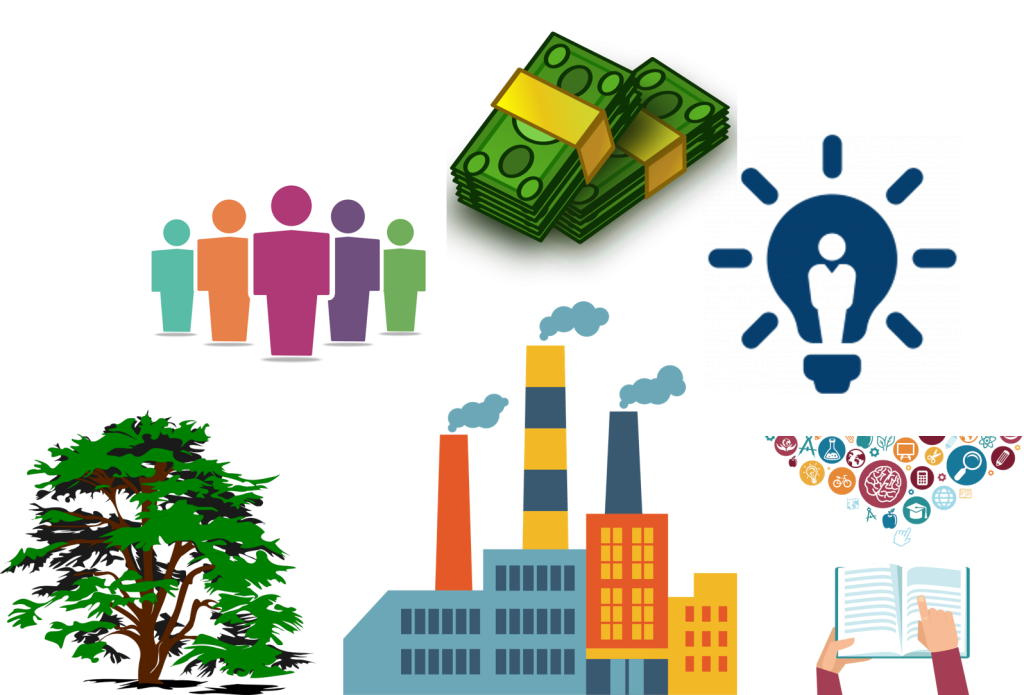
Commodities that are useful inputs in their natural state are known as natural resources and these can be either renewable or non-renewable. Renewable natural resources are those that can grow again or can never run out and these include trees, water, air, and sources of power like solar and wind energy. Non-renewable natural resources are found in the ground and there are limitations to their availability as they cannot be replaced or renewed. These include land, mineral and oil deposits. Sometimes natural resources are simply called land, although the term means more than just land. Companies use natural resources in different ways. International Paper Company uses wood pulp to make paper, and Pacific Gas & Electric Company may use water, oil, or coal to produce electricity. Today urban sprawl, pollution, and limited resources have raised questions about resource use. Conservationists, environmentalists, and government bodies are proposing laws to require land-use planning and resource conservation.
Labor, or human resources, refers to the economic contributions of people working with their minds and muscles. This input includes the talents of everyone—from a restaurant cook to a nuclear physicist—who performs the many tasks of manufacturing and selling goods and services.
The tools, machinery, equipment, and buildings used to produce goods and services and get them to the consumer are known as capital. Sometimes the term capital is also used to mean the money that buys machinery, factories, and other production and distribution facilities. However, because money itself produces nothing, it is not one of the basic inputs. Instead, it is a means of acquiring the inputs. Therefore, in this context, capital does not include money.
Entrepreneurs are the people who combine the inputs of natural resources, labor, and capital to produce goods or services with the intention of making a profit or accomplishing a not-for-profit goal. These people make the decisions that set the course for their businesses; they create products and production processes or develop services. Because they are not guaranteed a profit in return for their time and effort, they must be risk-takers. Of course, if their companies succeed, the rewards may be great. Today, many individuals want to start their own businesses. They are attracted by the opportunity to be their own boss and reap the financial rewards of a successful firm. Many start their first business from their dorm rooms, such as Mark Zuckerberg of Facebook, or while living at home, so their cost is almost zero. Entrepreneurs include people such as Microsoft cofounder Bill Gates, who was named the richest person in the world in 2017, as well as Google founders Sergey Brin and Larry Page. Many thousands of individuals have started companies that, while remaining small, make a major contribution to the U.S. economy.
A number of outstanding managers and noted academics are beginning to emphasize a fifth factor of production—knowledge. Knowledge refers to the combined talents and skills of the workforce and has become a primary driver of economic growth. Today’s competitive environment places a premium on knowledge and learning over physical resources.
The internal business environment in business refers to the elements within the organization that influence its operations and decision-making. It encompasses factors like the company’s culture, management practices, employees, and work processes. A manager should strive to create a well-managed or positive work environment within the organization. A well-managed internal environment has a significant role in influencing the organization’s operations and ensuring successful goal achievement. Some of the most important parts of the internal environment include communicating purpose to stakeholders through creating a mission statement (who we are, what we value), a vision statement (who we want to become), a strategy to achieve the company mission and vision and setting goals and objectives to gauge the company’s degree of success (refer to Figure 2.2).
These are the areas management has control over and can make changes to in response to strategic goals and changes that occur which impact the organization.
An internal business analysis is a business analysis conducted by management or by consultants to evaluate the company’s strengths and weaknesses. Such analyses are often closely associated with the SWOT analysis which helps businesses identify the company’s strengths, weaknesses, opportunities, and threats. An internal business analysis is generally more concerned with the strengths and weaknesses of a business, while its opportunities and vulnerabilities fall more under the external business analysis. When studying strengths and weaknesses, it is important to analyze them in light of their impact on customers, since the customer’s view of the company is ultimately the one that matters most. A SWOT analysis can be done on products, processes, companies, people, and just about anything you are trying to improve.
An internal analysis enables a firm to determine what it can do to improve internal capability to support the overall success of the business. There are other internal analysis managers can do to gauge how the company is performing, some of these include process mapping (to identify issues in processes), NOISE. SOAR, or SCORE analysis as alternatives to SWOT analysis; skills inventory tracking to determine what skills are missing or needed within the organization; succession planning to ensure employees are able to move into positions where someone else has retired; Gap Analysis, Core Competencies Analysis, OCAT, VRIO Analysis, Strategy Evaluation, McKinsey 7S Framework, etc. You will learn more about how managers analyze the business environments when you review the chapter on management.
Once complete, the organization should have a clear idea of where it’s excelling, where it’s doing okay, and where its current deficits and gaps are. The analysis gives management the knowledge to leverage the company’s strengths, expertise, and opportunities. It also enables management to develop strategies that mitigate threats and compensate for identified weaknesses and disadvantages.
The micro-environment may be defined as including groups and organizations that have a direct relationship with the business. For example, suppliers, distributors, competitors, and external customers deal with the firm regularly and have a direct interest in the activities of the company because they are clearly affected by its actions (refer to Figure 2.4). It is important for any organization to monitor and analyze all elements of the micro-environment. The Porter’s Five Forces model is used for a thorough analysis of the competitive environment. A commonly used method for assessing suppliers is the Kraljic Matrix. A method often used when conducting consumer analysis is Ferrell’s 6W model. You will learn more about how managers analyze the business environments when you review the chapter on management.
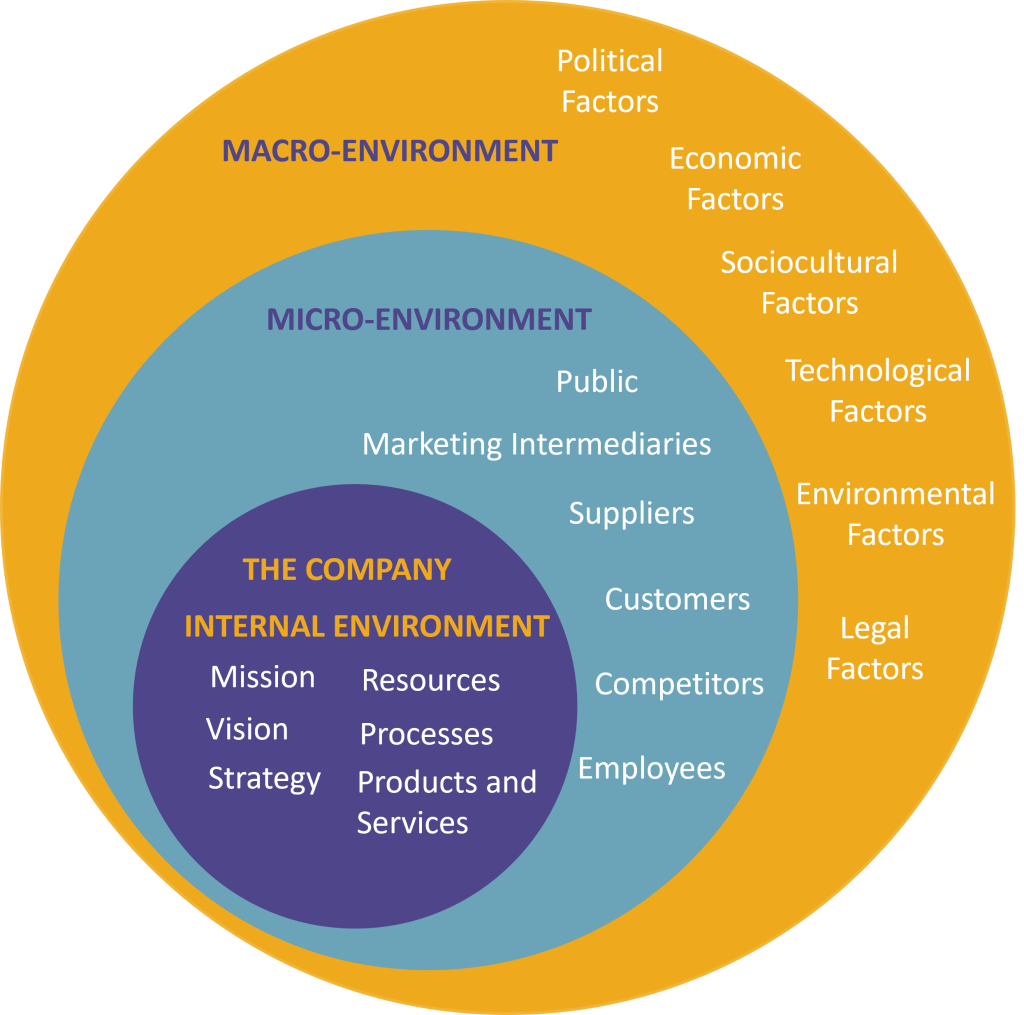
The macro-environment refers to the broader condition of an economy as opposed to specific markets. The macro-environment can be affected by GDP, fiscal policy, monetary policy, inflation, employment rates, and consumer spending. The state of the macro environment affects business decisions on things such as spending, borrowing, and investing. To what degree is a business vulnerable to macro-economic factors? It depends on the extent to which a company is dependent on the health of the economy and external factors for its success. If a company is relying more on the economic health of the country, then it will be more vulnerable to macro-economic changes. Banks, financial institutions, and credit card companies are a very good examples of such businesses that are heavily reliant on the macro-economic factors.
The macro-environment analysis involves brainstorming and a lot of research to initiate the process. It starts by creating a list of trends that would have positive and negative impacts on the business. The macro-environment can be analyzed by using the PEST, PESTLE or PESTEL analysis method (refer to Figure 2.3). This acronym represents external factors that affect the business including Political, Economic, Sociocultural, Technological, Environmental, and Legal (PESTEL). The business has little influence over the macro-environment, for example, if government enacts mandatory regulations on waste management, businesses must comply with these regulations to remain open. As consumers and employees, we see some of these laws and regulations in operation regarding safety conditions on products, foods, buildings, etc. Consumer trends and technological innovations also impact company operations. For example, consumers put pressure on fast food restaurants to offer healthier choices. Another example of external factors affecting business is when one company adopts new technology to serve customers faster and more conveniently, businesses must adapt in order to remain competitive. You will learn more about how managers analyze the business environments when you review the chapter on management.
Teams are a critical aspect of business. A team is a group of people with certain skills who share a common purpose, approach, and performance goals. All team members hold themselves responsible and accountable for reaching the team’s objectives. Teams are widely used in business and in many not-for-profit organizations, such as hospitals and government agencies. Teams are one of the most frequently discussed topics in employee training programs, because they require that people learn how to work well together. There are five common types of teams (Shown in Figure 2.5): Problem-solving teams, self-managed teams, cross-functional teams, virtual teams, and work teams.

Effective teams share the following characteristics:
Team cohesion is the strength and extent of interpersonal connection existing among the members of a group. It is this interpersonal bond that causes members to participate readily and remain motivated to accomplish the set goals. Cohesive teams have an attitude of “we-ness.”
Numerous factors may contribute to team cohesiveness, but in this section, we will focus on five of the most important ones:
Maintaining team focus on broad organizational goals is crucial. If members get too wrapped up in immediate team goals, the whole team may lose sight of the larger organizational goals toward which it is supposed to be working. Let us look at some factors that can erode team performance.
Sometimes we hear about a sports team made up of mostly average players who win a championship because of coaching genius, flawless teamwork, and superhuman determination. But not terribly often. In fact, we usually hear about such teams simply because they are newsworthy — exceptions to the rule. Typically, a team performs well because its members possess some level of talent. Members’ talents must also be managed in a collective effort to achieve a common goal.
In the final analysis, a team can succeed only if its members provide the skills that need managing. In particular, every team requires some mixture of four sets of skills:
The key is ultimately to have the right mix of these skills. Remember, too, that no team needs to possess all these skills — never mind the right balance of them — from day one. In many cases, a team gains certain skills only when members volunteer for certain tasks and perfect their skills in the process of performing them. For the same reason, effective teamwork develops over time as team members learn how to handle various team-based tasks. In a sense, teamwork is always a work in progress.
Just as there are factors and behaviours that contribute to teams working well together, there are some common factors that keep teams from working well together.
Play the YouTube video below, “Forming, Storming, Norming, and Performing: Bruce Tuckman’s Team Stages Model Explained” to learn the stages a team goes through when starting a new project. Transcript for “Forming, Storming, Norming, and Performing: Bruce Tuckman’s Team Stages Model Explained” Video [PDF–New Tab]. Closed captioning is available on YouTube.
Team roles can be divided into two categories, task-facilitating roles and relationship-building roles (Summarized in Figure 2.6).
Task-facilitating roles help the team accomplish goals. These roles include not only providing information when someone else needs it but also asking for it when you need it. In addition, it includes monitoring (checking on progress) and enforcing (making sure that team decisions are carried out). Task facilitators are especially valuable when assignments aren’t clear or when progress is too slow.
Relationship-building roles help team members understand their roles, support them in their roles, and maintain or improve group cohesiveness. These types of roles includes activities that improve team “chemistry,” from empathizing to confronting. Bear in mind three points about this model: (1) Teams are most effective when there’s a good balance between task facilitation and relationship-building; (2) it’s hard for any given member to perform both types of roles, as some people are better at focusing on tasks and others on relationships; and (3) overplaying any facet of any role can easily become counterproductive. For example, elaborating on something may not be the best strategy when the team needs to make a quick decision; and consensus building may cause the team to overlook an important difference of opinion.
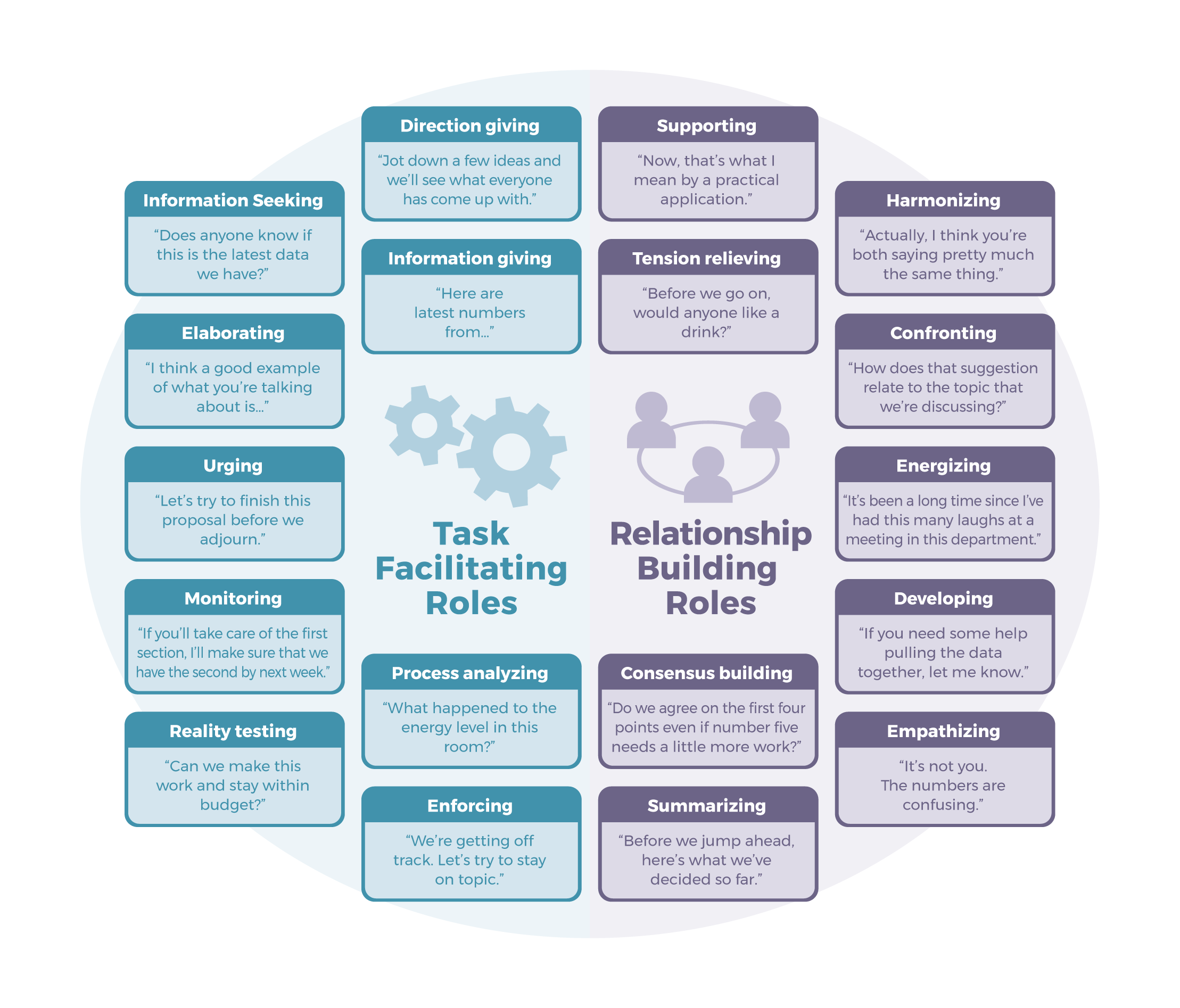
So-called blocking roles consist of behavior that inhibits either team performance or that of individual members. Every member of the team should know how to recognize blocking behavior. If teams don’t confront dysfunctional members, they can destroy morale, hamper consensus building, create conflict, and hinder progress. Demonstrate what you know about blocking behaviours by dragging the words to match with each description.
An interactive H5P element has been excluded from this version of the text. You can view it online here:
https://ecampusontario.pressbooks.pub/businessfundamentals/?p=160#h5p-2
Throughout your studies you will be exposed to teams and teamwork concepts, and be required to complete projects by collaborating with your peers in teams. You will want to consider how to make your class team-based projects as successful as possible. To get insider advice on how to succeed on team projects in college, let’s look at some suggestions offered by students who have gone through this experience.
In many of your courses you will be working in teams during school time as well as outside formal class time. A team contract is important to ensure all members have input on how the team will work together. This contract can also be referenced if a team member is not working to expectations. The following activity is encouraged to help you, and your team, think through and agree on how you will operate. As a team discuss each of the items listed below – it’s a menu or a template for a basic team charter (contract). Try it – just fill in the blanks, then you can generate your team contract as a document.
An interactive H5P element has been excluded from this version of the text. You can view it online here:
https://ecampusontario.pressbooks.pub/businessfundamentals/?p=160#h5p-3
Team conflict is the breakdown of interpersonal relationships between members of a team. Common reasons for team conflict include the following:
Play the YouTube video below, “How to Deal with Conflict” to gain a few tips on how to work through a conflict with a team member. Transcript for “How to Resolve Conflict in the Workplace” Video [PDF–New Tab]. Closed captioning is available on YouTube.
Check your understanding of this chapter’s concepts by completing this short self-check quiz.
An interactive H5P element has been excluded from this version of the text. You can view it online here:
https://ecampusontario.pressbooks.pub/businessfundamentals/?p=160#h5p-4
The contents of this chapter is a compilation sourced from various OER resources, please refer to the Book Information for details.
(Note: This reference list was produced using the auto-footnote and media citation features of Pressbooks)
Boone & Kurtz. (2023). The changing face of business. Chapter 1 Excerpt. https://catalogimages.wiley.com/images/db/pdf/9781119257387.excerpt.pdf
Government of Canada. (2023, December 7). What the government buys. https://canadabuys.canada.ca/en/tender-opportunities/what-government-buys
Government of Canada. (n.d.) What is the difference between a registered charity and a non-profit organization? https://www.canada.ca/en/revenue-agency/services/charities-giving/about-registered-charities/what-difference-between-a-registered-charity-a-non-profit-organization.html
UNDP. (2023). Human Development Reports. https://hdr.undp.org/data-center/country-insights#/ranks
Mercer. (2023). Quality of living city rankings 2023. https://www.mercer.com/en-ca/insights/total-rewards/talent-mobility-insights/quality-of-living-city-ranking/
Marr, B. (2024, September 30). The 5 biggest business trends for 2025 everyone must be ready for now. https://www.forbes.com/sites/bernardmarr/2024/09/30/the-5-biggest-business-trends-for-2025-everyone-must-be-ready-for-now/
McKinsey & Company. (2024, June 10). State of the consumer 2024: What’s now and what’s next. https://www.mckinsey.com/industries/consumer-packaged-goods/our-insights/state-of-consumer
McKinsey & Company. (2024, June 10). State of the consumer 2024: What’s now and what’s next. https://www.mckinsey.com/industries/consumer-packaged-goods/our-insights/state-of-consumer
Marr, B. (2024, September 30). The 5 biggest business trends for 2025 everyone must be ready for now. https://www.forbes.com/sites/bernardmarr/2024/09/30/the-5-biggest-business-trends-for-2025-everyone-must-be-ready-for-now/
Marr, B. (2024, September 30). The 5 biggest business trends for 2025 everyone must be ready for now. https://www.forbes.com/sites/bernardmarr/2024/09/30/the-5-biggest-business-trends-for-2025-everyone-must-be-ready-for-now/
McKinsey & Company. (2024, June 10). State of the consumer 2024: What’s now and what’s next. https://www.mckinsey.com/industries/consumer-packaged-goods/our-insights/state-of-consumer
McKinsey & Company. (2024, June 10). State of the consumer 2024: What’s now and what’s next. https://www.mckinsey.com/industries/consumer-packaged-goods/our-insights/state-of-consumer
McKinsey & Company. (2024, June 10). State of the consumer 2024: What’s now and what’s next. https://www.mckinsey.com/industries/consumer-packaged-goods/our-insights/state-of-consumer
McKinsey & Company. (2024, June 10). State of the consumer 2024: What’s now and what’s next. https://www.mckinsey.com/industries/consumer-packaged-goods/our-insights/state-of-consumer
Testa, D. M. (2019). Apple, Inc.: An Analysis of the Firm’s Tumultuous History, in Conjunction with the Abounding Future. https://scholar.flatworldknowledge.com/books/33658/collins-ch01_s00/preview
Angelelli, L. (1994). Steve Paul Jobs. http://ei.cs.vt.edu/~history/Jobs.html
Angelelli, L. (1994). Steve Paul Jobs. http://ei.cs.vt.edu/~history/Jobs.html
Farivar, C. (2006, June 2). 30 years of Apple: Assessing Apple’s impact. Macworld. https://www.macworld.com/article/1050153/30impact.html
Government of Canada. (2022, November 22). Government of Canada announces national funders selected to support charities and non-profits. https://www.canada.ca/en/employment-social-development/news/2022/11/government-of-canada-announces-national-funders-selected-to-support-charities-and-non-profits.html
Government of Canada. (2022). Canada health act annual report 2021-2022. https://www.canada.ca/en/health-canada/services/publications/health-system-services/canada-health-act-annual-report-2021-2022.html
Dolan, K. (2017, March 20). Forbes 2017 Billionaires List: Meet the Richest People on the Planet. https://www.forbes.com/sites/kerryadolan/2017/03/20/forbes-2017-billionaires-list-meet-the-richest-people-on-the-planet/
Blackmore, L. (2024, July 24). What is internal analysis? https://www.cascade.app/blog/internal-analysis
Blackmore, L. (2024, July 24). What is internal analysis? https://www.cascade.app/blog/internal-analysis
Shaw, A. (n.d.). What is the macro environment? Definition and examples. https://www.marketingtutor.net/macro-environment/
Indeed Editorial Team. (2024, August 15). 7 characteristics of effective teams (with benefits & tips). https://www.indeed.com/career-advice/career-development/characteristics-of-effective-teams
Wale, H. (n.d.). Team cohesion. https://corporatefinanceinstitute.com/resources/management/team-cohesion/
MindToolsVideos. (2014, November 10). Forming, storming, norming, and performing: Bruce Tuckman’s team stages model explained. [Video]. YouTube. https://www.youtube.com/watch?v=nFE8IaoInQU&t=4s
Feenstra, K. (n.d.). Study skills: Teamwork skills for group projects. http://powertochange.com/students/academics/groupproject/
Litmos Heroes. (2014, December 12). How to deal with conflict. [Video]. YouTube. https://www.youtube.com/watch?v=QLbGHQo4qnA
3
After reading this chapter, you should be able to do the following:
The four functions of management–planning, organizing, leading and controlling–serve as the pillars that allow organizations to meet their goals. These functions are interdependent and equally important for ensuring the smooth operation of any business (Refer to Figure 3.1). The four management functions (POLC) can help managers increase organizational efficiency and effectiveness. Efficiency is using the least possible amount of resources to get work done, whereas effectiveness is the ability to produce a desired result. Managers need to be both efficient and effective in order to achieve organizational goals.
The management functions of planning, organizing, leading, and controlling are widely considered to be the best means of describing the manager’s job, as well as the best way to classify accumulated knowledge about the study of management. Although there have been tremendous changes in the environment faced by managers and the tools used by managers to perform their roles, managers still perform these essential functions.
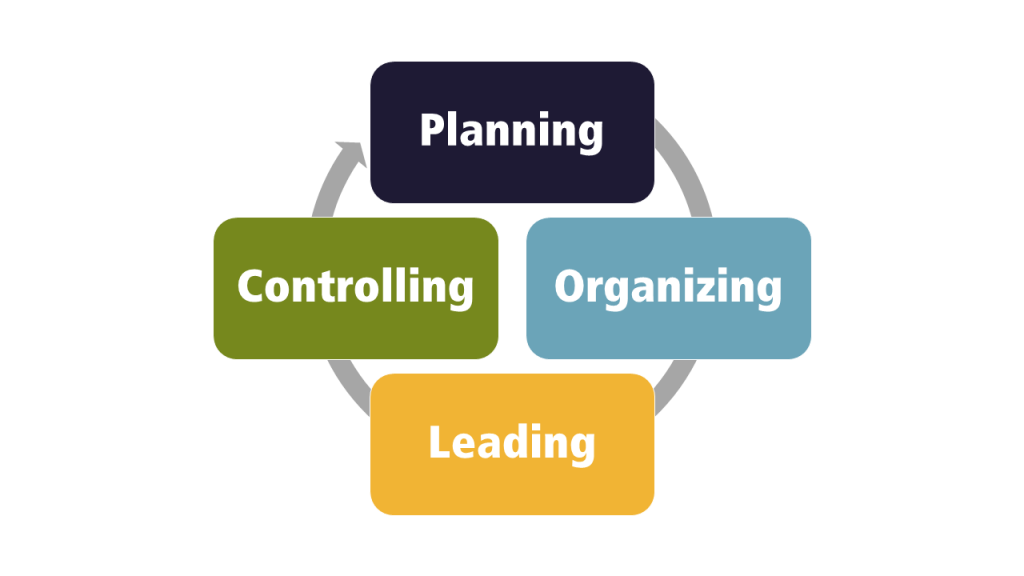
Planning is the function of management that involves setting objectives and determining a course of action for achieving those objectives. Planning requires that managers be aware of environmental conditions facing their organization and forecast future conditions. It also requires that managers be good decision makers.
Planning is a process consisting of several steps. The process begins with environmental scanning which simply means that planners must be aware of the critical contingencies facing their organization in terms of economic conditions, their competitors, and their customers. Planners must then attempt to forecast future conditions. These forecasts form the basis for planning.
Planners must establish objectives, which are statements of what needs to be achieved and when. Planners must then identify alternative courses of action for achieving objectives. After evaluating the various alternatives, planners must make decisions about the best courses of action for achieving objectives. They must then formulate necessary steps and ensure effective implementation of plans. Finally, planners must constantly evaluate the success of their plans and take corrective action when necessary. There are many different types of plans and planning.
There are three levels of management, and each level is responsible for specific planning, decision-making and activities.
The level of management you work in will determine the type of planning and decision-making you will do. Figure 3.2 shows the three levels of management: Top Managers, Middle Managers, and First-line managers and the activities they do at each level. Top-level managers set objectives, scan the business environment, and plan and make decisions that affect the overall health of the organization. Middle-level managers allocate resources, oversee first-line managers, report to top-level managers and develop and implement activities. First-line managers (also referred to as customer-facing or front-line) coordinate activities, supervise employees, report to middle-managers, and are involved in day-to-day operations.
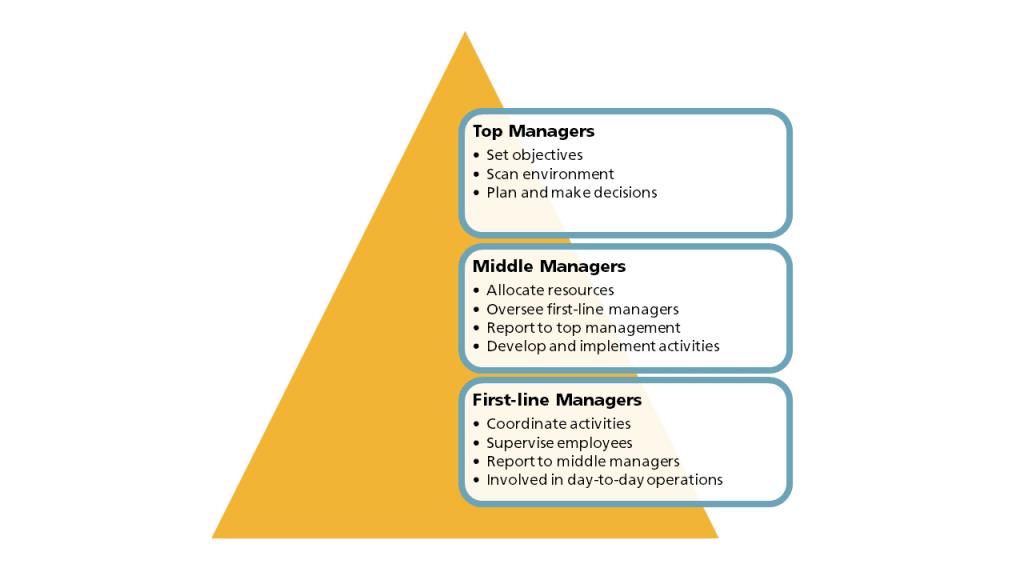
Decision-making is the action or process of thinking through possible options and selecting one. It is important to recognize that managers are continually making decisions, and that the quality of their decision-making has an impact—sometimes quite significant—on the effectiveness of the organization and its stakeholders. Stakeholders are all the individuals or groups that are affected by an organization (such as customers, employees, shareholders, etc.).
Members of the top management team regularly make decisions that affect the future of the organization and all its stakeholders, such as deciding whether to pursue a new technology or product line. A good decision can enable the organization to thrive and survive long-term, while a poor decision can lead a business into bankruptcy. Managers at lower levels of the organization generally have a smaller impact on the organization’s survival but can still have a tremendous impact on their department and its workers. Consider, for example, a first-line supervisor who is charged with scheduling workers and ordering raw materials for her department. Poor decision-making by lower-level managers is unlikely to drive the entire firm out of existence, but it can lead to many adverse outcomes such as:
Click on each step to learn more about the problem-solving model and how to make decisions after gathering relevant data.
An interactive H5P element has been excluded from this version of the text. You can view it online here:
https://ecampusontario.pressbooks.pub/businessfundamentals/?p=257#h5p-6
To be a successful manager, you’ll have to master a number of skills. To get an entry-level position, you’ll have to be technically competent at the tasks you’re asked to perform. To advance, you’ll need to develop strong interpersonal and conceptual skills. The relative importance of different skills varies from job to job and organization to organization, but to some extent, you’ll need them all to forge a managerial career. Throughout your career, you’ll also be expected to communicate ideas clearly, use your time efficiently, and reach sound decisions.
You’ll probably be hired for your first job based on your technical skills — the ones you need to perform specific tasks — and you’ll use them extensively during your early career. If your college major is accounting, you’ll use what you’ve learned to prepare financial statements. If you have a marketing degree and you join an ad agency, you’ll use what you know about promotion to prepare ad campaigns. Technical skills will come in handy when you move up to a first-line managerial job and oversee the task performance of subordinates. Technical skills, though developed through job training and work experience, are generally acquired during the course of your formal education.
As you move up the corporate ladder, you’ll find that you can’t do everything yourself: you’ll have to rely on other people to help you achieve the goals for which you’re responsible. That’s why interpersonal skills, also known as relational skills — the ability to get along with and motivate other people — are critical for managers in mid-level positions. These managers play a pivotal role because they report to top-level managers while overseeing the activities of first-line managers. Thus, they need strong working relationships with individuals at all levels and in all areas. More than most other managers, they must use “people skills” to foster teamwork, build trust, manage conflict, and encourage improvement.

Effective communication skills are crucial to just about everyone. At all levels of an organization, you’ll often be judged on your ability to communicate, both orally and in writing. Whether you’re talking informally or making a formal presentation, you must express yourself clearly and concisely. Talking too loudly, rambling, and using poor grammar reduce your ability to influence others, as does poor written communication. Confusing and error-riddled documents (including emails) don’t do your message any good, and they will reflect poorly on you.
Managers at the top, who are responsible for deciding what’s good for the organization from the broadest perspective, rely on conceptual skills — the ability to reason abstractly and analyze complex situations. Senior executives are often called on to “think outside the box” — to arrive at creative solutions to complex, sometimes ambiguous problems. They need both strong analytical abilities and strong creative talents.
Time management skills are techniques that help you plan and organize your time to complete tasks and achieve goals. Managers face multiple demands on their time, and their days are usually filled with interruptions. Ironically, some technologies that were supposed to save time, such as voicemail and email, have actually increased workloads. Unless you develop certain time-management skills, you risk reaching the end of the day feeling that you’ve worked a lot but accomplished little. What can managers do to ease the burden? Here are a few common-sense suggestions:
Every manager is expected to make decisions, whether alone or as part of a team. Drawing on your decision-making skills is often a process in which you must define a problem, analyze possible solutions, and select the best outcome. As luck would have it, because the same process is good for making personal decisions, we’ll use a personal example to demonstrate the process approach to decision making. Consider the following scenario: you’re upset because your midterm grades are much lower than you’d hoped. To make matters worse, not only are you in trouble academically, but also the other members of your business-project team are annoyed because you’re not pulling your weight. Your lacrosse coach is very upset because you’ve missed too many practices, and members of the mountain-biking club of which you’re supposed to be president are talking about impeaching you if you don’t show up at the next meeting. And your significant other is feeling ignored.
Strategic planning involves analyzing competitive opportunities and threats, as well as the strengths and weaknesses of the organization, and then determining how to position the organization to compete effectively in their environment. Strategic planning has a long time frame, often three years or more. It generally includes the entire organization and includes formulation of objectives. Strategic planning is often based on the organization’s mission, which is its fundamental reason for existence. An organization’s top management most often conducts strategic planning. Strategic managers are often involved with developing and writing company mission, vision, and values statements.
Understanding of the four stages of the industry life cycle (also referred to as the business cycle) include expansion, peak, contraction, and trough (discussed in the chapter on economics) and industry dynamics informs management’s investment decisions and risk management strategies. It can help companies manage their operational and financial decisions and activities so that they position themselves to achieve important goals, including product research and development, implementing innovative technology, expanding a customer base, and more. External factors that affect a business are often analyzed through a PEST analysis.
Planning begins at the highest level of management and works its way down through the organization.
Step one is usually called strategic planning: the process of establishing an overall course of action. To begin this process, a manager/owner should ask a couple of very basic questions: why, for example, does the organization exist? What value does it create? Sam Walton posed these questions in the process of founding Wal-Mart: his new chain of stores would exist to offer customers the lowest prices with the best possible service.
Once the purpose of the company has been identified, then the manager is ready to take the remaining steps in the strategic-planning process:
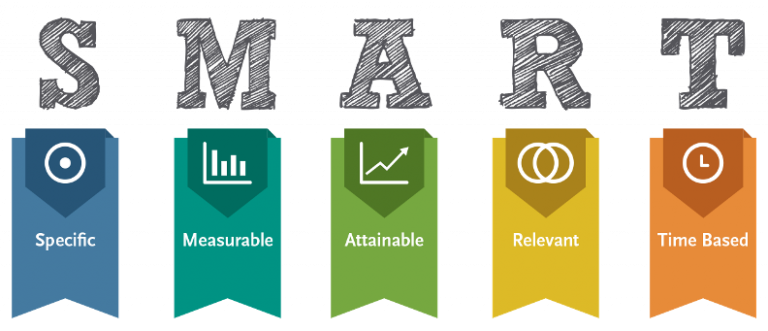
Tactical planning is intermediate-range (one to three years) planning that is designed to develop relatively concrete and specific means to implement the strategic plan. Middle-level managers often engage in tactical planning.
Operational planning generally assumes the existence of organization-wide or sub-unit goals and objectives and specifies ways to achieve them. Operational planning is short-range (less than a year) planning that is designed to develop specific action steps that support the strategic and tactical plans. First-level managers engage in operational planning.
Contingency and Crisis Planning are plans for what actions to take when things go wrong. Perhaps your plans were flawed, or maybe something in the environment shifted unexpectedly. Successful managers anticipate and plan for the unexpected. Dealing with uncertainty requires contingency planning and crisis management.
Play the YouTube video below, “Types of Planning: Strategic, Tactical, Operational & Contingency Planning” to learn how the levels of planning interconnect. Transcript for “Types of Planning: Strategic, Tactical, Operational & Contingency Planning.” Video [PDF–New Tab]. Closed captioning is available on YouTube.
A business environment analysis is a systematic process that evaluates the internal and external factors impacting a business. Before planning can be done analysis of the business environments should be conducted through researching and analyzing market conditions, competition, trends and other external factors that could influence the business’s strategy. Environmental analysis plays an essential role in a company’s strategic planning by providing a clear and thorough understanding of external business factors and how they affect the company. Analyses help the company take advantage of opportunities, lower risks, and come up with good plans that lead to growth and success.
As this book is written for an introduction to business (usually a survey course at colleges and universities) you will not take these concepts into too much depth. Later in your business studies when you complete management, leadership, analytics, and other courses you will utilize these analysis models to a fuller extent.
PEST is the term used for an external environment scan, whereby a business collects and analyzes data on the political, economic, social, and technological aspects of the business environment in which the business operates. PEST can be extended to include the legal, environmental, and ethical aspects of the business environment and when included, the acronym is referred to as PESTEL or PESTLE, PESTLEE. Many people refer to the analysis as a PEST analysis and include all the factors mentioned here (Refer to Figure 3.4).
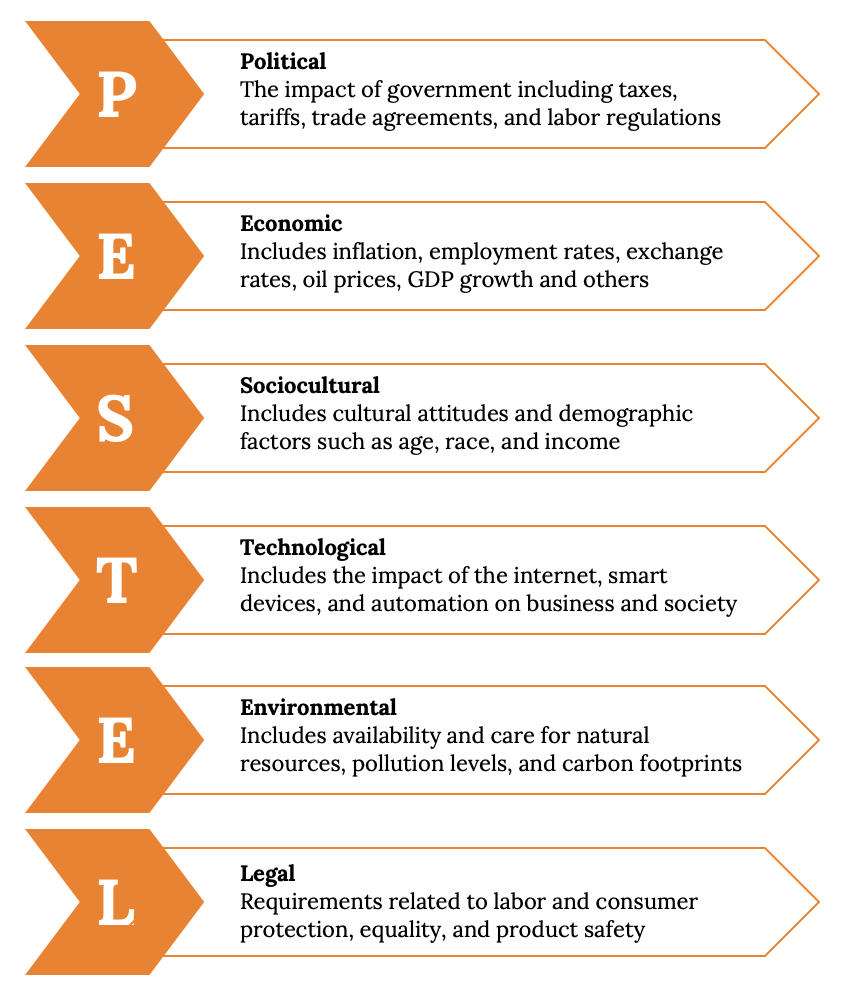
A SWOT analysis analysis is a framework for identifying and analyzing an organization’s strengths, weaknesses, opportunities and threats. These words make up the SWOT acronym. The primary goal of SWOT analysis is to increase awareness of the factors that go into making a business decision or establishing a business strategy.
Below each of the four points of SWOT is explained in more detail:
Play the YouTube video below, “SWOT Analysis” to learn how to analyze a company’s strengths, weaknesses, opportunities and threats. Transcript for “SWOT Analysis” Video [PDF–New Tab]. Closed captioning is available on YouTube.
A competitor analysis in business involves examining similar brands in the same industry to gain insight into other companies’ offerings, brands, sales, and marketing approaches.
Play the YouTube video below, “The Five Forces Analysis Explained” to learn how to apply the Five Forces Analysis to a coffee shop within this industry. Transcript for “The Five Forces Analysis Explained” Video [PDF–New Tab]. Closed captioning is available on YouTube.
A second key function of managers is organizing, which is the process of coordinating and allocating a firm’s resources in order to carry out its plans. Organizing includes developing a structure for the people, positions, departments, and activities within the firm. Managers can arrange the structural elements of the firm to maximize the flow of information and the efficiency of work processes. They accomplish this by doing the following:
Organizing is the function of management that involves developing an organizational structure and allocating human resources to ensure the accomplishment of objectives. The structure of the organization is the framework within which effort is coordinated. The structure is usually represented by an organization chart, which provides a graphic representation of the chain of command within an organization. Decisions made about the structure of an organization are generally referred to as organizational design decisions.
Businesses use organizational charts to depict the reporting structure within the organization. Depending on the number of layers in an organizational chart, the company’s command chain can be identified along with each manager’s span of control. Span of Control can be defined as the total number of direct subordinates that a manager can control or manage. The number of subordinates managed by a manager varies depending on the complexity of the work. The vertical lines in an organizational chart represent a few things, flows of communication as well as the authority relationships among people working at various levels of the organization.
Review the video below to learn more about the organizational structures businesses build.
Play the YouTube video below, “What is Organizational Structure?” to learn how companies structure for business operations. Transcript for “What is Organizational Structure?” Video [PDF–New Tab]. Closed captioning is available on YouTube.
3M’s organizational structure is mainly hierarchical at the corporate level. The company has large-scale operations in multiple industries. This large organizational size requires top leaders to have strong command and control of the business. For such command and control to be realistically achieved, 3M needs to maintain a hierarchical structure.
3M has operations in different types of markets, such as healthcare, electronics and communications, and transportation. With its company structure, the conglomerate has diverse competitors, including General Electric. 3M maintains a departmental organizational structure under the larger corporate hierarchical structure. This departmental organizational structure ensures that 3M’s different businesses are properly managed. Also, departments have their own unique structures. For example, some departments have a matrix structure, while others are more hierarchical. The matrix organizational structure is used in R&D to support 3M’s innovation through employee contributions.
Organizing also involves the design of individual jobs within the organization. Decisions must be made about the duties and responsibilities of individual jobs, as well as the manner in which the duties should be carried out. Decisions made about the nature of jobs within the organization are generally called “job design” decisions.
Organizing at the level of the organization involves deciding how best to departmentalize, or cluster, jobs into departments to coordinate effort effectively. There are many different ways to departmentalize, including organizing by function, product, geography, or customer. Many larger organizations use multiple methods of departmentalization.
Organizing at the level of a particular job involves how best to design individual jobs to most effectively use human resources. Traditionally, job design was based on principles of division of labor and specialization, which assumed that the narrower the job content, the more proficient the individual performing the job could become. However, experience has shown that it is possible for jobs to become too narrow and specialized. For example, how would you like to screw lids on jars one day after another, as you might have done many decades ago if you worked in company that made and sold jellies and jams? When this happens, negative outcomes result, including decreased job satisfaction and organizational commitment, increased absenteeism, and turnover.
Many organizations have attempted to strike a balance between the need for worker specialization and the need for workers to have jobs that entail variety and autonomy. Many jobs are now designed based on such principles as empowerment, job enrichment and teamwork.
Building an organizational structure engages managers in two activities: job specialization (dividing tasks into jobs) and departmentalization (grouping jobs into units).
A divisional organizational structure is a type of organizational structure where a company is divided into independent divisions that operate like their own companies within the larger organization. Each division has its own resources, teams, and responsibilities.
The third management function is leading—providing focus and direction to others and motivating them to achieve organizational goals.
A leader can be anyone in an organization, regardless of position, able to influence others to act or follow, often by their own choice. Managers are designated leaders according to the organizational structure but may need to use negative consequences or coercion to achieve change. In the organizational structure, top managers use leadership skills to set, share, and gain support for the company’s direction and strategy—mission, vision, and values, such as Jeff Bezos does at Amazon. Middle and supervisory management use leadership skills in the process of directing employees on a daily basis as the employees carry out the plans and work within the structure created by management. Top-level leadership demonstrated by Bezos was also exhibited by Jack Welch while leading General Electric and led to many studies of his approach to leadership. Organizations, however, need strong effective leadership at all levels in order to meet goals and remain competitive.
The Board of Directors is a governing body that represents the interests of community stakeholders on non-profit and owner shareholders when referring to corporate boards. Forming a skilled and balanced group of individuals to work on boards promotes respectful and productive discussions, which is fundamental to achieving organizational success. Minority populations, however, are found to be vastly underrepresented in the boardroom. In 2020, a report on diversity disclosure practices demonstrated that only 0.5% of board members in Canada were of Indigenous descent. Corporations have yet to realize that Indigenous board members contribute valuable knowledge and perspectives, as well as attracting and retaining more Indigenous talent. It additionally provides organizations with the opportunity to demonstrate respect for social, cultural, and environmental values of Indigenous populations. These advantages are expanded upon by Indigenous professional Krystal Abotossaway, who recounts her experiences as a board member.
One or more interactive elements has been excluded from this version of the text. You can view them online here: https://ecampusontario.pressbooks.pub/businessfundamentals/?p=257
There are four basic leadership styles, Autocratic, Democratic, Transformational, and Free-rein (Laissez-faire).
Autocratic leaders are directive leaders, allowing for very little input from subordinates. These leaders prefer to make decisions and solve problems on their own and expect subordinates to implement solutions according to very specific and detailed instructions. In this leadership style, information typically flows in one direction, from manager to subordinate. The military, by necessity, is generally autocratic. When employees are new with little experience, they may value an autocratic leader. When autocratic leaders treat employees with fairness and respect, they may be considered knowledgeable and decisive. But often autocrats are perceived as narrow-minded and heavy-handed in their unwillingness to share power, information, and decision-making in the organization. The trend in organizations today is away from the directive, controlling style of the autocratic leader. Although, In emergencies or highly structured environments requiring quick, decisive actions, autocratic style works well. For example, during a factory emergency, such as a fire or equipment failure, the plant manager orders an immediate evacuation without consulting the team to ensure safety.

Businesses are looking more and more for participative leaders, meaning leaders who share decision-making with group members and encourage discussion of issues and alternatives. Participative leaders use a democratic, consensual, consultative style. The leader encourages team participation and values group input before making decisions. This leadership style works well In collaborative environments where creativity, buy-in, and team cohesion are critical. For example, a marketing team brainstorming ideas for a new product campaign. The leader facilitates discussions, gathers input from all team members, and makes the final decision based on consensus.
Participative leadership has three types: democratic, consensual, and consultative. Democratic leaders solicit input from all members of the group and then allow the group members to make the final decision through a voting process. This approach works well with highly trained professionals. The president of a physicians’ clinic might use the democratic approach. Consensual leaders encourage discussion about issues and then require that all parties involved agree to the final decision. This is the general style used by labour mediators. Consultative leaders confer with subordinates before making a decision but retain the final decision-making authority. This technique has been used to dramatically increase the productivity of assembly-line workers.
Transformational leadership is a leadership style that can inspire positive changes in those who follow. Transformational leaders are generally energetic, enthusiastic, and passionate. Not only are these leaders concerned and involved in the process, but they are also focused on helping every member of the group succeed. Transformational leaders take control of situations by conveying a clear vision of the group’s goals. These leaders have a marked passion for the work and an ability to make the rest of the group feel recharged and energized. Transformational leaders focus on helping members of the group support one another and provide them with the support, guidance, and inspiration they need to work hard, perform well, and stay loyal to the group. The primary goals of transformational leadership are to inspire growth, promote loyalty, and instill confidence in group members.
In today’s organizations, in which team building and information sharing are important, and projects are often collaborative in nature, transformational leadership has proven to be more effective. Modern organizations look for managers who can develop positive relationships with subordinates and motivate employees to focus on the interests of the organization. Leaders who can be both transactional and transformational are rare, and those few who have both capacities are very much in demand. This leadership style works well In industries undergoing change or organizations aiming for significant innovation. For example, a tech startup founder inspires the team to develop a groundbreaking app by sharing a compelling vision, mentoring employees, and encouraging risk-taking to achieve ambitious milestones.
The third leadership style, at the opposite end of the continuum from the autocratic style, is free-rein or laissez-faire(French for “leave it alone”) leadership. With this style, the leader provides minimal supervision, allowing employees to make decisions and work independently. Employees are assigned a task and then given free rein to figure out the best way to accomplish it. The manager doesn’t get involved unless asked. Under this approach, subordinates have unlimited freedom as long as they do not violate existing company policies. This approach is also sometimes used with highly trained professionals who are self motivated and require little oversight. For example, a software development team working on a project. The leader trusts the developers to self-manage their tasks and deliver results, stepping in only when issues arise. Similarly, free-rein may be an effective leadership style when managing an experienced team working in a research laboratory. Although one might at first assume that subordinates would prefer the free-rein style, this approach can have several drawbacks. If free-rein leadership is accompanied by unclear expectations and lack of feedback from the manager, the experience can be frustrating for an employee. Employees may perceive the manager as being uninvolved and indifferent to what is happening or as unwilling or unable to provide the necessary structure, information, and expertise.
No leadership style is effective all the time. Effective leaders recognize employee growth and use situational leadership, selecting a leadership style that matches the maturity and competency levels of those completing the tasks. Newly hired employees may respond well to authoritative leadership until they understand the job requirements and show the ability to handle routine decisions. Once established, however, those same employees may start to feel undervalued and perform better under a participative or free-rein leadership style. Using situational leadership empowers employees.
Participative and free-rein leaders use a technique called empowerment to share decision-making authority with subordinates. Empowerment means giving employees increased autonomy and discretion to make their own decisions, as well as control over the resources needed to implement those decisions. When decision- making power is shared at all levels of the organization, employees feel a greater sense of ownership in, and responsibility for, organizational outcomes.
To be effective leaders, managers must be able to influence others’ behaviours. This ability to influence others to behave in a particular way is called power.
Researchers have identified five primary sources, or bases, of power:
Delegating is the process of entrusting work to subordinates, letting go, trusting – this is challenging for many managers to do; however, it is a necessary skill to learn.
Managers who know how to delegate effectively:
The other aspect of delegating authority has to do with how decisions are made, they can either be centralized or decentralized.
Can you determine the leadership style of these leaders? Try the short quiz below.
An interactive H5P element has been excluded from this version of the text. You can view it online here:
https://ecampusontario.pressbooks.pub/businessfundamentals/?p=257#h5p-5
How do managers motivate employees to do quality work? This question is difficult to answer because people are motivated by different things at different stages in their life, their career, and their personal growth. Highly motivated employees focus their efforts on achieving specific goals. It’s the manager’s job, therefore, to motivate employees—to get them to try to do the best job they can. Motivated employees call in sick less frequently, are more productive, and are less likely to convey bad attitudes to customers and coworkers. They also tend to stay in their jobs longer, reducing turnover and the cost of hiring and training employees.
They may be intrinsically or extrinsically motivated, or by a combination of each.
Intrinsic motivation. This is when motivation comes from within; in other words, a person has it within themselves to be, stay, or become motivated. For example, a person may be intrinsically motivated by the enjoyment of doing a task, the satisfaction of a job well done, or the desire to achieve.
Extrinsic motivation. This is when motivation comes from external factors; in other words, a person needs an incentive to be, stay, or become motivated. For example, a person may be extrinsically motivated by the pay they receive, bonuses they receive, avoiding punishment, gaining recognition or prestige, or perks of the job.
According to Maslow’s theory, the idea is that we need to satisfy lower-level needs before we move to the other levels; once we have satisfied said need(s), we move on to the next level as the previous one no longer satisfies us. Consider how this can play out in the workplace.
What implications does Maslow’s theory have for business managers? There are two key points: (1) Not all employees are driven by the same needs, and (2) the needs that motivate individuals can change over time. Managers should consider which needs different employees are trying to satisfy and should structure rewards and other forms of recognition accordingly. For example, when you got your first job repossessing cars, you were motivated by the need for money to buy food. If you’d been given a choice between a raise or a plaque recognizing your accomplishments, you’d undoubtedly have opted for the money. As a city councillor, by contrast, you may prefer public recognition of work well done (say, election to higher office) to a pay raise.
As shown in Figure 3.5, Maslow’s Hierarchy of Needs from the highest level (self-actualization) to the lowest level (physiological needs):
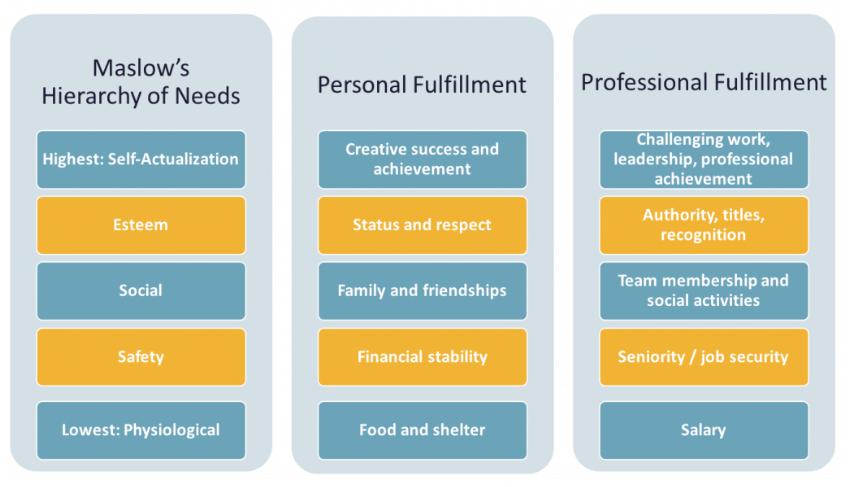
Another psychologist, Frederick Herzberg, set out to determine which work factors (such as wages, job security, or advancement) made people feel good about their jobs and which factors made them feel bad about their jobs. He surveyed workers, analyzed the results, and concluded that to understand employee satisfaction (or dissatisfaction), he had to divide work factors into two categories:
Figure 3.6 illustrates Herzberg’s two-factor theory. Note that motivation factors (such as promotion opportunities) relate to the nature of the work itself and the way the employee performs it. Hygiene factors (such as physical working conditions) relate to the environment in which it’s performed.
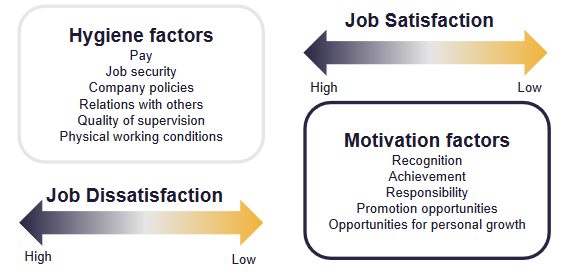
Let’s start with hygiene factors. Are salaries reasonable? What about working conditions? Does each accountant have his or her own workspace, or are they crammed into tiny workrooms? Are they being properly supervised or are they left on their own to sink or swim? If hygiene factors like these don’t meet employees’ expectations, they may be dissatisfied with their jobs.
Fixing problems related to hygiene factors may alleviate job dissatisfaction, but it won’t necessarily improve anyone’s job satisfaction. To increase satisfaction (and motivate someone to perform better), you must address motivation factors. Is the work itself challenging and stimulating? Do employees receive recognition for jobs well done? Will the work that an accountant has been assigned help him or her to advance in the firm? According to Herzberg, motivation requires a twofold approach: eliminating “dissatisfiers” and enhancing satisfiers.
If you were a manager, wouldn’t you like to know how your employees decide whether to work hard or goof off? Wouldn’t it be nice to know whether a planned rewards program will have the desired effect—namely, motivating them to perform better in their jobs? These are the issues considered by psychologist Victor Vroom in his expectancy theory, which proposes that employees will work hard to earn rewards that they value and that they consider “attainable”.
As you can see from Figure 3.7, Vroom’s Expectancy Theory argues that an employee will be motivated to exert a high level of effort to obtain a reward under three conditions – the employee:
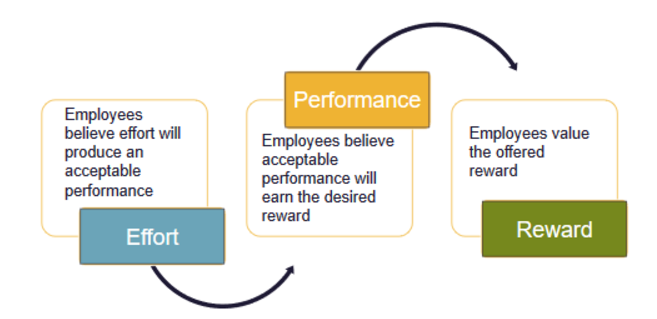
To apply expectancy theory to a real-world situation, let’s analyze an automobile-insurance company with one hundred agents who work from a call centre. Assume that the firm pays a base salary of $2,000 a month, plus a $200 commission on each policy sold above ten policies a month. In terms of expectancy theory, under what conditions would an agent be motivated to sell more than ten policies a month?
The agent would have to believe that his or her efforts would result in policy sales (that, in other words, there’s a positive link between effort and performance). The agent would have to be confident that if he or she sold more than ten policies in a given month, there would indeed be a bonus (a positive link between performance and reward). The $200 bonus per policy would have to be of value to the agent.
Now let’s alter the scenario slightly. Say that the company raises prices, thus making it harder to sell the policies. How will agents’ motivation be affected? According to expectancy theory, motivation will suffer. Why? Because agents may be less confident that their efforts will lead to satisfactory performance. What if the company introduces a policy whereby agents get bonuses only if buyers don’t cancel policies within ninety days? Now agents may be less confident that they’ll get bonuses even if they do sell more than ten policies. Motivation will decrease because the link between performance and reward has been weakened. Finally, what will happen if bonuses are cut from $200 to $25? Obviously, the reward would be of less value to agents, and, again, motivation will suffer. The message of expectancy theory, then, is fairly clear: managers should offer rewards that employees value, set performance levels that they can reach, and ensure a strong link between performance and reward.
What is the equity theory of motivation? The Equity Theory of motivation is the idea that what an individual receives for their work has a direct effect on their motivation. When applied to the workplace, it means an individual will generally aim to create a balance between what they give to the organization compared to what they get in return.
Equity theory was developed by John Stacey Adams, and you can read more information about Equity theory in this article.
Let’s review this example. What if you spent thirty hours working on a class report, did everything you were supposed to do, and handed in an excellent assignment (in your opinion). Your roommate, on the other hand, spent about five hours and put everything together at the last minute. You know, moreover, that he ignored half the requirements and never even ran his assignment through a spell-checker. A week later, your teacher returns the reports. You get a C grade and your roommate gets a B+. In all likelihood, you’ll feel that you’ve been treated unfairly relative to your roommate.
According to Figure 3.8, the Equity Theory, your reaction makes sense. The Equity Theory of motivation focuses on our perceptions of how fairly we’re treated relative to others. Applied to the work environment, this theory proposes that employees analyze their contributions or job inputs (hours worked, education, experience, work performance) and their rewards or job outcomes (salary, bonus, promotion, recognition). Then they create a contributions/rewards ratio and compare it to those of other people. The basis of comparison can be any one of the following:

When individuals perceive that the ratio of their contributions to rewards is comparable to that of others, they perceive that they’re being treated fairly or equitably; when they perceive that the ratio is out of balance, they perceive inequity. Occasionally, people will perceive that they’re being treated better than others. More often, however, they conclude that others are being treated better (and that they themselves are being treated worse). This is what you concluded when you saw your grade in the previous example. You’ve calculated your ratio of contributions (hours worked, research and writing skills) to rewards (project grade), compared it to your roommate’s ratio, and concluded that the two ratios are out of balance.
What will an employee do if he or she perceives an inequity? The individual might try to bring the ratio into balance, either by decreasing inputs (working fewer hours, not taking on additional tasks) or by increasing outputs (asking for a raise). If this strategy fails, an employee might complain to a supervisor, transfer to another job, leave the organization, or rationalize the situation (e.g., deciding that the situation isn’t so bad after all). Equity theory advises managers to focus on treating workers fairly, especially in determining compensation, which is, naturally, a common basis of comparison.
Can you determine the leadership style of these leaders? Try the short quiz below.
An interactive H5P element has been excluded from this version of the text. You can view it online here:
https://ecampusontario.pressbooks.pub/businessfundamentals/?p=257#h5p-37
Corporate culture refers to the shared values, beliefs, attitudes, and practices that shape the social and psychological environment of a business. The leadership style of managers in an organization is usually indicative of the underlying philosophy, or values, of the organization. This set of attitudes, values, and standards of behavior that distinguishes one organization from another. A corporate culture evolves over time and is based on the accumulated history of the organization, including the vision of the founders. It influences how employees interact, make decisions, and work towards organizational goals. A strong corporate culture can drive employee engagement, enhance productivity, and align individual actions with the company’s mission.
Corporate culture key elements include:
The grapevine represents the informal communication network within an organization. It is a natural part of corporate culture, where employees share information unofficially through casual conversations, rumors, or personal interactions.
The nature of the grapevine is shaped by the corporate culture. For example:
Culture may be intangible, but it has a tremendous impact on employee morale and a company’s success. Google approaches morale analytically. When Google discovered that mothers were leaving the company at higher rates than other employee groups, the company improved its parental-leave policies. The result was a 50 percent reduction in attrition for working moms. An analytical approach along with culture-building activities such as town halls led by Black employees and allies, support for transgender employees, and unconscious-bias workshops are why employees say Google is a safe and inclusive place to work. Clearly Google leaders recognize culture is critical to the company’s overall success.
Controlling involves ensuring that performance does not deviate from standards. You can think of the control function as a five-step process (Refer to Figure 3.5):
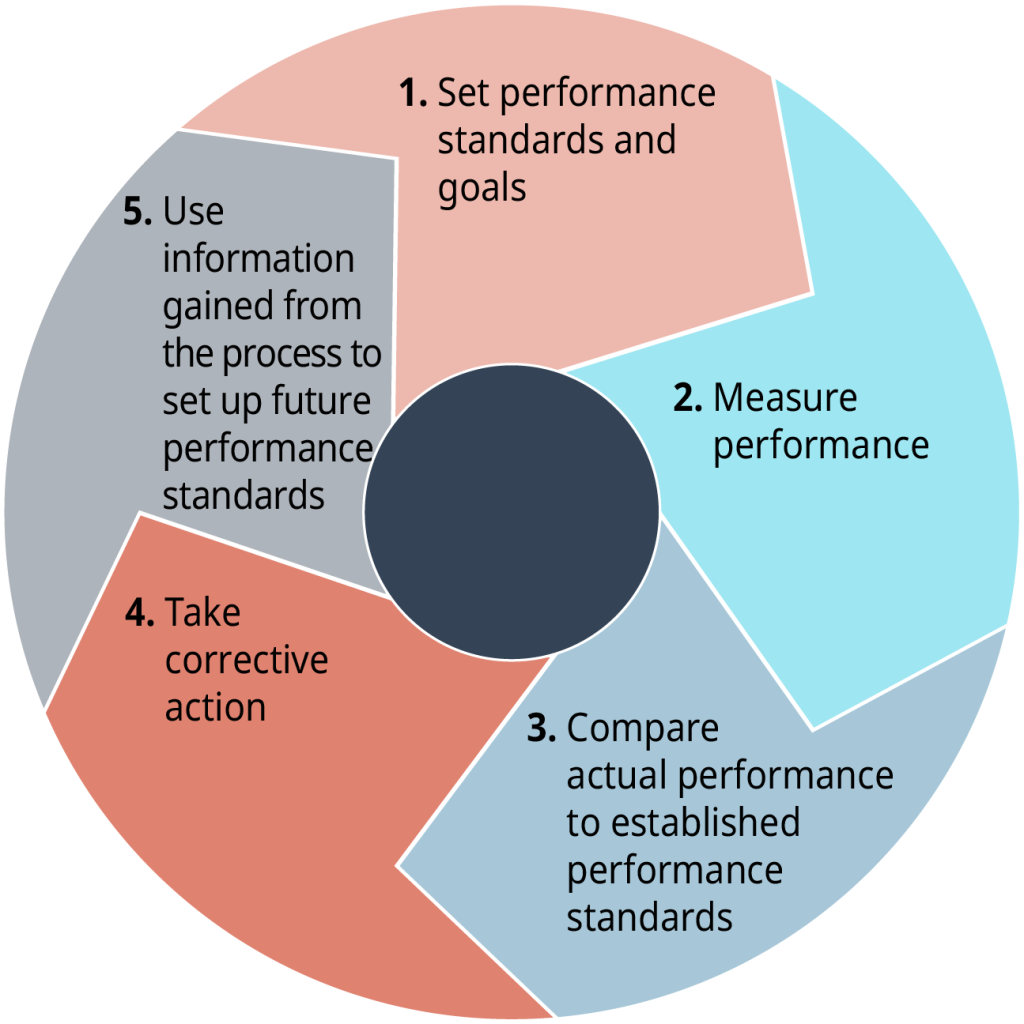
The measurement of performance can be done in several ways, depending on the performance standards, including financial statements, sales reports, production results, customer satisfaction, and formal performance appraisals. Managers at all levels engage in the managerial function of controlling to some degree.
The managerial function of controlling should not be confused with control in the behavioral or manipulative sense. This function does not imply that managers should attempt to control or to manipulate the personalities, values, attitudes, or emotions of their subordinates. Instead, this function of management concerns the manager’s role in taking necessary actions to ensure that the work-related activities of subordinates are consistent with and contributing toward the accomplishment of organizational and departmental objectives.
Effective controlling requires the existence of plans, since planning provides the necessary performance standards or objectives. Controlling also requires a clear understanding of where responsibility for deviations from standards lies. Two traditional control techniques are budget and performance audits. An audit involves an examination and verification of records and supporting documents. A budget audit provides information about where the organization is with respect to what was planned or budgeted for, whereas a performance audit might try to determine whether the figures reported are a reflection of actual performance. Although controlling is often thought of in terms of financial criteria, managers must also control production and operations processes, procedures for delivery of services, compliance with company policies, and many other activities within the organization.
Project controls provide information that allow managers to make informed and timely decisions that prevent project risks. A manager must keep things on track and within scope throughout the project. Without a project control process, it’s difficult to answer important questions about the project, which may impact or complicate project success.
Some reasons why projects might go off track without project controls include:
Through the control process, managers can catch when things don’t go as planned and quickly course correct to keep the project on track.
Benchmarking could be considered as a specialized kind of control activity. Rather than controlling a particular aspect of performance (say, defects for a specific product), benchmarking aims to improve a firm’s overall performance. The process of benchmarking involves comparisons to other organizations’ practices and processes with the objective of learning and improvement in both efficiency and effectiveness.
Benchmarking exercises can be conducted in a number of ways:
Check your understanding of this chapter’s concepts by completing this short self-check quiz.
An interactive H5P element has been excluded from this version of the text. You can view it online here:
https://ecampusontario.pressbooks.pub/businessfundamentals/?p=257#h5p-7
The contents of this chapter is a compilation sourced from various OER resources, please refer to the Book Information for details.
(Note: This reference list was produced using the auto-footnote and media citation features of Pressbooks)
Belyh, A. (2023, May 24). 11 management skills used by top managers (types & examples). https://www.founderjar.com/management-skills/
Belyh, A. (2023, May 24). 11 management skills used by top managers (types & examples). https://www.founderjar.com/management-skills/
Belyh, A. (2023, May 24). 11 management skills used by top managers (types & examples). https://www.founderjar.com/management-skills/
Brigole, J. (2021, March 24). Types of planning: Strategic, tactical, operational & contingency planning. [Video]. YouTube. https://www.youtube.com/watch?v=QIG_CGNP2hE
White, J. & Bottorff, C. (2024, May 28). What is a SWOT analysis? Download our free template. https://www.forbes.com/advisor/business/what-is-swot-analysis/
SmartDraw. (2018, August 17). SWOT Analysis – What is SWOT? Definition, examples and how to do a SWOT analysis. https://www.youtube.com/watch?v=JXXHqM6RzZQ[Video]. YouTube.
Sim Institute. (2020, November 15). The Five Forces Analysis Explained. [Video]. YouTube. https://www.youtube.com/watch?v=ehSQR6oMBHA&t=37s
Bhasin, H. (2021, January 6). Span of control – Definition, meaning, factors, examples. https://www.marketing91.com/span-of-control/
Marketing Business Network. (2019, May 18). What is organizational structure? [Video]. YouTube. https://www.youtube.com/watch?v=RcGCFX95ejE
Thompson, A. (2023, August 24). 3M industry, organizational structure, management philosophy. https://panmore.com/3m-industry-organizational-structure-management-philosophy
Thompson, A. (2023, August 24). 3M industry, organizational structure, management philosophy. https://panmore.com/3m-industry-organizational-structure-management-philosophy
University of Windsor & Ryerson University. (2022). Indigenous lifeways in Canadian business. https://ecampusontario.pressbooks.pub/indigenousbusinesstopics/chapter/chapter-1/
Cherry, K. (2024, June 19). How transformational leadership can inspire others. https://www.verywellmind.com/what-is-transformational-leadership-2795313
steemit. (2016). Pros and cons of decentralization. https://steemit.com/blog/@mgibson/pros-and-cons-of-decentralization
Indeed Editorial Team. (2024, August 15). A guide to equity theory of motivation. https://www.indeed.com/career-advice/career-development/equity-theory-of-motivation#:~:text=What%20is%20the%20equity%20theory%20of%20motivation%3F%20The,organization%20compared%20to%20what%20they%20get%20in%20return.
Fortune. (2017, October 30). Fortune 100 best companies to work for 2017. http://fortune.com/best-companies/google/
Team Asana. (2024, January 18). 5 project controls and where to implement them. https://asana.com/resources/project-controls
4
After reading this chapter, you should be able to do the following:
Entrepreneurship is important for economic growth. New companies create employment, contribute to a nation’s GDP, and bring new and innovative products and services to consumers. Some small business founders like Henry Ford and Thomas Edison have even gained places in history. Others, including Bill Gates (Microsoft), Mike Lazaridis (Research in Motion), Steve Jobs (Apple Computer), and Larry Page and Sergey Brin (Google), have changed the way global business is done today.
Entrepreneurship plays a vital role in the growth and development of economies and societies. Here are five key points highlighting its importance:

Entrepreneurship is not just about starting businesses; it is a catalyst for economic prosperity, innovation, and societal transformation. By fostering creativity, empowering individuals, and addressing pressing global challenges, entrepreneurship builds a more sustainable and equitable future. Governments and institutions must encourage and support entrepreneurial endeavors to unlock their full potential.
“A society becomes greater if the employment base is large and diversified. It brings about changes in society and promotes facilities like higher expenditure on education, better sanitation, fewer slums, a higher level of homeownership.”
“Entrepreneurship increases income levels, therefore improving standards of living. Entrepreneurs identify challenges in the lives of customers and provide appropriate business solutions. Additionally, they hire new employees who receive remuneration and this income gets circulated in the economy. All of the spending and salaries generate incremental wealth, therefore improving standards of living.”
“Entrepreneurs play a key role in increasing the standard of living in a community. They do this not just by creating jobs, but also by developing and adopting innovations that lead to improvements in the quality of life of their employees, customers, and other stakeholders in the community. New and improved products, services or technology from entrepreneurs enable new markets to be developed and new wealth to be created. Additionally, increased employment and higher earnings contribute to better national income in the form of higher tax revenue and higher government spending.”
The success or failure of small businesses is influenced by a variety of factors. Understanding these can help entrepreneurs make informed decisions and improve their chances of success.
Success hinges on strategic planning, adaptability, customer focus, and sound financial management. Small businesses must remain proactive, monitor performance, and adapt to challenges to thrive in a competitive environment.
Here are some of the reasons small businesses are successful:
There are several factors that contribute to the failure of small businesses including insufficient cash flow, pricing issues, and lack of focus. However, the main reason is the lack of research and offering a product or a service there is no market for.
Failures often stem from internal factors like poor planning, financial mismanagement, or lack of experience, as well as external factors such as economic shifts or market saturation.
Here are some of the reasons small businesses fail:
While there are different ways to define a small company in Canada, the most straightforward way is to look at the number of employees. Companies with less than a hundred members of staff are considered small businesses in Canada. As more consumers are shopping online, small companies often do not have the workforce or the know-how to create an online presence, nor pricing, that could compete with larger companies. As a result, many small Canadian companies are struggling and they do not expect their sales to increase. Yet, small businesses are the backbone of the Canadian economy, making a significant contribution towards the Canadian gross domestic product (GDP). They are also vital in keeping the employment numbers up in Canada.
Below are some Small Business Statistics in Canada:
An entrepreneur is someone who starts, owns and operates a business. It is difficult to generalize about the kind of people attracted to the idea of starting their own business because entrepreneurs are increasingly diverse. An interesting portrait of Canadian entrepreneurs emerged from a 2019 BDC survey of 1,025 Canadian business owners. Among the findings:
While entrepreneurs do require many skills and abilities, they may not have all the skills they need to run a business successfully. In these cases, an entrepreneur might hire a consultant, a contract employee, or a full-time employee to support the business tasks for which the entrepreneur is lacking skills or may not have the time to focus on. For example, as an entrepreneur, if accounting is your weakness you might hire an accountant, payroll service, or bookkeeper. If sales or marketing are not skills you have developed you might hire a salesperson or contract a marketing company to help you build marketing campaigns. While hiring consultants, services, or employees does cost money, you can rest assured it is being done accurately, and the investment should pay off.
Some of the key traits found in entrepreneurs include the following.
There are three characteristics of entrepreneurial activity:
There are some common motivational factors identified in many entrepreneurs. For instance, entrepreneurs are often motivated by much more than money and most start their business to become their own boss. In BDC’s survey, when asked why they became an entrepreneur, the most popular answer—cited by 70%—was independence, autonomy, and flexibility. About one in two mentioned passion or self-fulfillment and one third cited financial reasons. Refer to Figure 9.1 below to view survey results for motivational factors that influence entrepreneurial success.
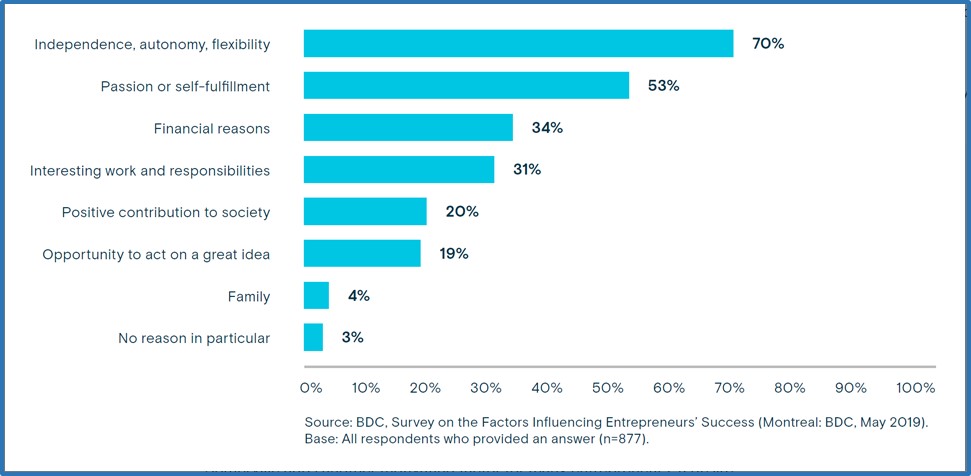
“The 2019 BDC survey of business owners sheds additional light on what makes Canadian entrepreneurs tick. Three in four said they had to deal with financial insecurity, significant stress, and a lack of benefits. Yet, 90% were professionally satisfied.”

There are many types of entrepreneurs and depending on which website you read, you may see a list of five to fifteen types of entrepreneurs. The type of entrepreneur you are depends on your goals and personal characteristics (e.g., skills, knowledge, creativity, interests, preferences, situation in life, drive, determination, etc.).
The Indeed Editorial Team (2023) provides the following list of nine different types of entrepreneurship.
Some people start businesses in order to help society, people, and communities. A social entrepreneur does not start a company with their main goal being to make a profit, instead, their goal is to make positive change in the world. Their goals often align with the United Nations Sustainable Development Goals (as shown in Figure 9.2 below) and their efforts may have a local, national, or global impact. “Whether it’s reducing poverty, ending homelessness, or fighting climate change—social entrepreneurs are, first and foremost, committed to a cause. While starting a business to support a worthy cause is admirable, the venture still requires focus and serious processes to be sustainable and reach the desired social or environmental impact.”
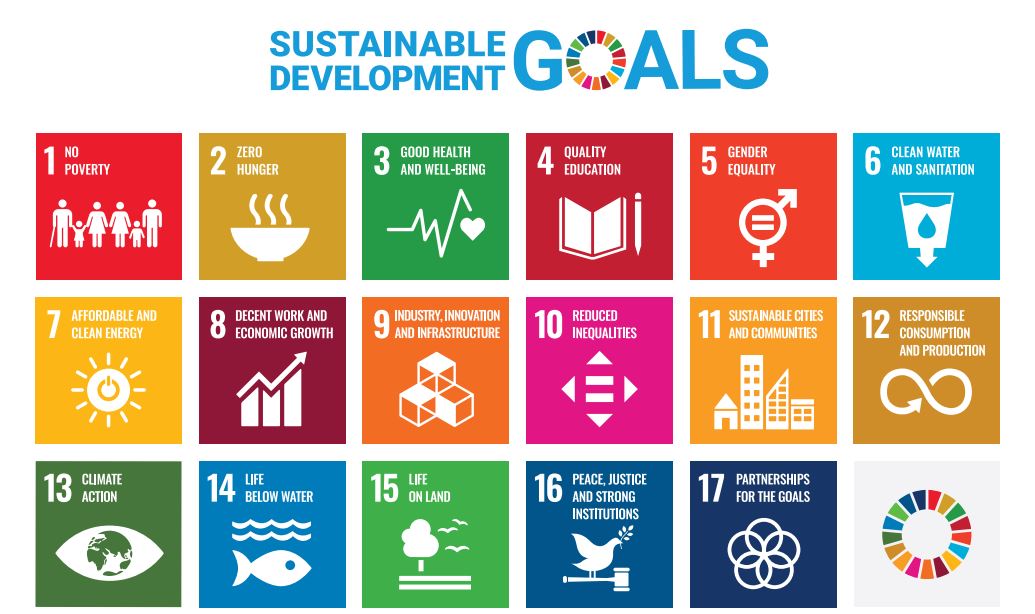
“These entrepreneurs might be for-profit or non-profit, and they operate under the umbrella of social enterprise or entrepreneurship. It recognizes societal issues, donates profits or uses grants or raises, and mobilizes resources for the greater good. Poverty reduction, child rights restoration, access to health care and financial services, women empowerment, and community development are the most common issues these entrepreneurs address. They often persuade societies, large organizations, and governments to encourage social transformation by addressing unmet needs and social issues.”
“Entrepreneur Mark Marsolais-Nahwegahbow brought his background in Indigenous law, business, and education to the founding of the Birch Bark Coffee Company on Birch Island in the District of Manitoulin Island. The company offers organic, fair trade, and small-producers-certified coffee. He is bringing sustainable revenue and a more secure future to his community with a larger goal of improving Indigenous lives across Canada. He has pledged, for instance, to devote a portion of company profits to purchase certified water purifiers for those on every reserve without access to clean drinking water. Through his example and speaking engagements, Mark seeks to inspire young Indigenous people to respect tradition and, possibly through entrepreneurship of their own, build a better future for themselves and their communities.”
Play the YouTube video below, “What is Social Innovation? How do you actually DO it (and change the world)?”, to learn more about the steps involved in creating a social innovation. Amber Melanie Smith provides a specific example of a social innovation related to food insecurity and applies the design thinking methodology to step through the stages of identifying the problem, empathizing, defining the problem, ideating, prototyping, and testing the solution. Transcript for “What is Social Innovation? How do you actually DO it (and change the world)?” Video [PDF–New Tab]. Closed captioning is available on YouTube.
A necessity entrepreneur is someone who starts a business based on a need for income, out of necessity, because they cannot find employment, have lost their job, need to supplement their income, or require flexibility to attend to other demands in their lives. Some necessity entrepreneurs find business ideas to pursue after retirement or after being downsized. “A typical necessity entrepreneur is over 50 years of age, has been unemployed for over a year, and sees the possibility of finding full-time employment dwindling.”
“A business started out of necessity is usually initiated through some sort of bad luck, i.e. a job loss, redundancy, or even ill health. These entrepreneurs are hesitant because, in all honesty, they would rather be working for a large corporation with the guarantee of a monthly income, however for whatever reason, that is not an option. As with all entrepreneurs, be they averse to starting a business or not, they have a particular knowledge or know a specific product that they think is of value to others. To be able to share this knowledge/product with the world is all they know so, if the only way to be able to use these specialities is to create their own business that’s what they do.” An example of this might include a parent with an autistic child who finds it difficult to work a full-time job and still provide the care and attention required to support their child. This parent decides to stay home to take care of their child because they feel they are the best person to do so. The parent then starts to receive many questions from friends and family about autism, and they realize that there may be a need for this type of service. They decide to obtain formal credentials and they complete an online program in the field of autism and behavioural science. Once formally qualified, they start a business providing advice to families about autism as a fee-based service. This works well for the necessity entrepreneur because they can now earn an income by providing a needed service and still take care of their child.
An opportunity entrepreneur is someone who sees an opportunity to make money, gets involved at the right time, and aims for business growth and economic development. For example, “Matt Horan started Rollasole after his girlfriend always complained of walking home in High Heels. With his first entrepreneurial venture he created the first vended shoe, launching Rollasole in his local nightclub. From his hometown, word spread and he built up his business selling his shoes online, in stores and in vending machines. Soon the bright lights of Vegas came calling and after a chance meeting with Ashley Ross an unlikely partnership was formed to bring Rollasole into the States.” Sometimes one great idea acts as a catalyst for other great ideas and today we can find vending machines dispensing sneakers, dress shoes, “emergency” shoes, and “flip flops” for beach wear or when you need a pair of shoes to enter a restaurant. So many great ideas!

Another example of an opportunity entrepreneur is Tim Horton, who was a Canadian hockey player, and In 1964 he founded the first Tim Horton doughnut shop in Hamilton, Ontario, which later grew into a chain of franchises across Canada and eventually the United States. Burger King purchased Tim Hortons in 2014 and the two brands became subsidiaries of Restaurant Brands International Inc. (RBI). As of August 2022, RBI is one of the world’s largest quick-service restaurant companies with over $35 billion in annual system-wide sales and over 29,000 restaurants in more than 100 countries.
Sometimes a potential entrepreneur identifies an opportunity to make a new product or start a new business which may be a combination of a profit-making business idea that also supports a socially sustainable goal or a business created out of necessity that not only makes a profit but also supports a socially sustainable goal.
A good example of a social and profit-making business is 31 Bits. During a trip to Uganda, marketing and international development college student, Kallie Dovel, realized that many of the uneducated single mothers she had met during her trip had exceptional skills and resourcefulness in making jewelry out of old posters. Kallie identified an opportunity to sell this jewelry so she partnered with a few of her college peers and formed the company 31 Bits. The company employs artisans, women from Uganda, with these exceptional skills and ensures they are paid a fair wage. The company also promotes ethical sourcing by allowing for family time, providing dignified careers, and preserving culture. The mission statement for the company is “We use fashion and design to drive positive change in the world by providing artisans with dignified opportunities and inspiring customers to live meaningful lives.” Nearly a decade later, 31 Bits can be found in hundreds of stores and has been endorsed by celebrities like Sophia Bush, Candace Cameron Bure, and Jessica Alba, and has been written about by Forbes, Harper’s Bazaar, and Elle. Most importantly, hundreds of artisans’ lives have been changed forever.
The Business Development Bank of Canada (BDC) provides an ultimate guide to starting a business in Canada. This step-by-step guide provides resources and answers to many questions an entrepreneur may need when considering starting a new business.
The legal framework of a business, business structure or form of business ownership, determines how the business is organized, who owns it, and how it is taxed. When starting your business, choose the business structure that best suits your needs. There are four types of business structures in Canada: sole-proprietorship, partnerships, corporations and cooperatives.
A sole-proprietorship is a simple, unincorporated business owned and operated by one person. The owner has complete control, receives all profits, and is fully liable for the business’s financial and legal situation. A sole-proprietorship is the easiest and most common way to start a business, but it does come with drawbacks, and all of the responsibility for the business’s success rests with you as the owner. Examples of sole proprietorship businesses include independent photographers, small landscaping companies, freelance writers, and personal trainers.
A partnership is a non-incorporated business owned by two or more people who share profits and responsibilities and risks.
A major problem with partnerships, as with sole proprietorships, is unlimited liability: in this case, each partner is personally liable not only for his or her own actions but also for the actions of all the partners. If your partner in an architectural firm makes a mistake that causes a structure to collapse, the loss your business incurs impacts you just as much as it would your partner. And here is the really bad news: if the business does not have the cash or other assets to cover losses, you can be personally sued for the amount owed. In other words, the party who suffered a loss because of the error can sue you and/or your partner for your personal assets. Many people are understandably reluctant to enter into partnerships because of unlimited liability. Certain forms of businesses allow owners to limit their liability. These include limited partnerships and corporations.
Partners are considered self-employed for tax purposes and have unlimited liability unless an LLP (limited liability partnership) is created. LLP allows partners to pool resources while limiting their liability for other partners’ professional negligence. Limited partnerships have at least one general partner show assumes unlimited liability, and at least one limited partner whose liability is limited to their investment in the business. Each Canadian province has its own partnership legislation, but all provinces recognize general partnerships and limited partnerships. Partners may have disagreements; therefore, a partnership agreement usually stipulates how decisions will be made, how responsibilities will be divided, and how profits will be split.
The impact of disputes can be lessened if the partners have executed a well-planned partnership agreement that specifies everyone’s rights and responsibilities. The agreement might provide such details as the following:
A corporation is a separate legal entity from its shareholders and can be incorporated at the federal or provincial level. Corporations offer flexible structure and the ability to divide ownership with shares. A corporation is a legal entity that separates the business from its owner/operator. Therefore, its shareholders have limited liability. Corporations can choose to incorporate federally or provincially.
Incorporation makes it possible for businesses to raise funds by selling stock. This is a big advantage as a company grows and needs more funds to operate and compete. Depending on its size and financial strength, the corporation also has an advantage over other forms of business in getting bank loans. An established corporation can borrow its own funds, but when a small business needs a loan, the bank usually requires that it be guaranteed by its owners.
Corporations are owned by shareholders who invest money in the business by buying shares of stock. Therefore, there is no ownership control by one person as in a proprietorship. The portion of the corporation the shareholders own depends on the percentage of stock they hold. For example, if a corporation has issued 100 shares of stock, and you own 30 shares, you own 30 percent of the company. The shareholders elect a board of directors, a group of people (primarily from outside the corporation) who are legally responsible for governing the corporation. The board oversees the major policies and decisions made by the corporation, sets goals and holds management accountable for achieving them, and hires and evaluates the top executive, generally called the CEO (chief executive officer). The board also approves the distribution of income to shareholders in the form of cash payments called dividends. Ownership can be transferred by selling shares and therefore is not dependent upon the life of the owner, board of directors or a specific shareholder.
Like sole proprietorships and partnerships, corporations have both positive and negative aspects. In sole proprietorships and partnerships, for instance, the individuals who own and manage a business are the same people. Corporate managers, however, don’t necessarily own stock, and shareholders don’t necessarily work for the company. This situation can be troublesome if the goals of the two groups differ significantly.
Managers, for example, are often more interested in career advancement than the overall profitability of the company. Stockholders might care more about profits without regard for the well-being of employees. This situation is known as the agency problem, a conflict of interest inherent in a relationship in which one party is supposed to act in the best interest of the other. It is often quite difficult to prevent self-interest from entering into these situations.
Another drawback to incorporation — one that often discourages small businesses from incorporating — is the fact that corporations are more costly to set up. When you combine filing and licensing fees with accounting and attorney fees, incorporating a business could set you back by $1,000 to $6,000 or more depending on the size and scope of your business. Additionally, corporations are subject to levels of regulation and governmental oversight that can place a burden on small businesses. Finally, corporations are subject to what’s generally called “double taxation.” Corporations are taxed by the federal and provincial governments on their earnings. When these earnings are distributed as dividends, the shareholders pay taxes on these dividends. Corporate profits are thus taxed twice—the corporation pays the taxes the first time and the shareholders pay the taxes the second time.

A co-operative is controlled by its members and can operate for profit or as a not-for-profit. Co-ops are structured to meet the common needs of their members rather than maximize profits for shareholders. Just like a corporation, it can be registered provincially or federally, and each option comes with its own advantages and disadvantages. Some of the largest co-operatives in Canada include:
The co-operative is democratically controlled (one member, one vote). Ensures all members have input but may result in slower decision-making. All members need to participate for a co-op to be successful. Member benefits in receiving special discounts, deals, education, training, services, and sometimes dividends. Surplus revenue is distributed back to the members, proportional to their use of the cooperative’s services. Members share in profits and losses so they may be less willing to take risks or to invest in long-term projects.
Members contribute financially to the co-op by purchasing membership shares and using the co-op’s services. Members participate in the co-op’s governance by attending meetings, voting on major decisions, and electing the board of directors. Members follow the co-op’s bylaws and policies. Members offer suggestions on how to improve the co-op. Members volunteer some of their time and often serve on a committee. Therefore, all members need to participate for a co-op to be successful.
Refer to Table 4.1 for a comparison of the forms of business ownership.
| Characteristic | Sole-proprietorship | Partnership | Corporation | Co-operative |
|---|---|---|---|---|
| Ease of formation | High | High | Medium | Medium |
| Continuity | Low | Low | High | High |
| Protection against liability | Low | Low | High | High |
| Tax advantages | High | High | Low | High |
| Ease of raising money | Low | Medium | High | High |
| Government regulation | Low | Low | High | Medium |
When starting a new business an entrepreneur must decide which choice is best for them when it comes to starting a business from scratch, buying a used business from another owner, or buying a franchise business. Each has its own benefits and drawbacks. Starting a business from scratch is ideal for innovators with a strong vision, risk tolerance, and creativity. Buying an existing business is best for those who want immediate operations and are comfortable managing an established system. Franchising is great for individuals seeking lower risk and structured support while operating under a recognized brand.
A franchise business is a business where the owner grants licenses to licensees to operate the business (sell its products, provide services, and more) at a business location. Think of Baskin-Robbins, CrossFit or another business that you’ve seen in multiple cities. Each location is a franchisee with its own management that pays a fee to the franchisor (the owner) to “rent” the brand name.
Below are the main financial elements of starting a franchise.
Given the stakes, it’s important to thoroughly weigh your business goals, risk tolerance and market opportunities before making an acquisition. To learn more about the pros and cons of buying an existing business review this BDC article.

A business acquisition is a financial transaction where one company buys the majority or all of another company’s shares or assets, giving the acquiring company control over the target company. Acquisitions are often amicable, with both companies agreeing to the terms of the deal. However, the term “acquisition” can also be used to describe a hostile takeover, where one company buys a majority stake against the wishes of the target company’s management or board of directors. A firm effectively gains control of that company if it buys more than 50% of a target company’s shares. Acquisitions are often carried out with the help of an investment bank because they’re complex arrangements with legal and tax ramifications.
An example of a business acquisition is Microsoft’s acquisition of Activision Blizzard for $68.7 billion in 2023. This deal brought popular gaming franchises like Call of Duty, World of Warcraft, and Candy Crush under Microsoft’s umbrella, significantly boosting its presence in the gaming industry. It also positioned Microsoft to compete more aggressively in the gaming market against rivals like Sony and expanded its potential in the growing metaverse and cloud gaming sectors.
Below are a few reasons for a company to acquire another company:
A company merger is when two or more companies join together to form a new company with a single stock. During a merger, the two companies negotiate terms such as the valuation of assets and the exchange ratio. While mergers are often thought of as an equal split, one company may end up with a larger percentage of ownership in the new company. Mergers are similar to acquisitions or takeovers, and the two actions are often grouped together as mergers and acquisitions (M&A).
Companies may merge for a number of reasons, including:
A strategic alliance and a joint venture are both collaborative business arrangements between companies, but they differ in structure, commitment, and goals.
A strategic alliance is a partnership between two or more businesses to work together on a common goal, while each company remains independent. The goal is to share resources and capabilities to create mutual value, such as by entering new markets, developing new products, or increasing innovation.
The other types of strategic alliances are equity strategic alliances and non-equity strategic alliances:
A joint venture (JV) is a business collaboration in which two or more companies create a new, independent legal entity to achieve a specific business objective or undertake a particular project. In this arrangement, the companies share ownership, profits, risks, and governance of the newly formed entity. JVs often require substantial capital investment and a long-term commitment, typically concluding once the objective is met unless the parties agree to extend the venture.
Alternatively, a JV can also refer to a business agreement where two or more parties combine resources to pursue a common goal. These ventures leverage the strengths of each participant, often yielding mutual benefits. For example, a hairstylist and a nail salon might collaborate in a JV to attract more customers and increase profits. While JVs can adopt various legal structures, they are generally characterized by shared ownership, financial returns, risks, and decision-making authority. The terms of the JV are usually outlined in a private and confidential contract. A prevalent form of JV is the project-based joint venture, which dissolves upon the completion of the specified project.
There are two main ways of setting up a joint venture in Canada. The first is for the partners to agree on a contract that will set out the terms of the venture; the second is to form a separate corporate entity.
Below are a few advantages and disadvantages of joint ventures:
Advantages of a joint venture:
Disadvantages of a joint venture:
Generally, the main difference between a joint venture and other types of strategic alliances is that a joint venture creates a separate legal entity, while a strategic alliance does not. For example, in 2022, these companies announced a joint venture to build a battery plant in Columbus, Ohio to produce lithium-ion EV batteries for Honda’s electric vehicles.
An example of a joint venture is the one between Sony and Honda to create an electric vehicle. The joint venture, called “Afeela”, is a collaboration between the electronics company Sony and the automobile company Honda. The goal is to combine Sony’s expertise in imaging, networks, and entertainment with Honda’s skills in mobility development, technology, and sales. The company plans to take pre-orders in 2025 and deliver the vehicle in the U.S. in 2026.
Refer to Table 4.2 for key differences between strategic alliances and joint ventures.
| Aspect | Strategic Alliance | Joint Venture |
|---|---|---|
| Legal Structure | No new entity formed | New independent entity created |
| Commitment | Flexible and less binding | Long-term and formal commitment |
| Risk and Control | Risks and control are individual | Shared risks, profits, and governance |
| Duration | Typically short to medium term | Often long-term |
| Examples | Co-branding agreements, research collaborations | Infrastructure projects, product development partnerships |
An interactive H5P element has been excluded from this version of the text. You can view it online here:
https://ecampusontario.pressbooks.pub/businessfundamentals/?p=259#h5p-36

A business plan may change as your business grows or pivots in a new direction, so you will find the business plan is not fixed but flexible and needs to be revised from time to time. Any new or existing business can and should make use of a business plan. “In its simplest form, a business plan is a guide that outlines goals for your business and how you plan to reach them. It contains an overview of your business strategy, milestones to track tasks and responsibilities, and the basic financial projections you need to forecast your sales, expenses, and cash flow.” “The primary purpose of a business plan is to help you understand the direction of your business and the steps it will take to get there. Having a solid business plan can help you grow up to 30% faster and according to our own 2021 Small Business research working on a business plan increases confidence regarding business health—even in the midst of a crisis.” There is no one right way to write a business plan, your approach depends on your industry, and who is reading your plan. Ensure you include all the important information any lender or investor will want to see before they go into business with you.
Below is a brief description of the sections of a traditional business plan.
Play the YouTube video below, “What is a Business Plan? – BPlans Explains Everything”, to learn about what a business plan is and why and how you should use one. Transcript for “What is a Business Plan?” Video [PDF–New Tab]. Closed captioning is available on YouTube.
The business model canvas is a strategic planning tool used by managers to illustrate and develop their business model. The business model canvas template clearly identifies the key elements that make up a business. Additionally, it simplifies a business plan into a condensed form. In this way, the business model canvas template acts as an executive summary for the business plan.
The business model canvas is a great tool to help you understand a business model in a straightforward, structured way. Using this canvas will lead to insights about the customers you serve, what value propositions are offered through what channels, and how your company makes money. You can also use the business model canvas to understand your own business model or that of a competitor! The Business Model Canvas was created by Alexander Osterwalder, of Strategyzer.
The typical use for this tool is to outline the fundamental building blocks of a business, but it can be used effectively for individual products as well. It can be used to identify potential opportunities for growth and expansion, or areas that need improvement. The components may vary but typically the business model canvas includes the following nine building blocks and each is represented by a rectangle in the model diagram.
Play the YouTube video below, “Introduction to the Business Model Canvas”, to learn about what a business model canvas is and why and how you should use one. Transcript for “Introduction to the Business Model Canvas” Video [PDF–New Tab]. Closed captioning is available on YouTube.
The University of Toronto, The Bridge, Scarborough Campus, offers a free entrepreneurship course within its open learning series. “We welcome students, staff, faculty, alumni, and local and international community of emerging entrepreneurs to enhance your learning of entrepreneurship through the award-winning Entrepreneurship Open Learning Series. Start your entrepreneurship journey by completing training modules that teach you core management principles to help perfect your business plans and pitches.”
After you complete the entrepreneurship course within the open learning series you will be able to do the following:
There are many free online courses in entrepreneurship and many other subjects. These courses are offered by various education providers, often in addition to their fee-based courses, and include Massachusetts Institute of Technology (MIT), INSEAD, University of Toronto, McMaster University, University of Michigan, Stanford Online, Open Yale Courses, Harvard University, LinkedIn Learning, FutureLearn, Coursera, Edx, Udacity, edX, Khan Academy, YouTube, and more. Some courses are referred to as MOOCs, Open Courses, and Free Trials or Demos.
“The Recommendation on Open Educational Resources (OER), adopted by UNESCO’s General Conference at its 40th session on 25 November 2019, is the first international normative instrument to embrace the field of openly licensed educational materials and technologies in education. OER are defined in this Recommendation as learning, teaching and research materials in any format and medium that reside in the public domain or are under copyright that have been released under an open license, which permit no-cost access, re-use, re-purpose, adaptation and redistribution by others.”
There are many free ebooks, case studies, video tutorials, and lessons on many subjects, including entrepreneurship, available from eCampus Ontario, BCCampus, OpenStax, OER Commons, Saylor Academy, Khan Academy, MERLOT, Directory of Open Access Journals (DOAJ), Open Textbook Library, OASIS, and more.
The Government of Canada provides support for entrepreneurs and provides specific initiatives to aid entrepreneurs from various demographic and geographical groups. For example, the Strategic Partnerships Initiative (SPI) helps Indigenous communities participate in complex economic opportunities. An additional $300 million is available until 2027 for clean energy projects in Indigenous, rural and remote communities across Canada. The Aboriginal entrepreneurship program (AEP) provides access to capital and access to business opportunities to Indigenous entrepreneurs and business owners in Canada.
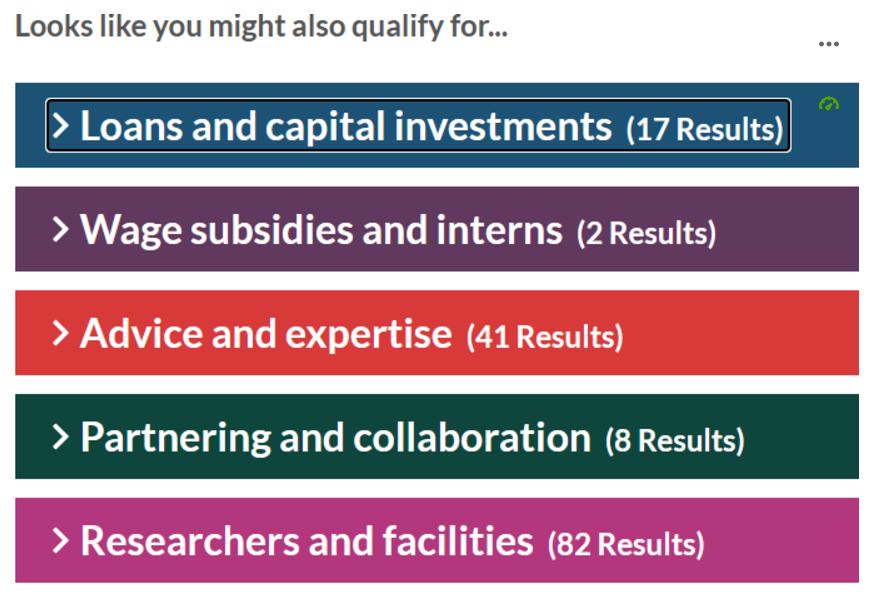
The Government website provides a search tool for entrepreneurs seeking financial or other types of support to start or expand their businesses. An entrepreneur can use the business benefits finder to search for support in several categories including Canadians, Indigenous Peoples, Black Canadians, Other Racialized Persons, Women, Language Minorities, 2SLGBTQI+, Newcomers to Canada, Persons with Disabilities, Youth (<40), and Rural or Northern Residents. Give it a try by visiting the Business Benefits Finder and answering a few short questions about a business you might like to start and discover if there are any Government supports for you, as an entrepreneur.
The Government of Canada and many chambers of commerce have mentoring programs designed to facilitate contact between business leaders and budding entrepreneurs. Local economic development centers and some business leaders’ associations offer similar programs. The Government of Canada, Starting a Business website, also provides information for registering a business, getting business support and financing, choosing a business name, applying for business permits and licenses, and tax help. The Canadian Government’s Business Grants and Financing website provides information on Government financing programs, loans and capital investments, wage subsidies, grants, tax credits, and managing your business finances. Some grant and loan programs in Canada include Business Start Program (BSP) in Manitoba, Youth Entrepreneurship Partnership Program in Ontario, Jeunes Promoteurs in Quebec, and Canada Small Business Financing Program.
Governments in countries other than Canada may also offer incentives for new business start-ups. Some government programs specifically offer support to young entrepreneurs, entrepreneurs starting businesses within specific industries in which the government may be trying to grow the economy, and entrepreneurs who are part of specific minority groups. For example, The U.S. Small Business Administration (SBA) is a federal agency that provides assistance to current and prospective small business owners.. There are also several federal entrepreneur programs for immigrants, such as the Microenterprise Development Program and the Minority Business Development Agency Business Centers.
The Business Development Bank of Canada (BDC) offers many tools and resources, as well as advice, to entrepreneurs and business owners. “We support small and medium-sized businesses in all industries and at every stage of growth with money and advice. We are the Business Development Bank of Canada.”
“Crowdfunding is a kind of crowdsourcing and alternative financing by which people, via the Internet, can contribute money to a person, cause, event, or business venture. This method has been used to fund startup businesses, help communities suffering from a natural disaster, and aid families and individuals in financial need due to a medical emergency or a death. Crowdfunding is now a common method for connecting entrepreneurs and investors—offering an alternative to bank loans or venture capitalists—and it is now a popular way of supporting cultural institutions, such as art organizations and charities. Billions of dollars are raised annually via this fundraising method. A high-profile example of crowdfunding is Oculus VR, now part of Meta (the parent company of Facebook). It produces virtual reality headsets and other hardware and software. The firm’s founder, Palmer Luckey, used Kickstarter to raise $2.4 million (U.S.) in 2012, vastly exceeding its crowdfunding goal of $250,000. Facebook purchased the company for $2 billion in cash and stock in 2014.”
“A business incubator is a specialized program designed as a space for new businesses to learn and grow. The programs provide services for entrepreneurs and startups while offering reduced rates for supplies and workspace. Typically, young businesses must apply for a position and commit to a certain amount of time in the program. While in a business incubator, companies can more thoroughly plan their business, learn from other individuals and save money.”
“A business accelerator is a program designed to help established startups scale quickly, and often provide funding in exchange for equity in the business. Accelerators often require startups to already have a minimum viable product or a fixed team before they can apply. Once admitted, startups go through an intense period of growth and development, often over the course of three to six months.”
Here are a few examples of business incubators and accelerators. Be sure to check with your college or university to see if there is an incubator or accelerator available on campus.
Seneca College has HELIX. “HELIX’s Innovation and Entrepreneurship Incubator has a process that provides future entrepreneurs with resources and support to help develop their innovation mindset and grow their new ventures from ideation to launch and scaling. The process involves two stages or ‘strands’ – the INNOVATION Strand and the ACCELERATION Strand. Those who want to enter the ACCELERATION Strand of HELIX must complete all six workshops of the INNOVATION Strand and deliver a pitch of their proposed venture idea.”
The MIT delta v accelerator is the capstone entrepreneurial experience for students at MIT. MIT REAP is a dynamic global initiative with two programs – Global and Focus – that engages with communities around the world to strengthen innovation-driven entrepreneurial ecosystems and transform economies.
MaRS Discovery District innovation hub works with business startups to scale-ups. MaRS offers a range of services and a Start-up toolkit that help tech founders grow their companies and create meaningful innovation: solving real problems for real people. MaRS works with hundreds of companies across the country, turning breakthrough ideas into products and services with global impact.
“At District 3 we work with founders and their startup teams to help them validate their business and get to scaling it, faster and better. As a founder, you’ll be receiving tons of information and opinions about what you need to do to run your startup successfully and you’ll have to learn to select what to follow. This takes time and experience, and while there is no real way to teach it, there are tools and organizations out there that can make it easier for you—like this library!
“Futurpreneur has been fueling the entrepreneurial passions of Canada’s young enterprise for over two decades. We are the only national, non-profit organization that provides financing, mentoring and support tools to aspiring business owners aged 18-39. Our internationally recognized mentoring program hand matches young entrepreneurs with a business expert from a network of more than 2,600 volunteer mentors.”
An interactive H5P element has been excluded from this version of the text. You can view it online here:
https://ecampusontario.pressbooks.pub/businessfundamentals/?p=259#h5p-10
An interactive H5P element has been excluded from this version of the text. You can view it online here:
https://ecampusontario.pressbooks.pub/businessfundamentals/?p=259#h5p-9
The contents of this chapter is a compilation sourced from various OER resources, please refer to the Book Information for details.
(Note: This reference list was produced using the auto-footnote and media citation features of Pressbooks)
ByJus. (n.d.). Entrepreneurship–Types of entrepreneurship. https://byjus.com/commerce/what-is-entrepreneurship/
Harappa. (2021, April 19). What is entrepreneurship? – Meaning, features, need & examples. https://harappa.education/harappa-diaries/meaning-examples-and-role-of-entrepreneurship/
FastAdvices. (2020, July 10). How entrepreneurship affects the standard of living? https://yourfastadvices.com/how-entrepreneurship-affects-the-standard-of-living/
Blair, N. (2024, November 4). Small business statistics in Canada. https://madeinca.ca/small-business-statistics-canada/
Blair, N. (2024, November 4). Small business statistics in Canada. https://madeinca.ca/small-business-statistics-canada/
Blair, N. (2024, November 4). Small business statistics in Canada. https://madeinca.ca/small-business-statistics-canada/
BDC. (n.d.). How to become an entrepreneur. https://www.bdc.ca/en/articles-tools/start-buy-business/start-business/how-become-entrepreneur
Walker, B. (2020, May 11). Six personality traits of successful entrepreneurs. https://www.forbes.com/sites/theyec/2020/05/11/six-personality-traits-of-successful-entrepreneurs/?sh=319450e070ba
Alfred, L. (n.d.). 12 characteristics & personality traits great entrepreneurs share. https://blog.hubspot.com/sales/entrepreneur-personality-traits
Miller, K. (2020, July 7). 10 characteristics of successful entrepreneurs. Business Insights. https://online.hbs.edu/blog/post/characteristics-of-successful-entrepreneurs
Miller, K. (2020, July 7). 10 characteristics of successful entrepreneurs. Business Insights. https://online.hbs.edu/blog/post/characteristics-of-successful-entrepreneurs
Walker, B. (2020, May 11). Six personality traits of successful entrepreneurs. https://www.forbes.com/sites/theyec/2020/05/11/six-personality-traits-of-successful-entrepreneurs/?sh=319450e070ba
BDC. (n.d.). How to become an entrepreneur. https://www.bdc.ca/en/articles-tools/start-buy-business/start-business/how-become-entrepreneur
BDC. (n.d.). How to become an entrepreneur. https://www.bdc.ca/en/articles-tools/start-buy-business/start-business/how-become-entrepreneur
Indeed Editorial Team. (2023, March 10). The 9 different types of entrepreneurship (with examples). https://www.indeed.com/career-advice/career-development/types-of-entrepreneurship
Wirth, K. (2022, August 30). 12 Most Common Types of Entrepreneurs Explained. https://www.liveplan.com/blog/types-of-entrepreneurs/
Wallstreetmojo Team. (n.d.). Social entrepreneur. https://www.wallstreetmojo.com/social-entrepreneur/#:~:text=Types%20Of%20Social%20Entrepreneurship%201%20%231%20%E2%80%93%20Trading,Charities%20…%204%20%234%20%E2%80%93%20Community-Oriented%20Organizations%20
Boyko, J. (2022, April 7). Notable Indigenous entrepreneurs in Canada. https://www.thecanadianencyclopedia.ca/en/article/notable-indigenous-entrepreneurs
Smith, M. A. (2022, June 19). What is Social Innovation? How do you actually DO it (and change the world)? [Video]. YouTube. https://youtu.be/7G20_sPzR4g
CareerPivot. (n.d.). The necessity entrepreneur – A path to freedom [updated]. https://careerpivot.com/2020/necessity-entrepreneur-buying-job/
Incomeholic. (n.d.). What does it mean to start a business out of necessity? https://incomeholic.com/what-does-it-mean-to-start-a-business-out-of-necessity/#:~:text=A%20business%20started%20out%20of%20necessity%20is%20usually,for%20whatever%20reason%2C%20that%20is%20not%20an%20option.
Rollasole. About us. https://www.rollasole.com/pages/about-us
Restaurant Brands International. (2022, August 4). Restaurant Brands International Inc. report second quarter 2022 results. https://www.rbi.com/English/news/news-details/2022/Restaurant-Brands-International-Inc.-Reports-Second-Quarter-2022-Results/default.aspx
Thirty One Bits. (n.d.). Our mission. https://31bits.com/pages/our-mission
Thirty One Bits. (n.d.). Our story. https://31bits.com/pages/our-story
BDC. (n.d.). Your ultimate guide to starting a business in Canada. https://www.bdc.ca/en/articles-tools/start-buy-business/start-business/how-start-business-canada
BDC. (n.d.). Your ultimate guide to starting a business in Canada. [Video]. YouTube. https://www.bdc.ca/en/articles-tools/start-buy-business/start-business/how-start-business-canada
Wirth, K. (2022, February 21). What is a business plan? Definition and planning essentials explained. https://www.liveplan.com/blog/business-plan-definition-explained/
BDC. (n.d.). Your ultimate guide to starting a business in Canada. [Video]. YouTube. https://www.bdc.ca/en/articles-tools/start-buy-business/start-business/how-start-business-canada
AllBusiness. (2016). What are the costs of forming a corporation? https://www.allbusiness.com/costs-of-forming-a-corporation-502-1.html
Toomer-McApline, A. (2023, August 7). Co-ops ranked among Canada’s top 50 ‘corporate citizens’. https://www.thenews.coop/co-ops-ranked-among-canadas-top-50-corporate-citizens/#:~:text=Co%2Doperators%2C%20Desjardins%20and%20Vancity,the%20banking%20and%20insurance%20sectors&text=Co%2Doperators%2C%20Desjardins,placed%20top%20in%20their%20sectors.
Rittenberg, J. (2024, April 17). How to start a franchise in 8 steps (2024 guide). https://www.forbes.com/advisor/business/how-to-start-a-franchise/#:~:text=Here%20are%20the%20main%20financial%20elements%20of%20starting,liquid%20capital%20for%20a%20facilities-based%20business.%20More%20items
Kenton, W. (2024, June 16). Acquisition: Meaning, types, and examples. https://www.investopedia.com/terms/a/acquisition.asp#:~:text=An%20acquisition%20is%20a%20financial,and%20meet%20any%20legal%20stipulations.
Kenton, W. (2024, June 16). Acquisition: Meaning, types, and examples. https://www.investopedia.com/terms/a/acquisition.asp#:~:text=An%20acquisition%20is%20a%20financial,and%20meet%20any%20legal%20stipulations.
Schooley, Sk. (2023, November 8). What you should know about company mergers. https://www.businessnewsdaily.com/15786-company-mergers.html
Greenwich. (n.d.). How do mergers and acquisitions work? https://greenwichcapital.com.au/insights/how-do-mergers-and-acquisitions-work/#:~:text=Enhanced%20Competitive%20Position.%20The%20merger%20enhanced%20the,increasingly%20demanded%20seamless%20connectivity%20across%20various%20devices.
Hargrave, M. (2024, June 14). Joint venture (JV): What is it, and why do companies form one? https://www.investopedia.com/terms/j/jointventure.asp#:~:text=In%20a%20joint%20venture%20(JV,to%20enter%20a%20foreign%20market.
BDC. (n.d.). Joint venture. https://www.bdc.ca/en/articles-tools/entrepreneur-toolkit/templates-business-guides/glossary/joint-venture#:~:text=In%20Canada%2C%20the%20agreement%20governing,supplied%20by%20a%20movie%20franchise.
BDC. (n.d.). Joint venture. https://www.bdc.ca/en/articles-tools/entrepreneur-toolkit/templates-business-guides/glossary/joint-venture#:~:text=In%20Canada%2C%20the%20agreement%20governing,supplied%20by%20a%20movie%20franchise.
Suazo, R. (n.d.). 10 joint-venture examples you should know about. https://www.bundl.com/articles/10-joint-venture-examples-you-should-know-about#:~:text=In%202022%2C%20Honda%20and%20LG,3%2C000%20new%20jobs%20in%20Ohio).
Hargrave, M. (2024, June 14). Joint venture (JV): What it is, and why do companies form one? https://www.investopedia.com/terms/j/jointventure.asp#:~:text=Example%20of%20a%20Joint%20Venture,43
BPlans. (2016, March 17). What is a business plan? [Video]. YouTube. https://youtu.be/FIoGLHT4wGE
Wirth, K. (2022, February 21). What is a business plan? Definition and planning essentials explained. https://www.liveplan.com/blog/business-plan-definition-explained/
Indeed Editorial Team. (2023, March 20). 10 key business plan sections and why they’re important. https://uk.indeed.com/career-advice/career-development/business-plan-sections
Ferriolo, J. (2021, August 27). Seven sections your business plan should have. https://www.forbes.com/sites/forbesbusinessdevelopmentcouncil/2021/08/27/seven-sections-your-business-plan-should-have/?sh=6c8a168c1310
White, C. (2022, November 10). What’s a competitive analysis & how do you conduct one? https://blog.hubspot.com/marketing/competitive-analysis-kit
CFI Team. (2023, April 25). Business plan example and template. https://corporatefinanceinstitute.com/resources/management/business-plan-example-and-template/
CFI Team. (2023, April 25). Business plan example and template. https://corporatefinanceinstitute.com/resources/management/business-plan-example-and-template/
Indeed Editorial Team. (2023, March 20). 10 key business plan sections and why they’re important. https://uk.indeed.com/career-advice/career-development/business-plan-sections
Hayes, A. (2023, March 30). Business plan: What it is, what’s included, and how to write one. https://www.investopedia.com/terms/b/business-plan.asp
Indeed Editorial Team. (2023, March 20). 10 key business plan sections and why they’re important. https://uk.indeed.com/career-advice/career-development/business-plan-sections
BPlans. (2016, March 17). What is a business plan? [Video]. YouTube. https://youtu.be/FIoGLHT4wGE
CFI Team. (2023, July 7). Business model canvas template. https://corporatefinanceinstitute.com/resources/management/business-model-canvas-template/
Business Model Inc. (n.d.). Business model canvas. https://www.businessmodelsinc.com/en/inspiration/tools/business-model-canvas
Optima Training (UK) Limited. (2021, July 29). Introduction to the business model canvas. [Video]. YouTube. https://youtu.be/I8nwNcCfyig
University of Toronto. (n.d.). The bridge: Entrepreneurship open learning series. https://www.utsc.utoronto.ca/thebridge/entrepreneurship-open-learning-series
University of Toronto. (n.d.). The bridge: Entrepreneurship open learning series. https://www.utsc.utoronto.ca/thebridge/entrepreneurship-open-learning-series
University of Toronto. (n.d.). The bridge. https://www.utsc.utoronto.ca/thebridge/
UNESCO. (2023, April 20). UNESCO’s mandate in OER. https://www.unesco.org/en/open-educational-resources/mandate
Canada Energy Regulator. (2023, February 15) Market Snapshot: Clean Energy Projects in Remote Indigenous and Northern Communities. https://www.cer-rec.gc.ca/en/data-analysis/energy-markets/market-snapshots/2023/market-snapshot-clean-energy-projects-remote-indigenous-northern-communities.html#:~:text=Since%202017%2C%20the%20Clean%20Energy,million%20is%20available%20until%202027.
Government of Canada. (n.d.) Aboriginal entrepreneurship program: Access to business opportunities. https://www.isc-sac.gc.ca/eng/1582037564226/1610797399865
U.S. Department of Labor. (n.d.). Self-employment & entrepreneurship. https://www.dol.gov/agencies/odep/program-areas/employers/self-employment-entrepreneurship
Remitly. (2023). 15 Federal and State Programs for Immigrant Business Owners in the U.S. https://blog.remitly.com/immigration/federal-and-state-programs-for-immigrant-business-owners/
BDC. (n.d.). About. https://www.bdc.ca/en/about
Costa, D. (2022, November 15). Entrepreneurship. Encyclopedia Britannica. https://www.britannica.com/topic/crowdfunding
Harper, J. (2023, July 3). What Is a business incubator and how does it work? https://www.indeed.com/career-advice/career-development/what-is-business-incubator#What%20Is%20A%20Business%20Incubator?
Hotspot for Startups. (2023, January 16). What is a business accelerator? Everything you need to know. https://www.hubspot.com/startups/resources/what-is-an-accelerator
Seneca. (n.d.). HELIX: Innovation and entrepreneurship incubator. https://theservicehub.senecacollege.ca/s/article/HELIX-Innovation-and-Entrepreneurship-Incubator
Center for MIT Entrepreneurship. (n.d.). MIT delta v. https://entrepreneurship.mit.edu/accelerator/program/
MIT REAP. (n.d.). Innovation is a global game. https://mitsloan.mit.edu/regional-entrepreneurship-acceleration-program-reap
MaRS. (n.d.). We help high-impact Canadian tech ventures succeed. https://www.marsdd.com/startup-services/
Futurepreneur. (n.d.). About. https://www.futurpreneur.ca/en/about/
5
After reading this chapter, you should be able to do the following:
To appreciate how a business functions, we need to know something about the economic environment in which it operates. We begin with a definition of economics and a discussion of the resources used to produce goods and services.
A business’s success depends in part on the economic systems of the countries where it is located and where it sells its products. A nation’s economic system is the combination of policies, laws, and choices made by its government to establish the systems that determine what goods and services are produced and how they are allocated. Economics is the study of how individuals, businesses, governments and nations allocate their limited resources to satisfy their unlimited wants and needs. It is how a society uses scarce resources to produce and distribute goods and services. The resources of a person, a firm, or a nation are limited, and in economics this limitation is known as scarcity. An example of scarcity would be if food was limited throughout a geographic region due to a drought or a harsh winter. Scarcity is one of the key concepts of economics. It means that the demand for a good or service is greater than the availability of the good or service. Hence, economics is the study of choices—what people, firms, or nations choose from among the available resources. Every economy is concerned with what types and amounts of goods and services should be produced, how they should be produced, and for whom. These decisions are made by the marketplace, the government, or both.
Microeconomics is the study of individuals and business decisions. Macroeconomics looks at the decisions of countries and governments. These two branches of economics appear to be different but, in reality, they’re interdependent and complement each other. You probably know more about economics than you realize. Every day, many news stories deal with economic matters: a union wins wage increases at General Motors, the Bank of Canada lowers interest rates, Wall Street has a record day, the prime minister proposes a cut in income taxes, consumer spending rises as the economy grows, or retail prices are on the rise, to mention just a few examples. In Canada, the government and the free-market system guide the economy together.
The allocation of resources is concerned with the production, distribution and consumption of goods and services. Resources are the inputs used to produce outputs.
Resources may include any or all of the following and their connections with one another:
Resources are combined to produce goods and services. Land and natural resources provide the needed raw materials. Labour transforms raw materials into goods and services. Capital (equipment, buildings, vehicles, cash, and so forth) is needed for the production process. Entrepreneurship provides the skill, drive and creativity needed to bring the other resources together to produce a good or service to be sold in the marketplace.
Because a business uses resources to produce things, we also call these resources factors of production. For example, the factors of production used to produce a shirt would include the following:
The circular flow model is simply a way of depicting how money circulates through the economy from individuals to firms in the form of labor and buying goods and services. Then, from firms to individuals in the form of wages and providing goods/services. Many of the factors of production are provided to businesses by households. For example, households provide businesses with labour (as workers), land and buildings (as landlords), and capital (as investors). In turn, businesses pay households for these resources by providing them with income, such as wages, rent, and interest. The resources obtained from households are then used by businesses to produce goods and services, which are sold to provide businesses with revenue. The revenue obtained by businesses is then used to buy additional resources, and the cycle continues. This is described in Figure 5.1 below, “The Circular Flow of Inputs and Outputs”, which illustrates the dual roles of households and businesses:
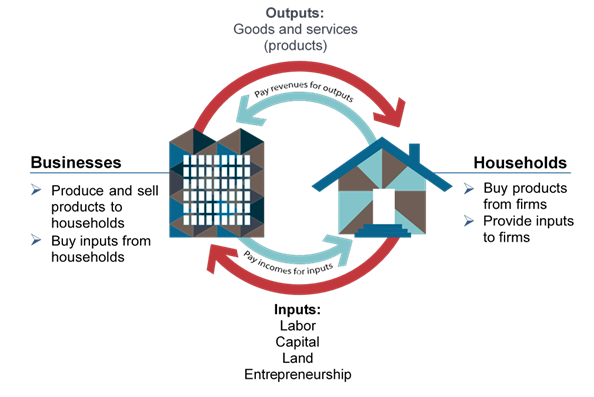
The Circular Flow of Inputs and Outputs illustrates the dual roles of households and businesses. Households not only provide factors of production (or resources) but also consume goods and services. Businesses not only buy resources but also produce and sell both goods and services. Outputs include goods and services (or products). Inputs include labor, capital, land, and entrepreneurship.
This version of the circular flow model is stripped down to the essentials, but it has enough features to explain how the product and labour markets work in the economy. We could easily add details to this basic model if we wanted to introduce more real-world elements, like financial markets, governments, and interactions with the rest of the globe (imports and exports).
Productivity refers to how efficiently goods and services are being produced. Theoretically, higher levels of labor productivity equal higher economic output and lower inflation. Productivity increases when more output is produced with the same amount of inputs or when the same amount of output is produced with less inputs. Productivity in economics is usually measured as the ratio of what is produced (an aggregate output) to what is used in producing it (an aggregate input).
Labor productivity is the most common productivity measure—it’s defined as economic output (gross domestic product, or GDP) per hour worked. Labor productivity is typically the biggest determinant of economic and wage growth in the long term. And over time, labor productivity and real wages are closely—though not exactly—linked. Labour productivity tends to rise with increases in technology. On a country scale, labor productivity is frequently calculated as a ratio of GDP per total hours worked. So, if a country’s GDP were $1 trillion and its people worked 20 billion hours to create that value, the country’s labor productivity would be $50 per hour.
Economists measure other types of productivity, too. Capital productivity is a measure of how well physical capital—such as real estate, equipment, and inventory—is used to generate output such as goods and services. (Capital productivity and labor productivity are frequently considered together as an indicator of a country’s overall standard of living.) Total factor productivity is the portion of growth in output not explained by growth in labor or capital. This type of productivity is sometimes called “innovation-led growth.”
Curious about your role in the Canadian economy? Plug in a few facts about yourself and compare them with national and regional data from across Canada. At the end, your profile, as well as your place in the economy, will be revealed. Figure 5.2 shows a results page after taking the “Your Role in the Canadian Economy” Quiz. Give it a try! You will see how you compare to other Canadians.

Economists study the interactions between households and businesses and look at the ways in which the factors of production are combined to produce the goods and services that people need. Basically, economists try to answer three sets of questions:
Economic Systems Defined:
Generally speaking, economic systems can be divided into two systems: planned systems and free market systems (Refer to Figure 5.3).
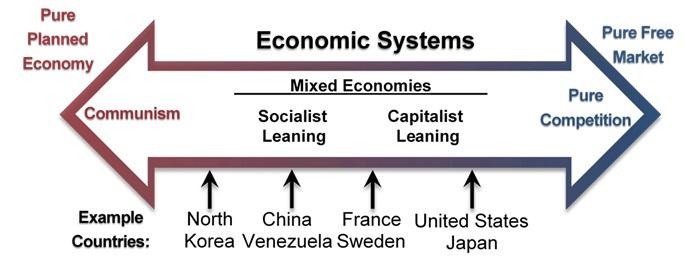
In a planned system, the government exerts control over the allocation and distribution of all or some goods and services. The system with the highest level of government control is communism. In theory, a communist economy is one in which the government owns all or most enterprises. Central planning by the government dictates which goods or services are produced, how they are produced, and who will receive them. In practice, pure communism is practically nonexistent today, and only a few countries (notably North Korea and Cuba) operate under rigid, centrally planned economic systems.
Under socialism, industries that provide essential services, such as utilities, banking, and health care, may be government owned. Some businesses may also be owned privately. Central planning allocates the goods and services produced by government-run industries and tries to ensure that the resulting wealth is distributed equally. In contrast, privately owned companies are operated for the purpose of making a profit for their owners. In general, workers in socialist economies work fewer hours, have longer vacations, and receive more health care, education, and child-care benefits than do workers in capitalist economies. To offset the high cost of public services, taxes are generally steep. Examples of countries that lean towards a socialistic approach include Venezuela, Sweden, and France.
The free market system is an economic system in which most businesses are owned and operated by individuals, also known as capitalism. In a free market economy, competition dictates how goods and services will be allocated. Business is conducted with more limited government involvement concentrated on regulations that dictate how businesses are permitted to operate. A key aspect of a free market system is the concept of private property rights, which means that business owners can expect to own their land, buildings, machines, etc., and keep the majority of their profits, except for taxes. The profit incentive is a key driver of any free market system. The economies of the United States and other countries, such as Japan, are based on capitalism. However, a purely capitalistic economy is as rare as one that is purely communist. Imagine if a service such as police protection, one provided by government in the United States, were instead allocated based on market forces. The ability to pay would then become a key determinant in who received these services, an outcome that few in American society would consider to be acceptable.
Though it is possible to have a pure communist system, or a pure capitalist (free market) system, in reality many economic systems are mixed market economies. A mixed market economy relies on both markets and the government to allocate resources. In practice, most economies are mixed, with a leaning towards either free market or socialistic principles, rather than being purely one or the other. Some previously communist economies, such as those of Eastern Europe and China, are becoming more mixed as they adopt more capitalistic characteristics and convert businesses previously owned by the government to private ownership through a process called privatization. By contrast, Venezuela is a country that has moved increasingly towards socialism, taking control of industries such as oil and media through a process called nationalization.
Like most countries, Canada features a mixed market system much like its neighbor to the south; though the Canadian and U.S. economic systems are primarily free market systems, the federal government controls some basic services, such as the postal service and air traffic control. The Canadian economy also has some characteristics of a socialist system, such as providing social security retirement benefits to retired workers or free health care to its population.
The free market system was espoused by Adam Smith in his book The Wealth of Nations, published in 1776. According to Smith, competition alone would ensure that consumers received the best products at the best prices. In the kind of competition he assumed, a seller who tries to charge more for his product than other sellers would not be able to find any buyers. A job-seeker who asks more than the going wage won’t be hired. Because the “invisible hand” of competition will make the market work effectively, there won’t be a need to regulate prices or wages. Almost immediately, however, a tension developed among free market theorists between the principle of laissez-faire—leaving things alone — and government intervention. Today, it is common for the Canadian government to intervene in the operation of the economic system. For example, government exerts influence on the food and pharmaceutical industries through Canada’s Food and Drug Act and Regulations, which protect consumers by preventing unsafe or mislabeled products from reaching the market.
To appreciate how businesses operate, we must first get an idea of how prices are set in competitive markets. The next section, “Perfect Competition and Supply and Demand,” begins by describing how markets establish prices in an environment of perfect competition.
Economic development through resource extraction is an important tool for the creation of own-sourced revenue. To achieve long-term economic sustainability, however, it must be supported by community-appropriate business development. Various Indigenous communities authorize impact and benefit agreements with multi-national resource extraction corporations, doing so with the intention that the economic benefits will offset the resulting ethical and environmental concessions. In reality, the agreements often leave the communities in a similar socio-economic state before the resources were extracted, which is attributed to the phenomenon of economic leakage. Business development for Indigenous populations, on the other hand, refers the strategic decision to produce and promote businesses for and within their own communities. Doing so would not only recapture economic leakage, but provide additional revenue sources. Dr Russell Evans, the professor of accounting at the University of Windsor, offers his insight into the benefits of Indigenous entrepreneurship.
One or more interactive elements has been excluded from this version of the text. You can view them online here: https://ecampusontario.pressbooks.pub/businessfundamentals/?p=261
In economic theory and the broader discussion of competition, the “types” or “degrees” of competition refer to how firms compete in the market. These classifications focus on the market environment, not direct “business competition” (strategies businesses use to compete).
The Canadian economy is founded on the principles of private enterprise: private property rights, freedom of choice, profits and competition. Under a mixed economy, such as we have in Canada, businesses make decisions about which goods to produce or services to offer and how they are priced. Because there are many businesses making goods or providing services, customers can choose from a wide array of products. The competition for sales among businesses is a vital part of our economic system. Competition varies within industries and has a big influence on how companies operate. Porter’s Five Forces model can be used to identify and analyze an industry’s competitive forces. The five forces are: threat of new entrants, threat of substitutes, bargaining power of buyers, bargaining power of suppliers, and rivalry among existing competitors.
As shown in Table 5.1 below, economists have identified four types of competition — perfect competition, monopolistic competition, oligopoly, and monopoly.
| Characteristic | Perfect Competition | Monopolistic Competition | Oligopoly | Pure Monopoly |
|---|---|---|---|---|
| Number of Firms | Very Many | Many | A Few | One |
| Types of Products | Homogeneous | Differentiated | Homogeneous or Differentiated | Homogeneous |
| Barriers to Entry or Exit from Industry | No Substantial Barriers | Minor Barriers | Considerable Barriers | Extremely Great Barriers |
| Examples | Agriculture | Retail Trade | Banking | Public Utilities |
Perfect competition is a market structure characterized by many buyers and sellers, homogeneous products, and no single participant having market power. Perfect competition exists when there are many consumers buying a standardized product from numerous small businesses. Because no seller is big enough or influential enough to affect price, sellers and buyers accept the going price. For example, when a commercial fisher brings his fish to the local market, he has little control over the price he gets and must accept the going market price.
Supply and demand are central to the concept of perfect competition. In perfect competition, the price of goods and services is determined entirely by the interaction of supply and demand. High competition ensures that the supply curve (producers) and demand curve (consumers) interact freely without interference, such as monopolistic pricing or government controls. Producers can only compete on efficiency since prices cannot be manipulated, aligning the supply with the true demand.
In monopolistic competition, we still have many sellers (as we had under perfect competition). Now, however, they do not sell identical products. Instead, they sell differentiated products—products that differ somewhat, or are perceived to differ, even though they serve a similar purpose. Products can be differentiated in a number of ways, including quality, style, convenience, location, and brand name. Some people prefer Coke over Pepsi, even though the two products are quite similar. But what if there was a substantial price difference between the two? In that case, buyers could be persuaded to switch from one to the other. Thus, if Coke has a big promotional sale at a supermarket chain, some Pepsi drinkers might switch (at least temporarily).
How is product differentiation accomplished? Sometimes, it’s simply geographical; you probably buy gasoline at the station closest to your home regardless of the brand. At other times, perceived differences between products are promoted by advertising designed to convince consumers that one product is different from and better than another. Regardless of customer loyalty to a product, however, if its price goes too high, the seller will lose business to a competitor. Under monopolistic competition, therefore, companies have only limited control over price.
Oligopoly means few sellers. In an oligopolistic market, each seller supplies a large portion of all the products sold in the marketplace. In addition, because the cost of starting a business in an oligopolistic industry is usually high, the number of firms entering it is low. Companies in oligopolistic industries include such large-scale enterprises as automobile companies and airlines. As large firms that supply a sizable portion of a market, these companies have some control over the prices they charge. But there’s a catch: because products are fairly similar, when one company lowers prices, others are often forced to follow suit to remain competitive. You see this practice all the time in the airline industry: When American Airlines announces a fare decrease, Continental, United Airlines, and others do likewise. When one automaker offers a special deal, its competitors usually come up with similar promotions.
In terms of the number of sellers and degree of competition, a monopoly lies at the opposite end of the spectrum from perfect competition. In perfect competition, there are many small companies, none of which can control prices; they simply accept the market price determined by supply and demand. In a monopoly, however, there’s only one seller in the market. The market could be a geographical area, such as a city or a regional area, and doesn’t necessarily have to be an entire country.
There are few monopolies in Canada because the government limits them. Most fall into one of two categories: natural and legal. Natural monopolies include public utilities, such as electricity and gas suppliers. Such enterprises require huge investments, and it would be inefficient to duplicate the products that they provide. They inhibit competition, but they’re legal because they’re important to society. In exchange for the right to conduct business without competition, they’re regulated. For instance, they can’t charge whatever prices they want; they must adhere to government-controlled prices. As a rule, they’re required to serve all customers, even if doing so isn’t cost efficient.
A legal monopoly arises when a company receives a patent giving it exclusive use of an invented product or process. Patents are issued for a limited time, generally twenty years. During this period, other companies can’t use the invented product or process without permission from the patent holder. Patents allow companies a certain period to recover the heavy costs of researching and developing products and technologies. A classic example of a company that enjoyed a patent-based legal monopoly is Polaroid, which for years held exclusive ownership of instant film technology. Polaroid priced the product high enough to recoup, over time, the high cost of bringing it to market. Without competition, it enjoyed a monopolistic position in regard to pricing.
To appreciate how perfect competition works, we need to understand how buyers and sellers interact in a market to set prices. In a market characterized by perfect competition, price is determined through the mechanisms of supply and demand. Prices are influenced both by the supply of products from sellers and by the demand for products by buyers. The law of supply and demand is an economic theory that explains how the relationship between supply and demand determines prices. When supply is greater than demand, prices fall, and when demand is greater than supply, prices rise.
To illustrate this concept, let us create a supply and demand schedule for one particular good sold at one point in time. Then we’ll define demand and create a demand curve and define supply and create a supply curve. Finally, we’ll see how supply and demand interact to create an equilibrium price — the price at which buyers are willing to purchase the amount that sellers are willing to sell.
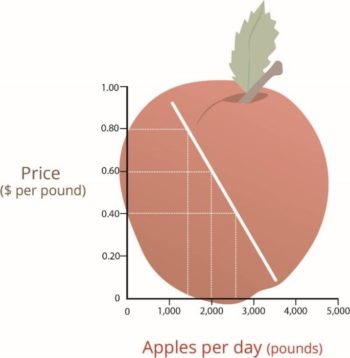
Demand is the quantity of a product that buyers are willing to purchase at various prices. The quantity of a product that people are willing to buy depends on its price. Consumers are typically willing to buy less of a product when prices rise and more of a product when prices fall. Generally speaking, we find products more attractive at lower prices, and we buy more at lower prices because our income goes further.
Using this logic, we can construct a demand curve that shows the quantity of a product that will be demanded at different prices. Let’s assume that Figure 5.4, “The Demand Curve” represents the daily price and quantity of apples sold by farmers at a local market. Note that as the price of apples goes down, buyers’ demand goes up. Thus, if a pound of apples sells for $0.80, buyers will be willing to purchase only fifteen hundred pounds per day. But if apples cost only $0.60 a pound, buyers will be willing to purchase two thousand pounds. At $0.40 a pound, buyers will be willing to purchase twenty-five hundred pounds.
Factors that can affect demand include changes in income levels, population changes, consumer preferences, complementary goods, and substitute goods.
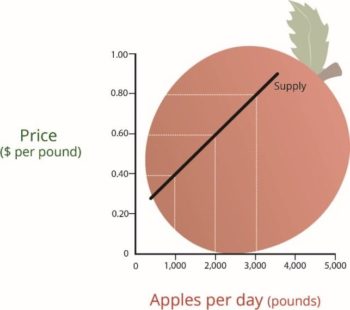
Supply is the quantity of a product that sellers are willing to sell at various prices. The quantity of a product that a business is willing to sell depends on its price. Businesses are more willing to sell a product when the price rises and less willing to sell it when prices fall. Again, this fact makes sense: businesses are set up to make profits, and there are larger profits to be made when prices are high.
Now we can construct a supply curve that shows the quantity of apples that farmers would be willing to sell at different prices, regardless of demand. As shown in Figure 5.5, “The Supply Curve”, the supply curve goes in the opposite direction from the demand curve: as prices rise, the quantity of apples that farmers are willing to sell also goes up. The supply curve shows that farmers are willing to sell only a thousand pounds of apples when the price is $0.40 a pound, two thousand pounds when the price is $0.60, and three thousand pounds when the price is $0.80.
Factors that affect supply include technological changes, changes in resource prices, price expectations, number of suppliers, the price of substitute goods.
We can now see how the market mechanism works under perfect competition. We do this by plotting both the supply curve and the demand curve on one graph, as we have done in Figure 5.6. The Equilibrium Price” is the state in which market supply and demand balance each other; the point at which the two curves intersect.
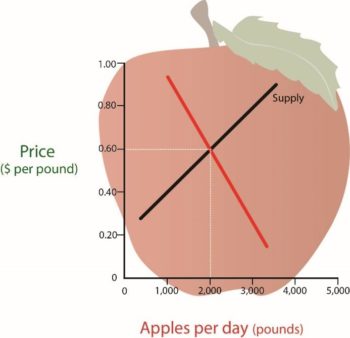
“The Equilibrium Price”, where the supply and demand curves intersect, is at the price of $0.60 and quantity of two thousand pounds. Thus, $0.60 is the equilibrium price. At this price, the quantity of apples demanded by buyers equals the quantity of apples that farmers are willing to supply. If a single farmer tries to charge more than $0.60 for a pound of apples, they won’t sell very many because other suppliers are making apples available for less. As a result, their profits will go down. If, on the other hand, a farmer tries to charge less than the equilibrium price of $0.60 a pound, they will sell more apples but their profit per pound will be less than at the equilibrium price. With profit being the motive, there is no incentive to drop the price.
What have you learned in this discussion? Without outside influences, markets in an environment of perfect competition will arrive at an equilibrium point at which both buyers and sellers are satisfied. But you must be aware that this is a very simplistic example. Things are much more complex in the real world. For one thing, markets rarely operate without outside influences. Sometimes, sellers supply more of a product than buyers are willing to purchase; in that case, there’s a surplus. Sometimes, they don’t produce enough of a product to satisfy demand; then we have a shortage.
Circumstances also have a habit of changing. What would happen, for example, if incomes rose and buyers were willing to pay more for apples? The demand curve would change, resulting in an increase in equilibrium price. This outcome makes intuitive sense: as demand increases, prices will go up. What would happen if apple crops were larger than expected because of favorable weather conditions? Farmers might be willing to sell apples at lower prices rather than letting part of the crop spoil. If so, the supply curve would shift, resulting in another change in equilibrium price: the increase in supply would bring down prices.
Every day we are bombarded with economic news (at least if you watch the business news stations). We are told about things like unemployment, home prices, and consumer confidence trends. As a student learning about business, and later as a business manager, you need to understand the nature of the Canadian economy and the terminology that we use to describe it. You need to have some idea of where the economy is heading, and you need to know something about the government’s role in influencing its direction.
The world’s economies share three main goals:
Let us take a closer look at each of these goals, both to find out what they mean and to show how we determine whether or not they’re being met.
One purpose of an economy is to provide people with goods and services such as cars, computers, video games, houses, rock concerts, fast food, and amusement parks. One way in which economists measure the performance of an economy is by looking at a widely used measure of total output called the gross domestic product (GDP). The GDP is defined as the market value of all goods and services produced by the economy in a given year. The GDP includes only those goods and services produced domestically; goods produced outside the country are excluded. The GDP also includes only those goods and services that are produced for the final user; intermediate products are excluded. For example, the silicon chip that goes into a computer (an intermediate product) would not count directly because it is included when the finished computer is counted. By itself, the GDP doesn’t necessarily tell us much about the direction of the economy. But change in the GDP does. If the GDP (after adjusting for inflation) goes up, the economy is growing. If it goes down, the economy is contracting. There is some debate amongst economists that GDP provides the most accurate measure of an economy’s performance. Many economists believe that GDP per capita, which is the measure of total production of goods and services divided by the number of households, is a better indicator of an economy’s performance. For example, according to The World Bank, as of 2017, India’s GDP ranked 7th in the world at $2.439 trillion (USD) while Canada’s GDP ranked 10th at $1.640 trillion (USD). However, as of 2017, Canada’s GDP per capita ranks 18th at $44,773 per household, compared to India’s GDP per capita which ranked 142nd in the world at $1,852 per household.
Gross national product (GNP) is another metric used for measuring a nation’s economic output. Gross national product (GNP) is the value of all products and services produced by the citizens of a country both domestically and internationally minus income earned by foreign residents. For instance, if Canada has production facilities in the USA, its GNP will account for both the production output in Canada and in the USA.
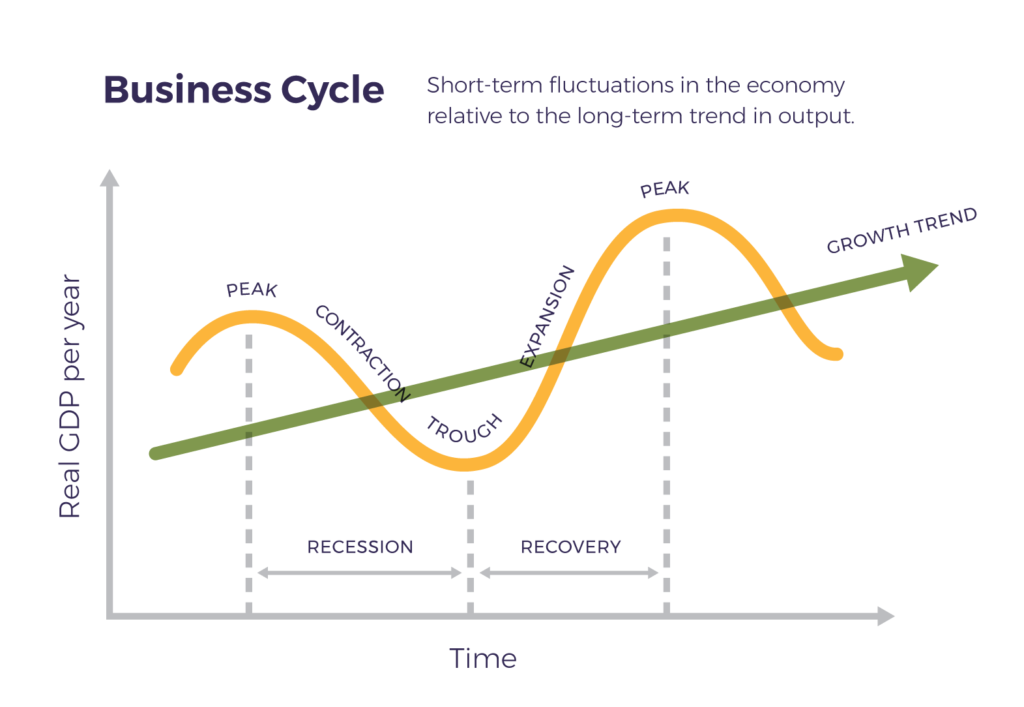
As shown in Figure 5.7, the economic ups and downs resulting from expansion and contraction constitute the business cycle (also referred to as the industry life cycle). Similar to a product lifecycle, as a business cycle introduces new products, those products grow, mature and decline; when all business cycles in an economy are combined an economy’s business cycle is created. A typical cycle runs from three to five years but could last much longer. Though typically irregular, a cycle can be divided into four general phases of prosperity, recession, depression (which the cycle generally skips), and recovery:
If you want or need more interactive examples of the business cycle, this 10 minute Khan Academy video provides more details: The Business Cycle: Aggregate demand and aggregate supply.
To keep the economy going strong, people must spend money on goods and services. A reduction in personal expenditures for things like food, clothing, appliances, automobiles, housing, and medical care could severely reduce GDP and weaken the economy. Because most people earn their spending money by working, an important goal of all economies is making jobs available to everyone who wants one. In principle, full employment occurs when everyone who wants to work has a job. In practice, we say that we have full employment when about 95 percent of those wanting to work are employed.
Refer to Figure 5.8, Statistics Canada Employment Rates. What might have caused employment rates to fall during the year 2020?
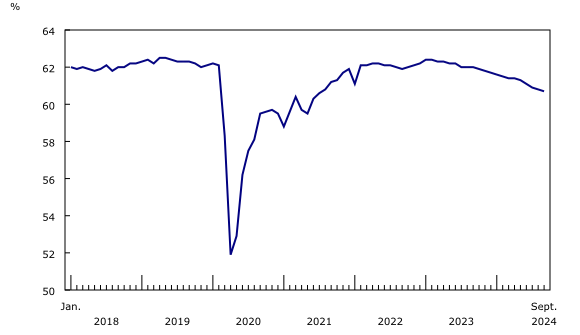
Statistics Canada tracks unemployment and reports the unemployment rate: the percentage of the labour force who are at least 15 years old that is unemployed and actively seeking work. The unemployment rate is an important measure of economic health. It goes up during recessionary periods because companies are reluctant to hire workers when demand for goods and services is low. Conversely, it goes down when the economy is expanding and there is high demand for products and workers to supply them. There are several different measures of unemployment because there are different reasons people may be unemployed, including:
Figure 5.9 shows the Statistics Canada map of the unemployment rate by province and territory as of September 2024. Which province or territory has the highest unemployment rate? Why might that be?
A third major goal of all economies is maintaining price stability. Price stability occurs when the average price for goods and services either does not change or changes very little. Rapidly rising prices are troublesome for both individuals and businesses. For individuals, rising prices mean people have to pay more for the things they need. For businesses, rising prices mean higher costs, and, at least in the short run, businesses might have trouble passing on higher costs to consumers.
When the overall price level goes up, we have inflation. More jobs and higher wages increase household incomes and lead to a rise in consumer spending, further increasing aggregate demand and the scope for firms to increase the prices of their goods and services. When this happens to a large number of businesses and sectors, this leads to an increase in inflation. Long-lasting episodes of high inflation are often the result of lax monetary policy. If the money supply grows too big relative to the size of an economy, the unit value of the currency diminishes; in other words, its purchasing power falls and prices rise.
Figure 5.10 show inflationary trends in the Canadian economy since 1915. The inflation rate in Canada averaged 3.15 percent from 1915 until 2018, reaching an all-time high of 21.60 percent in June of 1920 and a record low of -17.80 percent in June of 1921.%
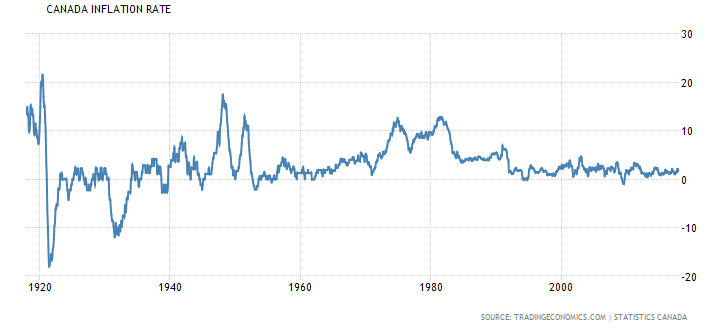
When the price level goes down (which rarely happens), we have deflation. A deflationary situation can also be damaging to an economy. When purchasers believe they can expect lower prices in the future, they may defer making purchases, which has the effect of slowing economic growth. Japan experienced a long period of deflation which contributed to economic stagnation in that country from which it is only now beginning to recover.
The most widely publicized measure of inflation is the consumer price index (CPI), which is reported monthly by Statistics Canada. The consumer price index (CPI) measures the rate of inflation by determining price changes of a hypothetical basket of goods, such as food, housing, clothing, medical care, appliances, automobiles, and so forth, bought by a typical household.
The Bank of Canada currently measures prices against the base year of 2002, and the basket for that year is given the value of 100. In 2012 the CPI averaged $121, which means that what you could buy for $100 in 2002 cost $121.70 in 2012. The difference registers the effect of inflation. In fact, that’s what an inflation rate is—the percentage change in a price index.
The Bank of Canada created an Inflation Calculator to compare the costs of consumer goods then and now. For example, ask a parent or an older neighbour what they paid for their first car, first house, or first formal wear. Observe Figure 5.11 showing the consumer price index for the years 2000 to 2024. Why do you think there is a huge increase in the CPI during 2022? What happened in the world to cause this?
The CPI measures change in prices of consumer goods and does not measure change in prices of goods used to create consumer goods, such as capital and resource expenditures. The producer price index (PPI) tracks the average change in prices at the wholesale level (e.g., raw materials, product components that require further processing, and finished goods sold to retailers).
In the previous section, we introduced several measures that economists use to assess the performance of the economy at a given time. By looking at changes in the GDP, for instance, we can see whether the economy is growing. The CPI allows us to gauge inflation. These measures help us understand where the economy stands today. But what if we want to get a sense of where it’s headed in the future? To a certain extent, we can forecast future economic trends by analyzing several leading economic indicators.
In economics, leading, lagging, and coincident indicators are tools used to analyze and predict economic performance. These indicators help economists, policymakers, and businesses make informed decisions about the state of the economy and potential future trends. An economic indicator is a statistic that provides valuable information about the economy. There’s no shortage of economic indicators and trying to follow them all would be an overwhelming task. So, in this chapter, we will only discuss the general concept and a few of the key indicators.
Canadian economic indicators can be expressed in three main indicators — leading indicators, coincident indicators and lagging indicators.
These indicators signal future economic activity and are used to predict changes in the economy before they occur. For example, stock prices often reflect investor sentiments about future economic conditions. An increase in building permits suggests future growth in construction and housing markets. On the consumer confidence index, higher confidence indicates likely increases in spending, boosting economic activity. An increase in new orders for manufacturing indicates increased production and economic growth. Businesses and policymakers monitor these changes to anticipate expansions or contractions in the economy.
New unemployment claims often reflect employers’ expectations about future economic conditions. If businesses anticipate a slowdown, they may lay off workers, leading to an increase in claims. This data provides an early signal of weakening economic activity or labor market challenges. Economists and policymakers monitor changes in unemployment claims to predict potential recessions or recoveries. For example, a sustained rise in claims could indicate an impending economic downturn, prompting proactive policy adjustments such as monetary easing or fiscal stimulus.
These indicators reflect changes that have already occurred in the economy. They confirm trends but do not predict them. For example, changes in unemployment often lag behind economic trends as businesses adjust to economic shifts. Rising consumer debt levels confirm past high spending levels during an economic boom. The inflation rate typically reacts to earlier changes in supply, demand and monetary policy. These indicators are useful for validating the accuracy of leading indicators and understanding the economy’s historical performance.
The length of unemployment is also a lagging indicator. If unemployed workers have remained out of work for a long time, we may infer that the economy has been slow. Indicators that predict the status of the economy three to twelve months into the future are called leading economic indicators. If such an indicator rises, the economy is more likely to expand in the coming year. If it falls, the economy is more likely to contract.
These indicators move in real-time with the economy, reflecting its current state. Gross Domestic Product (GDP) directly shows the economic output at a given time. Employment levels indicate current labour market conditions. Retail sales reflect ongoing consumer spending trends. Industrial production measures real-time manufacturing activity. These indicators provide a snapshot of the present economic situation and are helpful for short-term planning.
Since employment is such a key goal in any economy, the Canadian Industry Statistics in collaboration with Statistics Canada tracks total non-farm payroll employment from which the number of net new jobs created can be determined. The number of new jobs created is considered a coincident indicator in economics. New job creation reflects current economic activity and labor market conditions. It shows how businesses are responding to the existing economic climate by expanding their workforce, which aligns with the economy’s present state rather than predicting future trends. A rise in new jobs typically coincides with economic growth, indicating healthy consumer demand and business investment. Conversely, a decline in new jobs suggests slower economic activity or contraction.
Understanding the differences between these indicators is crucial:
The Canadian government, including federal, provincial and municipal governments, plays many roles within the Canadian economic system, and therefore influences business activities. Government plays many roles and influences business activities in many ways. The roles government plays are as follows:
Businesses may also influence government through lobbying, joining trade associations, making political donations and trying to convince voters to support or oppose certain regulations and policies.
In managing the economy three main policies may be used by the government: Monetary policy, Fiscal policy and National Debt management.
Monetary policy is exercised by The Bank of Canada, which is empowered to take various actions that decrease or increase the money supply and raise or lower short-term interest rates, making it harder or easier to borrow money. As shown in Figure 5.12, when The Bank of Canada believes that inflation is a problem, it will use contractionary policy to decrease the money supply and raise interest rates. When rates are higher, borrowers have to pay more for the money they borrow, and banks are more selective in making loans. Because money is “tighter” — more expensive to borrow — demand for goods and services will go down, and so will prices. In any case, that’s the theory.
The Bank of Canada will typically tighten or decrease the money supply during inflationary periods, making it harder to borrow money.
To counter a recession, The Bank of Canada uses expansionary policy to increase the money supply and reduce interest rates. With lower interest rates, it’s cheaper to borrow money, and banks are more willing to lend it. We then say that money is “easy.” Attractive interest rates encourage businesses to borrow money to expand production and encourage consumers to buy more goods and services. In theory, both sets of actions will help the economy escape or come out of a recession.
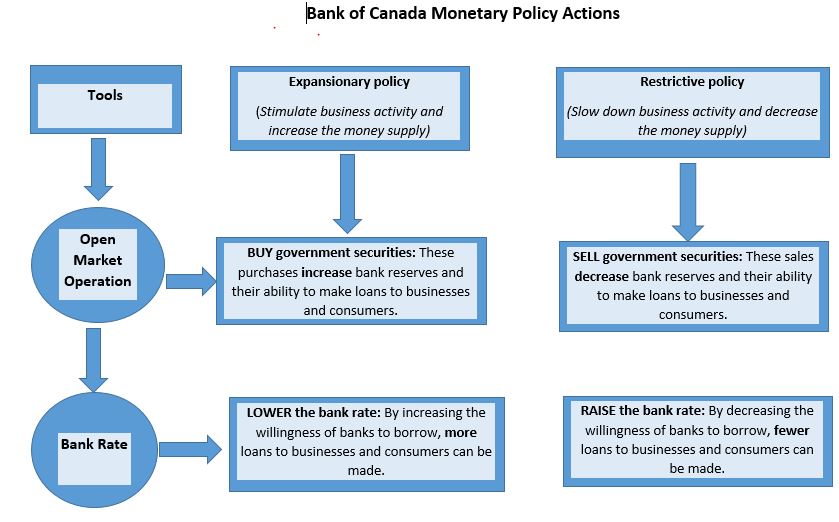
Fiscal policy relies on the government’s powers of spending and taxation. Both taxation and government spending can be used to reduce or increase the total supply of money in the economy — the total amount, in other words, that businesses and consumers have to spend.
Below are a few key points:
The national debt is also referred to as Canada’s public debt. According to the Department of Finance Canada, Government Debt in Canada increased to 1134.49 CAD Billion in 2022 from 1048.75 CAD Billion in 2021. The expected rise was due to the massive new borrowing to cover COVID-19 pandemic responses. You can check the current debt at Canadian National Debt Clock.
If, in any given year, the government takes in more money (through taxes) than it spends on goods and services (for things such as defense, transportation, and social services), the result is a budget surplus. If, on the other hand, the government spends more than it takes in, we have a budget deficit (which the government pays off by borrowing through the issuance of Treasury bonds). Historically, deficits have occurred much more often than surpluses; typically, the government spends more than it takes in.
Below are a few key facts:

If you happen to have one on you, take a look at a $5 bill. Though this piece of paper — indeed, money itself — has no intrinsic value, it is certainly in demand. Why? Because money serves three basic functions:
To get a better idea of the role of money in a modern economy, let us imagine a system in which there is no money. In this system, goods and services are bartered — traded directly for one another. Now, if you are living and trading under such a system, for each barter exchange that you make, you will have to have something that another trader wants. For example, say you are a farmer who needs help clearing his fields. Because you have plenty of food, you might enter into a barter transaction with a laborer who has time to clear fields but not enough food: he’ll clear your fields in return for three square meals a day. This system will work as long as two people have exchangeable assets, but needless to say, it can be inefficient. If we identify the functions of money, we will see how it improves the exchange for all the parties in our hypothetical set of transactions.
Money is anything that is acceptable as payment for goods and services. It affects our lives in many ways. We earn it, spend it, save it, invest it — and often wish we had more of it. Businesses and government use money in similar ways. Both require money to finance their operations. By controlling the amount of money in circulation, the federal government can promote economic growth and stability. For this reason, money has been called the lubricant of the machinery that drives our economic system. Our banking system was developed to ease the handling of money.
Money serves as a medium of exchange because people will accept it in exchange for goods and services. Because people can use money to buy the goods and services that they want, everyone’s willing to trade something for money. The laborer will take money for clearing your fields because he can use it to buy food. You’ll take money as payment for his food because you can use it not only to pay him but also to buy something else you need (perhaps seeds for planting crops).
For money to be used in this way, it must possess a few crucial properties:
Money simplifies exchanges because it serves as a measure of value. We state the price of a good or service in monetary units so that potential exchange partners know exactly how much value we want in return for it. This practice is a lot better than bartering because it’s much more precise than an ad hoc agreement that a day’s work in the field has the same value as three meals.
Money serves as a store of value. Because people are confident that money keeps its value over time, they’re willing to save it for future exchanges. Under a bartering arrangement, the laborer earned three meals a day in exchange for his work. But what if, on a given day, he skipped a meal? Could he “save” that meal for another day? Maybe, but if he were paid in money, he could decide whether to spend it on food each day or save some of it for the future. If he wanted to collect his unpaid meal two or three days later, the farmer might not be able to pay it; unlike money, food could go bad.
Now that we know what money does, let us tackle another question: how much money is there? How would you go about “counting” all the money held by individuals, businesses, and government agencies in this country? You could start by counting the money that’s held to pay for things on a daily basis. This category includes cash (paper bills and coins) and funds held in demand deposits — chequing accounts, which pay given sums to “payees” when they demand them.
Then, you might count the money that is being “saved” for future use. This category includes interest-bearing accounts, time deposits (such as certificates of deposit, which pay interest after a designated period of time), and money market mutual funds, which pay interest to investors who pool funds to make short-term loans to businesses and the government.
Counting all this money would be a daunting task (in fact, it would be impossible). Fortunately, there’s an easier way — namely, by examining two measures that the government compiles for the purpose of tracking the money supply: M-1 and M-2.
M-3 money in Canada refers to a broad measure of the money supply that includes M-2 (which itself comprises M-1, demand deposits, and savings accounts) and adds components like large time deposits, institutional money market funds, short-term repurchase agreements, and other liquid financial instruments. This measure provides insights into the overall liquidity in the economy, encompassing funds that are less readily accessible but still significant for economic activities. M-3 is particularly useful for analyzing broader economic trends, such as inflation, as it includes assets closer to “near-money” and reflects overall financial stability and potential consumer spending capabilities. This category is sometimes referred to as “broad money.”
How much money is out there? Statistics Canada reports that as of April 2018, M-1, totalled $877 billion in Canada and M-2 totalled $1596 in Canada. Also, Money Supply M2 in Canada increased to 2289771 CAD Million in October from 2286467 CAD Million in September of 2021.

Are credit cards a form of money? If not, why do we call it plastic money? Actually, when you buy something with a credit card, you are not spending money. The principle of the credit card is buy-now-pay-later. In other words, when you use plastic, you are taking out a loan that you intend to pay off when you get your bill. And the loan itself is not money. Why not? Basically, because the credit card company cannot use the asset to buy anything. The loan is merely a promise of repayment. The asset does not become money until the bill is paid (with interest). That is why credit cards are not included in the calculation of M-1 and M-2.
The Bank of Canada is the nation’s central bank. Its principal role is “to promote the economic and financial welfare of Canada,” as defined in the Bank of Canada Act. The Bank of Canada is a special type of Crown corporation that is owned by the federal government but has considerable independence to carry out its responsibilities and therefore operates separately from the political process.
The Bank’s four main areas of responsibility are:
The Bank of Canada is led by the Governing Council, the policy-making body of the Bank, which is responsible for:
The Governing Council is made up of the Governor, the Senior Deputy Governor and the Deputy Governors. The Governing Council’s main tool for conducting monetary policy is the target for the overnight rate (also known as the key policy rate). This rate is normally set on eight fixed announcement dates per year. The Council reaches its decisions about the rate by consensus, rather than by individual votes, as is the case at some other central banks.
The Bank of Canada plays a vital role in managing the money supply in Canada. If the Bank of Canada wants to increase the money supply, it can buy government securities. The individuals and investors who sell these bonds then deposit the proceeds in their banks. These deposits increase banks’ reserves and their willingness to make loans. The Bank of Canada can also lower the bank rate; this action will cause increased demand for loans from businesses and households because these customers borrow more money when interest rates drop.
If the Bank of Canada wants to decrease the money supply, it can sell government securities. Individuals and investors spend money to buy bonds, and these withdrawals bring down banks’ reserves and reduce their willingness to make loans. The Bank of Canada can also raise the bank rate; this action will decrease the demand for loans from businesses and households because these customers borrow less money when interest rates rise.
Policymaking and regulatory powers are different in every nation; local standards and laws also vary greatly, which means that banking systems vary greatly. These two United Nation agencies — The World Bank and International Monetary Fund — assist in financing international trade.
The World Bank is an important source of economic assistance for poor and developing countries. With backing from wealthy donor countries (such as Canada, the United States, Japan, Germany, and the United Kingdom), the World Bank provides loans, grants, and guarantees to some of the world’s poorest nations. Loans are made to help countries improve the lives of the poor through community support programs designed to provide health, nutrition, education, infrastructure, and other social services.
The International Monetary Fund (IMF) is governed by and accountable to its 191 member countries and has three critical missions: furthering international monetary cooperation, encouraging the expansion of trade and economic growth, and discouraging policies that would harm prosperity.
These countries combine their resources to:
The IMF loans money to countries with troubled economies, such as Mexico in the 1980s and mid-1990s, and Russia and Argentina in the late 1990s. There are, however, strings attached to IMF loans; in exchange for relief in times of financial crisis, borrower countries must institute sometimes painful financial and economic reforms. In the 1980s, for example, Mexico received financial relief from the IMF on the condition that it privatize and deregulate certain industries and liberalize trade policies. The government was also required to cut back expenditures for such services as education, health care, and workers’ benefits.
Some nations have declined IMF funds rather than accept the economic changes that the IMF demands. In 2021, according to the IMF website, the IMF had about $1 trillion available for loans. Despite the fact that the U.S. has been instrumental in promoting global free trade for decades in 2018, it was rumoured that under Trump’s administration the U.S. would withdraw from the World Trade Organization (WTO). This did not happen, but the instability caused by such news was damaging to the WTO.
The financial marketplace spans the globe, with money routinely flowing across international borders. Canadian banks play an important role in global business by providing loans to foreign governments and businesses. Multinational corporations need many special banking services, such as foreign currency exchange and funding for overseas investments. Canadian banks also offer trade-related services, such as global cash management, which help firms manage their cash flow, improve their payment efficiency, and reduce their exposure to operational risks. Sometimes consumers in other nations have a need for banking services that banks in their own countries do not provide. Therefore, large banks often look beyond their national borders for profitable banking opportunities.
Foreign funding has been crucial to Canada’s economic development, with the Canadian capital market being an integral part of the international capital market. Canadian provinces often secure financing in foreign markets like London and New York, and projections suggest that foreign capital will remain essential to meeting Canada’s future financial needs.
Some Canadian banks have established a presence in overseas markets, opening offices in Europe, Latin America, and Asia. These banks often offer superior customer service compared to local institutions and have access to diverse funding sources. However, international expansion poses challenges. Canadian banks face competition from foreign institutions that operate under less stringent regulations, enabling them to offer more competitive pricing. Some governments also protect domestic banks by restricting foreign competition. For instance, in China, foreign banks face high fees, deposit limits, and interest rate controls, which favor government-owned Chinese banks. Despite these obstacles, certain Canadian banks continue to do business in China.
International banks operating in Canada significantly contribute to the economy by creating jobs, paying taxes, and making operational and capital investments. Most employees in these institutions are Canadian citizens, further supporting the domestic workforce.
Nonetheless, international banking carries risks, including political and economic instability. The financial crisis of 2007–2009 highlighted these vulnerabilities, with countries such as Greece, Portugal, Spain, and Ireland experiencing severe economic disruptions. Recovery in these nations has been slow, but financial assistance from the European Union and the International Monetary Fund has played a critical role in stabilizing both regional and global economies.
Currencies are traded in the foreign exchange market. Like any other market, when something is exchanged there is a price. In the foreign exchange market, a currency is being bought and sold, and the price of that currency is given in some other currency. That price is expressed as an exchange rate.
When an exchange rate changes, the value of one currency will go up while the value of the other currency will go down. When the value of a currency increases, it is said to have appreciated. On the other hand, when the value of a currency decreases, it is said to have depreciated.
The Canadian dollar fluctuates against the American dollar between 65-70 per cent range. On November 2007, the CAD dollar was stronger than the US dollar, at US $1.09. After a few years of parity, the Canadian dollar retreated to approximately US $0.76 in June 2018. These fluctuations have an impact on businesses.
International financial settlements between buyers and sellers are different in many countries. Canadian banks provide services to buyers and sellers to support their clients during global financial transactions. Country-to-country transactions rely on an international payment process that moves money between buyers and sellers in different countries. For example, payment from a Canadian buyer start at a local bank that converts funds from dollars into the seller’s currency, say British pounds sterling, to be sent to a seller in England. At the same time, payments and currency conversions from separate transactions are also flowing between British businesses and Canadian sellers in the other direction. A balanced trade between the two countries implies that money inflows and outflows are equal for both countries. If inflows and outflows are not in balance at the Canadian bank or the British bank, then a flow of money — either to England or Canada — is made to cover the difference.

Digital currencies are currencies that are only accessible with computers or mobile phones because they only exist in electronic form. Digital money is not physically tangible like a dollar bill or a coin. It is accounted for and transferred using online systems. The difference between digital currencies and cryptocurrencies is that digital currencies are centralized, meaning that transaction within the network is regulated in a centralized location, like a bank. Cryptocurrencies are mostly decentralized, and the regulations inside the network are governed by the majority of the community.
The Bank of Canada revealed in 2016 that it was developing the CAD-coin as a digital version of the Canadian dollar, a move in response to the rise in popularity of bitcoin and other blockchain-based digital currencies. The initiative will involve issuing, transferring and settling the central bank’s monetary assets by way of a computerized ledger rather than by way of printed dollars. Research and experiments have been ongoing since 2016. Some major banks in Canada are participating in this new initiative, including Royal Bank of Canada, CIBC and TD Bank Group, and institutional partners such as Payments Canada and TMX Group.
Despite their claim of being the money of the future, current private digital currencies, like bitcoin, do not work well for making payments or saving for the future. Because of their fluctuating values and slow clearing times, very few merchants accept them. It is possible that in the future digital currencies could at least partially solve these problems, leading to greater adoption. But widespread adoption of private digital currencies would carry important risks to both the economy and the financial system. The issuer could go out of business or fall victim to cybertheft; either situation could cause a loss of confidence in the payment system.
Exploring the idea of a central bank digital currency makes sense. In theory, it could provide the safety of cash, with the convenience of modern electronic payments. It could take many forms, but two broad approaches are:
Either way, payments made using a central bank digital currency could allow payments to remain private to the parties involved, just like cash but traceable to law enforcement, just like bank accounts.
Central bank digital currencies could give consumers more choice while maintaining competition among financial service providers like banks, the way cash does now. Depending on their design, they could even act as a backup if other payment methods become temporarily unavailable.
Basically, central bank digital cash would act like current electronic payment methods, the only difference being that it would not be tied to a commercial bank the way bank accounts, and debit cards are.
Check your understanding of this chapter’s concepts by completing this short self-check quiz.
An interactive H5P element has been excluded from this version of the text. You can view it online here:
https://ecampusontario.pressbooks.pub/businessfundamentals/?p=261#h5p-12
The contents of this chapter is a compilation sourced from various OER resources, please refer to the Book Information for details.
(Note: This reference list was produced using the auto-footnote and media citation features of Pressbooks)
Study.com. (n.d.). How do you explain the circular flow model? https://study.com/academy/lesson/circular-flow-diagram-in-economics-definition-example.html#:~:text=The%20circular%20flow%20model%20is,wages%20and%20providing%20goods%2Fservices.
McKinsey & Company. (2024, May 17). What is productivity? https://www.mckinsey.com/featured-insights/mckinsey-explainers/what-is-productivity
McKinsey & Company. (2024, May 17). What is productivity? https://www.mckinsey.com/featured-insights/mckinsey-explainers/what-is-productivity
University of Windsor & Ryerson University. (2022). Indigenous lifeways in Canadian business. https://ecampusontario.pressbooks.pub/indigenousbusinesstopics/chapter/chapter-1/
Brown, S. (2021, November 10). What happens when a patent expires? https://patentexperts.org/patent/faqs/patent-expiration/
University of Minnesota. (2016). Exploring Business. https://open.lib.umn.edu/exploringbusiness/chapter/1-5-monopolistic-competition-oligopoly-and-monopoly-2/
Reserve Bank of Australia. (n.d.) Causes of inflation. https://www.rba.gov.au/education/resources/explainers/causes-of-inflation.html#:~:text=More%20jobs%20and%20higher%20wages,to%20an%20increase%20in%20inflation.
International Monetary Fund. (n.d.). Inflation: Prices on the rise. https://www.imf.org/en/Publications/fandd/issues/Series/Back-to-Basics/Inflation#:~:text=What%20creates%20inflation%3F,power%20falls%20and%20prices20rise.
Fraser Research Bulletin. (2024). The growing debt burden of Canadians: 2024 edition. https://www.fraserinstitute.org/sites/default/files/growing-debt-burden-for-canadians-2024.pdf
Fraser Research Bulletin. (2024). The growing debt burden of Canadians: 2024 edition. https://www.fraserinstitute.org/sites/default/files/growing-debt-burden-for-canadians-2024.pdf
Fraser Research Bulletin. (2024). The growing debt burden of Canadians: 2024 edition. https://www.fraserinstitute.org/sites/default/files/growing-debt-burden-for-canadians-2024.pdf
Government of Canada. (2024). Debt management strategy. https://budget.canada.ca/2024/report-rapport/anx2-en.html
Statistics Canada. (2018, March 14). Currency composition of Canada’s international investment position. https://www150.statcan.gc.ca/n1/pub/13-605-x/2018001/article/54916-eng.htm
Trading Economics. (n.d.). Canada Money Supply M2. https://tradingeconomics.com/canada/money-supply-m2
Royal Bank of Canada. (n.d.). About us. https://www.bankofcanada.ca/about/#:~:text=Currency%3A%20We%20design%2C%20issue%20and,programs%20and%20foreign%20exchange%20reserves.
International Monetary Fund. (n.d.). What is the IMF? https://www.imf.org/en/About/Factsheets/IMF-at-a-Glance#:~:text=The%20International%20Monetary%20Fund%20(IMF,%2C%20and%20economic%20well%2Dbeing.
Bank of Canada. (n.d.). About Us. https://www.bankofcanada.ca/about/
Xe. (n.d.). US Dollar to Canadian Dollar Exchange Rate Chart. https://www.xe.com/currencycharts/?from=USD&to=CAD
Bank of Canada. (n.d.) The road to digital money. https://www.bankofcanada.ca/2019/04/the-road-to-digital-money/
6
After reading this chapter, you should be able to do the following:
Corporate social responsibility is a business model by which companies make a concerted effort to operate in ways that enhance rather than degrade society and the environment. CSR can help improve society and promote a positive brand image for companies. It refers to the approach that an organization takes in balancing its responsibilities toward different stakeholders when making legal, economical, ethical, and social decisions. CSR includes four categories: environmental impacts, ethical responsibility, philanthropic endeavors, and financial responsibilities.
What motivates companies to be “socially responsible”? We hope it’s because they want to do the right thing, and for many companies , “doing the right thing” is a key motivator. The fact is, it’s often hard to figure out what the “right thing” is: what’s “right” for one group of stakeholders isn’t necessarily “right” for another. One thing, however, is certain: companies today are held to higher standards than ever before. Consumers and other groups consider not only the quality and price of a company’s products but also its character. If too many groups see a company as a poor corporate citizen, it will have a harder time attracting qualified employees, finding investors, and selling its products. Good corporate citizens, by contrast, are more successful in all these areas.
The United Nations' Sustainable Development Goals (SDGs) are a set of 17 goals that aim to achieve peace and prosperity for people and the planet. In September 2015, all of the United Nations Member States adopted a “shared blueprint for peace and prosperity for people and the planet, now and into the future”. The 17 Sustainable Development Goals (SDGs) shown in Figure 6.1 are “an urgent call for action by all countries” — developed and developing — in a global partnership. They recognize that ending poverty must go hand-in-hand with strategies that build economic growth, and address a range of social needs, including education, health, equality and job opportunities, while tackling climate change and working to preserve our ocean and forests.
The SDGs are as follows:
The 17 SDGs contain targets for building a better world for people and planet by 2030. Businesses, non-profits, NGOs, and educational institutions have developed their own frameworks to address the SDGs and meet individual targets. Sustainable development can be part of a company’s corporate social responsibility program.
On January 16, 2019, The Washington Post reported that Microsoft has pledged $500 million to address homelessness and build affordable housing units in the Seattle and Puget Sound area, a region that has grown prosperous as the technology industry has swelled but is increasingly plagued by an affordable housing crisis. This is an example of how a business such as Microsoft enacted progress on these SDG goals, serving to benefit society and, at the same time, acting in its own economic interest.
Let’s look at some of the ways in which companies can be “socially responsible” in considering the claims of various stakeholders: Owners and Investors, Managers, Employees, Customers and Communities.
Owners invest money in companies. In return, the people who run a company have a responsibility to increase the value of owners’ investments through profitable operations. Managers also have a responsibility to provide owners (as well as other stakeholders having financial interests, such as creditors, suppliers, and government) with accurate, reliable information about the performance of the business. Some of the most notorious accounting fraud scandals in business include: WorldCom inflated revenue and assets, Lehman Brothers repurchasing agreements, Bernie Madoff’s Ponzi scheme, Saytam falsifying records, and Enron hiding debts.
Managers have what is known as a fiduciary responsibility to owners: they’re responsible for safeguarding the company’s assets and handling its funds in a trustworthy manner. Yet managers experience what is called the agency problem; a situation in which their best interests do not align with those of the owners who employ them. To enforce managers’ fiduciary responsibilities for a firm’s financial statements and accounting records, Ontario’s Keeping the Promise for a Strong Economy Act (Budget Measures) 2002, also known as Bill 198, (Canadian equivalent to Sarbanes-Oxley Act of 2002 in the United States) requires CEOs and CFOs to attest to their accuracy. The law also imposes penalties on corporate officers, auditors, board members, and any others who commit fraud. You’ll learn more about this law in your accounting and business law courses.
Companies are responsible for providing employees with safe, healthy places to work—as well as environments that are free from sexual harassment and all types of discrimination. They should also offer appropriate wages and benefits. In the following sections, we’ll take a closer look at these areas of corporate responsibility.
At the very least, employers must obey laws governing minimum wage and overtime pay. A minimum wage is set by the provincial government. As of January 1, 2018, the Ontario rate is $14.00 with another increase to $15.00 set for January 1, 2019. By law, employers must also provide certain benefits—Canadian Pension Plan (CPP -retirement funds), unemployment insurance (protects against loss of income in case of job loss), and depending on the industry, workers’ compensation (covers lost wages and medical costs in case of on-the-job injury). Most large companies pay most of their workers more than minimum wage and offer broader benefits, including medical, dental, and vision care, as well as savings programs, in order to compete for talent.
In Canada, workplace health and safety are governed by several key pieces of legislation designed to protect workers and ensure safe working environments: Canada Labour Code, provincial and territorial health and safety legislation, occupational health and safety regulations, and worker. There are fourteen jurisdictions in Canada – one federal, ten provincial and three territorial each having its own occupational health and safety legislation. For most people in Canada, the agency that you would contact is the provincial or territorial agency in the area where you work. There one exception – Federal legislation covers employees of the federal government including Crown agencies and corporations across Canada, regardless of location.
Federal Government of Canada reported a noticeable increase in work-related injuries in 2022, with 18,131 disabling injuries reported (an increase of 10%) from 2021 with 16,342 injuries reported.
In the United States, workplace health and safety are primarily regulated by the Occupational Safety and Health Act (OSHA) of 1970, along with additional state-specific laws and regulations. Here’s a breakdown of the key legislation: Occupational Safety and Health Act, state-specific health and safety legislation, workers’ compensation legislation, and other relevant laws.
Together, these laws aim to safeguard workers from injury and illness in the workplace, ensuring compliance through inspections, reporting systems, and penalties for non-compliance.
The purpose of any business is to satisfy customers, who reward businesses by buying their products. Sellers are also responsible—both ethically and legally—for treating customers fairly. This means customers have rights:

In Canada, consumer complaints are regulated by different levels of government, as well as non-government organizations. Finding the right place to direct your complaint is not always easy, but understanding your rights as a consumer is an important part of the complaint filing process.
Many consumer complaints fall under provincial and territorial jurisdiction, including issues related to:
The Government of Canada has an important role in consumer awareness and protection.
Federal agencies and departments are responsible for enforcing legislation related to various issues, including:
For more relevant areas where federal agencies and departments regulate consumer issues consult the Government of Canada website: Federal consumer protection legislation in Canada. In Ontario, customers have the added protection of the Consumer Protection Act.
Did you know protections for Ontario consumers includes a cooling off period for signed contracts? Which specific areas does the cooling off period cover?
For obvious reasons, most communities see getting a new business as an asset and view losing one—especially a large employer—as a detriment. After all, the economic impact of business activities on local communities is substantial: they provide jobs, pay taxes, and support local education, health, and recreation programs. Both big and small businesses donate funds to community projects, encourage employees to volunteer their time, and donate equipment and products for a variety of activities. Larger companies can make greater financial contributions.
Many large corporations support various charities, an activity called philanthropy. Some donate a percentage of sales or profits to worthwhile causes. Retailer Target, for example, donates over $7 million each year to local communities where the company does business.
Loblaws, one of Canada’s largest grocery retailers, is involved in numerous community initiatives, especially focused on food security and environmental sustainability. Through its Loblaw’s Good Food Program, the company works to reduce food waste and help Canadians in need. They provide food donations to local charities and help fund nutrition programs. Additionally, Loblaws has worked to help communities during times of crisis, such as through their support for food banks and disaster relief efforts.
Telus is a prominent Canadian telecommunications company known for its commitment to social responsibility. Through its Telus Friendly Future Foundation, the company supports initiatives focused on education, healthcare, and community wellness. The foundation has invested in improving access to technology, especially for underserved communities, and has donated millions of dollars to support mental health programs, healthcare initiatives, and environmental sustainability.
These companies not only contribute financially but also engage in programs that benefit the broader community through direct action, volunteerism, and supporting local organizations.
Carroll’s Pyramid is a well-respected resource for situating corporate social responsibility. In this model, the focus is on managers—not owners—as the principals involved in the company’s relationships with its stakeholders. Owners are the stakeholders who invest risk capital in the firm in expectation of a financial return. Other stakeholders include employees, suppliers, and the communities in which the firm does business. Proponents of this model hold that customers, who provide the firm with revenue, have a special claim on managers’ attention.
The pyramid shown in Figure 6.2 provides Carroll’s definition of CSR. The pyramid also helps businesses to understand their philanthropic – community outreach initiatives, donations to charities, or participation in social justice causes ethical responsibilities, legal responsibilities, and economic responsibilities.
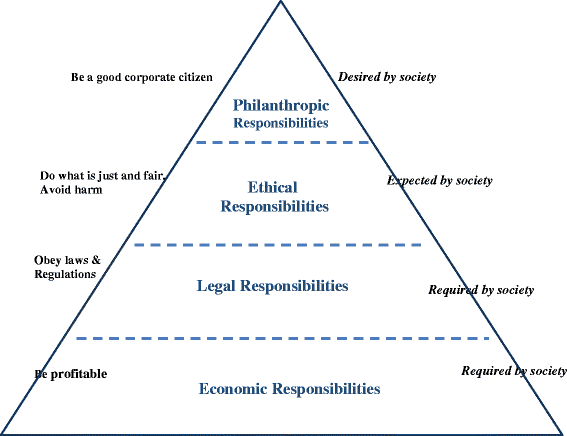
Economic corporate responsibility refers to the practice of making financial decisions based on a commitment to doing good. To uphold economic responsibility, business leaders are challenged to think past operational cost savings and instead put their obligation to corporate citizenship at the heart of all financial decisions.
As a fundamental condition or requirement of existence, businesses have an economic responsibility to the society that permitted them to be created and sustained. At first, it may seem unusual to think about an economic expectation as a social responsibility, but society expects business organizations to be able to sustain themselves and the only way this is possible is by being profitable and able to incentivize owners or shareholders to invest and have enough resources to continue in operation. In its origins, society views business organizations as institutions that will produce and sell the goods and services society needs and desires. As an inducement, society allows businesses to take profits. Businesses create profits when they add value, and in doing this they benefit all the stakeholders of the business.
Profits are necessary both to reward investors/owners and also for business growth when profits are reinvested back into the business. CEOs, managers, and entrepreneurs will attest to the vital foundational importance of profitability and return on investment as motivators for business success. Virtually all economic systems of the world recognize the vital importance to the societies of businesses making profits. While thinking about its’ economic responsibilities, businesses employ many business concepts that are directed towards financial effectiveness – attention to revenues, cost-effectiveness, investments, marketing, strategies, operations, and a host of professional concepts focused on augmenting the long-term financial success of the organization.
In today’s hypercompetitive global business environment, economic performance and sustainability have become urgent topics. Those firms that are not successful in their economic or financial sphere go out of business and any other responsibilities that may be incumbent upon them become moot considerations. Therefore, economic responsibility is a baseline requirement that must be met in a competitive business world and so economic responsibility is a critical part of corporate social responsibility.
Corporate citizenship is the extent to which a business meets its legal, ethical, and economic responsibilities. Investors are increasingly looking for companies with socially responsible orientations, which can lead to positive stock returns and increased confidence by investors.
Businesses have legal responsibilities to comply with laws and regulations at the local, national, and international levels. Society has not only sanctioned businesses as economic entities, but it has also established the minimal ground rules under which businesses are expected to operate and function. These ground rules include laws and regulations and in effect reflect society’s view of “codified ethics”. They articulate fundamental notions of fair business practices as established by lawmakers at federal, provincial/state and local levels. Businesses are expected and required to comply with these laws and regulations as a condition of operating. It is not an accident that compliance officers now occupy an important and high-level position in company organization charts.

While meeting these legal responsibilities, managers must do the following:
Operating a business in Canada involves adhering to various laws, regulations, and acts at the federal, provincial/territorial, and municipal levels. Business law refers to rules, statutes, codes, and regulations established to provide a legal framework within which business may be conducted. Businesses are subject to many laws; some pertain to operations while others pertain to human resources and sustainable practices. Legal compliance refers to conducting a business within the boundaries of all the legal regulations of that industry. Legislation governing business practice includes (but is not limited to) the following:
Employment-related legislation covers the following subjects: employment standards, human rights, federal and provincial privacy, occupational health and safety, workers’ compensation, and labour regulations legislation.
The Employment Equity Act states that no person shall be denied employment opportunities or benefits for reasons unrelated to ability. It seeks to improve the employment conditions experienced by women, Indigenous peoples, persons with disabilities, and visible minorities.
The Canadian Charter of Rights and Freedoms is a binding legal document that protects the basic human rights of all Canadians, such as fundamental freedoms, democratic rights, mobility rights, legal rights, equality rights, and language rights. The Charter is often cited in legal cases pertaining to human rights issues. While the Charter allows all Canadians to express their thoughts and opinions freely it also protects everyone’s right to be treated fairly, without discrimination.
The Canadian Human Rights Act extends the law to ensure equal opportunity to individuals who may be victims of discriminatory practices based on a set of prohibited grounds: race, colour, religion, national or ethnic origin, age, sex, sexual orientation, marital status, family status, disability, or conviction for an offence for which a pardon has been granted. It applies to all federally regulated activities, but each province and territory has its own anti-discrimination laws that apply to non-federally regulated activities.
Federally regulated organizations must comply with the Canada Labour Code, while other organizations are subject to the Employment Standards and Labour Codes of the individual provinces and territories. For example, in Ontario, under the Employment Standards Act (ESA), you can learn about your employee rights and obligations in this Employment Standards Act guide which describes the rules about minimum wage, hours of work limits, termination of employment, public holidays, pregnancy and parental leave, severance pay, vacation and more.
In the United States there are similar laws pertaining to those listed above. One example is the U.S. Department of Labor website for Wages and the Fair Labor Standards Act, or visit the USA government website for a list of labor laws and worker protection.
The normative expectations of most societies hold that laws are essential but not sufficient. In addition to what is required by laws and regulations, society expects businesses to operate and conduct their affairs in an ethical fashion. Businesses have ethical responsibilities to ensure fair practices and treat customers, employees, and stakeholders with respect.
Taking on ethical responsibilities implies that organizations will embrace those activities, norms, standards and practices that even though they are not codified into law, are expected, nonetheless. Part of the ethical expectation is that businesses will be responsive to the “spirit” of the law, not just the letter of the law. Another aspect of the ethical expectation is that businesses will conduct their affairs in a fair and objective fashion even in those cases when laws do not provide guidance or dictate courses of action. Thus, ethical responsibilities embrace those activities, standards, policies, and practices that are expected or prohibited by society even though they are not codified into law. The goal of these expectations is that businesses will be responsible for and responsive to the full range of norms, standards, values, principles, and expectations that reflect and honor what consumers, employees, owners and the community regard as consistent with respect to the protection of stakeholders’ moral rights. The distinction between legal and ethical expectations can often be tricky. Legal expectations certainly are based on ethical premises. But ethical expectations carry these further. In essence, then, both contain a strong ethical dimension or character and the difference hinges upon the mandate society has given business through legal codification.
While meeting these ethical responsibilities, managers must do the following:
As an overlay to all that has been said about ethical responsibilities, it also should be clearly stated that in addition to society’s expectations regarding ethical performance, there are also the great, universal principles of moral philosophy such as rights, justice, and utilitarianism that also should inform and guide company decisions and practices.
Corporate philanthropy includes all forms of business giving. Corporate philanthropy embraces business’s voluntary or discretionary activities. Philanthropic responsibility is a business’s commitment to improving society through charitable activities, community support, and social initiatives. It’s a key aspect of corporate social responsibility (CSR), and it emphasizes that businesses should not only focus on profit-making.

Philanthropy or business giving may not be a responsibility in a literal sense, but it is normally expected by businesses today and is a part of the everyday expectations of the public. Certainly, the quantity and nature of these activities are voluntary or discretionary. They are guided by business’s desire to participate in social activities that are not mandated, not required by law, and not generally expected of business in an ethical sense. Having said that, some businesses do give charitable partly based on ethical motivation. That is, they want to do what is right for society. The public does have a sense that businesses will “give back,” and this constitutes the “expectation” aspect of the responsibility. When one examines the social contract between business and society today, it typically is found that the citizenry expects businesses to be good corporate citizens just as individuals are. To fulfill its perceived philanthropic responsibilities, companies engage in a variety of giving forms – gifts of monetary resources, product and service donations, volunteerism by employees and management, community development and any other discretionary contribution to the community or stakeholder groups that make up the community.
Although there is sometimes an altruistic motivation for business giving, most companies engage in philanthropy as a practical way to demonstrate their good citizenship. This is done to enhance or augment the company’s reputation and not necessarily for noble or self-sacrificing reasons. The primary difference between the ethical and philanthropic categories in the four-part model is that business giving is not necessarily expected in a moral or ethical sense. Society expects such gifts, but it does not label companies as “unethical” based on their giving patterns or whether the companies are giving at the desired level. As a consequence, the philanthropic responsibility is more discretionary or voluntary on business’s part. Hence, this category is often thought of as good “corporate citizenship.” Having said all this, philanthropy historically has been one of the most important elements of CSR definitions and this continues today.
In summary, the four-part CSR definition forms a conceptual framework that includes the economic, legal, ethical, and philanthropic or discretionary expectations that society places on businesses at a given point in time. And, in terms of understanding each type of responsibility, it could be said that the economic responsibility is “required” of business by society; the legal responsibility also is “required” of business by society; the ethical responsibility is “expected” of business by society; and the philanthropic responsibility is “expected/desired” of business by society. As time passes what exactly each of these four categories means may change or evolve as well.
The pyramid should not be interpreted to mean that business is expected to fulfill its social responsibilities in some sequential, hierarchical fashion, starting at the base. Rather, business is expected to fulfill all responsibilities simultaneously. The positioning or ordering of the four categories of responsibility strives to portray the fundamental or basic nature of these four categories to business’s existence in society. As said before, economic and legal responsibilities are required; ethical and philanthropic responsibilities are expected and desired. The representation being portrayed, therefore, is that the total social responsibility of business entails the concurrent fulfillment of the firm’s economic, legal, ethical, and philanthropic responsibilities. Stated in the form of an equation, it would read as follows: Economic Responsibilities + Legal responsibilities + Ethical Responsibilities + Philanthropic Responsibilities = Total Corporate Social Responsibility. Stated in more practical and managerial terms, the CSR driven firm should strive to make a profit, obey the law, engage in ethical practices and be a good corporate citizen. When seen in this way, the pyramid is viewed as a unified or integrated whole.
CSR reporting has evolved from relatively simple environmental statements to comprehensive triple-bottom-line (people, planet, profit) reporting which is used as a framework for measuring and reporting corporate performance against economic, social, and environmental parameters. Corporate Social Responsibility (CSR) is typically measured through a combination of quantitative and qualitative metrics that assess how well a company is meeting its social, environmental, and ethical obligations. Different organizations use various frameworks, tools, and reporting standards to evaluate CSR performance. Some of the most common methods include the Global Reporting Initiative (GRI), Sustainability Accounting Standards Board (SASB), Key Performance Indicators (KPI), Dow Jones sustainability index (DJSI), stakeholder feedback, and benchmarking.

ESG stands for Environmental, Social, and Governance. It refers to a set of standards used by businesses to evaluate and address their impact on the world, beyond just financial performance. The FTSE4Good Index Series is designed to measure the performance of companies demonstrating specific Environmental, Social and Governance (ESG) practices. Transparent management and clearly defined ESG criteria make FTSE4Good indices suitable tools to be used by a wide variety of market participants when creating or assessing sustainable investment products.
There has been an increasing focus on corporate sustainability and reporting and a question often asked is what is the difference between CSR and ESG? CSR and ESG are different frameworks that companies use to assess sustainability. In short, CSR may be used as an internal framework, while ESG provides a measure of assessment for investors. It could be argued that ESG is currently overtaking CSR as a measure of sustainability in the corporate world.
The Boston College Center for Corporate Citizenship helps companies advance and elevate their corporate citizenship to deliver both business and social value, no matter where they are in their corporate citizenship journey. As the leading corporate citizenship membership community, The Boston College Center for Corporate Citizenship uses research-based knowledge, best-in-class learning opportunities, and dynamic peer network to help ALL companies know more about the global landscape of corporate citizenship; do more to optimize performance and value through the environmental, social, and governance (ESG) dimensions of firm performance—and thus achieve more as effective corporate citizens.
Morningstar Sustainalytics provides high-quality, analytical environmental, social and governance (ESG) research, ratings and data to institutional investors and companies. For more than 30 years, this firm has focused on delivering innovative solutions that have enabled the world’s leading institutional investors to identify, understand, and manage ESG-driven risks and opportunities.
Greenwashing refers to the practice of misleading consumers or stakeholders into believing that a company, product, or initiative is more environmentally friendly or sustainable than it actually is. Companies engage in greenwashing by exaggerating, omitting, or fabricating claims about their environmental practices to enhance their reputation or market appeal.
An example of a Canadian company accused of greenwashing is Shell Canada. The company launched its “Drive Carbon Neutral” program in 2020, claiming that the carbon emissions from fuel sold at its gas stations would be offset through investments in forest conservation projects. However, Greenpeace Canada raised concerns about the reliability of these claims, stating that the offsets were overstated or ineffective. They argued the program distracted from the need for Shell to reduce fossil fuel usage directly. Following these criticisms, Shell Canada discontinued the program in 2023.
In the United States, Suncor Energy has faced allegations of greenwashing due to its CEO’s statements about decarbonization efforts. Critics, including Members of Parliament, questioned the company’s commitment to climate change initiatives, suggesting that its strategies and public communications did not align with substantive action on emissions reduction.
These cases highlight the importance of transparency and verifiable claims in corporate environmental initiatives.
Ethics is the philosophical discipline concerned with what is morally good and bad, and morally right and wrong. Ethics, morals, and values – these are complex principles. Depending on the person, culture, time, situation, age, gender, business, or context these concepts can change. People’s morals or ethics are shaped when they are relatively young and are influenced not only by our parents but by society, our culture, and in some cases by our religion as well. Ethics can present challenges, dilemmas, and lapses of judgment. These challenges occur because these influences complicate how people make ethical decisions or think about ethics personally or professionally.
Ideally, prison terms, heavy fines, and civil suits would discourage corporate misconduct, but, unfortunately, many experts suspect that this assumption is a bit optimistic. Whatever the condition of the ethical environment in the near future, one thing seems clear: the next generation entering business—which includes most of you—will find a world much different than the one that waited for the previous generation. Recent history tells us in no uncertain terms that today’s business students, many of whom are tomorrow’s business leaders, need a much sharper understanding of the difference between what is and isn’t ethically acceptable. As a business student, one of your key tasks is learning how to recognize and deal with the ethical challenges that will confront you. Asked what he looked for in a new hire, Warren Buffet, the world’s most successful investor, replied: “I look for three things. The first is personal integrity, the second is intelligence, and the third is a high energy level.” He paused and then added: “But if you don’t have the first, the second two don’t matter”.
As business students, it is important to begin to understand how ethics affects you – what are your ethics like? If you had a compass, where would you fall? Studying ethics will help you understand this.
From a business perspective, ethics is even more complex. How do organizations know how to do the right thing? How do they know how to be socially responsible or how to practice effective corporate social responsibility? Part of this knowledge has to do with the leaders and culture of the organization. Part of the challenge is that things like conflicts occur, such as conflicts of interest, when individuals must choose between taking actions that promote their personal interest over the interests of others or conflicts of loyalty, when individuals have a responsibility to be loyal to a friend, family member, or employer and that conflicts with their ability to act ethically. These types of conflicts present real ethical dilemmas that make it very challenging to figure out how to do what’s right.
It’s in the best interest of a company to operate ethically. Trustworthy companies are better at attracting and keeping customers, talented employees, and capital. Those tainted by questionable ethics suffer from dwindling customer bases, employee turnover, and investor mistrust. Acting ethically in business means more than simply obeying applicable laws and regulations. It also means being honest, doing no harm to others, competing fairly, and declining to put your own interests above those of your company, its owners, and its workers. If you’re in business, you obviously need a strong sense of what’s right and wrong. You need personal conviction to do what’s right, even if it means doing something that’s difficult or personally disadvantageous.
Ethical issues are the difficult social questions that involve some level of controversy over what is the right thing to do. Environmental protection is an example of a commonly discussed ethical issue, because there can be tradeoffs between environmental and economic factors.
An ethical lapse is a mistake or error in judgment that produces a harmful outcome. It is a failure to follow proper ethical principles. An ethical lapse can be viewed in two ways, as either a clearly unethical decision or a mistake that resulted in an unethical outcome. It is not considered a complete lack of integrity, just an oversight or an ethical blind spot. Ethical lapses often reflect a failure of leadership, culture, or systems that prioritize accountability and integrity. Maintaining robust ethics training and a strong corporate governance framework can help prevent such lapses.
Ethical dilemmas are situations in which it is difficult for an individual to make decisions either because the right course of action is unclear or carries some potential negative consequences for the person or people involved.

Make no mistake about it: when you enter the business world, you’ll find yourself in situations in which you’ll have to choose the appropriate behavior. How, for example, would you answer questions like the following?
Obviously, the types of situations are numerous and varied. Fortunately, we can break them down into a few basic categories: issues of honesty and integrity, conflicts of interest and loyalty, bribes versus gifts, and whistle-blowing. Let’s look a little more closely at each of these categories.
An ethical lapse in honesty and integrity occurs when an individual, organization, or company fails to uphold fundamental ethical principles, such as truthfulness, transparency, and adherence to moral standards. It typically involves actions or decisions that prioritize self-interest, convenience, or profit over fairness, accountability, and ethical responsibility.
A recent example of an ethical lapse involving honesty and integrity in a Canadian company is the case of PwC Canada. The accounting firm was found to have systemic answer-sharing among employees during mandatory internal training assessments between 2016 and 2020. These assessments were designed to evaluate professional competencies, but many employees, including senior associates and managers, participated in or facilitated widespread sharing of answers. This practice reflected a failure in fostering a culture of ethical integrity and ensuring independent completion of assessments. PwC Canada self-reported the issue, leading to fines totaling $1.45 million imposed by the Chartered Professional Accountants of Ontario. The incident undermined public trust in the firm and raised questions about its internal quality controls and ethical standards.
A recent example of a U.S. company facing an ethical lapse related to honesty and integrity involves the biotech company Illumina. In July 2023, the European Commission fined Illumina €432 million (approximately $476 million USD) for merging with the cancer detection company Grail without obtaining the necessary regulatory approval. The Commission called this action an “unprecedented and very serious infringement” of EU merger control rules. This lapse reflects ethical concerns over compliance with international regulations and transparency in business operations, as the company knowingly bypassed established legal procedures to expedite the merger.
If you work for a company that settles for its employees merely obeying the law and following a few internal regulations, you might think about moving on. If you’re being asked to deceive customers about the quality or value of your product, you’re in an ethically unhealthy environment.
Conflicts of interest occur when individuals must choose between taking actions that promote their personal interests over the interests of others or taking actions that don’t. A conflict can exist, for example, when an employee’s own interests interfere with, or have the potential to interfere with, the best interests of the company’s stakeholders (management, customers, and owners). Let’s say that you work for a company with a contract to cater events at your college and that your uncle owns a local bakery. Obviously, this situation could create a conflict of interest (or at least give the appearance of one—which is a problem in itself). When you’re called on to furnish desserts for a luncheon, you might be tempted to send some business your uncle’s way even if it’s not in the best interest of your employer. What should you do? You should disclose the connection to your boss, who can then arrange things so that your personal interests don’t conflict with the company’s.
The same principle holds that an employee shouldn’t use private information about an employer for personal financial benefit. Say that you learn from a coworker at your pharmaceutical company that one of its most profitable drugs will be pulled off the market because of dangerous side effects. The recall will severely hurt the company’s financial performance and cause its stock price to plummet. Before the news becomes public, you sell all the stock you own in the company. What you’ve done is called insider trading—acting on information that is not available to the general public, either by trading on it or providing it to others who trade on it. Insider trading is illegal, and you could go to jail for it.
You may one day find yourself in a bind between being loyal either to your employer or to a friend or family member. Perhaps you just learned that a coworker, a friend of yours, is about to be downsized out of his job. You also happen to know that he and his wife are getting ready to make a deposit on a house near the company headquarters. From a work standpoint, you know that you shouldn’t divulge the information. From a friendship standpoint, though, you feel it’s your duty to tell your friend. Wouldn’t he tell you if the situation were reversed? So, what do you do? As tempting as it is to be loyal to your friend, you shouldn’t tell. As an employee, your primary responsibility is to your employer. You might be able to soften your dilemma by convincing a manager with the appropriate authority to tell your friend the bad news before he puts down his deposit.
A notable example of a conflict of loyalty in Canadian business arose in the legal dispute involving Groupe Excellence, a Quebec-based insurance company. This case centered on two directors and presidents of the company, who failed to inform the majority shareholders about a potential acquisition interest from Industrial Alliance Insurance. Instead, the presidents secretly negotiated the deal, bought out the shareholders’ stakes, and sold them to Industrial Alliance at a significantly higher profit, depriving the shareholders of substantial financial benefits. The Supreme Court of Canada examined whether the directors breached their duties of loyalty, good faith, and disclosure to the shareholders. It concluded that while they did not owe a fiduciary duty directly to shareholders, they breached an implied obligation of good faith due to a separate compensation agreement that required them to act in the shareholders’ best interests. This lapse resulted in legal actions against the directors, highlighting the delicate balance of duties and conflicts in corporate governance. This case illustrates how conflicts of loyalty can arise when individuals in leadership positions prioritize personal gains over their professional obligations, leading to ethical and legal repercussions.
In the video below, an ethical dilemma is presented. Dilemmas are situations that you find yourself in when you have to make a decision that does not have a clear answer. Like in the dilemma presented in the video, what would have happened if Amber took the money? As the video discusses, it’s not the right thing to do. However, the dilemmas lie within the context of the situation as well, what if Amber was living in poverty? What’s the right thing to do in that situation? Would it change your response? To help guide us we need to fall back on our morals, the ethical framework that helps us to be honest and go through life and situations with integrity.
Play the YouTube video below, “Ethics” to review an ethical dilemma experienced by Amber. Transcript for “Ethics.” Video [PDF–New Tab]. Closed captioning is available on YouTube.
It is not uncommon in business to give and receive small gifts of appreciation, but when is a gift unacceptable? When is it really a bribe?
There is often a fine line between a gift and a bribe. The following information may help to draw that line, because it raises key issues in determining how a gesture should be interpreted: the cost of the item, the timing of the gift, the type of gift, and the connection between the giver and the receiver. If you are on the receiving end, it is a good idea to refuse any item that is overly generous or given for the purpose of influencing a decision. Because accepting even small gifts may violate company rules, always check on company policy.
In both Canada and the U.S., companies have struggled to define clear distinctions between gifts and bribes. A gift intended to maintain goodwill or celebrate a partnership might be ethical if it’s modest and transparent. However, lavish or undisclosed gifts designed to influence decision-making cross the line into bribery. Policies like those of the FCPA emphasize transparency, proper recording, and adherence to anti-corruption laws to avoid such lapses.
An example of an ethical lapse involving bribes versus gifts in a Canadian company includes the high-profile case of SNC-Lavalin. The Montreal-based engineering firm faced allegations of bribery related to securing business in Libya. The accusations included millions of dollars in payments classified as bribes, disguised as legitimate business expenses, which raised ethical concerns about distinguishing acceptable corporate gifts from outright corruption. This led to legal actions under Canada’s Corruption of Foreign Public Officials Act and significant reputational damage.
In the U.S., Walmart faced scrutiny for alleged bribery practices in Mexico, where executives were accused of paying off officials to expedite permits and construction approvals. The investigation revealed systemic issues in distinguishing ethical gifts or facilitation payments from bribes, ultimately resulting in a $282 million settlement under the U.S. Foreign Corrupt Practices Act (FCPA).
Both cases highlight the importance of robust compliance programs to ensure clear policies about what constitutes acceptable business conduct, emphasizing the need for transparency and adherence to anti-bribery laws.
A whistleblower is someone who reports waste, fraud, abuse, corruption, or dangers to public health and safety to someone who is in the position to rectify the wrongdoing. A whistleblower typically works inside of the organization where the wrongdoing is taking place; however, being an agency or company “insider” is not essential to serving as a whistleblower. What matters is that the individual discloses information about wrongdoing that otherwise would not be known.

An example of whistleblowing in a Canadian company involves Coinsquare, a cryptocurrency trading platform. From 2018 to 2019, Coinsquare engaged in “wash trading,” where an algorithm created fake buy-and-sell orders to inflate trading volumes artificially. A whistleblower within the company, who discovered and reported this practice to senior management, faced significant retaliation, including threats to their employment and eventual termination after taking stress leave due to the issue. The Ontario Securities Commission (OSC) investigated and determined that Coinsquare’s actions violated securities laws and whistleblower protections. As part of a settlement, the company admitted to the reprisal and agreed to strengthen its whistleblower policies, while the former CEO faced fines and a ban on serving as an officer or director.
In the past few years, a notable whistleblower case in the USA involved BofI Federal Bank (now called Axos Bank), where an internal auditor, Erhart, reported concerns about the bank’s risky business practices. He had raised alarms about high deposit concentrations and risky loans to potentially fraudulent entities. After Erhart reported these issues internally, he was fired, and the case progressed to a legal battle under the Sarbanes-Oxley Act (SOX) for whistleblower protection. In 2023, the jury sided with Erhart, awarding him significant compensation, and the court denied the bank’s attempt to overturn the decision. The case highlighted concerns over shareholder fraud and internal controls violations.
Another example of a whistleblower case in the USA occurred at Donovan Salvage Works, a Delaware salvage yard. An employee, a smelter operator, reported a safety hazard involving a propane leak at the yard. After the employee refused to continue working under unsafe conditions, he was terminated by the company in retaliation for reporting the issue. Following an investigation by the Occupational Safety and Health Administration (OSHA), the company was found guilty of wrongful termination and was ordered to pay $40,000 in back wages and damages.
Despite significant financial investment in its whistleblower protection framework, Canada has failed to adequately protect individuals reporting misconduct. Over 500 whistleblowers faced reprisals without sufficient remedies. This was highlighted in international assessments, which rated Canada’s legal framework for whistleblower protections as among the worst globally. The case underscores the challenges whistleblowers face in bringing attention to unethical practices without fearing retaliation.
In the United States, a significant 2023 case involved a whistleblower under the False Claims Act. The individual, a doctor, accused a healthcare company of enabling Medicare fraud. The case reached the U.S. Supreme Court, which ruled the Department of Justice could dismiss such lawsuits even if initially allowed to proceed. This ruling reflects the complex interplay between whistleblower rights and government oversight in ensuring actionable claims move forward without undue burden.
These examples highlight how whistleblowing plays a critical role in exposing corporate and institutional malpractice, but also the legal and systemic barriers faced in both Canada and the U.S.
When organizations are ethical and practice CSR consumer and employee rights will be highly considered and handled with integrity and ethics. For employee’s health and safety, privacy, wages, and benefits, along with the right to not be harassed or discriminated against are all-important ethical considerations. Consumers have rights too; consumers expect that the products they buy will be safe, in terms of production, consumption, and/or use. Consumers also have the right to be made aware of how the product is made or what the service involves. The choice is their right too – they can buy whatever products or services that they want; and it’s the responsibility of businesses to let consumers know about alternatives or information that they need to be aware of regarding the product or service they are buying.
A recent survey found that 38% of employees consider “ethical standards” to be the first or second-most important workplace attribute (Refer to Figure 6.3). People spend much of their lives at work. An ethical workplace is key because it allows employees to feel a sense of purpose and integrity on the job.
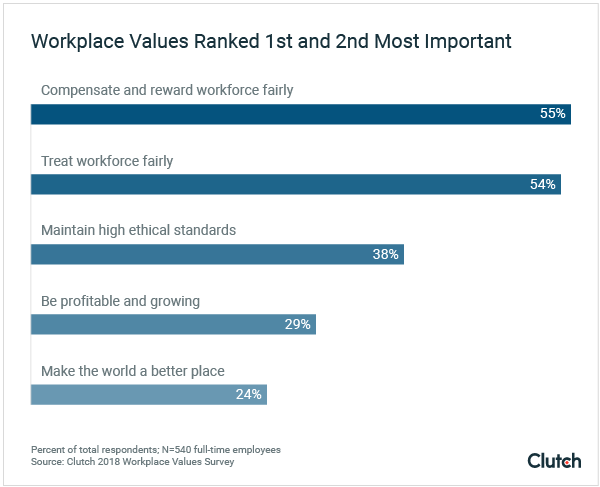
For a business to be considered an ethical organization, it must demonstrate integrity, transparency, and accountability in all aspects of its operations. Creating an ethical business environment involves adherence to laws and regulations, strong corporate governance, and proactive efforts to ensure the well-being of employees, customers, and the community. For example, a few of the companies that do this well include those listed on the 2024 “100 Best Corporate Citizens” list which, to name a few, included HP Inc., Johnson & Johnson, PepsiCo Inc., Ford Motor Company, and The Hershey Company.
Key factors in creating an ethical business environment include:
By focusing on these elements, businesses can build a reputation as ethical organizations while ensuring long-term success and trust from stakeholders.
Sexual harassment occurs when an employee makes “unwelcome sexual advances, requests for sexual favours, and other verbal or physical conduct of a sexual nature” to another employee. It’s also considered sexual harassment when “submission to or rejection of this conduct explicitly or implicitly affects an individual’s employment, unreasonably interferes with an individual’s work performance or creates an intimidating, hostile or offensive work environment.” In Canada, the legal framework for addressing sexual harassment includes protections under the Canadian Human Rights Act (CHRA), provincial human rights codes, and the Canada Labour Code for federally regulated workplaces.[/footnote]
Sexual harassment rocketed to the top of news reports and social media when on October 5, 2017, The New York Times broke the story of Harvey Weinstein’s decades of harassment in Hollywood. In March of 2018, CBC News collated the allegations of sexual harassment against prominent Canadians. The list, including only those allegations reported by CBC, highlight the prevalence of this issue.
Government of Canada reported that in 2020 one in four women and one in six men reported having experienced inappropriate sexualized behaviours at work in the previous year. Indigenous women and members of the LGBTQ+ community are disproportionately affected, with much higher likelihoods of experiencing sexual violence. Federally regulated sectors such as transportation, banking, and communication account for a significant proportion of harassment incidents. In 2022, 31% of reported sexual harassment occurrences were from the road transportation sector, 17% from air transportation, and 15% from banking.
To prevent sexual harassment—or at least minimize its likelihood—a company should adopt a formal anti-harassment policy describing prohibited conduct, asserting its objections to the behaviour, and detailing penalties for violating the policy. Employers also have an obligation to investigate harassment complaints. Failure to enforce anti-harassment policies can be very costly.
In addition to complying with equal employment opportunity laws, many companies make special efforts to create an inclusive workforce by recruiting employees who are underrepresented in the workforce according to sex, race, or some other characteristic. In helping to build more inclusive workforces, such initiatives contribute to competitive advantage for two reasons:
On September 30, 1982, twelve-year-old Mary Kellerman of Chicago died after her parents gave her Extra-Strength Tylenol. That same morning, twenty-seven-year-old Adam Janus, also of Chicago, died after taking Tylenol for minor chest pain. That night, when family members came to console his parents, Adam’s brother and his wife took Tylenol from the same bottle and died within forty-eight hours. Over the next two weeks, four more people in Chicago died after taking Tylenol. The actual connection between Tylenol and the series of deaths wasn’t made until an off-duty fireman realized from news reports that every victim had taken Tylenol. As consumers panicked, Johnson & Johnson (J&J) company pulled Tylenol off Chicago-area retail shelves. Researchers discovered Tylenol capsules containing large amounts of deadly cyanide. Because the poisoned bottles came from batches originating at different J&J plants, investigators determined that the tampering had occurred after the product had been shipped.
So, J&J wasn’t at fault. But CEO Burke was still faced with an extremely serious dilemma: Was it possible to respond to the tampering cases without destroying the reputation of a highly profitable brand?
Burke had two options:
Burke opted to recall all 31 million bottles of Extra-Strength Tylenol on the market. The cost to J&J was $100 million, but public reaction was quite positive. Less than six weeks after the crisis began, Tylenol capsules were reintroduced in new tamper-resistant bottles, and by responding quickly and appropriately, J&J was eventually able to restore the Tylenol brand to its previous market position. When Burke was applauded for moral courage, he replied that he’d simply adhered to the long-standing J&J credo that put the interests of customers above those of other stakeholders. His only regret was that the perpetrator was never caught.
If you’re wondering what your thought process should be if you’re confronted with an ethical dilemma, you might wish to remember the mental steps listed here—which happen to be the steps that James Burke took in addressing the Tylenol crisis:
How can you make sure that you do the right thing in the business world? How should you respond to the kinds of challenges that you’ll be facing? Because your actions in the business world will be strongly influenced by your moral character, let’s begin by assessing your current moral condition. Which of the following best applies to you (select one)?
Now that you’ve placed yourself in one of these categories, here are some general observations. Few people put themselves below the second category. Most of us are ethical most of the time, and most people assign themselves to category number two— “I’m mostly ethical.” Why don’t more people claim that they’re always ethical?
Apparently, most people realize that being ethical all the time takes a great deal of moral energy. If you placed yourself in category number two, ask yourself this question: How can I change my behaviour so that I can move up a notch? The answer to this question may be simple. Just ask yourself an easier question: How would I like to be treated in a given situation?
Unfortunately, practicing this philosophy might be easier in your personal life than in the business world. Ethical challenges arise in business because companies, especially large ones, have multiple stakeholders who sometimes make competing demands. Making decisions that affect multiple stakeholders isn’t easy even for seasoned managers; and for new entrants to the business world, the task can be extremely daunting. You can, however, get a head start in learning how to make ethical decisions by looking at two types of challenges that you’ll encounter in the business world: ethical dilemmas and ethical decisions.
To maintain your own honesty and integrity in the workplace, do the following:
Ask yourself the following five questions as a test to help you improve your chances of making ethical decisions. If you answer, yes, to any of them, then you probably should not do it.
Some ethical problems are fairly straightforward. Others, unfortunately, are more complicated, but it will help to think of our five-question test as a set of signals that will warn you that you’re facing a particularly tough decision— that you should think carefully about it and perhaps consult someone else. The situation is like approaching a traffic light. Red and green lights are easy; you know what they mean and exactly what to do. Yellow lights are trickier. Before you decide which pedal to hit, try posing the five questions. If you get a single yes, you’ll almost surely be better off hitting the brake.
Despite all the good arguments in favour of doing the right thing, why do many reasonable people act unethically (at least at times)? Why do good people make bad choices? According to one study, there are four common rationalizations (excuses) for justifying misconduct:
If you find yourself having to rationalize a decision, it’s probably a bad one.
Check your understanding of this chapter’s concepts by completing this short self-check quiz.
An interactive H5P element has been excluded from this version of the text. You can view it online here:
https://ecampusontario.pressbooks.pub/businessfundamentals/?p=264#h5p-32
The contents of this chapter is a compilation sourced from various OER resources, please refer to the Book Information for details.
(Note: This reference list was produced using the auto-footnote and media citation features of Pressbooks)
Fernando, J. (2024, March 6). What is CSR? Corporate social responsibility explained. https://www.investopedia.com/terms/c/corp-social-responsibility.asp#:~:text=Corporate%20social%20responsibility%20is%20a%20business%20model%20by,and%20promote%20a%20positive%20brand%20image%20for%20companies.
United Nations (n.d.). Sustainable development goals (SDGs). https://unosd.un.org/content/sustainable-development-goals-sdgs
CCOHS. (n.d.). Health and safety legislation in Canada. https://www.ccohs.ca/oshanswers/legisl/legislation/intro.html
Government of Canada. (2022). 2022 annual report — Occupational injuries in the Canadian federal jurisdiction. https://www.canada.ca/en/employment-social-development/services/health-safety/reports/2022-injuries.html
U.S. Department of Labor. Occupational safety and health administration. https://www.osha.gov/
Target. (2024). Target circle community giving. https://corporate.target.com/sustainability-governance/communities/grants-corporate-giving/target-circle-community-giving#:~:text=Our%20impact,communities%20where%20we%20do%20business.
Loblaw Companies Limited. (n.d.). Helping Canadians live life well. https://www.loblaw.ca/
Telus. (n.d.). Funding meaningful change. https://www.telus.com/en/social-impact/giving-back/community-grants
benevity. (n.d.). The 4 main types of corporate social responsibility your business should consider (and why). https://benevity.com/resources/types-of-corporate-social-responsibility#:~:text=Economic%20responsibility%20refers%20to%20the,way%20of%20bolstering%20their%20mission.
Hayes, A. (2022, December 29). Corporate citizenship: What it means, 5 stages, and examples. https://www.investopedia.com/terms/c/corporatecitizenship.asp#:~:text=Investopedia%20/%20Julie%20Bang-,What%20Is%20Corporate%20Citizenship?,and%20governance%20(ESG)%20practices.
Government of Canada. (n.d.). Overview of policy issues and background–Employment equity act review. https://www.canada.ca/en/employment-social-development/corporate/portfolio/labour/programs/employment-equity/reports/act-review-overview-backgrounder-policy-issues.html
Government of Canada. (n.d.). Canadian human rights act. Justice Laws Website. https://laws-lois.justice.gc.ca/eng/acts/h-6/page-1.html
FTSE Russell. (n.d.). Overview. https://www.lseg.com/en/ftse-russell/indices/ftse4good
O’Neill, S. (n.d.). What is the difference between CSR and ESG? https://www.thecorporategovernanceinstitute.com/insights/lexicon/what-is-the-difference-between-csr-and-esg/
BCCCC. (n.d.). About. https://ccc.bc.edu/content/ccc/about/our-approach.html
Morningstar. (n.d.). About us. https://www.sustainalytics.com/about-us
Meyer, C. (2024, February 9). What do ‘clean’ and ‘green’ actually mean? Canadian watchdog receives complaints about environmental claims by Shell, RBC, Embridge. https://thenarwhal.ca/competition-bureau-greenwashing-investigations/
Rabson, M. (2023, October 16). Suncor Energy CEO says company committed to decarbonization, is accused of greenwashing. https://globalnews.ca/news/10027106/suncor-ceo-commons-committee/
Gostick, A., & Telford D. (2003). The integrity advantage. Salt Lake City: Gibbs Smith. https://openlibrary.org/books/OL8821943M/The_Integrity_Advantage
Frenz, R. (2017, September 26). What are ethical lapses? https://bizfluent.com/info-8292625-advantages-disadvantages-ethical-reasoning.html
Ellis, C. (2023, December 15). What went wrong at PwC Canada: Accounting firm agrees to pay $1.45 million to settle exam cheating scandal. Canadian Accountant. https://canadian-accountant.com/content/profession/pwc-canada-settlement-cpao
Chee, F. Y. (2023, July 14). Illumina hit with record $476 million EU antitrust fine over Grail deal. https://www.reuters.com/markets/deals/eu-regulators-fine-illumina-476-mln-closing-grail-deal-without-green-light-2023-07-12/
Mathieu, J. & Weir, O. (2023, December 16). Important takeaways for D&O duty of loyalty and contractual compensation from recent Supreme Court decision. https://www.mccarthy.ca/en/insights/blogs/canadian-securities-regulatory-monitor/important-takeaways-do-duty-loyalty-and-contractual-compensation-recent-supreme-court-decision
BrainPop. (2017, August 23). Ethics. [Video]. YouTube. https://www.youtube.com/watch?v=zPsoFhUDLuU
Bronskill, J. (2022, January 8). Overseas Canadian firms being probed for corruption: RCMP. https://globalnews.ca/news/8497870/canadian-companies-overseas-corruption-probe/
Bose, N. (2019, June 20). Walmart to pay $282 million to settle seven-year global corruption probe. https://www.reuters.com/article/business/walmart-to-pay-282-million-to-settle-seven-year-global-corruption-probe-idUSKCN1TL27I/
NWC. (n.d.). What is a whistleblower? https://www.whistleblowers.org/what-is-a-whistleblower/
BLG. (2020, August 13). OSC’s first whistleblower reprisal case is a cautionary tale for companies. https://www.blg.com/en/insights/2020/08/oscs-first-whistleblower-reprisal-case-is-a-cautionary-tale?utm_source=mondaq&utm_medium=syndication&utm_content=articleoriginal&utm_campaign=article
Foley. (2023, October 4). A review of recent whistleblower developments. https://www.foley.com/insights/publications/2023/10/review-recent-whistleblower-developments-4/
U.S. Department of Labor. (2023, June 28). US department of labor settles whistleblower case against Delaware salvage yard that wrongly terminated employee for reporting safety concerns. https://www.dol.gov/newsroom/releases/osha/osha20230628
(2023, March 1). European court decision highlights Canada’s third-world status on whistleblower protection. https://cfe.torontomu.ca/page/european-court-decision-highlights-canadas-third-world-status-whistleblower-protection
Proskauer. (2023, December 19). Top 10 whistleblowing and retaliation events of 2023. https://www.proskauer.com/pub/top-10-whistleblowing-and-retaliation-events-of-2023
The Manifest. (2023, October 13). How can companies encourage ethics in the workplace? https://themanifest.com/staffing/blog/workplace-ethics
3BLMedia. (2024). 100 best corporate citizens 2024. https://100best.3blmedia.com/
OpenAI. (2023). ChatGPT (Jan 21 version) [Large language model]. https://chat.openai.com
Government of Canada. (n.d.). Harassment and sexual violence in the workplace. https://www.canada.ca/en/employment-social-development/services/health-safety/reports/workplace-harassment-sexual-violence.html
Government of Canada. (n.d.). Workplace harassment and violence prevention regulations--What we heard. https://www.canada.ca/en/employment-social-development/services/health-safety/reports/workplace-harassment-sexual-violence.html
Government of Canada. (2020). In 2020, one in four women and one in six men reported having experienced inappropriate sexualized behaviours at work in the previous year. https://www150.statcan.gc.ca/n1/daily-quotidien/210812/dq210812b-eng.htm
Government of Canada. (n.d.). Sexual violence: It’s not just “how things are”. https://www.canada.ca/en/women-gender-equality/campaigns/gender-based-violence-its-not-just/infographic-sexual-violence-how-things-are.html
Government of Canada. (2022). 2022 annual report — Taking action against harassment and violence in workplaces under Canadian federal jurisdiction. https://www.canada.ca/en/employment-social-development/services/health-safety/reports/2022-workplace-harassment-violence.html
Kaplan, T. (1998). The Tylenol crisis: How effective public relations saved Johnson & Johnson. http://www.aerobiologicalengineering.com/wxk116/TylenolMurders/crisis.html
Yaakov, W. (1999, June 13). CEO saves company’s reputation, products. https://web.archive.org/web/20030712124829/http:/adtimes.nstp.com.my/jobstory/jun13.htm
Maxwell, J. C. (2003). There’s no such thing as “Business Ethics”: There’s only one rule for making decisions. New York: Warner Books.
Online Ethics Center for Engineering and Science. (2004). Advice from the Texas Instruments Ethics Office: Article Number 280: What do you do when the light turns yellow? Onlineethics.org. Retrieved from: https://web.archive.org/web/20060517161459/http://onlineethics.org/corp/help.html
Gellerman, S. W. (1986, July). Why “Good” Managers Make Bad Ethical Choices. Harvard Business Review on Corporate Ethics. https://hbr.org/1986/07/why-good-managers-make-bad-ethical-choices
7
After reading this chapter, you should be able to do the following:
Globalization is the process of increasing economic and social integration between countries, and the increased flow of goods, services, and people across borders.
Do you wear Nike shoes or Timberland boots? Listen to Beyoncé, Pitbull, Twenty One Pilots, or The Neighborhood on Spotify? If you answered yes to either of these questions, you’re a global business customer. Both Nike and Timberland manufacture most of their products overseas. Spotify is a Swedish enterprise.

Take an imaginary walk down Orchard Road, the most fashionable shopping area in Singapore. You’ll pass department stores such as Tokyo-based Takashimaya and London’s very British Marks & Spencer, both filled with such well-known international labels as Ralph Lauren Polo, Burberry, and Chanel. If you need a break, you can also stop for a latte at Seattle-based Starbucks.
When you’re in the Chinese capital of Beijing, don’t miss Tiananmen Square. Parked in front of the Great Hall of the People, the seat of Chinese government, are fleets of black Buicks, cars made by General Motors in Flint, Michigan. If you’re adventurous enough to find yourself in Faisalabad, a medium-size city in Pakistan, you’ll see Hamdard University, located in a refurbished hotel. Step inside its computer labs, and the sensation of being in a faraway place will likely disappear when you recognize the familiar Microsoft flag on the computer screen—the same one emblazoned on screens in Microsoft’s hometown of Seattle and just about everywhere else on the planet.
The globalization of business is bound to affect you. Not only will you buy products manufactured overseas, but it’s likely that you’ll meet and work with individuals from various countries and cultures as customers, suppliers, colleagues, employees, or employers. The bottom line is that the globalization of world commerce has an impact on all of us ~ evidenced in Figure 7.1 below, The Expanded Circular Flow Model. Therefore, it makes sense to learn more about how globalization works.
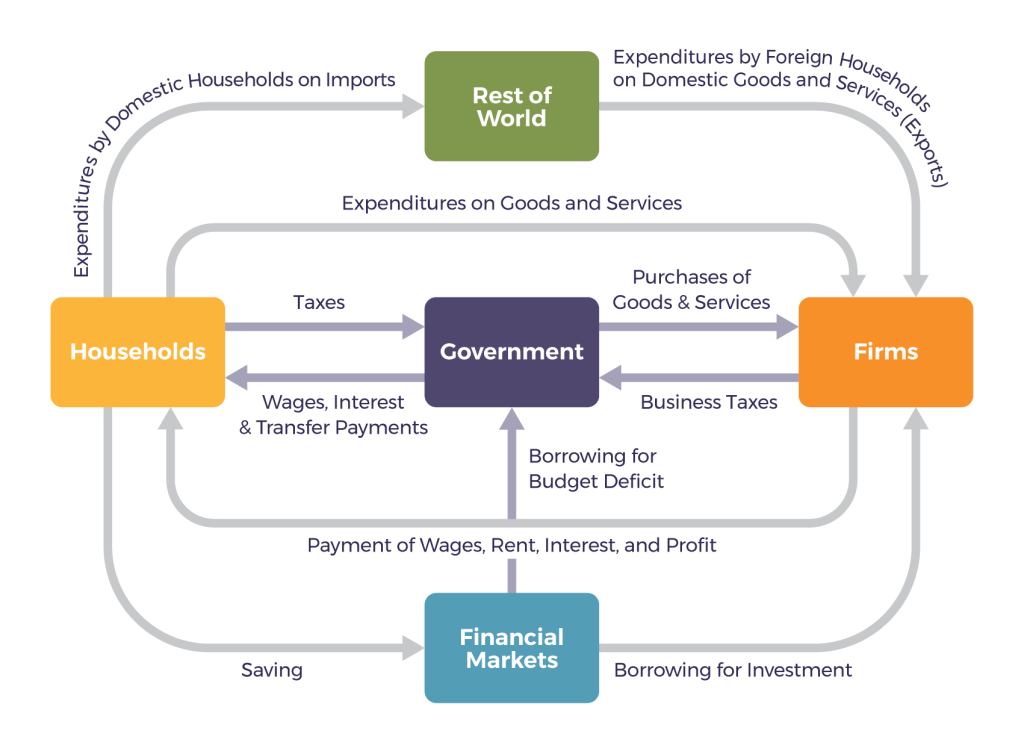
Never has business spanned the globe the way it does today and will continue to do in the future. But why is international business important? Why do companies and nations engage in international trade? What strategies do they employ in the global marketplace? How do governments and international agencies promote and regulate international trade? These questions and others will be addressed in this chapter. Let’s start by looking at the more specific reasons why companies and nations engage in international trade.
Nations trade to capitalize on their unique advantages and to foster economic growth, enhance living standards, and build relationships with other countries. Trade allows countries to access products and services they cannot produce efficiently or lack altogether, enhancing consumer choice and quality of life. Tropical fruits are imported by colder countries like Canada because they cannot be grown domestically. By producing for export, businesses can achieve economies of scale, lowering production costs and making goods more affordable domestically and abroad. Automotive manufacturers in Germany produce vehicles on a large scale, selling them globally. Trade fosters innovation and the spread of new technologies, ideas, and practices, driving development and competitive advantage. Collaboration in international technology markets has accelerated advancements in renewable energy. Trade builds interdependence, reducing the likelihood of conflicts and fostering diplomatic relations. For example, the European Union promotes trade among its member states to strengthen regional stability and cooperation. Exporting goods and services generates income, creating jobs and boosting national Gross Domestic Product (GDP). The export of oil and gas has been a significant contributor to Canada’s economic growth.
Why does Canada import automobiles, steel, digital phones, and apparel from other countries? Why don’t we just make them ourselves? Why do other countries buy wheat, chemicals, machinery, and lumber products from us? Because no national economy produces all the goods and services that its people need. Countries are importers when they buy goods and services from other countries; when they sell products to other nations, they’re exporters. In 2023, the total value of world trade in merchandise and commercial services was $30.5 trillion, a 2% decrease from the previous year. This was due to a 5% decline in the value of goods trade, while the value of services trade increased by 9%. The World Trade Organization (WTO) projects that the volume of world merchandise trade will grow by 0.8% in 2023 and 3.3% in 2024.
Factors that have impacted trade in recent years include:
To understand why certain countries import or export specific products, you need to realize that every country (or region) cannot produce the same products. The cost of labour, the availability of natural resources, and the level of know-how vary greatly around the world. Most economists use the concepts of absolute advantage and comparative advantage to explain why countries import some products and export others.
A nation has an absolute advantage if, (1) it’s the only source of a particular product, or (2) it can make more of a product using fewer resources than other countries. Because of climate and soil conditions, for example, France had an absolute advantage in wine making until its dominance of worldwide wine production was challenged by the growing wine industries in Italy, Spain, the United States, and more recently Canada. Unless an absolute advantage is based on some limited natural resource, it seldom lasts. That’s why there are few, if any, examples of absolute advantage in the world today.
When a country decides to specialize in a particular product, it must sacrifice the production of another product (opportunity costs). Countries benefit from specialization—focusing on what they do best, and trading the output to other countries for what those countries do best. Canada’s top export destinations are the United States, China, and the United Kingdom. In 2023, the United States was the destination for 76% of Canada’s exports.
Canada’s energy exports make up 22% of its total exports. In 2023, the top exports in this category were mineral fuels, oils, and distillation products. Cars and parts are one of Canada’s biggest exports, making up 19% of its total exports. In 2023, the top exports in this category were vehicles other than railway and tramway. Consumer goods make up 12% of Canada’s total exports. Canada exports a variety of minerals, including potash, metallurgical coal, and diamonds. In 2022, Canada was the world’s biggest exporter of potash. Canada also exports machinery, nuclear reactors, boilers, pearls, precious stones, metals, and coins.
The United States, for instance, is increasingly an exporter of knowledge-based products, such as software, movies, music, and professional services (management consulting, financial services, and so forth). America’s colleges and universities, therefore, are a source of comparative advantage, and students from all over the world come to the United States for the world’s best higher-education system. France and Italy are centers for fashion and luxury goods and are leading exporters of wine, perfume, and designer clothing. Japan’s engineering expertise has given it an edge in such fields as automobiles and consumer electronics. And with large numbers of highly skilled graduates in technology, India has become the world’s leader in low-cost, computer-software engineering.
How can we predict, for any given country, which products will be made and sold at home, which will be imported, and which will be exported? This question can be answered by looking at the concept of comparative advantage, which exists when a country can produce a product at a lower opportunity cost compared to another nation. But what’s an opportunity cost?
Since resources are limited, every time you make a choice about how to use them, you are also choosing to forego other options. Economists use the term opportunity cost to indicate what must be given up to obtain something that is desired. A fundamental principle of economics is that every choice has an opportunity cost.
In short, opportunity cost is all around us. The idea behind opportunity cost is that the cost of one item is the lost opportunity to do or consume something else; in short, opportunity cost is the value of the next best alternative. Since people and businesses must choose, they inevitably face trade-offs in which they must give up things they desire to get other things they desire more.
In some cases, recognizing the opportunity cost can alter personal behaviour. Imagine, for example, that you spend $10 on lunch every day at work. You may know perfectly well that bringing a lunch from home would cost only $3 a day, so the opportunity cost of buying lunch at the restaurant is $7 each day (that is, the $10 that buying lunch costs minus the $3 your lunch from home would cost). Ten dollars each day does not seem to be that much. However, if you project what that adds up to in a year—250 workdays a year × $10 per day equals $2 500—it is the cost, perhaps, of a decent vacation. If the opportunity cost were described as “a nice vacation” instead of “$10 a day” you might make different choices.
Opportunity cost also comes into play with societal decisions. Universal health care in the U.S. would be nice, but the opportunity cost of such a decision would be less housing, environmental protection, or national defense. These trade-offs also arise with government policies. For example, after the terrorist plane hijackings on September 11, 2001, many proposals, such as the following, were made to improve air travel safety:
Lost time can be a significant component of opportunity cost.
However, the single biggest cost of greater airline security does not involve money. It is the opportunity cost of additional waiting time at the airport. According to the United States Department of Transportation, more than 800 million passengers took plane trips in the United States in 2012. Since the 9/11 hijackings, security screening has become more intensive, and consequently, the procedure takes longer than in the past. Say that, on average, each air passenger spends an extra 30 minutes in the airport per trip. Economists commonly place a value on time to convert an opportunity cost in time into a monetary figure. Because many air travelers are relatively highly paid business people, conservative estimates set the average “price of time” for air travelers at $20 per hour. Accordingly, the opportunity cost of delays in airports could be as much as 800 million (passengers) × 0.5 hours × $20/hour—or, $8 billion per year. Clearly, the opportunity costs of waiting time can be just as substantial as costs involving direct spending.
To evaluate the nature and consequences of its international trade, a nation looks at two key indicators: balance of trade and balance of payments.
A country’s balance of trade is calculated by subtracting the value of its imports from the value of its exports. If a country sells more products than it buys, it has a favourable balance, called a trade surplus. If it buys more than it sells, it has an unfavourable balance, or a trade deficit.
In 2023, the value of Canada’s annual merchandise exports decreased 1.4% to $768.2 billion, while the value of annual imports rose 1.4% to $770.2 billion. Between 1980 and 2008, Canada recorded a positive trade balance every year, with an expectation of 1991 and 1992. From 2009 onwards, the trade balance shifted to a deficit. In 2021, it switched again to a trade surplus, with energy products making the largest share of exports (Refer to Figure 7.2). The United States remains the country’s biggest trading partner. Other countries, such as China and Taiwan, which manufacture high volumes for export, have large trade surpluses because they sell far more goods overseas than they buy.
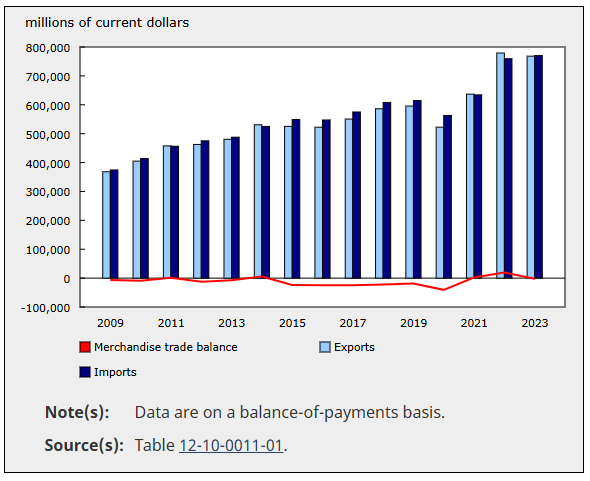
A nation's deficit is when a government spends more money than it receives in revenue over a period of time. This can be due to a number of factors, including excessive spending or borrowing. A nation’s deficit can be an indicator of its financial health and economic situation.
Are trade deficits a bad thing? Not necessarily. They can be positive if a country’s economy is strong enough both to keep growing and to generate the jobs and incomes that permit its citizens to buy the best the world has to offer. That was certainly the case in the Canada in the 1990s and early 2000s. Some experts, however, are alarmed by trade deficits. Investment guru Warren Buffet, for example, cautions that no country can continuously sustain large and burgeoning trade deficits. Why not? Because creditor nations will eventually stop taking IOUs from debtor nations, and when that happens, the national spending spree will have to cease. “A nation’s credit card,” he warns, “charges truly breathtaking amounts. But that card’s credit line is not limitless”.
A country has a trade surplus when it sells more to other countries than it buys from them. It’s the opposite of a trade deficit. A surplus can lead to economic growth and employment, but it can also cause higher prices, interest rates, and a more expensive currency.
Trade surpluses aren’t necessarily good for a nation’s consumers. For example, Japan’s export-fueled economy produced high economic growth in the 1970s and 1980s but most domestically made consumer goods were priced at artificially high levels inside Japan itself—so high, in fact, that many Japanese traveled overseas to buy the electronics and other high-quality goods on which Japanese trade was dependent.
CD players and televisions were significantly cheaper in Honolulu or Los Angeles than in Tokyo. How did this situation come about? Though Japan manufactures a variety of goods, many of them are made for export. To secure shares in international markets, Japan prices its exported goods competitively. Inside Japan, because competition is limited, producers can put artificially high prices on Japanese-made goods. Due to a number of factors (high demand for a limited supply of imported goods, high shipping and distribution costs, and other costs incurred by importers in a nation that tends to protect its own industries), imported goods are also expensive.
Today, Japan may not be as expensive as you think. While prices for certain goods and services are generally higher than you’d find in countries like China, Thailand, and Vietnam, on the whole you might discover that costs are lower than places such as Singapore, Australia, and Scandinavia.
The second key measure of the effectiveness of international trade is balance of payments: the difference, over a period of time, between the total flow of money coming into a country and the total flow of money going out. As in its balance of trade, the biggest factor in a country’s balance of payments is the money that flows as a result of imports and exports. But balance of payments includes other cash inflows and outflows, such as cash received from or paid for foreign investment, loans, tourism, military expenditures, and foreign aid. For example, if a Canadian company buys some real estate in a foreign country, that investment counts in the Canadian balance of payments, but not in its balance of trade, which measures only import and export transactions. In the long run, having an unfavorable balance of payments can negatively affect the stability of a country’s currency. Canada has experienced unfavorable balances of payments since the turn of the century which has forced the government to cover its debt by borrowing from other countries.
The national debt is the combined debt of all three levels of government in Canada: federal, provincial, and territorial. The debt is held by a variety of entities, including the Canadian public, foreigners, and banks, trust and loan companies, and insurance companies. The balance of payments is comprised of three accounts: the current account, the capital account, and the financial account. Figure 7.3 is a chart showing the years 2016-2023 with the year 2023 showing the current account balance posted at a $17.8 billion deficit, up $7.4 billion compared with 2022. The increase in the deficit was largely due to the trade in goods balance going from a surplus of $19.7 billion in 2022 to a deficit of $1.8 billion in 2023.
Below are a few interesting facts about who owes money to whom:
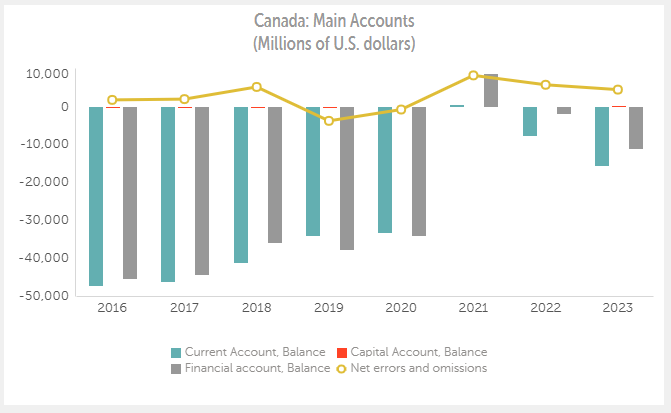
The fact that nations exchange billions of dollars in goods and services each year demonstrates that international trade makes good economic sense. For a company wishing to expand beyond national borders, there are a variety of ways it can get involved in international business. Let’s take a closer look at the more popular ones.
Importing (buying products overseas and reselling them in one’s own country) and exporting (selling domestic products to foreign customers) are the oldest and most prevalent forms of international trade. For many companies, importing is the primary link to the global market. American food and beverage wholesalers, for instance, import for resale in U.S. supermarkets the bottled waters Evian and Fiji from their sources in the French Alps and the Fiji Islands respectively. Other companies get into the global arena by identifying an international market for their products and becoming exporters. The Chinese, for instance, are fond of fast foods cooked in soybean oil. They also have an increasing appetite for meat, therefore, they need high-protein soybeans to raise livestock. The United States exported $15.06 billion worth of soybeans to China in 2023, making it the top destination for US soybean exports.
A few reasons why companies may engage in importing include:
A few reasons why companies may engage in exporting include:
When goods are shipped from one country to another, they must go through customs. Customs is the process of declaring and paying taxes on imported goods. All countries have different regulations for what can and cannot be imported. Some items, such as drugs or weapons, are prohibited because they are dangerous. Other items, such as used tires or chemicals, are restricted because they may harm the environment. The purpose of customs is to protect a country’s economy, environment, jobs, and residents.

A company that wants to get into an international market quickly while taking only limited financial and legal risks might consider licensing agreements with foreign companies. An international licensing agreement allows a foreign company (the licensee) to sell the products of a producer (the licensor) or to use its intellectual property (such as patents, trademarks, copyrights) in exchange for what is known as royalty fees. Here’s how it works: You own a company in the Canada that sells coffee-flavored popcorn. You’re sure that your product would be a big hit in Japan, but you don’t have the resources to set up a factory or sales office in that country. You can’t make the popcorn here and ship it to Japan because it would get stale. So, you enter a licensing agreement with a Japanese company that allows your licensee to manufacture coffee-flavored popcorn using your special process and to sell it in Japan under your brand name. In exchange, the Japanese licensee would pay you a royalty fee – perhaps a percentage of each sale or a fixed amount per unit.
The best way to understand licensing is to think about something that a company owns that they agree to sell to another company to use, either locally or globally. For example, Lego, a company that produces building block toys had to get a license from companies like Disney when they wanted to create their Star Wars Lego sets.
Another popular way to expand overseas is to sell franchises. Under an international franchise agreement, a company (the franchiser) grants a foreign company (the franchisee) the right to use its brand name and to sell its products or services. The franchisee is responsible for all operations but agrees to operate according to a business model established by the franchiser. In turn, the franchiser usually provides advertising, training, and new-product assistance. Franchising is a natural form of global expansion for companies that operate domestically according to a franchise model, including restaurant chains, such as McDonald’s and Kentucky Fried Chicken, and hotel chains, such as Holiday Inn and Best Western. Unlike franchising in the franchisor’s home country, where the franchisor grants the franchisee a license to use the marketing, branding and operations of the franchisor, international franchising usually involves actually selling the franchise rights to a third party to operate as the master franchisee in that area, giving them the rights to open company-owned outlets and sub-franchise in the country or region.
Canadian companies are increasingly drawing on a vast supply of relatively inexpensive skilled labour to perform various business services, such as software development, accounting, and claims processing. This is known as outsourcing. In contrast, contract manufacturing is a specific type of outsourcing related specifically to products when two parties sign a contract manufacturing agreement.
Because of high domestic labour costs, many U.S. and Canadian companies manufacture their products in countries where labour costs are lower. This arrangement is called international contract manufacturing, a form of outsourcing. A domestic company might contract with a local company in a foreign country to manufacture one of its products. It will, however, retain control of product design and development and put its own label on the finished product. Contract manufacturing is quite common in the U.S. apparel business, with most American brands being made in a number of Asian countries, including China, Vietnam, Indonesia, and India.
Thanks to twenty-first-century information technology, non-manufacturing functions can also be outsourced to nations with lower labour costs. Canadian companies are increasingly drawing on a vast supply of relatively inexpensive skilled labour to perform various business services, such as software development, accounting, and claims processing. With a large, well-educated population with English language skills, India has become a centre for software development and customer-call centres. In the case of India, as you can see in the graph below, the attraction is not only a large pool of knowledge workers but also significantly lower wages.
A strategic alliance is an agreement between two companies (or a company and a nation) to pool resources in order to achieve business goals that benefit both partners. A strategic alliance and a joint venture are both collaborative business arrangements between companies, but they differ in structure, commitment, and goals.
What if a company wants to do business in a foreign country but lacks the expertise or resources? Or what if the target nation’s government doesn’t allow foreign companies to operate within its borders unless it has a local partner? In these cases, a firm might enter a strategic alliance with a local company or even with the government itself.

A strategic alliance is an agreement between two companies (or a company and a nation) to pool resources in order to achieve business goals that benefit both partners. Alliances range in scope from informal cooperative agreements to joint ventures— alliances in which the partners fund a separate entity (perhaps a partnership or a corporation) to manage their joint operation.
An alliance can serve a number of purposes:
With a strategic alliance, companies remain legally independent and the focus is on sharing resources, knowledge, and access to markets. The agreement is typically less binding and easier to dissolve compared to a joint venture. An example of a strategic alliance is Starbucks and PepsiCo partnering to market and distribute Starbucks-branded read-to-drink beverages globally. Strategic alliances are used to enter new markets, share technological expertise, or achieve cost efficiencies without significant financial or operational commitment.
A few examples of a strategic equity alliance (one company buys equity in the other, or both buy in each other) is between:
A joint venture involves two or more companies forming a new, independent legal entity to pursue a specific business objective or project. The companies share ownership, profits, risks, and governance in the newly created entity. This typically involves significant capital investment and a long-term commitment. The joint venture ends when the project or objective is completed unless extended by the parties. An example of a joint venture is Sony Ericsson, which was the resulting company formed by Sony and Ericsson to produce mobile phones (eventually acquired by Sony). Another prime example of a joint venture is the partnership between NASA and Google, which created the business Google Earth. Another example is SIA and TATA, which ventured into forming Vistara Airlines out of India. Joint ventures are used when there are large-scale, resource-intensive projects, entering highly regulated markets, or pooling expertise for mutual benefit. Refer to Table 7.1 for a comparison of the key differences between strategic alliances and joint ventures.
| Aspect | Strategic Alliance | Joint Venture |
|---|---|---|
| Legal Structure | No new entity formed | New independent entity created |
| Commitment | Flexible and less binding | Long-term and formal commitment |
| Risk and Control | Risks and control are individual | Shared risks, profits, and governance |
| Duration | Typically short to medium term | Often long-term |
| Examples | Co-branding agreements, research collaborations | Infrastructure projects, product development partnerships |
Many of the approaches to global expansion that we’ve discussed so far allow companies to participate in international markets without investing in foreign plants and facilities. As markets expand, however, a firm might decide to enhance its competitive advantage by making a direct investment in operations conducted in another country. Foreign direct investment (FDI) refers to the formal establishment of business operations on foreign soil—the building of factories, sales offices, and distribution networks to serve local markets in a nation other than the company’s home country. On the other hand, offshoring occurs when the facilities set up in the foreign country replace Canadian manufacturing facilities and are used to produce goods that will be sent back to Canada for sale.
FDI is generally the most expensive commitment that a firm can make to an overseas market, and it’s typically driven by the size and attractiveness of the target market. For example, German and Japanese automakers, such as BMW, Mercedes, Toyota, and Honda, have made serious commitments to the U.S. market: most of the cars and trucks that they build in plants in the South and Midwest are destined for sale in the United States.
A common form of FDI is the foreign subsidiary: an independent company owned by a foreign firm (called the parent). This approach to going international not only gives the parent company full access to local markets but also exempts it from any laws or regulations that may hamper the activities of foreign firms. The parent company has tight control over the operations of a subsidiary, but while senior managers from the parent company often oversee operations, many managers and employees are citizens of the host country. Not surprisingly, most very large firms have foreign subsidiaries. IBM and Coca-Cola, for example, have both had success in the Japanese market through their foreign subsidiaries (IBM-Japan and Coca-Cola–Japan). FDI goes in the other direction, too, and many companies operating in the United States are in fact subsidiaries of foreign firms. Gerber Products, for example, is a subsidiary of the Swiss company Novartis, while Stop & Shop and Giant Food Stores belong to the Dutch company Royal Ahold. Where does most FDI capital end up? The graph below provides an overview of amounts, destinations (high to low income countries), and trends.
The acquisition of a foreign company by a domestic company is considered a form of foreign direct investment (FDI). When a company based in one country acquires a substantial ownership stake (typically 10% or more) in a business located in another country, it qualifies as FDI. The key feature of FDI is that it involves not only capital transfer but also control or significant influence over the foreign entity’s operations.
Walmart and Flipkart formed a significant business relationship when Walmart acquired a 77% majority stake in Flipkart for $16 billion in 2018. This move marked Walmart’s entry into India’s burgeoning e-commerce market, which is among the fastest-growing in the world. However, this is not a joint venture but rather an acquisition, as Walmart gained control of Flipkart while maintaining the existing brand and operations of the Indian company.
Flipkart is a leading e-commerce platform in India, and the acquisition allowed Walmart to establish a foothold in India’s online retail market to compete against Amazon. Walmart leveraged Flipkart’s extensive logistics network, while also applying its own expertise to enhance supply chain efficiency and improve customer satisfaction. Flipkart benefited from Walmart’s resources and global reach, including its financial strength and technological capabilities, while Walmart tapped into Flipkart’s local market expertise and established customer base. Walmart had to navigate India’s restrictions on foreign direct investment in multi-brand retail. The deal was structured to comply with these laws, ensuring Flipkart’s operations could continue while adapting to regulatory requirements. This acquisition highlights how multinational corporations like Walmart strategically invest in emerging markets, often through partnerships or acquisitions, rather than joint ventures. The success of such strategies hinges on aligning operational strengths, navigating local regulations, and meeting competitive challenges.
Walmart’s investment in Flipkart qualifies as foreign direct investment (FDI) because it involved Walmart acquiring a controlling 77% stake in Flipkart, an Indian company, for $16 billion. This type of investment is categorized as FDI since it entails a direct investment by a foreign company (Walmart, based in the United States) into a business operating in another country (Flipkart in India). Walmart’s majority stake gives it control over Flipkart’s operations and strategic direction, characteristic of FDI.
Following the acquisition, Flipkart operates as a subsidiary of Walmart, meaning Walmart owns the company while Flipkart continues to function under its own brand and management in the local market. The deal exemplifies Walmart’s strategic move to enter India’s growing e-commerce sector and highlights the nature of FDI as a tool to penetrate foreign markets. This arrangement combines the principles of FDI with subsidiary operations, allowing Walmart to benefit from Flipkart’s established local presence while providing Flipkart with resources and expertise to expand its market share further.
These strategies have been employed successfully in global business. But success in international business involves more than finding the best way to reach international markets. Global business is a complex, risky endeavor. Over time, many large companies reach the point of becoming truly multi-national.
A strategic alliance with a foreign company is not the same as a merger. These two concepts involve different types of business relationships and commitments. A strategic alliance is a formal agreement between two or more companies to collaborate and leverage each other’s resources, expertise, or market presence without forming a new legal entity or transferring ownership. A merger involves two or more companies combining to form a single new entity, often with shared ownership, resources, and management. In a merger, ownership and control are consolidated. It involves permanent restructuring. Often, one company may dissolve into the other, or both may dissolve into a newly formed entity. A strategic alliance focuses on mutual benefit without ownership transfer, while a merger represents a deeper level of integration where the entities combine to form a single organization.
A well-known example of a domestic company merging with a foreign company is the merger between Vodafone Group, based in the UK, and Idea Cellular, an Indian telecom provider. This merger created Vodafone Idea Limited, a major player in India’s telecommunications market. The merger combined the resources and market strengths of both companies to enhance competitive positioning and operational efficiencies in a rapidly evolving market. This type of cross-border merger is complex, involving regulatory approvals, alignment of corporate strategies, and integration of operations across different legal and cultural environments. These collaborations are essential for companies looking to expand their global footprint and leverage each other’s strengths in their respective markets.
Both mergers and joint ventures facilitate collaboration, but they differ significantly in purpose, scope, and legal integration.
Refer to Table 7.2 for a comparison of the key differences between strategic alliances, joint ventures, and mergers.
| Aspect | Strategic Alliance | Joint Venture | Merger |
|---|---|---|---|
| Legal Structure | No new entity created; companies remain separate | Companies remain separate | Companies combine into a single entity |
| Ownership | Independent ownership remains intact | Shared control over the joint project, not the company | Ownership is shared in the new entity |
| Control | Each company retains control over its operations | Shared risks, profits, and governance of the project, not the company | Control is unified under the merged company |
| Commitment | Collaboration is often flexible and limited | Project-based and temporary | The commitment is permanent and comprehensive |
A company that operates in many countries is called a multinational corporation (MNC). According to Fortune’s Global 500 2024 rankings, Walmart is the world’s largest company by revenue for the 11th year in a row, with almost $648 billion in revenue in 2024. Walmart also has the most employees of any company in the world. Microsoft is one of the most profitable companies in the world, along with Apple and Alphabet. As of June 2024, Apple was the most profitable company in the world, with a net income of $100 billion. Apple was also one of the companies with the largest corporate annual earnings of all time in 2021 and 2022.
Many MNCs have made themselves more sensitive to local market conditions by decentralizing their decision making while still maintaining a fair amount of control. Today, fewer managers are dispatched from headquarters; MNCs depend instead on local talent. Not only does decentralized organization speed up and improve decision making, but it also allows an MNC to project the image of a local company. IBM, for instance, has been quite successful in the Japanese market because local customers and suppliers perceive it as a Japanese company. Crucial to this perception is the fact that the vast majority of IBM’s Tokyo employees, including top leadership, are Japanese nationals.
Some MNCs standardize their products globally while others adapt their products to the local region they operate within. Standardization delivers a single unified product that sits comfortably in all markets. Standardization allows manufacturers to keep costs down using one set of manufacturing tools and the same packaging, creating a truly global product in the process. Production is more straightforward with only one set of options, as opposed to multiple versions of the same product creating considerable additional costs; conversely, waste is also kept to a minimum. Compared to alternative versions that appeal directly to local users, standardized products have a mass-market appeal, ideal for travelers who can immediately appreciate what they’re getting wherever they acquire it.

Here are a few examples of product standardization in foreign markets:
MNCs often adopt the approach encapsulated in the motto “Think globally, act locally”. They often adjust their operations, products, marketing, and distribution to mesh with the environments of the countries in which they operate. Because they understand that a “one-size-fits-all” mentality doesn’t make good business sense when they’re trying to sell products in different markets, they’re willing to accommodate cultural and economic differences. Adaptation delivers a modified version of the product (may also modify promotional strategy and pricing) that considers local requirements, culturally and legally. Increasingly, MNCs supplement their mainstream product line with products designed for local markets.
Here are a few examples of product adaptation in foreign markets:
Check your understanding of “Think globally, act locally” for McDonald’s MNC. Review each image and try to guess which country the McDonald’s meal is sold in. Hover your mouse over the image to get the answer.
An interactive H5P element has been excluded from this version of the text. You can view it online here:
https://ecampusontario.pressbooks.pub/businessfundamentals/?p=277#h5p-31
Supporters of MNCs respond that huge corporations deliver better, cheaper products for customers everywhere; create jobs; and raise the standard of living in developing countries. They also argue that globalization increases cross-cultural understanding.

Some of the benefits of MNCs include:
The global reach of MNCs is a source of criticism as well as praise. Critics argue that they often destroy the livelihoods of home-country workers by moving jobs to developing countries where workers are willing to labour under poor conditions and for less pay. They also contend that traditional lifestyles and values are being weakened, and even destroyed, as global brands foster a global culture of American movies; fast food; and cheap, mass-produced consumer products. Still others claim that the demand of MNCs for constant economic growth and cheaper access to natural resources do irreversible damage to the physical environment. All these negative consequences, critics maintain, stem from the abuses of international trade—from the policy of placing profits above people, on a global scale.
Some of the criticisms of MNCs include:
In the classic movie The Wizard of Oz, a magically misplaced Midwest farm girl takes a moment to survey the bizarre landscape of Oz and then comments to her little dog, “I don’t think we’re in Kansas anymore, Toto”. That sentiment probably echoes the reaction of many businesspeople who find themselves in the midst of international ventures for the first time. The differences between the foreign landscape and the one with which they’re familiar are often huge and multifaceted. Some are quite obvious, such as differences in language, currency, and everyday habits (say, using chopsticks instead of silverware). But others are subtle, complex, and sometimes even hidden.
Success in international business means understanding a wide range of cultural, economic, legal, and political differences between countries. Let’s look at some of the more important of these differences.
The cultural environment is the set of factors that shape the way people interact with each other and their physical and social environment. Even when two people from the same country communicate, there’s always a possibility of misunderstanding. When people from different countries get together, that possibility increases substantially. Differences in communication styles reflect differences in culture: the system of shared beliefs, values, customs, and behaviors that govern the interactions of members of a society. Cultural differences create challenges to successful international business dealings. Let’s look at a few of these challenges.
Some social scientists argue that CQ (Cultural Quotient) is the new IQ (Intelligence Quotient) and that it is an even more important measure for determining professional success than smarts measured by traditional intelligence quotient tests. Review this article “Increase Your Cultural Intelligence” for some tips on improving your cultural intelligence. Take this Test Your Cultural Intelligence quiz if you wish to know whether or not you have a high CQ.
English is the international language of business. The natives of such European countries as France and Spain certainly take pride in their own languages and cultures, but nevertheless English is the business language of the European community.
Whereas only a few educated Europeans have studied Italian or Norwegian, most have studied English. Similarly, on the South Asian subcontinent, where hundreds of local languages and dialects are spoken, English is the official language. In most corners of the world, English-only speakers—such as most Canadians—have no problem finding competent translators and interpreters. So why is language an issue for English speakers doing business in the global marketplace? In many countries, only members of the educated classes speak English. The larger population—which is usually the market you want to tap—speaks the local tongue. Advertising messages and sales appeals must take this fact into account. More than one English translation of an advertising slogan has resulted in a humorous (and perhaps serious) blunder.

Here are a few advertisements that were lost in translation:
Furthermore, relying on translators and interpreters puts you as an international businessperson at a disadvantage. You’re privy only to interpretations of the messages that you’re getting, and this handicap can result in a real competitive problem. Maybe you’ll misread the subtler intentions of the person with whom you’re trying to conduct business. The best way to combat this problem is to study foreign languages. Most people appreciate some effort to communicate in their local language, even on the most basic level. They even appreciate mistakes you make resulting from a desire to demonstrate your genuine interest in the language of your counterparts in foreign countries. The same principle goes doubly when you’re introducing yourself to non- English speakers in Canada. Few things work faster to encourage a friendly atmosphere than a native speaker’s willingness to greet a foreign guest in the guest’s native language.
North Americans take for granted many of the cultural aspects of our business practices. Most of our meetings, for instance, focus on business issues, and we tend to start and end our meetings on schedule. These habits stem from a broader cultural preference: we don’t like to waste time. (It was an American, Benjamin Franklin, who coined the phrase “Time is money.”) This preference, however, is by no means universal. The expectation that meetings will start on time and adhere to precise agendas is common in parts of Europe (especially the Germanic countries), as well as in Canada, but elsewhere—say, in Latin America and the Middle East—people are often late to meetings.
Don’t expect businesspeople from these regions—or businesspeople from most of Mediterranean Europe, for that matter—to “get down to business” as soon as a meeting has started. They’ll probably ask about your health and that of your family, inquire whether you’re enjoying your visit to their country, suggest local foods, and generally appear to be avoiding serious discussion at all costs. For Canadians, such topics are conducive to nothing but idle chitchat, but in certain cultures, getting started this way is a matter of simple politeness and hospitality.
High-context and low-context cultures refer to different approaches to communication: High-context cultures rely on implicit messages, body language, and context. High-context cultures are often found in Asia, the Middle East, and Latin America. Low-context cultures prioritize explicit verbal communication and clarity. Low-context cultures are typically associated with Western countries like the United States and Germany.
Different cultures have different communication styles—a fact that can take some getting used to. For example, degrees of animation in expression can vary from culture to culture. Southern Europeans and Middle Easterners are quite animated, favoring expressive body language along with hand gestures and raised voices. Northern Europeans are far more reserved. The English, for example, are famous for their understated style and the Germans for their formality in most business settings. In addition, the distance at which one feels comfortable when talking with someone varies by culture. People from the Middle East like to converse from a distance of a foot or less, while North Americans prefer more personal space.
While people in some cultures prefer to deliver direct, clear messages, others use language that’s subtler or more indirect. North Americans and most Northern Europeans fall into the former category and many Asians into the latter. But even within these categories, there are differences. Though typically polite, Chinese and Koreans are extremely direct in expression, while Japanese are indirect: They use vague language and avoid saying “no” even if they do not intend to do what you ask. They worry that turning someone down will result in their “losing face”, i.e., an embarrassment or loss of credibility, and so they avoid doing this in public.
In summary, learn about a country’s culture and use your knowledge to help improve the quality of your business dealings. Learn to value the subtle differences among cultures, but don’t allow cultural stereotypes to dictate how you interact with people from any culture. Treat each person as an individual and spend time getting to know what he or she is about.
Check your understanding of this chapter’s global business concepts. Complete this quiz.
An interactive H5P element has been excluded from this version of the text. You can view it online here:
https://ecampusontario.pressbooks.pub/businessfundamentals/?p=277#h5p-29
Economic development refers to the process through which a region, country, or community improves the well-being of its citizens by increasing income, reducing poverty, creating jobs, and expanding access to healthcare and education. If you plan to do business in a foreign country, you need to know its level of economic development. You also should be aware of factors influencing the value of its currency and the impact that changes in that value will have on your profits.
If you don’t understand a nation’s level of economic development, you’ll have trouble answering some basic questions, such as: Will consumers in this country be able to afford the product I want to sell? Will it be possible to make a reasonable profit? A country’s level of economic development can be evaluated by estimating the annual income earned per citizen. The World Bank, which lends money for improvements in underdeveloped nations, divides countries into four income categories (Refer to Figure 7.4):
World Bank Group Income Categories as of July 1, 2024:
Note that that even though a country has a low annual income per citizen, it can still be an attractive place for doing business. India, for example, is a lower-middle-income country, yet it has a population of a billion, and a segment of that population is well educated—an appealing feature for many business initiatives.
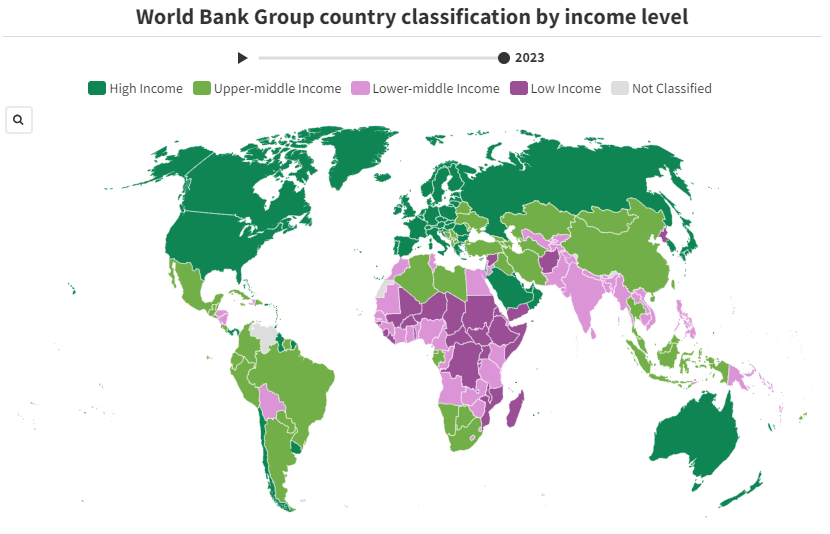
The classification of countries into income categories has evolved significantly over the period since the late 1980s. In 1987, 30% of reporting countries were classified as low-income and 25% as high-income countries. Jumping to 2023, these overall ratios have shifted down to 12% in the low-income category and up to 40% in the high-income category.
The scale and direction of these shifts, however, varies a great deal between world regions. Here are some regional highlights:
The long-term goal of many countries is to move up the economic development ladder. Some factors conducive to economic growth include a reliable banking system, a strong stock market, and government policies to encourage investment and competition while discouraging corruption. It’s also important that a country have a strong infrastructure—its systems of communications (telephone, Internet, television, newspapers), transportation (roads, railways, airports), energy (gas and electricity, power plants), and social facilities (schools, hospitals). These basic systems will help countries attract foreign investors, which can be crucial to economic development.
If every nation used the same currency, international trade and travel would be a lot easier. Of course, this is not the case. The United Nations currently recognizes 180 currencies that are used in 195 countries across the world. Some currencies you’ve heard of, such as the British pound; others are likely unknown to you, such as the manat, the official currency of Azerbaijan. If you were in Azerbaijan you would exchange your Canadian dollars for Azerbaijan manats. The day’s foreign exchange rate will tell you how much one currency is worth relative to another currency and so determine how many manats you will receive. If you have traveled abroad, you already have personal experience with the impact of exchange rate movements.
One of the more difficult aspects of doing business globally is dealing with vast differences in legal and regulatory environments. Canada, for example, has an established set of laws and regulations that provide direction to businesses operating within its borders. But because there is no global legal system, key areas of business law—for example, contract provisions and copyright protection—can be treated in different ways in different countries. Companies doing international business often face many inconsistent laws and regulations. To navigate this sea of confusion, Canadian business people must know and follow both Canadian laws and regulations and those of nations in which they operate.
Business history is filled with stories about North American companies that have stumbled in trying to comply with foreign laws and regulations. Laws change as well over time. For example, the government in the Netherlands made working from home a legal right. This means companies can expect requests from employees to work remotely, therefore, companies should develop a work from home policy outlining the factors they will consider when an employee makes a request.
One approach to dealing with local laws and regulations is hiring lawyers from the host country who can provide advice on legal issues. Another is working with local business people who have experience in complying with regulations and overcoming bureaucratic obstacles.
One Canadian law that creates unique challenges for Canadian firms operating overseas is the Corruption of Foreign Public Officials Act (CFPOA), which prohibits the distribution of bribes and other favors in the conduct of business. Despite the practice being illegal in Canada, such tactics as kickbacks and bribes are business-as-usual in many nations. According to some experts, Canadian business people are at a competitive disadvantage if they’re prohibited from giving bribes or undercover payments to foreign officials or business people who expect them. In theory, because the Corruption of Foreign Public Officials Act warns foreigners that Canadians can’t give bribes, they’ll eventually stop expecting them.
Where are business people most likely and least likely to encounter bribe requests and related forms of corruption? Transparency International reports on corruption and publishes an annual Corruption Perceptions Index that rates the world’s countries. Transparency International annually rates nations according to “perceived corruption” and defines corruption as “the abuse of entrusted power for private gain.” A score of 100 would be perfect (corruption free) and anything below 30 establishes that corruption is rampant. In 2023, Canada scored 76/100 on the Corruption Perceptions Index, ranking 12/180 countries. Top-scoring countries also tend to have well-functioning justice systems, stronger rule of law and political stability.
Ranked as the least corrupt country was Denmark, ranking 1/180 and scoring 90/100, followed by Finland, New Zealand, Norway, Singapore, and Sweden. The most corrupt countries include Somalia, ranked 180/180, followed by Venezuela, Syria, South Sudan, Yemen, and North Korea.
Transparency International reports on corruption and publishes an annual Corruption Perceptions Index that rates the world’s countries. A score of 100 would be perfect (corruption free) and anything below 30 establishes that corruption is rampant.

The debate about the extent to which countries should control the flow of foreign goods and investments across their borders is as old as international trade itself. Trade controls are policies that restrict free trade, and governments continue to control trade. To better understand how and why, let’s examine a hypothetical case. Suppose you’re in charge of a small country in which people do two things—grow food and make clothes. Because the quality of both products is high and the prices are reasonable, your consumers are happy to buy locally made food and clothes. But one day, a farmer from a nearby country crosses your border with several wagonloads of wheat to sell. On the same day, a foreign clothes maker arrives with a large shipment of clothes. These two entrepreneurs want to sell food and clothes in your country at prices below those that local consumers now pay for domestically made food and clothes. At first, this seems like a good deal for your consumers: they won’t have to pay as much for food and clothes. But then you remember all the people in your country who grow food and make clothes. If no one buys their goods (because the imported goods are cheaper), what will happen to their livelihoods? And if many people become unemployed, what will happen to your national economy? That’s when you decide to protect your farmers and clothes makers by setting up trade rules. Maybe you’ll increase the prices of imported goods by adding a tax to them; you might even make the tax so high that they’re more expensive than your homemade goods. Or perhaps you’ll help your farmers grow food more cheaply by giving them financial help to defray their costs. The government payments that you give to the farmers to help offset some of their costs of production are called subsidies. These subsidies will allow the farmers to lower the price of their goods to a point below that of imported competitors’ goods. What’s even better is that the lower costs will allow the farmers to export their own goods at attractive, competitive prices.
Canada has a long history of subsidizing farmers. Subsidy programs guarantee farmers (including large corporate farms) a certain price for their crops, regardless of the market price. This guarantee ensures stable income in the farming community but can have a negative impact on the world economy. How? Critics argue that in allowing Canadian farmers to export crops at artificially low prices, Canadian agricultural subsidies permit them to compete unfairly with farmers in developing countries. A reverse situation occurs in the steel industry, in which a number of countries—China, Japan, Russia, Germany, and Brazil—subsidize domestic producers. U.S. trade unions charge that trade subsidy practices gives an unfair advantage to foreign producers and hurts American industries, which can’t compete on price with subsidized imports.
The top exports of Canada in 2022 were Crude Petroleum ($123B), Cars ($29.4B), Petroleum Gas ($24.3B), Refined Petroleum ($17.2B), and Gold ($14.7B), exporting mostly to United States ($438B), China ($25.4B), Japan ($14.3B), United Kingdom ($12.9B), and Mexico ($7.39B). The top imports of Canada are Cars ($31.9B), Refined Petroleum ($19.8B), Motor vehicles; parts and accessories (8701 to 8705) ($17.4B), Delivery Trucks ($17.3B), and Crude Petroleum ($16.8B), importing mostly from United States ($308B), China ($62.1B), Mexico ($22.2B), Germany ($14.1B), and Japan ($9.87B). So, if Canada imported $308B from the United States and exported $438B to the United States, Canada achieved a positive trade balance of $130B.
Whether they push up the price of imports or push down the price of local goods, such initiatives will help locally produced goods compete more favorably with foreign goods. Both strategies are forms of trade controls—policies that restrict free trade. Because they protect domestic industries by reducing foreign competition, the use of such controls is often called protectionism. Though there’s considerable debate over the pros and cons of this practice, all countries engage in it to some extent. Before debating the issue, however, let’s learn about the more common types of trade restrictions: tariffs, quotas, and embargoes.
Tariffs are taxes on imports. Because they raise the price of the foreign-made goods, they make them less competitive. Tariffs are also used to raise revenue for a government. Donald Trump, President of The United States, for example, announced in March of 2018 that the U.S. would increase tariffs on imported steel products from 10% to 25% as a means of enhancing the American steel industry and protecting U.S steel manufacturers.
A quota imposes limits on the quantity of a good that can be imported over a period of time. Quotas are used to protect specific industries, usually new industries or those facing strong competitive pressure from foreign firms. Canadian import quotas take two forms. An absolute quota fixes an upper limit on the amount of a good that can be imported during the given period. A tariff-rate quota permits the import of a specified quantity and then adds a high import tax once the limit is reached.
Sometimes quotas protect one group at the expense of another. For example, let us assume that a hypothetical country restricts the number of mangoes imported. If the demand for mangoes in the country is 27,000 pounds and the current international market price for one pound of mangoes is $1.35. Upon introducing an import quota, the country imposes restriction and allows importing only 18000 pounds of mangoes. When this happens, it hikes the domestic price to $1.89 per pound of mangoes. At this price, the domestic farmers of the country can afford to increase their production from 4000 to 9000 pounds. At the same time, at the price of $1.89 per pound, the country’s demand for mangoes declines to 25000 pounds. In this example, the restriction helps domestic mango farmers increase production and decrease demand through price regulation.
Another example, the wheat export quota implemented by India has prompted Nepal’s flour industry to adapt and innovate. It was introduced in response to concerns about reduced wheat production due to heatwaves in India, but it has spurred resilience in Nepali flour mills. Nepal, which primarily sources wheat from India, initially received a partial quota allocation, leading to concerns about potential price increases. In response to this situation, calls have been made for the Nepali government to engage in constructive dialogue with India to secure 200,000 tonnes of wheat, which could help mitigate potential shortages. While the initial quota allocation did offer some relief by reducing flour prices, industry leaders are now advocating for a comprehensive, long-term solution, recognizing that domestic production alone may not suffice to meet the demand.
An extreme form of quota is the embargo, which, for economic or political reasons, bans the import or export of certain goods to or from a specific country.
A common political rationale for establishing tariffs and quotas is the need to combat dumping: the practice of selling exported goods below the price that producers would normally charge in their home markets (and often below the cost of producing the goods). Usually, nations resort to this practice to gain entry and market share in foreign markets, but it can also be used to sell off surplus or obsolete goods. Dumping creates unfair competition for domestic industries, and governments are justifiably concerned when they suspect foreign countries of dumping products on their markets. They often retaliate by imposing punitive tariffs that drive up the price of the imported goods.
Opinions vary on government involvement in international trade. Proponents of controls contend that there are a number of legitimate reasons why countries engage in protectionism. Sometimes they restrict trade to protect specific industries and their workers from foreign competition—agriculture, for example, or steel making. At other times, they restrict imports to give new or struggling industries a chance to get established. Finally, some countries use protectionism to shield industries that are vital to their national defense, such as shipbuilding and military hardware.
Despite valid arguments made by supporters of trade controls, most experts believe that such restrictions as tariffs and quotas—as well as practices that don’t promote level playing fields, such as subsidies and dumping—are detrimental to the world economy. Without impediments to trade, countries can compete freely. Each nation can focus on what it does best and bring its goods to a fair and open world market. When this happens, the world will prosper, or so the argument goes. International trade is certainly heading in the direction of unrestricted markets.
Many organizations work to remove barriers to trade, and an increasing number of countries are coming together to foster trade and shared economic benefits. Lowering trade barriers helps businesses source materials and products from more affordable international suppliers, reducing production costs and boosting competitiveness. For example, when China lowered its trade barriers, it made cheaper goods available to businesses worldwide, resulting in lower prices for consumers globally. Additionally, the reduction of tariffs and quotas allows businesses to tap into larger markets, creating more sales opportunities and higher profits. A case in point is the European Union, where the removal of trade barriers among member countries enables businesses to sell products across all EU nations without incurring extra costs.
Let’s review some of the important initiatives in reducing international trade barriers.
Free trade is encouraged by a number of agreements and organizations set up to monitor trade policies. The two most important are the General Agreement on Tariffs and Trade and the World Trade Organization.
After the Great Depression and World War II, most countries focused on protecting home industries, so international trade was hindered by rigid trade restrictions. To rectify this situation, twenty-three nations joined together in 1947 and signed the General Agreement on Tariffs and Trade (GATT), which encouraged free trade by regulating and reducing tariffs and by providing a forum for resolving trade disputes. The highly successful initiative achieved substantial reductions in tariffs and quotas, and in 1995 its members founded the World Trade Organization to continue the work of GATT in overseeing global trade.
Based in Geneva, Switzerland, with nearly 150 members, the World Trade Organization (WTO) encourages global commerce and lower trade barriers, enforces international rules of trade, and provides a forum for resolving disputes. It is empowered, for instance, to determine whether a member nation’s trade policies have violated the organization’s rules, and it can direct “guilty” countries to remove disputed barriers (though it has no legal power to force any country to do anything it doesn’t want to do). If the guilty party refuses to comply, the WTO may authorize the plaintiff nation to erect trade barriers of its own, generally in the form of tariffs.
Affected members aren’t always happy with WTO actions. In 2002, for example, President George Bush’s administration imposed a three-year tariff on imported steel. In ruling against this tariff, the WTO allowed the aggrieved nations to impose counter-tariffs on some politically sensitive American products, such as Florida oranges, Texas grapefruits and computers, and Wisconsin cheese. Reluctantly, the administration lifted its tariff on steel.
A key to helping developing countries become active participants in the global marketplace is providing financial assistance. Offering monetary assistance to some of the poorest nations in the world is the shared goal of two organizations: the International Monetary Fund and the World Bank. These organizations, to which most countries belong, were established in 1944 to accomplish different but complementary purposes.
The International Monetary Fund (IMF) loans money to countries with troubled economies, such as Mexico in the 1980s and mid-1990s and Russia and Argentina in the late 1990s. There are, however, strings attached to IMF loans: in exchange for relief in times of financial crisis, borrower countries must institute sometimes painful financial and economic reforms. In the 1980s, for example, Mexico received financial relief from the IMF on the condition that it privatize and deregulate certain industries and liberalize trade policies. The government was also required to cut back expenditures for such services as education, health care, and workers’ benefits.
The World Bank is an important source of economic assistance for poor and developing countries. With backing from wealthy donor countries (such as Canada, the United States, Japan, Germany, and United Kingdom), the World Bank has committed $128.3 billion in loans, grants, and guarantees to partner countries and private businesses. Loans are made to help countries improve the lives of the poor through community-support programs designed to provide health, nutrition, education, infrastructure, and other social services.
So far, our discussion has suggested that global trade would be strengthened if there were no restrictions on it—if countries didn’t put up barriers to trade or perform special favors for domestic industries. The complete absence of barriers is an ideal situation that we haven’t yet attained. In the meantime, economists and policymakers tend to focus on a more practical question: Can we achieve the goal of free trade on the regional level? To an extent, the answer is yes. In certain parts of the world, groups of countries have joined together to allow goods and services to flow without restrictions across their mutual borders. Such groups are called trading blocs. Let’s examine two of the most powerful trading blocs—USMCA and the European Union.
USMCA is a free trade agreement between the United States, Mexico, and Canada which replaced the NAFTA free trade agreement. In April 2020, Canada and Mexico notified the U.S. that they were ready to implement the agreement. The USMCA took effect on July 1, 2020, replacing NAFTA. Each country benefits from the comparative advantages of its partners: each nation is free to produce what it does best and to trade its goods and services without restrictions.
The forty-plus countries of Europe have long shown an interest in integrating their economies. The first organized effort to integrate a segment of Europe’s economic entities began in the late 1950s, when six countries joined together to form the European Economic Community (EEC). Over the next four decades, membership grew, and in the late 1990s, the EEC became the European Union. Today, the European Union (EU) is a unique economic and political union between 27 countries that have eliminated trade barriers among themselves (Refer to the map in Figure 7.5).
The EU is more than a trading organization: it also enhances political and social cooperation and binds its members into a single entity with authority to require them to follow common rules and regulations. It is much like a federation of states with a weak central government, with the effect not only of eliminating internal barriers but also of enforcing common tariffs on trade from outside the EU. In addition, the EU also allows people to come and go freely: if you possess an EU passport, you can work in any EU nation.
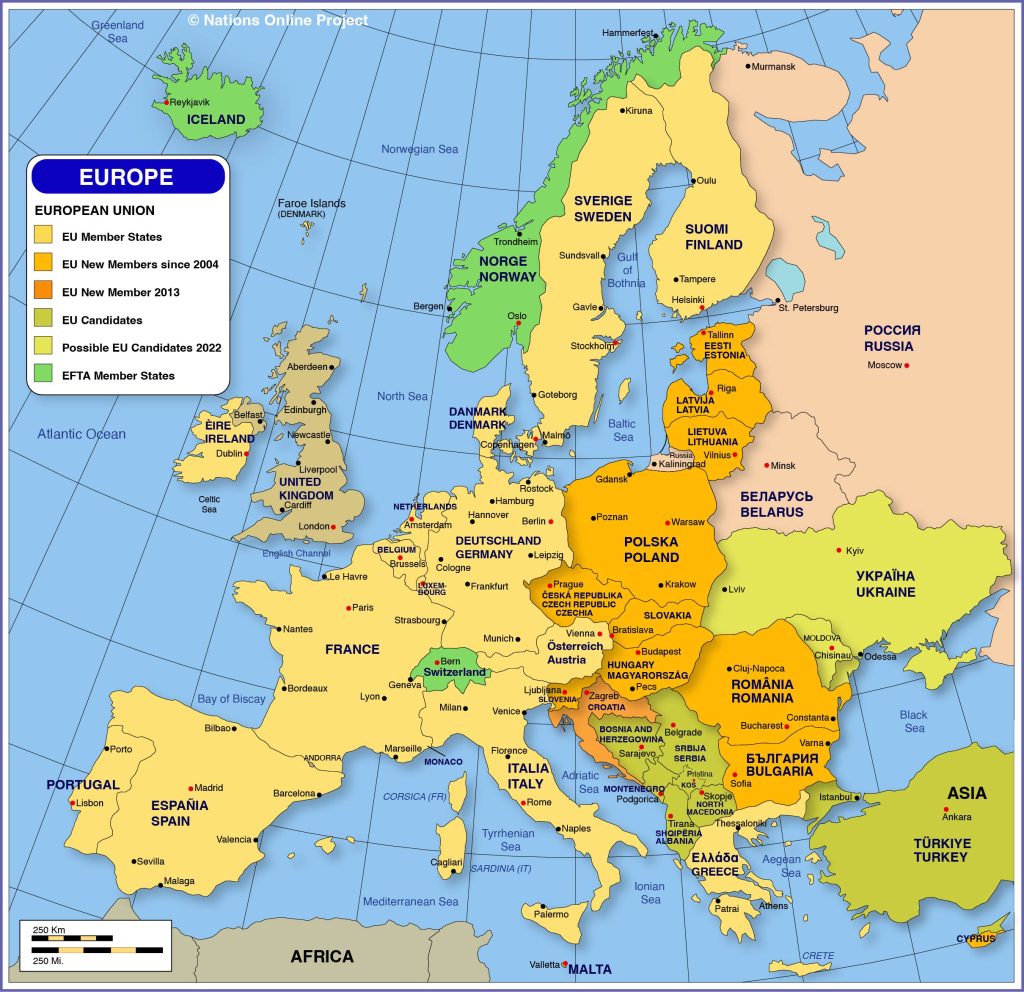
A key step toward unification occurred in 1999, when most (but not all) EU members agreed to abandon their own currencies and adopt a joint currency. The actual conversion occurred in 2002, when a common currency called the euro replaced the separate currencies of participating EU countries. The common currency facilitates trade and finance because exchange-rate differences no longer complicate transactions.
The formation of the European Union (EU) paved the way for a unified, multi-country financial system under a single currency: the euro. Most EU member nations agreed to adopt the euro but a few have decided to stick with their legacy currencies. There are 27 member countries in the European Union but six of them are not in the Eurozone and therefore don’t use the euro. Denmark is a member country but has negotiated an opt-out with the Union and it has kept its own currency. The six countries that are not in the Eurozone choose to use their own currencies as a way to maintain financial independence on certain key issues. These issues include setting monetary policy, dealing with issues specific to each country, handling national debt, modulating inflation, and choosing to devalue the currency in certain circumstances. The Euro enables trade to operate far quicker by removing the need and risk of currency exchanges when operating across eurozone countries. Currency exchanges cost money to complete and are a risk to businesses as fluctuations in rates lead to uncertainty about the cost of the exchange. Therefore, by removing this barrier, trade has flowed easier between countries.
Only time will tell whether the trend toward regional trade agreements is good for the world economy. Clearly, they’re beneficial to their respective participants; for one thing, they get preferential treatment from other members. But certain questions still need to be answered more fully. Are regional agreements, for example, moving the world closer to free trade on a global scale—toward a marketplace in which goods and services can be traded anywhere without barriers?
Canada is engaged in more recent trade agreements including the following:
Nations have grouped together to form regional trade associations for their own benefits, including the following:
Check your understanding of this chapter’s concepts by completing this short self-check quiz.
An interactive H5P element has been excluded from this version of the text. You can view it online here:
https://ecampusontario.pressbooks.pub/businessfundamentals/?p=277#h5p-28
Check your understanding of this chapter’s concepts by completing this short self-check quiz.
An interactive H5P element has been excluded from this version of the text. You can view it online here:
https://ecampusontario.pressbooks.pub/businessfundamentals/?p=277#h5p-38
The contents of this chapter is a compilation sourced from various OER resources, please refer to the Book Information for details.
(Note: This reference list was produced using the auto-footnote and media citation features of Pressbooks)
World Trade Organization. (2024, November 25). World trade statistics 2023. https://www.wto.org/english/res_e/statis_e/statistics2023_e.htm#:~:text=In%202023%2C%20world%20trade%20in,mirrors%20the%20situation%20in%202019.
World Trade Statistical Review 2023. Chapter III: Word trade and economic growth, 2022-2023. https://www.wto.org/english/res_e/booksp_e/wtsr_2023_ch3_e.pdf
Trading Economics. (n.d.). Canada exports. https://tradingeconomics.com/canada/exports#:~:text=The%20biggest%20export%20products%20are,United%20Kingdom%20(2.6%20percent).
Trading Economics. (n.d.). Canada exports by category. https://tradingeconomics.com/canada/exports-by-category
Statistics Canada. (2024, May 9). Canadian international merchandise trade: Annual review 2023. https://www150.statcan.gc.ca/n1/daily-quotidien/240509/dq240509a-eng.htm
Trading Economics. (n.d.). Canada balance of trade. https://tradingeconomics.com/canada/balance-of-trade
Buffet, W. E., & Loomis, C. (2003, November 10). America’s growing trade deficit Is selling the nation out from under us. Here’s a way to fix the problem–and we need to do it now. Fortune. http://archive.fortune.com/magazines/fortune/fortune_archive/2003/11/10/352872/index.htm
Anonymous. (2003). Why are prices in Japan so damn high? The Japan FAQ.com. http://www.thejapanfaq.com/FAQ-Prices.html
Boutique Japan. (2024, June 7). Is Japan expensive? https://boutiquejapan.com/is-japan-expensive/#:~:text=The%20truth%20is%2C%20Japan%20may,Singapore%2C%20Australia%2C%20and%20Scandinavia.
Statistics Canada. (2024, February 28). Canada’s balance of international payments, fourth quarter 2023. https://www150.statcan.gc.ca/n1/daily-quotidien/240228/dq240228b-eng.htm
Lim, J. (2021, January 4). China still owes Canada $371 million in decades-old debt. https://www.ipolitics.ca/news/china-still-owes-canada-371-million-in-decades-old-debt
The Economic Times. (2024, August 28). These countries own the most debt to China, is yours one of them? https://economictimes.indiatimes.com/news/international/us/these-countries-owe-the-most-debt-to-china-is-your-one-of-them/articleshow/112874819.cms?from=mdr
Word Population Review. (n.d.). National debt by country/countries with the highest national debt 2024. https://worldpopulationreview.com/country-rankings/countries-by-national-debt
Word Population Review. (n.d.). National debt by country/countries with the highest national debt 2024. https://worldpopulationreview.com/country-rankings/countries-by-national-debt
Fine Waters Media. (2024). Evian. https://www.finewaters.com/bottled-waters-of-the-world/france/evian%20and%20Fiji%20Water.The Water. https://www.fijiwater.com/pages/the-water
USDA. (2024). U.S. soybeans exports in 2023. https://fas.usda.gov/data/commodities/soybeans
Franchise Company. (n.d.). International franchising. https://www.franchisecompany.co.uk/international-franchising/#:~:text=Unlike%20franchising%20in%20the%20franchisor’s,master%20franchisee%20in%20that%20area%2C
Gereffi, G., & Frederick, S. (2010). The global apparel value chain, trade and the crisis: Challenges and opportunities for developing countries. World Bank Group. https://openknowledge.worldbank.org/entities/publication/5ff4813c-2109-5792-b8c0-3d7b5d8231f3
Manuel, L. (2022). Global marketing in a digital world. https://ecampusontario.pressbooks.pub/globalmarketing/chapter/6-1-international-entry-modes/
Escott, I. (2023, September 7). Strategic partnership types, benefits, & how to find partners. https://respona.com/blog/strategic-partnership/#:~:text=These%20partnerships%20can%20be%20formed,partnership%20between%20Apple%20and%20Nike.
Tesla Press Releases. (2014). Panasonic and Tesla sign agreement for the Gigafacotry. https://ir.tesla.com/press-release/panasonic-and-tesla-sign-agreement-gigafactory
Harrington, G. (n.d.). Strategic alliances: Types, benefits, and challenges. https://www.relevize.com/blog/strategic-alliances-types-benefits-and-challenges#:~:text=Strategic%20Equity%20Alliance,the%20e%2Dcommerce%20superstar%20Flipkart.
AK. (2023, June 20). Analysis of the Walmart-flipkart deal. https://aklegal.in/analysis-of-the-walmart-flipkart-deal/
Hindustan Times. (2018, May 10). Walmart buys 77% stake in Flipkart: Key reasons why the mega deal matters. https://www.hindustantimes.com/business-news/walmart-buys-77-stake-in-flipkart-key-reasons-why-the-mega-deal-matters/story-vbonsBNFcPQ0rHycQWhJsI.html
Fortune. (n.d.). Fortune global 500 ranking 2024. https://fortune.com/ranking/global500/
Nakata, H. (2024, March 8). IBM’s tech advances driven by leadership, collaboration. https://sustainable.japantimes.com/unraveling/23
UX24/7. (2022, December 29). Product adaptation in foreign markets (with examples). https://ux247.com/product-adaptation-in-foreign-markets-with-examples/
UX24/7. (2022, December 29). Product adaptation in foreign markets (with examples). https://ux247.com/product-adaptation-in-foreign-markets-with-examples/
Sakurada. (2021, February 24). Unique Coca-Cola flavors in Japan. https://gowithguide.com/blog/unique-coca-cola-flavors-in-japan-276
UX24/7. (2022, December 29). Product adaptation in foreign markets (with examples). https://ux247.com/product-adaptation-in-foreign-markets-with-examples/
UX24/7. (2022, December 29). Product adaptation in foreign markets (with examples). https://ux247.com/product-adaptation-in-foreign-markets-with-examples/
UX24/7. (2022, December 29). Product adaptation in foreign markets (with examples). https://ux247.com/product-adaptation-in-foreign-markets-with-examples/
UX24/7. (2022, December 29). Product adaptation in foreign markets (with examples). https://ux247.com/product-adaptation-in-foreign-markets-with-examples/
Pettinger, T. (2019, May 30). Multinational corporations: Good or bad? https://www.economicshelp.org/blog/538/economics/multinational-corporations-good-or-bad/
Pettinger, T. (2019, May 30). Multinational corporations: Good or bad? https://www.economicshelp.org/blog/538/economics/multinational-corporations-good-or-bad/
Pettinger, T. (2019, May 30). Multinational corporations: Good or bad? https://www.economicshelp.org/blog/538/economics/multinational-corporations-good-or-bad/
More, H. (2024, November 24). Criticism of multinational companies. https://thefactfactor.com/facts/management/international-business/criticism-of-multinational-companies/22151/
More, H. (2024, November 24). Criticism of multinational companies. https://thefactfactor.com/facts/management/international-business/criticism-of-multinational-companies/22151/
More, H. (2024, November 24). Criticism of multinational companies. https://thefactfactor.com/facts/management/international-business/criticism-of-multinational-companies/22151/
Metreau, E., Young, E., & Eapen, S. (2024, July 1). World bank country classifications by income level for 2024-2025. https://blogs.worldbank.org/en/opendata/world-bank-country-classifications-by-income-level-for-2024-2025
Metreau, E., Young, E., & Eapen, S. (2024, July 1). World bank country classifications by income level for 2024-2025. https://blogs.worldbank.org/en/opendata/world-bank-country-classifications-by-income-level-for-2024-2025
Sawe, B. (2018, June 28). How many currencies exist in the world? https://www.worldatlas.com/articles/how-many-currencies-are-in-the-world.html
Owen-Jones, J. (2024, August 12). The Netherlands is making work from home a legal right: What does this mean for Dutch companies? https://www.deel.com/blog/the-netherlands-is-making-work-from-home-a-legal-right/
Transparency International. (2023). Our work in Canada. https://www.transparency.org/en/countries/canada
Transparency International. (2023). Corruption perceptions index. https://www.transparency.org/en/cpi/2023
OEC. (2022). Canada. https://oec.world/en/profile/country/can
WallStreetMojo. (2023, September 28). Quota. https://www.wallstreetmojo.com/quota/
WallStreetMojo. (2023, September 28). Quota. https://www.wallstreetmojo.com/quota/
Becker, E. (2003, November 11). U.S. tariffs on steel are illegal, World Trade Organization says. http://www.nytimes.com/2003/11/11/business/us-tariffs-on-steel-are-illegal-world-trade-organization-says.html?pagewanted=all
Sanders, B. (1998, July/August). The International Monetary Fund is hurting you. http://www.thirdworldtraveler.com/IMF_WB/IMF_Sanders.html
IFC. (2023). World Bank Group 2023 summary results. https://www.ifc.org/en/insights-reports/annual-report-2023/world-bank-group-summary-results
Lobosco, K. (2020, July 1). NAFTA is officially gone. Here’s what has and hasn’t changed. https://www.cnn.com/2020/07/01/politics/usmca-nafta-replacement-trump/index.html
European Commission on Economic, and Financial Affairs. (2015). Why the Euro? http://ec.europa.eu/economy_finance/euro/why/index_en.htm
Seth, S. (2023, December 4). Why these European countries don’t use the Euro. https://www.investopedia.com/articles/investing/050515/why-these-european-countries-dont-use-euro.asp
Manning, R. (2020, July 7). Global and regional trade systems. https://www.atlanticcouncil.org/in-depth-research-reports/issue-brief/global-and-regional-trade-systems/
Government of Canada. (n.d.). Canada-UK trade continuity agreement explained. https://www.international.gc.ca/trade-commerce/trade-agreements-accords-commerciaux/agr-acc/cuktca-acccru/trade-agreement-explained.aspx?lang=eng
MercoPress. (2023, April 10). Mercosur, Canada to resume trade deal talks. https://en.mercopress.com/2023/04/10/mercosur-canada-to-resume-trade-deal-talks
8
After reading this chapter, you should be able to do the following:
When you consider the functional areas of business—accounting, finance, management, marketing, and operations—marketing is the one you probably know the most about. After all, as a consumer and target of all sorts of advertising messages, you’ve been on the receiving end of marketing initiatives for most of your life. What you probably don’t appreciate, however, is the extent to which marketing focuses on providing value to the customer. According to the American Marketing Association, “Marketing is the activity, set of institutions, and processes for creating, communicating, delivering, and exchanging offerings that have value for customers, clients, partners, and society at large.”

In other words, marketing isn’t just advertising and selling. Marketing encompasses every part of a plan to turn a prospective consumer into a happy and satisfied customer. It includes everything from market research to advertising. The goal of marketing is to convince a person that your product is worth investing in, establish brand loyalty and increase overall sales. It includes everything that organizations do to satisfy customer needs, including:
Think about a typical business—a local movie theater, for example. It’s easy to see how the person who decides what movies to show is involved in marketing; they select the product to be sold. It’s even easier to see how the person who puts ads in the newspaper works in marketing; they are in charge of advertising—making people aware of the product and getting them to buy it. What about the ticket seller and the person behind the counter who gets the popcorn and soda or the projectionist? Are they marketing the business? Absolutely. The purpose of every job in the theater is satisfying customer needs, and as we’ve seen, identifying and satisfying customer needs is what marketing is all about. Marketing is a team effort involving everyone in the organization.
If everyone is responsible for marketing, can the average organization do without an official marketing department? Not necessarily: most organizations have marketing departments in which individuals are actively involved in some marketing-related activity—product design and development, pricing, promotion, sales, and distribution. As specialists in identifying and satisfying customer needs, members of the marketing department manage, plan, organize, lead, and control the organization’s overall marketing efforts.
Knowledge of consumer buying behaviour and the influences on the consumer’s buying decision are critical to effective marketing.
The consumer buying process involves five steps:
The five step consumer decision-making process is part of a broader environmental context that influences each step. Effective marketing attempts to help consumers with their information search and the evaluation of alternatives, but there are other major influences on a consumer’s buying decision. These influences are listed below:
The marketing concept is a business philosophy where the organization’s goals are achieved by identifying customer needs and delivering value more effectively than competitors.
The nature of marketing has evolved over the years.
The most important thing to remember about the marketing concept is that it is consumer-centric, meaning, it puts the customer first. Everyone in the organization must work to satisfy consumer needs while still being able to balance organizational needs. The company must ensure that it is profitable so that the organization can survive and grow.
When ChatGPT was asked for a few examples of how companies apply the marketing concept, the AI provided results for Apple, Pantagonia, Shopify and lululemon.
An interactive H5P element has been excluded from this version of the text. You can view it online here:
https://ecampusontario.pressbooks.pub/businessfundamentals/?p=273#h5p-21
A marketing strategy consists of two major elements: the organization must determine its target market and then develop a marketing mix to meet the needs of that market. The target market is the specific group of consumers, with similar needs and wants, toward which a firm directs its marketing efforts. A target market is the group of people who are most likely to buy your product or service. The marketing mix is the combination of four factors, known as the “4Ps” of marketing. The 4Ps are designed to serve the target market and include product, price, promotion, and place. A marketing strategy must not only define the target market, it must also define goals and outcomes, timelines, resources, and opportunities as well. For example, the Statistics Canada 2021 Census stated that 6.2 million people (more than one in six Canadians) live in the GTA (Greater Toronto Area). A business would want to segment several specific customer groups to more effectively sell to its potential target markets living in the Toronto area.
There are five steps in the marketing planning process:
Strategic marketing planning involves setting goals and objectives, analyzing internal and external business factors, product planning, implementation, and tracking your progress. Consider the example of Apple, winner of the CMO Survey Award for Marketing Excellence for the past sixteen years. Here’s an example of the five steps of the marketing planning process aligned to Apple Inc., one of the most successful companies in the world:
Mission: Apple is dedicated to making innovative, high-quality products.
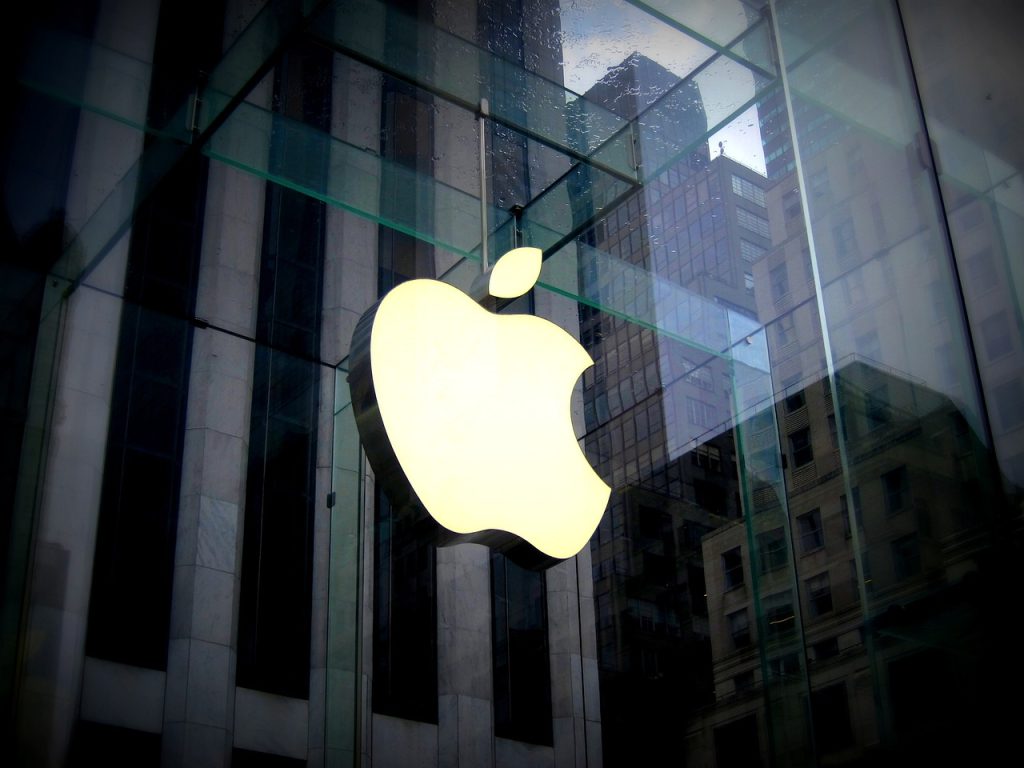
Situation Analysis: Apple’s competitive advantage is driven by its commitment to understanding customer needs, focusing on the products that are core to its mission, and fostering a collaborative work culture.
Marketing Strategy: Apple usually is first to the marketplace with new products and the company relies on brand loyalty from existing customers as a strategy when launching new products and services.
Marketing Mix: While Apple offers a range of products, it values premium pricing and relies on strict guidelines for distribution.
Implementation and Control: Each Apple product complements the others and works within the same ecosystem, so customers tend to stay with the brand, creating loyal consumers.
The strategic marketing process puts all the pieces together so that everything you do contributes to the success of the business. Rather than executing haphazard activities and ideas, developing a solid plan that weaves goals and tactics into a seamless experience is essential.
Businesses earn profits by selling goods or providing services. It would be nice if everybody in the marketplace was interested in your product, but if you tried to sell it to everybody, you’d probably spread your resources too thin. You need to identify a specific group of consumers who should be particularly interested in your product, who would have access to it, and who have the means to buy it. This group represents your target market, and you need to aim your marketing efforts at its members.
How do marketers identify target markets? First, they usually identify the overall market for their product—the individuals or organizations that need a product and are able to buy it. This market can include either or both of two groups:
You might focus on only one market or both. A farmer, for example, might sell blueberries to individuals on the consumer market and, on the industrial market, to bakeries that will use them to make muffins and pies.
The next step in identifying a target market is to divide the entire market into smaller portions, or market segments—groups of potential customers with common characteristics that influence their buying decisions. You can use a number of characteristics to segment a market including demographic, geographic, behavioral, and psychographic. Demographic and geographic segmentation are quite common. To read more about each type of segmentation review the examples below.
Let’s look at these types of segmentation in detail.
An interactive H5P element has been excluded from this version of the text. You can view it online here:
https://ecampusontario.pressbooks.pub/businessfundamentals/?p=273#h5p-22
Typically, marketers determine target markets by combining, or “clustering,” segmenting criteria. What characteristics does Starbucks look for in marketing its products? Three demographic variables come to mind: age, geography, and income. Buyers are likely to be of any gender, ranging in age from about twenty-five to forty (although college students, aged eighteen to twenty-four, are moving up in importance). Geography is a factor as customers tend to live or work in cities or upscale suburban areas. Those with relatively high incomes are willing to pay a premium for Starbucks specialty coffee and so income—a socioeconomic factor—is also important.

After identifying a target market, your next step is developing and implementing a marketing program designed to reach it. This program involves a combination of tools called the marketing mix, often referred to as the “4P’s” of marketing:
There are other models used for the marketing mix. One of which is the SAVE model, which stands for Solution, Access, Value, and Education. Unlike the initial 4Ps this idea promotes and advertises different virtues that fit productively in today’s marketing industry. Solution replaces product, access replaces place, value replaces price, and education replaces promotion. SAVE could potentially be a modern adaptation or evolution of this traditional framework. Another model is the 4Cs model, which stands for Customer, Cost, Convenience, and Communication. This is a contemporary marketing framework that expands on the conventional 4Ps paradigm. The 4Cs framework was proposed as a customer-centric alternative to the 4Ps, concentrating on the customer’s perspective and demands.
We will focus on the 4Ps Marketing Mix for the time being.
There are many things that are involved in product development. The first step starts with coming up with an idea. It’s important to remember that when it comes to this first “P” of the marketing mix, the term “product” refers to both products and services.
New product development teams often consist of top management, and specialists from sales and marketing, research and development, manufacturing, and finance. This team will conduct market research and gather customer and employee feedback before formulating ideas for new products. The team will also evaluate the feasibility of ideas, consider the resources available, and identify risks. This group considers and plans new and improved products following the seven stages of new product development:
Once a product is developed, it begins the product life cycle. A product life cycle is a theoretical model describing a product’s sales and profits over the course of its lifetime. During this cycle the product typically goes through four stages: an introductory stage, a growth stage, a maturity stage, and a declining stage. Refer to Table 8.1 for a summary of the characteristics, marketing objectives, and strategies for each of the four stages of a product’s life cycle.
| Characteristics | Introduction | Growth | Maturity | Decline |
|---|---|---|---|---|
| Sales | Low sales | Radically rising sales | Peak sales | Declining sales |
| Costs | High cost per customer | High cost per customer | Low cost per customer | Low cost per customer |
| Profits | Negative | Rising | High | Declining |
| Customers | Innovators | Innovators | Middle majority | Laggards |
| Competitors | Few | Growing number | Stable number beginning to decline | Declining number |
| Marketing Objectives | Create product awareness and trial | Maximize market share | Maximize profit while defending market share | Reduce expenditure and milk the brand |
| Product Strategy | Offer a basic product | Offer product extensions, services, warranty | Diversify brands and models | Phase out weak items |
| Price Strategy | Charge cost-plus | Price to penetrate market | Price to match or beat competitors | Cut prices |
| Distribution Strategy | Build selective distribution | Build intensive distribution | Build more intensive distribution | Go selective; phase out unprofitable outlets |
| Advertising Strategy | Build product awareness among early adopters and dealers | Build awareness and interest in the mass market | Stress brand differences and benefits | Reduce to level needed to retain hard-core loyals |
| Sales Promotion Strategy | Use heavy sales promotion to entice trial | Reduce to take advantage of heavy customer demand | Increase to encourage brand switching | Reduce to minimal level |
At its core, circular economy aims to minimize waste, reduce environmental impact, and maximize the value of products and materials throughout their lifecycle. In the realm of marketing, companies often take a linear approach, where content creation follows a ‘use and discard’ mentality. This approach leads to the proliferation of content that may not be sustainable or aligned with long-term planetary goals.

Circular business models offer an alternative that shifts the focus from selling products to providing and preserving value, whether through traditional sales or innovative circular services and activities, such as repair or resale. Kantar’s 2022 Global Issues Barometer found that 64% of people believe businesses have a responsibility to solve climate and environmental problems. And they match that belief with action, spending more with brands that can find ways to eradicate waste and pollution while still offering the essentials of value and convenience.
Circular solutions can impact a business in many of the same ways, including a company’s philosophy, purpose, and values; its sourcing of raw materials; product and packaging design; production procedures; and even its chosen business model. Since branding and circular solutions affect similar aspects of a business, they must be aligned to ensure a consistent business strategy. If a company starts implementing circular economy solutions, they must be incorporated into its core values and overall brand strategy. Likewise, if sustainability and corporate social responsibility are fundamental pillars of a brand strategy, then the circular economy can be a great way to implement these values and deliver the brand’s promise to consumers.
A circular economy offers a clear pathway to deliver, while also offering opportunity to build brand growth and business resilience. By embracing circular models, brands can tap into new revenue streams, reduce costs, and strengthen customer relationships. The future of marketing could well be circular.
Market research is the process of gathering, analyzing, and interpreting information about a market, product, service, and customers. It helps companies understand their customers, competitors, and industry, and make strategic decisions about marketing and selling.
Once a business has an idea for a new product or service, the next step is to figure out who is going to buy it. If we use the example of potential consumers in the Greater Toronto Area, we know they will not all buy what the business has to sell. How does the company determine how to market to specific groups of consumers effectively? That’s where market research can help. Conducting market research will help the company find out what its consumer profile looks like.
The term market research refers to the process of evaluating the viability of a new service or product through research conducted directly with potential customers. It allows a company to define its target market and get opinions and other feedback from consumers about their interest in a product or service. Research may be conducted in-house or by a third party that specializes in market research. It can be done through surveys and focus groups, among other ways. Test subjects are usually compensated with product samples or a small stipend for their time.
Questions the company needs answers to include the following:
This data had to be collected in a systematic way. Market research seeks two types of data:
The company may use secondary data when researching the market. Secondary data usually refers to information that has been collected, processed, and published by someone else, although it can come from inside or outside the organization. Internally available data includes sales reports and other information on customers. External data can come from a number of sources. Here is a list of secondary data examples:

Google Trends can be a valuable tool for gathering secondary data. It provides insights into the popularity of search terms over time, across regions, and in specific categories, making it useful for understanding market trends, consumer interests, and geographic patterns. Google Trends is an excellent starting point for secondary market research, especially when paired with other data sources for a well-rounded analysis.
Explore Google Trends – What are people in Canada Searching for Right Now?
Explore Google Trends – What are people in the USA Searching for Right Now?
Explore Google Trends – What are people in Finland Searching for Right Now?
Explore Google Trends – What are people in India Searching for Right Now?
Explore Google Trends – What are people in the World Searching for Right Now?
By using these resources, businesses can gain a comprehensive understanding of their market without the need for direct primary research. Gathering secondary data is usually less costly than gathering primary data because the data is already available. Companies can save time by accessing existing data rather than conducting primary research. Secondary data also provides insights into industry-wide trends and historical data. It does have some disadvantages: data may not answer specific questions or fit unique needs of a company, it may be outdated and not reflect the current market, and competitors also have access to secondary data (or much of it).
Secondary research is ideal when looking for a quick, cost-effective understanding of broader market conditions, trends, or context.
Primary research involves collecting firsthand data directly from the source, tailored to specific needs. There are a variety of tools for collecting primary data is data gathered by the company firsthand, including:
Focus Groups. Focus groups involve getting a group of people together who fit the consumer profile and asking them questions about the company’s product or service and taking note of their thoughts. Usually, the company will need to pay people to participate in the focus group. With a focus group, you can bring together a group of individuals (perhaps six to ten) and ask them questions. A trained moderator can explain the purpose of the group and lead the discussion. If sessions are run effectively, you can come away with valuable information about customer responses to both your product and your marketing strategy.
Observations. It’s important to note that while an independent facilitator is asking the questions of consumers in observation; representatives from the market research team are behind a two-way mirror observing consumer behaviour. Observations may also take place by observing consumers in action, such as buying groceries or electronics. Observations sometimes include home visits to observe consumers using the product.
Surveys. Surveys are done through questionnaires, they can be mailed to the target market; the challenge with it is that the response rate is usually low. Businesses may offer coupons or other incentives to entice consumers to complete the survey. Sometimes marketers mail questionnaires to members of the target market. The process is time consuming and the response rate generally low. Online surveys are easier to answer and so get better response rates than other approaches.
Interviews. Interviews are a good method as market researchers can take the time to talk to people about their thoughts about the product or service; they can demonstrate how the product or service works and they can get real-time feedback. Though time consuming, personal interviews not only let you talk with real people but also let you demonstrate the product. You can also clarify answers and ask open-ended questions.
Experiments. Experiments in primary research involve testing specific variables or conditions to observe outcomes and gather data directly relevant to the research question. They are structured studies designed to establish cause-and-effect relationships. Experiments are widely used in scientific research but are also valuable in business contexts, such as marketing, product development, and operations. For example, assume a retailer wants to understand how price changes affect product demand. Products are sold at varying prices across different regions or time frames. The retailer can identify the price range that maximizes revenue without significantly reducing sales volume.
While gathering primary data may be more time consuming (designing, collecting, analyzing) and more expensive (panning, execution, analysis) than gathering secondary data, it has its advantages. Primary research allows the company to customize the questions to gather specific data. It provide current information. It has exclusive ownership, data collected is proprietary to the company. Primary research also requires skilled personnel for accurate data collection and interpretation.
Primary research is best when a business requires detailed, specific, and proprietary insights to solve unique challenges or validate hypotheses. Combining both types of research is ideal. Start with secondary research to gain a foundational understanding and guide the focus of primary research. Secondary research can help identify gaps or areas requiring in-depth exploration, which primary research can address.
Brand strategy is “The entire experience your prospects and customers have with your company, product or service. Your brand strategy defines what you stand for, a promise you make, and the personality you convey.”
Branding is an essential tool for marketing. Consumers relate so strongly to brands that you can show them just the brand logo and they know everything about the brand. Visit the World’s Most Recognizable Brand Logos to see if you can recognize the company with their brand logo.
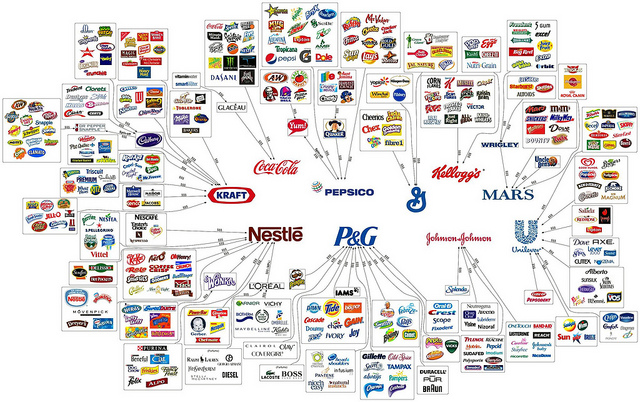
Below is a list of some brands that have become so popular they are used to refer to common products. For example:
Try this interactive exercise related to company brands. Using the dialog cards in the exercise try to answer each question, then flip the card over to read the answer.
An interactive H5P element has been excluded from this version of the text. You can view it online here:
https://ecampusontario.pressbooks.pub/businessfundamentals/?p=273#h5p-19
Companies can adopt one of three major strategies for branding a product:
Refer to Table 8.2 for a comparison of differences between branding strategies.
| Aspect | Private Branding | Generic Branding | Manufacturer Branding |
|---|---|---|---|
| Ownership | Retailer | No brand owner focus | Manufacturer |
| Cost Positioning | Mid-tier or budget-friendly | Lowest price | Mid to premium |
| Marketing Investment | Moderate to low | Minimal | High |
| Examples | Kirkland, great value | “No Name” labels | Coca-Cola, Nike |
Branding is used in hotels to allow chains (Marriott, Hyatt, Hilton) to offer hotel brands that meet various customers’ travel needs while still maintaining their loyalty to the chain. The same customer who would choose an Extended Stay hotel with a full kitchen when on a long term assignment might stay at a convention hotel when attending a trade show and then stay in a resort property when traveling with their family. By segmenting different types of hotel locations, amenities, room sizes and décor, hotel chains can meet the needs of a wide variety of travelers. In the past decade “soft” branding has become common to allow unique hotels to take advantage of being part of a chain reservation system and loyalty program. For example, Marriott has over 100 affiliated independent hotels in its Autograph Collection. Loyalty programs are heavily used in the hospitality industry, especially airlines and hotels, as part of their Customer Relationship Management programs. Loyalty programs are often targeted to high value business travelers with less price sensitivity. They achieve loyalty status and perks while traveling as well as earning points to use for personal travel rewards. Once a loyalty program member obtains elite status with significant associated perks such as guaranteed room availability, airport club lounge access, etc., the customer is much less likely to use other brands.
When consumers have a favorable experience with a product, it builds brand equity. If consumers are loyal to it over time, it enjoys brand loyalty. To get an idea of how valuable brand equity is, think for a moment about the effect of the name Dell on a product. When you have a positive experience with a Dell product—say, a laptop or a printer—you come away with a positive opinion of the entire Dell product line and will probably buy more Dell products. Over time, you may even develop brand loyalty: you may prefer—or even insist on—Dell products. Not surprisingly, brand loyalty can be extremely valuable to a company.
Each branding strategy suits specific market needs, allowing businesses to cater to varying consumer priorities, such as cost, trust in brand, or exclusivity.
Packaging can influence a consumer’s decision to buy a product or pass it up. Packaging gives customers a glimpse of the product, and it should be designed to attract their attention, with consideration given to color choice, style of lettering, and many other details.
Labelling not only identifies the product but also provides information on the package contents: who made it and where or what risks are associated with it (such as being unsuitable for small children).
Packaging and labelling can provide many benefits for companies, including:
The second P in the four Ps of marketing is price. Naturally, the company needs to price its products in a way that allows it to operate profitably. However, pricing is far more complex than calculating the cost of goods and adding on an additional amount that will let the business meet its desired profit margin.
Price is the only element of the marketing mix that directly generates revenue for a company. It’s also the most flexible element, and it’s important to continuously monitor and revise it.
When determining price, marketers consider a number of factors, including:
Marketers may also use pricing strategies like:
Cultural artistic expression revitalizes and reaffirms the heritage of Indigenous peoples in Canada. The distribution of authentic Arts and handicrafts are methods in which Indigenous populations can preserve their cultural identity. A global marketplace for Indigenous Arts, handicrafts, and tourism was built on the widespread interest of Indigenous cultures, which is a necessary tool for alleviating socio-economic hardship. Due to this rise in popularity of Indigenous products, an entire market segment has developed where inexpensive, inauthentic, and mass-produced items are being marketed as Indigenous. As non-Indigenous companies commoditize culturally-appropriated Arts and handicrafts, they negatively impact authentic Indigenous producers. Kat Pasquach, the owner of Culture Shock Jewelry, offers her insight into the differences between cultural appropriation and appreciation. She further describes how the time, labour, and cultural expertise of Indigenous products warrant the demand for higher prices. The reclamation of culturally significant arts and handicrafts is a crucial endeavour; one that will lead to positive social, economic, and cultural outcomes for Indigenous populations around the world.
One or more interactive elements has been excluded from this version of the text. You can view them online here: https://ecampusontario.pressbooks.pub/businessfundamentals/?p=273
In marketing, “place” is the third of the “4Ps” of marketing and refers to where and how a company sells its products to consumers:
A great deal is involved in getting a product to the place in which it is ultimately sold. If you’re a fast food retailer, for example, you’ll want your restaurants to be in high-traffic areas to maximize your potential business. If your business is selling beer, you’ll want it to be offered in bars, restaurants, grocery stores, convenience stores, and even stadiums. Placing a product in each of these locations requires substantial negotiations with the owners of the space and often the payment of slotting fees (an allowance paid by the manufacturer to secure space on store shelves).
Retailers are marketing intermediaries that sell products to the eventual consumer. Without retailers, companies would have a much more difficult time selling directly to individual consumers, no doubt at a substantially higher cost. Many retailers do not fit neatly into only one category, for example, WalMart, which began as a discount store, has added groceries to many of its outlets, also placing it in competition with supermarkets. Similarly, IKEA is a furniture retailer but also provides a place to eat, “IKEA Swedish Restaurant” within the store, placing it in competition with restaurants.
The logistics of place are all the activities required to move a product from the production line to the end user. This includes transportation, warehousing, inventory management, order processing, and selecting distribution channels. Effective logistics requires strategic planning and coordination to deliver the right product to the right place, at the right time, in the suitable condition, and at the correct cost.
Promotion is a part of the marketing mix that refers to the methods used to communicate with customers about a product or service. It involves a combination of promotional tools and techniques to reach a company’s goals. The Promotional mix is the means by which a company communicates with its customers and may include advertising, social media, email marketing, personal selling, sales promotion, public relations, and more. The goal of promotion is to create a message that resonates with customers and encourages them to purchase a product.
Before deciding on an appropriate promotional strategy, a business should consider a few questions:
To promote a product, you need to imprint a clear image of it in the minds of your target audience. What do you think of, for instance, when you hear “Ritz-Carlton”? What about “Motel 6”? They’re both hotel chains that have been quite successful in the hospitality industry, but they project very different images to appeal to different clienteles. The differences are evident in their promotions. The Ritz-Carlton website describes itself as the “gold standard” and promises that the chain provides “the finest personal service and facilities throughout the world”. Motel 6, by contrast, characterizes its facilities as “no frills ” and assures you that you’ll pay “the lowest price”.
Advertising is paid, non-personal communication designed to create an awareness of a product or company. Ads are everywhere—in print media (such as newspapers, magazines, mailers), on billboards, in broadcast media (radio and TV), and, increasingly, online. It’s hard to escape the constant barrage of advertising messages. Research on the exact number of ads the average person sees each day varies, but estimates suggest that we are exposed to anywhere from 4,000 to 10,000 ads daily. This figure includes all forms of advertising, from traditional media like TV and radio to digital platforms such as social media, search engines, and websites. You wear a GymShark T-shirt or a pair of lululemon pants while scrolling through your Facebook or Instagram feed while brushing your teeth with Crest toothpaste; and just within the first 20 minutes of your day! At some point, you start a screening process for what you engage with and you start ignoring brands and advertising messages, unless it’s something that you have a personal interest in. Even so, advertising is still the most prevalent form of promotion.
The choice of advertising media depends on the company’s product, target audience, and budget. A travel agency selling spring-break getaways to college students might post flyers on campus bulletin boards or run ads in campus newspapers. The co-founders of Sleep Country Canada found radio ads particularly effective, ingraining their catchy jingle, “why buy a mattress anywhere else?” into listeners nationwide.
Below are 15 of the most successful advertising campaigns of all time. Can you determine the product that aligns with each campaign? Try this crossword puzzle to find out.
An interactive H5P element has been excluded from this version of the text. You can view it online here:
https://ecampusontario.pressbooks.pub/businessfundamentals/?p=273#h5p-25

Personal selling refers to one-on-one communication with customers or potential customers. This type of interaction is necessary in selling large-ticket items, such as homes, and it’s also effective in situations in which personal attention helps to close a sale, such as sales of cars and insurance policies. Many retail stores depend on the expertise and enthusiasm of their salespeople to persuade customers to buy. Home Depot has grown into a home-goods giant in large part because it fosters one-on-one interactions between salespeople and customers. Best Buy has staff helping educate consumers on technical devices; the store also offers technical support through the “Geek Squad.” When you visit the Honda or Subaru dealerships to buy a vehicle you will be greeted by a sales associate who will spend time with you discussing the vehicles’ features, financing, options, etc.
It is often used in business-to-business consultations and sales. The sales pitch is tailored to each customer’s specific needs. There is a high level of personal interaction with immediate feedback. It works well in complex high-value product/service sales (e.g., real estate, custom software solutions). It is relationship driven, requires in-depth explanations or demonstrations in industries where trust is critical.
Direct marketing is a marketing approach that involves direct communication with consumers to generate a response or transaction. It does not rely on intermediaries such as retailers or advertising platforms. The company communicates directly with customers through various channels to elicit an immediate response, such as making a purchase or signing up for a service. Examples include email marketing, catalogs, or direct mail campaigns. Customer interaction is limited with no face-to-face interaction and relies on impersonal communication. It is a good choice for quick responses to promotions, reaching a broad segmented audience efficiently, or building brand awareness and driving online traffic.
Refer to Table 8.3 for a comparison of direct marketing and personal selling features.
| Feature | Direct Marketing | Personal Selling |
|---|---|---|
| Communication | One-to-many | One-to-one |
| Medium | Digital, mail, SMS, automated systems | Face-to-face or direct voice calls |
| Cost | Relatively low per contact | Higher cost due to personal effort |
| Customer engagement | Indirect, often passive | Direct, active interaction |
| Focus | Promoting offers and generating leads | Building relationships and closing sales |
| Scalability | High; can target many customers simultaneously | Low; limited by salesperson capacity |
A sales promotion is a marketing strategy that uses temporary offers or campaigns to increase sales, encourage customer loyalty, or build brand awareness. Sales promotions can include any of the following:
It’s likely that at some point, you have purchased an item with a coupon or because it was advertised as a buy-one-get-one special. If so, you have responded to a sales promotion – one of the many ways that sellers provide incentives for customers to buy. Some promotional activities are targeted directly to consumers and are designed to motivate them to purchase now. You’ve probably heard advertisers make statements like “limited time only” or “while supplies last”. If so, you’ve encountered a sales promotion directed at consumers.
Other forms of sales promotion are directed at dealers and intermediaries. Trade shows are one example of a dealer-focused promotion. Mammoth convention centres such as the Enercare Centre in Toronto host enormous events in which manufacturers can display their new products to retailers and other interested parties. At food shows, for example, potential buyers can sample products that manufacturers hope to launch to the market. Feedback from prospective buyers can even result in changes to new product formulations or decisions not to launch.
Public relations (PR) refers to managing how others see and feel about a person, brand, or company. Free publicity—say, getting the company or product mentioned or pictured in a newspaper or on TV—can often generate more customer interest than a costly ad. Consumer perception of a company is often important to a company’s success. Many companies, therefore, manage their public relations in an effort to garner favorable publicity for themselves and their products. When the company does something noteworthy, such as sponsoring a fund-raising event, the public relations department may issue a press release to promote the event. When the company does something negative, such as selling a prescription drug that has unexpected side effects, the public relations department will work to control the damage to the company. Every year, Fortune puts out its list of the World’s Most Admired Companies. In 2024, these were the top five in ranked order: Apple, Microsoft, Amazon, Berkshire Hathaway, and JPMorgan Chase. Approximately 3,700 analysts, directors and executives are polled about corporate reputation to determine the final list.

Digital marketing is promotion through digital platforms, including websites, search engines, and social media. It includes all marketing efforts using digital channels to promote products, services, or brands. Examples include search engine optimization (SEO), pay-per-click (PPC) ads, and email campaigns.
In the last several years, the popularity of social media marketing has exploded. It is a subset of digital marketing focused specifically on using social media platforms to promote brands and engage audiences. You already know what social media is — Facebook, Twitter, TikTok ads, Instagram LinkedIn, YouTube, and any number of other online sites that allow you to network, share your opinions, ideas, photos, etc. Social media marketing is the practice of including social media as part of a company’s marketing program.
The days of trying to reach customers through ads on TV, in newspapers, or in magazines are over. Most television watchers skip commercials, and few people read newspapers or magazines, and even if they do, they don’t focus on the ads.
Social media marketing can have many advantages for businesses, including:
Social media marketing can have several disadvantages, including:

Customers are the most important asset that any business has. Without enough customers, no company can survive. Firms must not only attract new customers but also retain current customers.
Here are a few facts about retaining customers:
Retaining customers is the purpose of customer-relationship management—a marketing strategy that focuses on using information about current customers to nurture and maintain strong relationships with them. The underlying theory is fairly basic: to keep customers happy, you treat them well, give them what they want, listen to them, reward them with discounts and other loyalty incentives, and deal effectively with their complaints. Do you know some companies that do a good job at retaining customers? How about Amazon, Spotify, or Starbucks? These companies seem to know how to keep customers happy.
Another advantage of keeping in touch with customers is the opportunity to offer them additional products. Amazon is a master at this strategy. When you make your first purchase at Amazon, you’re also making a lifelong “friend”—one who will suggest (based on what you’ve bought before) other things that you might like to buy. Because Amazon continually updates its data on your preferences, the company gets better at making suggestions.
Developed in-house, Amazon’s CRM software captures customer data at the point of purchase, which it uses to instantly customize its users’ online experience and get a full view of the customer journey. It learns about customer habits, improves relationships from the first purchase, and reduces returns or even cart abandonment based on the customer’s ecommerce activities.
Refer to Table 8.4 for key actions taken by Amazon, Nike, and Starbucks to retain customers.
| Amazon | Nike |
| Membership: free two-day shipping, exclusive deals, access to streaming services (Prime Video, Prime Music), and more. | Strong Brand Identity: Creates a powerful emotional connection through the “Just Do It” slogan and campaigns featuring inspiring athletes. |
| Exceptional Customer Service: Customer support, hassle-free returns, and refunds. | Product Innovation: Constantly develops cutting-edge products like Flyknit, Air Max, and self-lacing shoes. |
| Personalization: Uses data analytics to recommend products based on customer behaviour, previous purchases, and browsing history. | Customization Options: Offers personalized products through Nike By You, allowing customers to design shoes and apparel. |
| Wide Product Selection: Offers nearly everything, from books and electronics to groceries and furniture, on a single platform. | Digital Ecosystem: Integrates apps like Nike Run Club and Nike Training Club for fitness tracking and personalized coaching. |
| Competitive Pricing: Monitors and matches competitor prices, offering deals and discounts. | Direct-to-Consumer Sales: Focuses on Nike-owned stores and online platforms, reducing reliance on third-party retailers. |
| Seamless User Experience: Provides an intuitive website and app interface with features like 1-click ordering and voice shopping through Alexa. | Community Engagement: Hosts events, challenges, and local running clubs to foster community among customers. |
| Subscription Services: Options like “Subscribe & Save” for recurring orders (e.g., household items, groceries) and Kindle Unlimited for eBooks. | Sustainability Initiatives: Introduced the “Move to Zero” campaign, aiming for zero carbon emissions and zero waste. |
| Gamification and Loyalty Incentives: Reward programs like Amazon Coins for digital purchases and exclusive deals for Prime members. | Endorsements and Collaborations: Partners with top athletes (e.g., LeBron James, Serena Williams) and designers for exclusive collections. |
| Continuous Innovation: Introduces new features like Amazon Go (cashier-less shopping), drone delivery (Prime Air), and Alexa devices. | Exceptional Customer Service: Provides easy returns, exchange policies, and support across channels. |
| Community Engagement and Trust: Provides reliable customer reviews and Q&A forums, ensuring transparency. | Social Media and Digital Marketing: Engages customers through platforms like Instagram, TikTok, and Twitter with dynamic content. |
Check your understanding of this chapter’s concepts by completing this short self-check quiz.
An interactive H5P element has been excluded from this version of the text. You can view it online here:
https://ecampusontario.pressbooks.pub/businessfundamentals/?p=273#h5p-20
The contents of this chapter is a compilation sourced from various OER resources, please refer to the Book Information for details.
(Note: This reference list was produced using the auto-footnote and media citation features of Pressbooks)
American Marketing Association. (n.d.). Definition of marketing. https://www.ama.org/AboutAMA/Pages/Definition-of-Marketing.aspx
OpenAI. (2023). ChatGPT (Jan 21 version) [Large language model]. https://chat.openai.com
OpenAI. (2023). ChatGPT (Jan 21 version) [Large language model]. https://chat.openai.com
OpenAI. (2023). ChatGPT (Jan 21 version) [Large language model]. https://chat.openai.com
Weller, J. (2017, June 23). The definitive guide to strategic marketing planning. https://www.smartsheet.com/strategic-marketing-processes-and-planning
abs institute. (n.d.). The new marketing mix S.A.V.E. https://www.absinstitute.com.au/the-new-marketing-mix-s-a-v-e/#:~:text=This%20new%20framework%20stands%20for,productively%20in%20today’s%20marketing%20industry.
VisoChart. (n.d.). Difference between 4Ps and 4Cs of marketing. https://visiochart.com/blog/4ps-and-4cs-of-marketing/
Kantar. (2024, November 12). How can marketing support the circular economy? https://www.kantar.com/north-america/Inspiration/Sustainability/How-can-marketing-support-the-circular-economy
Adnrivet, M. (2023, October 16). The way forward: How the circular economy is changing the game for brands. https://www.thebrandingjournal.com/2023/01/circular-economy-branding/
Kantar. (2024, November 12). How can marketing support the circular economy? https://www.kantar.com/north-america/Inspiration/Sustainability/How-can-marketing-support-the-circular-economy
Twin, A. (2023, April 14). How to do market research, types, and example. https://www.investopedia.com/terms/m/market-research.asp
Marketingmo. (n.d). Marketing guides: Brand strategy. https://www.marketingmo.com/strategic-planning/brand-strategy/
Mertes, A. (2022, December 5). 34 brand names you casually use without even realizing they’re brand names. https://www.qualitylogoproducts.com/blog/brand-names-generic-terms/
Skripak, S. & Poff, R. (2020). Fundamentals of Business, 3rd edition. https://pressbooks.lib.vt.edu/fundamentalsofbusiness3e/chapter/chapter-14-marketing-providing-value-to-customers/
Skripak, S. & Poff, R. (2020). Fundamentals of Business, 3rd edition. https://pressbooks.lib.vt.edu/fundamentalsofbusiness3e/chapter/chapter-14-marketing-providing-value-to-customers/
Chesshir, H. (2024, June 6). Benefits of utilizing custom packaging labels. https://www.paramountglobal.com/knowledge/benefits-of-custom-packaging-labels/
University of Windsor & Ryerson University. (2022). Indigenous lifeways in Canadian business. https://ecampusontario.pressbooks.pub/indigenousbusinesstopics/chapter/chapter-1/
The Ritz-Carlton Hotel Company LLC (2024). The gold standard: About the Ritz Carlton. http://www.ritzcarlton.com/en/about/gold-standards
G6Hospitality LLC (2024). Motel6: About us/FAQs. https://www.motel6.com/en/faq.html
Adfuel Inc. (2024, June 27). The daily ad exposure: How many ads does the average person see each day? https://goadfuel.com/the-daily-ad-exposure-how-many-ads-does-the-average-person-see-each-day/#:~:text=Research%20on%20the%20exact%20number,4%2C000%20to%2010%2C000%20ads%20daily.
Simpson, J. (2022, April 14). Finding brand success in the digital world. https://www.forbes.com/sites/forbesagencycouncil/2017/08/25/finding-brand-success-in-the-digital-world/#:~:text=You%20don%20a%20Banana%20Republic,20%20minutes%20of%20the%20day!&text=Digital%20marketing%20experts%20estimate%20that,to%2010%2C000%20ads%20each%20day.
Pietroluongo, L. (2024, April 19). What are Fortune’s most admired companies in 2024? https://www.netreputation.com/what-are-fortunes-most-admired-companies-in-2024/#:~:text=In%202024%2C%20these%20were%20the%20Top%2010%20in,Wholesale%207%20Alphabet%208%20American%20Express%20More%20items
Kiniulis, M. (2021). Customer acquisition vs. customer retention: What data says? https://www.markinblog.com/customer-loyalty-retention-statistics/#:~:text=It%20costs%20up%20to%207x%20more%20to%20acquire,of%20a%20company%E2%80%99s%20business%20comes%20from%20existing%20customers.
Binns, R. (2023, February 22). Amazon CRM case study. https://www.expertmarket.com/uk/crm-systems/amazon-crm-case-study#:~:text=And%20crucially%2C%20it’s%20helped%20it,The%20Amazon%20story
9
After reading this chapter, you should be able to do the following:
Every business that produces goods or services has a specific production process. Production refers to the process of transforming inputs (such as labour, capital, and raw materials) into outputs (goods and services) that a firm wishes to sell. Refer to the production transformation process in Figure 9.1.
The decisions made in the planning stage have long-range implications and are crucial to a firm’s success. Before making decisions about the operations process, managers must consider the goals set by marketing managers. Does the company intend to be a low-cost producer and to compete on the basis of price? Or does it plan to focus on quality and go after the high end of the market? Many decisions involve trade-offs. For example, low cost doesn’t normally go hand in hand with high quality. All functions of the company must be aligned with the overall strategy to ensure success.
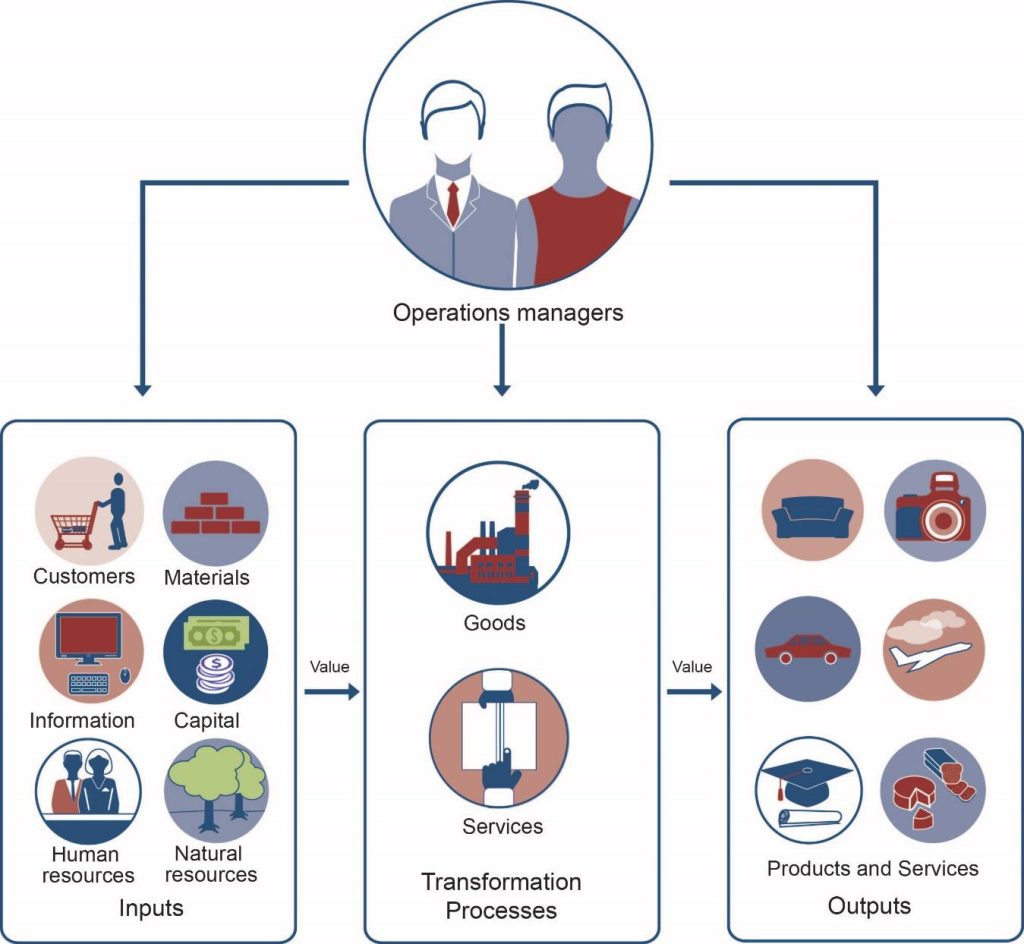
The transformation process gives the finished products and services value. Value is the customer’s perception of the benefits they receive compared to the cost or effort required to obtain the product. It is subjective and influenced by factors like branding, emotional appeal, and customer experience. The value of the product or service equals the ratio of the product’s benefit to its cost (value = benefits/costs). The price you will pay for a product or service often depends on the benefits it brings and the value it has for you. Value is about how much the product matters to the customer (subjective).
Utility refers to the inherent usefulness or the ability of a product or service to satisfy a customer’s needs and wants. It is often measurable and tied directly to functionality. Utility is about what a product can do (objective).
There are four types of utility:
Companies can enhance ownership utility by offering after-sales services, providing financing options, promoting lifestyle benefits and pride of ownership, and allowing buyers to personalize the product to enhance its appeal.
Operations Management is a vital component of any business, encompassing the practices, techniques, and tools that organizations use to produce and deliver goods and services efficiently and effectively. Whether in manufacturing or service industries, operations management plays a crucial role in building a competitive edge and driving long-term success. Employing proficient staff, ensuring operations are ethical and safe, and choosing strategic locations are important for maintaining operational excellence.
Operations management and the production process are closely intertwined, as operations management oversees and optimizes the production process to ensure efficiency, quality, and value creation.
Here’s how they relate:
In summary, operations management is the strategic framework that governs every aspect of the production process, ensuring that goods and services are produced efficiently, meet quality standards, and align with customer and market demands.
[IKEA excerpt from Chekhub, Taylor Faircloth, 2021]

Operations management is an essential part of the Swedish furniture company IKEA’s success. Its management systems have enabled the company to offer more than 9,500 products at competitive prices as it has grown over nearly eight decades. IKEA’s reputation has rested on its efficient and effective management of:
IKEA requires efficient operational management on all levels of the organization from product design, sourcing materials, and flat packing to distribution and dealing with fluctuations in demand in order to maintain its low prices. Sustaining low manufacturing or service costs through efficient operations management is what sets a successful business apart from the rest.
IKEA has strict requirements on quality, function, and cost when it comes to designing products. To reduce the price of production and distribution, the company uses a ready-to-assemble design for items in its inventory, and the flat packing method used to ship and store its products reduces consumer and manufacturing costs.
IKEA starts each design phase by first setting a price point for a particular product. To reduce waste and overall costs, the company’s standardized production process uses a limited selection of raw materials. From this selection, designers at IKEA create a product that upholds the company standards of affordability, sustainability, quality design, and functionality.
To stay ahead in such a competitive marketplace, IKEA has an extensive forecasting system to predict trends and begin production plans years in advance. The strategic allocation of production based on supplier resources and capacity allows IKEA to balance production volumes across its network of third-party manufacturers. These two factors significantly reduce the cost of production for each unit in its extensive inventory.
After production, IKEA operational management oversees the transportation of the final products to a network of 47 automated distribution centers around the globe. The well-designed system ensures cost-effective distribution to the 445 IKEA stores worldwide.
Each retail location functions as both a store and a warehouse. Each location has both an in-store logistics manager and a store goods manager who are responsible for the ordering and material handling processes, respectively. Together they work to balance customer demand and inventory management while maximizing profits. By merging retail locations with warehouse facilities and a self-service model, IKEA is able to reduce distribution and product storage costs to maintain a competitive edge.
With over 1,800 suppliers around the globe and 43 localized trading offices to maintain relationships with manufacturers, IKEA understands the importance of building strong business relationships through effective communication. To ensure that its inventory will be in stock, IKEA works side-by-side with material suppliers, manufacturers, and factory workers across their supply chain network. IKEA believes that long-term business relationships with suppliers ultimately reduce the cost of goods sold. As a high-volume global retailer, IKEA recognizes that suppliers are meaningful collaborators that add to the business’s value chain. Rather than fostering competition among suppliers, IKEA works directly with suppliers to innovate efficient, low-cost ways to bring its designs to life.
Through tight control over operational efficiencies in the design, production, supply chain, and distribution processes, IKEA has been able to keep consumer and manufacturing costs low while growing the company on a world stage. IKEA perfectly demonstrates the power and significance of operational management systems to elevate a business and optimize its workflows.
A supply chain refers to the network of individuals, organizations, resources, activities, and technologies involved in the production and distribution of a product or service. It encompasses every stage from sourcing raw materials to delivering the final product or service to the consumer.
Key Components of a Supply Chain:
Activities in the Supply Chain:
The goal of an effective supply chain is to deliver products efficiently and cost-effectively while maintaining high levels of quality and customer satisfaction. Supply chain management (SCM) is the monitoring and optimization of the production and distribution of a company’s products and services. It seeks to improve and make more efficient all processes involved in turning raw materials and components into final products and getting them to the ultimate customer. Effective SCM can help streamline a company’s activities to eliminate waste, maximize customer value, and gain a competitive advantage in the marketplace.
The supply chain and value chain are closely related concepts, but they focus on different aspects of a product’s lifecycle. The key difference lies in their focus:
Supply chain is often explained as Functional Stages (Planning, Sourcing, Manufacturing (or Production), Distribution, Returns (Reverse Logistics)): Focus on processes within the supply chain, often overlapping with multiple actors; or, as Actor-Based Stages (Supplier, Manufacturer, Distributor, Retailer, Consumer): Focus on who participates in the chain and their responsibilities. Both frameworks are complementary and can be used together to gain a comprehensive understanding of supply chains. The supply chain functions as a continuous loop, with data and insights from one stage influencing decisions in others. This integration ensures efficiency, cost-effectiveness, and customer satisfaction. In essence, the supply chain ensures delivery, while the value chain ensures desirability and worth.
The Gartner Supply Chain Top 25 releases rankings every year, and the 2023 list features a few new logos as well as businesses from years past that have sustained supply chain excellence. The compilation celebrates companies whose supply chain strategies have shown them to be purpose-driven, disruptive, and early adopters of innovative technologies. To recognize the most sustained examples of supply chain excellence, Gartner lists Amazon, Apple, Procter & Gamble, and Unilever as Supply Chain Masters—an accolade earned as a result of having attained top-five composite scores in the Gartner Supply Chain Top 25 for at least seven out of the past 10 years.
You will learn more about supply chain and value chain when you complete an operations management course. This chapter is meant to be an introduction to these concepts.
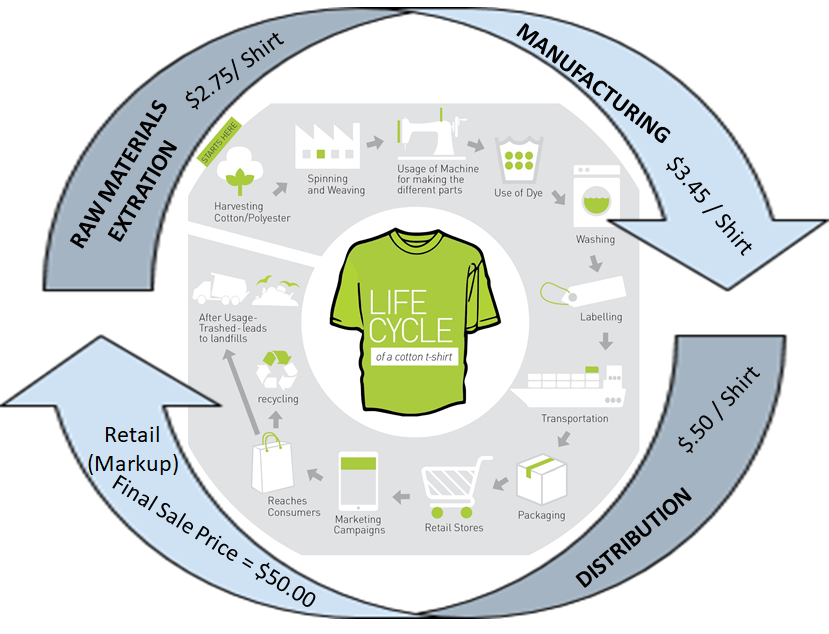
Thecircular economy represents a paradigm shift from the traditional linear model of “take-make-dispose” to a regenerative approach that emphasizes the restoration and regeneration of products, materials and energy. It challenges conventional metrics of value creation and encourages manufacturers to design products and business models with durability, repairability and recyclability in mind. Through recycling, part harvesting and remanufacturing, repair, refurbishment and recommerce circular economy principles can reduce dependency on scarce resources and component suppliers, building adaptable and resilient supply chains.
For manufacturers, this means ensuring parts and materials within their control never unintentionally exit their sphere of influence. By retaining control over the lifecycle of products, materials and components, manufacturers can prevent resource loss, ensure efficient reuse, enable capitalization of circular practices and reduce their environmental impact. Companies like IKEA focus on product design and production processes that can be easily disassembled or recycled at the end of their life cycle. IKEA’s operations focus on sourcing sustainable materials and creating products that contribute to a circular supply chain. Patagonia has implemented circular supply chain practices by offering repair services for products and encouraging customers to return old items for recycling or resale, contributing to a circular flow of materials.
What fashion consumption habits have been generating in terms of waste is alarming. The global clothing and textile industry is responsible for nearly 100 million metric tons (110,231,131 short tons or 220,462,262,185 pounds!) of waste every year – a figure that could jump by at least 50% by 2030.
Despite the lessons from the digital revolution, many companies continue to focus primarily on refining their existing products and services for their current customer base. But this approach overlooks the transformative potential of the circular economy, which, like the internet in the late 1990s, stands poised to redefine how businesses create, capture and deliver value. As we approach 2030, companies that embrace this shift will lead in innovation and market share, much as early adopters of digital technologies outpaced their peers. The rest of this decade will be crucial for businesses to adapt to this new paradigm, where sustainability is no longer a choice but an essential component of success.
Play the “Creating a Circular Economy for Fashion”, YouTube video below to learn about the innovations in the fashion industry that may just help save our world. Transcript for “Creating a Circular Economy for Fashion” Video [PDF–New Tab]. Closed captioning is available on YouTube.
Operations managers manage the process that transforms inputs into outputs. Their responsibilities can be grouped as follows:
Let’s take a closer look at each of these responsibilities.
The decisions made in the planning stage have long-range implications and are crucial to a firm’s success. Before making decisions about the operations process, managers must consider the goals set by marketing managers. Does the company intend to be a low-cost producer and to compete on the basis of price? Or does it plan to focus on quality and go after the high end of the market? Many decisions involve trade-offs. For example, low cost doesn’t normally go hand in hand with high quality. All functions of the company must be aligned with the overall strategy to ensure success.
Effective production planning requires a thorough analysis of market demand, capacity capabilities, and available resources. It involves aligning production schedules with sales forecasts and considering factors such as lead times, production capacities, and resource availability. Additionally, it involves coordinating with other departments, such as procurement, logistics, and maintenance, to ensure a smooth and uninterrupted production process.
Let’s review the specific types of decisions that have to be made in the production planning process.
The first step in production planning is deciding which type of production process is best for making the goods that your company intends to manufacture. In reaching this decision, managers should answer such questions as:
One way to appreciate the nature of this decision is by comparing three basic types of processes or methods: make-to-order, mass production, and mass customization. The task of the operations manager is to work with other managers, particularly marketers, to select the process that best serves the needs of the company’s customers.
At one time, most consumer goods, such as furniture and clothing, were made by individuals practicing various crafts. By their very nature, products were customized to meet the needs of the buyers who ordered them. This process, which is called a make-to-order strategy, is still commonly used by such businesses as print or sign shops that produce low-volume, high-variety goods according to customer specifications. This level of customization often results in a longer production and delivery cycle than other approaches. It is suitable for niche markets or high-value goods (e.g., luxury yachts or custom furniture).
The advantages of make-to-order production include a lower likelihood of unsold inventory, easily adapts to specific customer requirements, and manufacturing products only after receiving customer orders.
The disadvantages of make-to-order production include higher costs due to smaller production runs and customized processes, can lead to idle production capacity if orders are low, and customers must wait for products to be made.
By the early twentieth century, a new concept of producing goods had been introduced: mass production (or make-to-stock strategy), the practice of producing high volumes of identical goods at a cost low enough to price them for large numbers of customers. Goods are made in anticipation of future demand (based on forecasts) and kept in inventory for later sale. This approach is particularly appropriate for standardized goods ranging from processed foods to electronic appliances. It generally results in shorter cycle times than a make-to-order process. This type of production also takes advantage of economies of scale, which refers to the reduced costs per unit that is realized from increased total number of units produced. It is best for high-demand products (e.g., Coca-Cola or generic clothing).
The advantages of mass production include lower per-unit costs due to economies of scale, high production rates meet large market demand quickly, and uniform quality of products due to standardized processes.
The disadvantages of mass production include limited ability to adapt to changing customer preferences, requires substantial capital for machinery and setup, and overproduction may lead to surplus stock and storage costs.

There is at least one big disadvantage to mass production: customers, as one old advertising slogan put it, can’t “have it their way.” They have to accept standardized products as they come off assembly lines. Increasingly, however, customers are looking for products that are designed to accommodate individual tastes or needs but can still be bought at reasonable prices. To meet the demands of these consumers, many companies have turned to an approach called mass customization, which combines the advantages of customized products with those of mass production.
This approach requires that a company interact with the customer to find out exactly what the customer wants and then manufacture the good, using efficient production methods to hold down costs. One efficient method is to mass-produce a product up to a certain cut-off point and then to customize it to satisfy different customers. It is ideal for industries offering personalized products (e.g., Dell’s customizable computers).
The advantages of mass customization include offering personalized products that enhance customer loyalty, helping businesses stand out in markets filled with standardized goods, and leveraging automation and modular design for greater adaptability.
The disadvantages of mass customization include generally higher unit costs compared to traditional mass production, the need for advanced technology and logistics to handle customization efficiently, and the potential for slower production speeds due to the customization process.
One of the best-known mass customizers is Nike, which has achieved success by allowing customers to configure their own athletic shoes, apparel, and equipment through “Nike By You” program. The Web has a lot to do with the growth of mass customization. Levi’s, for instance, lets customers find a pair of perfect fitting jeans then helps them personalize the jeans through the “Levi’s Tailor Shop“. Oakley offers customized sunglasses, goggles, watches, and backpacks. Mars, Inc. can make M&M’s in any color the customer wants (say, school colours) as well as add text and even pictures to the candy.
Naturally, mass customization doesn’t work for all types of goods. Most people don’t care about customized detergents or paper products. And while many of us like the idea of customized clothes, footwear, or sunglasses, we often aren’t willing to pay the higher prices they command.
Refer to Table 9.1 for a comparison of features for mass production, mass customization, and make-to-order production methods.
| Feature | Mass Production | Mass Customization | Make-to-Order |
|---|---|---|---|
| Customer Focus | Low | High | Very High |
| Cost Efficiency | Very High | Moderate | Low |
| Flexibility | Low | Moderate to High | Very High |
| Lead Times | Short | Moderate | Long |
| Production Risk | Inventory Surplus | Moderate (requires demand prediction) | Low (no overproduction) |
After selecting the best production process, operations managers must then decide where the goods will be manufactured, how large the manufacturing facilities will be, and how those facilities will be laid out.
Site selection involves measuring the needs of a new project against the merits of potential locations. In site selection, managers must consider several factors:
Managers rarely find locations that meet all these criteria. As a rule, they identify the more important criteria and aim at satisfying them. For example, Toyota Manufacturing Canada (TMMC) established one of its assembly plants in Cambridge, Ontario, after an extensive site selection process. Factors that influenced the site selection decision included skilled workforce, proximity to automotive supply chains, access to major markets (close to U.S. border), transportation infrastructure (major highways and railways), government incentives (Canadian and Ontario governments provided financial incentives and tax breaks), cost of operations (affordable), and cultural fit (high-quality manufacturing and workforce reliability aligned with Toyota’s brand image and production standards).

The facility layout is the physical arrangement of resources. The facility layout should be planned to handle materials orderly and efficiently and ensure a smooth flow of production, for instance, the distance that a work-in-progress must travel within a facility should be considered. Different manufacturing processes require different facility layouts, but these are the four common types:
A company may also choose to combine any of these layouts into a hybrid layout. To learn more about each type, refer to the end-of-chapter exercises and complete the Manufacturing Facility Layout exercise.
Now that the company has determined a location, the next decision is on the quantity of products that will be produced. Managers begin by forecasting demand for the company’s product, which isn’t easy. To estimate the number of units that is likely to sell over a given period, they have to understand the industry that they are in and estimate their likely share of the market by reviewing industry data and conducting other forms of research.
Once demand for the product has been forecasted, managers can calculate the capacity requirements of the production facility—the maximum number of goods that it can produce over a given time under normal working conditions. In turn, having calculated the capacity requirements, they are ready to determine how much investment in the plant and equipment they will have to make, as well as the number of labour hours required for the plant to produce at capacity and meet demand.
Like forecasting, capacity planning is difficult. Unfortunately, failing to balance capacity and projected demand can be seriously detrimental to the firm’s bottom line. If capacity is set too low (and so the company produces less than it should), it won’t be able to meet demand and will lose sales and customers. If capacity is set too high (and turns out more units than needed), the company will waste resources and inflate operating costs. Therefore, continuous review, the process of routinely reviewing the organization’s processes to determine where improvements can be made to increase organizational efficiency, is very important in the capacity planning process to avoid producing too much or too little.
Production control is a crucial function in operations management that ensures resources are used efficiently and effectively to meet production goals. It integrates purchasing, inventory control, and work scheduling to streamline production processes.
The process of acquiring the materials and services to be used in production is called purchasing (or procurement). For many products, the costs of materials make up about 50 percent of total manufacturing costs. Not surprisingly, materials acquisition gets a good deal of the operations manager’s time and attention.
Supplier selection is a critical aspect of purchasing. It involves choosing the best vendors to meet the company’s material or service requirements based on specific criteria. As a rule, there’s no shortage of vendors willing to supply materials, but the trick is finding the best suppliers. Operations managers must consider the following:
Use key performance indicators (KPIs) to assess potential vendors:
Importance of Strategic Supplier Selection:
In summary, the integration of efficient purchasing and careful supplier selection can significantly enhance a company’s operational performance and competitive advantage.

Technology has changed the way businesses buy things. Through modern procurement, companies use the Internet to interact with suppliers. The process is similar to the one you’d use to find a consumer good—say, a high-definition TV—over the Internet. To choose a TV, you might browse the websites of manufacturers like Sony then shop prices and buy at Amazon, the world’s largest online retailer.
If you were a purchasing manager using the Internet to buy parts and supplies, you’d follow basically the same process. You’d identify potential suppliers by going directly to private websites maintained by individual suppliers or to public sites that aggregate information on numerous suppliers. You could do your shopping through online catalogs, or you might participate in an online marketplace by indicating the type and quantity of materials you need and letting suppliers bid. Finally, just as you paid for your TV electronically, you could use a system called electronic data interchange (EDI) to process your transactions and transmit all your purchasing documents.
The Internet provides an additional benefit to purchasing managers by helping them communicate with suppliers and potential suppliers. They can use the Internet to give suppliers specifications for parts and supplies, encourage them to bid on future materials needs, alert them to changes in requirements, and give them instructions on doing business with their employers. Using the Internet for business purchasing cuts the costs of purchased products and saves administrative costs related to transactions. It’s also faster for procurement and fosters better communications.
Harley-Davidson maintains a Supplier Diversity policy for making decisions in this area of operations management. This decision area is concerned with optimizing the supply chain for the motorcycle manufacturer’s growth. The company’s policy ensures the optimal productivity and capacity of its supply chain based on the availability of a wide variety of suppliers. Success in this area of operations management depends on how policies and strategies address the bargaining power of suppliers described in the Five Forces analysis of Harley-Davidson. Also, decisions in supply chain management account for supply-related industry and market conditions, such as the trends shown in the PESTLE/PESTEL analysis of Harley-Davidson.
Outsourcing in business refers to the practice of contracting out certain business functions, tasks, or processes to external vendors or service providers, rather than handling them in-house. This strategy is commonly employed by companies to reduce costs, gain access to specialized expertise, or increase efficiency by leveraging external resources. These tasks can include activities such as customer service, manufacturing, IT support, human resources, and more. A company may decide to outsource manufacturing to a foreign country where labor costs are lower, influencing both the location of operations and the logistics required to maintain supply chains. For example, Nike has been known for outsourcing the majority of its manufacturing, choosing to locate production in countries like Vietnam, China, and Indonesia. This allows Nike to focus on its product design and marketing while relying on external partners for labor-intensive tasks. This outsourcing model significantly impacts both its product/service strategy and supply chain decisions.
Some reasons companies outsource include:
While outsourcing provides numerous advantages, it also has some disadvantages, including:
Outsourcing has become an increasingly popular option among manufacturers. For one thing, few companies have either the expertise or the inclination to produce everything needed to make a product. Today, more firms, want to specialize in the processes that they perform best (core function)—and outsource the rest. Companies also want to take advantage of outsourcing by linking up with suppliers located in regions with lower labour costs. Outsourcing can be local, regional, or even international, and companies can outsource everything from parts for their products, like automobile manufacturers do, to complete manufacturing of their products, like Nike and Apple do. Apple outsources the production of certain components (like chips or displays) to specialized manufacturers, enhancing both product quality and innovation.
If a manufacturer runs out of the materials it needs for production, then production stops. In the past, many companies guarded against this possibility by keeping large inventories of materials on hand. It seemed like the thing to do at the time, but it often introduced a new problem—wasting money. Companies were paying for parts and other materials that they wouldn’t use for weeks or even months, and in the meantime, they were running up substantial storage and insurance costs. If the company redesigned its products, some parts might become obsolete before ever being used.
Most manufacturers have since learned that to remain competitive, they need to manage inventories more efficiently. This task requires that they strike a balance between two threats to productivity: losing production time because they’ve run out of materials and wasting money because they’re carrying too much inventory. The process of striking this balance is called inventory control, and companies now regularly rely on a variety of inventory-control methods.
One method is called just-in-time (JIT) production: the manufacturer arranges for materials to arrive at production facilities just in time to enter the manufacturing process. Parts and materials don’t sit unused for long periods, and the costs of “holding” inventory are significantly cut. JIT, however, requires considerable communication and cooperation between the manufacturer and the supplier. The manufacturer has to know what it needs and when. The supplier has to commit to supplying the right materials, of the right quality, at exactly the right time. An example in retail: A grocery store uses JIT systems to replenish stock based on sales data from its point-of-sale system, reducing waste of perishable items.
A software tool called material requirements planning (MRP), relies on sales forecasts and ordering lead times for materials to calculate the quantity of each component part needed for production and then determine when they should be ordered or made. The detailed sales forecast is turned into a master production schedule (MPS), which MRP then expands into a forecast for the needed parts based on the bill of materials for each item in the forecast. A bill of materials is simply a list of the various parts that make up the end product. The role of MRP is to determine the anticipated need for each part based on the sales forecast and to place orders so that everything arrives just in time for production.
Tools like SAP, Oracle NetSuite, or QuickBooks help automate inventory tracking and analysis. An example in the manufacturing sector, a car manufacturer maintains a safety stock of critical components to avoid production halts due to supply chain disruptions. An example in the manufacturing sector: A car manufacturer maintains a safety stock of critical components to avoid production halts due to supply chain disruptions. Point-of-sales (POS) systems track everything sold during a given time and provides information on how much of each item should be kept in inventory.
To control the timing of all operations, managers set up schedules: they select jobs to be performed during the production process, assign tasks to work groups, set timetables for the completion of tasks, and make sure that resources will be available when and where they’re needed. There are a number of scheduling techniques. We’ll focus on two of the most common graphical tools—Gantt and PERT charts.
A Gantt chart, named after the designer, Henry Gantt, is an easy-to-use graphical tool that helps operations managers determine the status of projects. Let’s say that you’re in charge of making the “hiking bear” offered by the Toronto Teddy Bear Company. Figure 9.3 below shows a Gantt chart for the production of one hundred of these bears. It shows that several activities must be completed before the bears are dressed: the fur has to be cut, stuffed, and sewn; and the clothes and accessories must be made. Our Gantt chart tells us that by day six, all accessories and clothing have been made. The sewing and stuffing, however (which must be finished before the bears are dressed), isn’t scheduled for completion until the end of day eight. As operations manager, you’ll have to pay close attention to the progress of the sewing and stuffing operations to ensure that finished products are ready for shipment by their scheduled date.
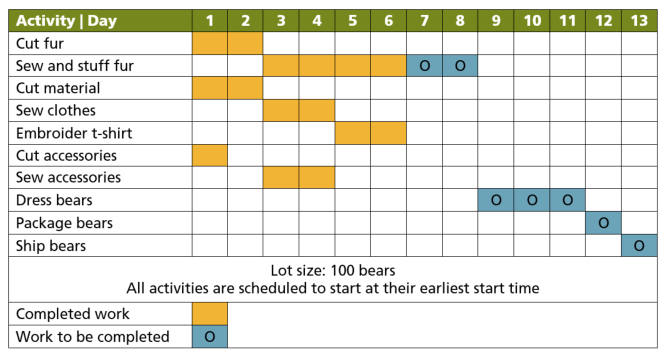
Gantt charts are useful when the production process is fairly simple and the activities aren’t interrelated. For more complex schedules, operations managers may use PERT charts. PERT (which stands for Program Evaluation and Review Technique) is designed to diagram the activities required to produce a good, specify the time required to perform each activity in the process, and organize activities in the most efficient sequence. It also identifies a critical path: the sequence of activities that will entail the greatest amount of time. Figure 9.4 below is a PERT diagram showing the process for producing one “hiker” bear at Toronto Teddy Bear.
Our PERT chart shows how the activities involved in making a single bear are related. It indicates that the production process begins at the cutting station. Next, the fur that’s been cut for this particular bear moves first to the sewing and stuffing stations and then to the dressing station. At the same time that its fur is moving through this sequence of steps, the bear’s clothes are being cut and sewn and its T-shirt is being embroidered. Its backpack and tent accessories are also being made at the same time. Note that fur, clothes, and accessories all meet at the dressing station, where the bear is dressed and outfitted with its backpack. Finally, the finished bear is packaged and shipped to the customer’s house.
What was the critical path in this process? The path that took the longest amount of time was the sequence that included cutting, stuffing, dressing, packaging, and shipping—a sequence of steps taking sixty-five minutes. If you wanted to produce a bear more quickly, you’d have to save time on this path. Even if you saved the time on any of the other paths, you still wouldn’t finish the entire job any sooner: the finished clothes would just have to wait for the fur to be sewn and stuffed and moved to the dressing station. We can gain efficiency only by improving our performance on one or more of the activities along the critical path.
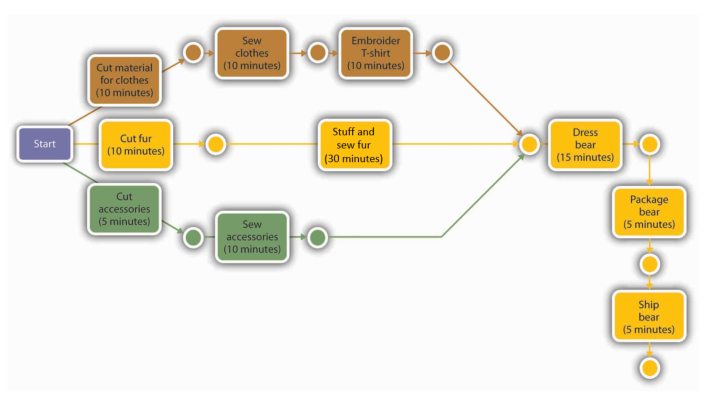
Quality is defined as the degree to which a product or service meets or exceeds customer expectations and adheres to established standards or specifications. It is a multifaceted concept that can be viewed through different lenses, such as product characteristics, customer satisfaction, and continuous improvement.
What do you do if your brand-new phone doesn’t work when you get it home? Like most people, you’d probably be more or less disgruntled. As a customer, you’re constantly assured that when products make it to market, they’re of the highest possible quality, and you tend to avoid brands that have failed to live up to your expectations or to producers’ claims. When you buy a mobile phone, you expect it to be able to easily connect and communicate. If your expectations are not met, you’ll conclude that you’re the victim of poor-quality.
Quality Control in Manufacturing is the process of ensuring that products meet predefined quality standards and specifications, helping to deliver consistent and reliable outputs. It involves systematic planning, implementation, and evaluation of processes to maintain product quality.
Key aspects of quality control include:
Examples of quality control in action, include:
Total quality management (TQM) is the continual process of detecting and reducing or eliminating errors in manufacturing. It streamlines supply chain management, improves the customer experience, and ensures that employees are up to speed with training.
A Quality Management System (QMS) is a formalized system that documents processes, procedures, and responsibilities for achieving quality policies and objectives. The QMS helps manufacturing companies coordinate and direct activities to meet customer and regulatory requirements.
The TQM strategy requires consistent feedback from employees and customers to determine how services and products can be improved across the organization and is designed to help companies find a path to strengthen their position in the market, increase productivity, improve customer loyalty and satisfaction, boost employee morale, and improve processes. Whereas many quality management strategies focus on specific departments, TQM includes every department in continually improving a company’s products and services. According to the TQM philosophy, the more you improve processes in every department, the easier it will be to deliver higher-quality products and services to customers. With TQM, everyone in the company should be focused on quality improvement with the shared goal of boosting customer loyalty and satisfaction.
Total quality management (TQM), or quality assurance, includes all the steps that a company takes to ensure that its goods or services are of sufficiently high quality to meet customers’ needs. Generally speaking, a company adheres to TQM principles by focusing on three tasks: Customer satisfaction, employee involvement, and continuous improvement. Let’s take a closer look at these three principles.
Companies that are committed to TQM understand that the purpose of a business is to generate a profit through customer satisfaction. Thus, they let their customers define quality by identifying desirable product features and then offering them. They encourage customers to tell them how to offer services that work the right way. Armed with this knowledge, they take steps to make sure that providing quality is a factor in every facet of their operations—from design to product planning and control, to sales and service. To get feedback on how well they’re doing, many companies routinely use surveys and other methods to monitor customer satisfaction. By tracking the results of feedback over time, they can see where they need to improve.
Successful TQM requires that everyone in the organization, not simply upper-level management, commits to satisfying the customer. A mobile phone isn’t solely the responsibility of the manufacturer’s quality control department; it’s the responsibility of every employee involved in its design, production, and even shipping. To get everyone involved in the drive for quality assurance, managers must communicate the importance of quality to subordinates and motivate them to focus on customer satisfaction. Employees have to be properly trained not only to do their jobs but also to detect and correct quality problems. In many companies, employees who perform similar jobs work as teams, sometimes called quality circles, to identify quality, efficiency, and other work-related problems, to propose solutions, and to work with management in implementing their recommendations.
An integral part of TQM is continuous improvement: the commitment to making constant improvements in the design, production, and delivery of goods and services. Improvements can almost always be made to increase efficiency, reduce costs, and improve customer service and satisfaction. Everyone in the organization is constantly on the lookout for ways to do things better.
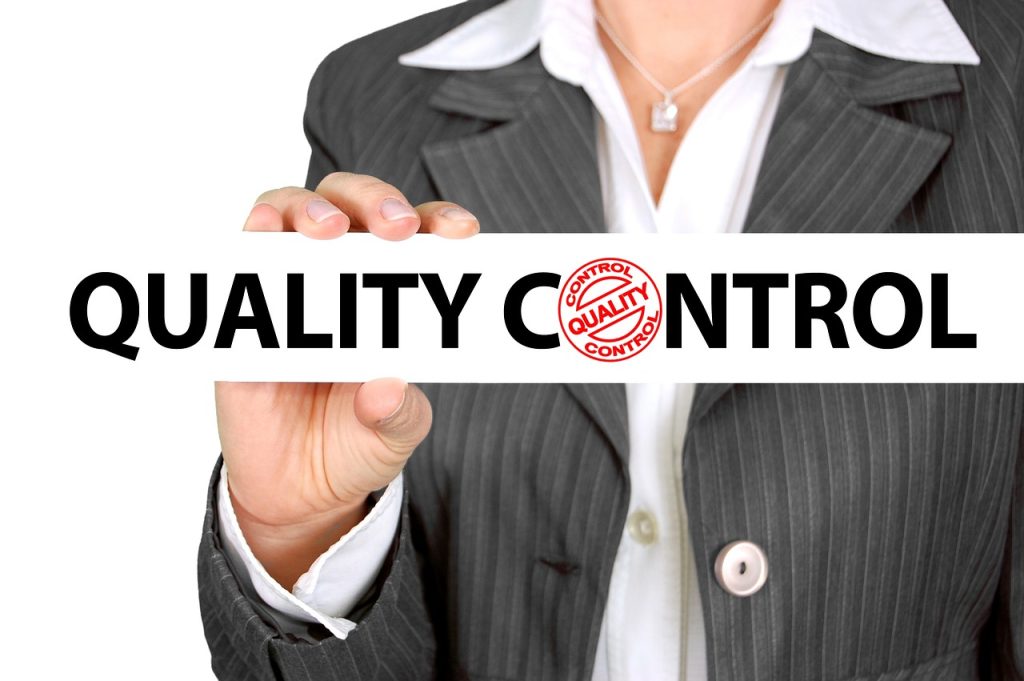
Statistical process control (SPC) is defined as the use of statistical techniques to control a process or production method. SPC tools and procedures can help you monitor process behavior, discover issues in internal systems, and find solutions for production issues. Statistical process control is often used interchangeably with statistical quality control (SQC).
Companies can use a variety of tools to identify areas for improvement. A common approach in manufacturing is called statistical process control. This technique monitors production quality by testing a sample of output to see whether goods in process are being made according to predetermined specifications. An example of a statistical process control method is Six Sigma. A Six-Sigma process is one in which 99.99966% of all opportunities to perform an operation are free of defects. This percentage equates to only 3.4 defects per million opportunities.
Assume for a moment that you work for Kellogg’s, the maker of Raisin Bran cereal. You know that it’s the company’s goal to pack two scoops of raisins in every box of cereal. How can you test to determine whether this goal is being met? You could use a statistical process control method called a sampling distribution. On a periodic basis, you would take a box of cereal off the production line and measure the amount of raisins in the box. Then you’d record that amount on a control chart designed to compare actual quantities of raisins with the desired quantity (two scoops). If your chart shows that several samples in a row are low on raisins, you’d take corrective action.
SPC is widely used in manufacturing industries to monitor and control production processes. By using tools like control charts, histograms, and Pareto charts, manufacturers can identify variations in processes, detect defects early, and improve product quality. This method is particularly effective in industries like automotive, electronics, food production, and pharmaceuticals.
Computer-aided design (CAD) and computer-aided manufacturing (CAM) are technologies that work together and are widely used across various industries to improve design, manufacturing, and production processes. These technologies represent the evolution of manufacturing from manual processes to fully automated and integrated systems, resulting in higher productivity and better-quality products.
CAD refers to the use of computer software to create, modify, analyze, or optimize a design. CAD is widely used in engineering, architecture, and product design to develop precise technical drawings and 3D models. It allows users to detail 2D and 3D models of products, parts, or structures and can test and simulate these designs under various conditions before manufacturing. Examples of CAD software include AutoCad, SolidWorks, and CATIA. When engineers design a car part (e.g., a wheel rim) using 3D modeling software.
In an automotive company CAD is when an engineer designs a car part (e.g., a wheel rim) using 3D modeling software.
CAM refers to the use of computer software and hardware to control and automate manufacturing processes. CAM takes CAD designs and converts them into instructions for machines, such as CNC (Computer Numerical Control) equipment. Examples of CAM software include Mastercam, Fusion 360, and Siemens NX.
Because CAD and CAM programs can “talk” with each other, companies can build components that satisfy exactly the requirements set by the computer-generated model. CAD/CAM systems permit companies to design and manufacture goods faster, more efficiently, and at a lower cost, and they’re also effective in helping firms monitor and improve quality. CAD/CAM technology is used in many industries, including the auto industry, electronics, and clothing. If you have ever seen how a 3-D printer works, you have a pretty good idea of how CAM works too.
In an automotive company CAM is when the design is sent to a CNC machine, which uses the instructions to precisely cut the wheel rim from a metal block.
CIM represents a comprehensive approach to manufacturing where CAD, CAM, and other business and manufacturing processes are integrated using computer systems. It enables seamless communication between design, production, and management. Examples of CIM systems include ERPs such as SAP and Oracle NetSuite, and robotics and automated assembly lines.
CIM systems expand the capabilities of CAD/CAM. In addition to design and production applications, they handle such functions as order entry, inventory control, warehousing, and shipping. In the manufacturing plant, the CIM system controls the functions of industrial robots—computer-controlled machines used to perform repetitive tasks that are also hard or dangerous for human workers to perform.
In an automotive company CIM is when the entire manufacturing process is integrated with inventory, quality control, and supply chain systems to ensure the right materials are available, defects are minimized, and production schedules are met.
Material Requirements Planning (MRP) and Enterprise Resource Planning (ERP) are interconnected systems used in modern business operations, particularly in manufacturing and supply chain management. While they serve different purposes, they are closely related and often integrated for greater efficiency. MRP is a system focused on managing the materials and components required for production. It ensures that the right materials are available at the right time to meet production schedules. Key functions include inventory control, production planning, and scheduling materials procurement. ERP is a broader, integrated system that manages and automates a company’s core business processes across multiple departments, including finance, HR, manufacturing, supply chain, sales, and customer relationship management (CRM). It often incorporates MRP as a module.
To keep up with ever-changing customer demand and rising costs, manufacturers are always looking for ways to improve operations, boost efficiency and stay competitive. But traditional methods for maintaining that competitive edge may no longer be enough in today’s world of complex global supply chains and economic uncertainty. According to Deloitte’s “2022 Manufacturing Supply Chain Study,” 76% of the over 200 manufacturing executives surveyed listed investing in digital supply chain tools as a top strategy to overcome challenges that can include shipping delays and material shortages.
The use of ERP in manufacturing companies provides several benefits: integration of centralization, data-driven decision-making, and connectivity and communication internally (all departments, locations) and externally (customers, suppliers). There are ERP systems available for manufacturing and service businesses.
An enterprise resource planning (ERP) system is a comprehensive business platform that helps businesses manage their daily operations. Manufacturing ERP systems are specifically designed for the manufacturing industry and include specialized features to address the industry’s unique challenges, such as production planning, inventory management, quality control and order tracking. These systems centralize and streamline manufacturing operations by collecting, analyzing and reporting on business wide data. Stakeholders can use this data — often through use of automation and advanced analytics tools — to improve efficiency, increase productivity and reduce costs. Manufacturers can also leverage this ERP technology to increase visibility into the entire manufacturing process to impart resilience and potentially improve profitability on the whole.
Key features of manufacturing ERP systems include:
Benefits of manufacturing ERP systems include:
Operations management in service companies and manufacturing companies differs significantly due to the nature of their outputs, processes, and customer interaction.

Though the primary function of both manufacturers and service providers is to satisfy customer needs, there are several important differences between the two types of operations. Let’s focus on three of them:
As the Canadian economy has changed from a goods producer to a service provider over the last sixty years, the dominance of the manufacturing sector has declined substantially. Today, only about 10 percent of Canadian workers are employed in manufacturing, in contrast to 30 percent in 1950. Research highlights manufacturing’s steady decline relative to the growing service sector, with automation and international trade reshaping the industry. Most of us now hold jobs in the service sector, which accounts for approximately 80 percent of Canadian jobs.
In service firms, managers typically organize their responsibilities into three key areas: planning operations, managing operations, and controlling quality. These areas help ensure the firm operates effectively and efficiently while meeting customer expectations. Let’s review these below.
Service organizations must carefully design their services to meet customer needs while ensuring efficiency. This involves selecting the right service model (e.g., self-service, direct service, or hybrid) and determining the layout of service processes to streamline operations and reduce wait times. For example, in a restaurant, the kitchen layout must optimize food preparation time while ensuring smooth customer service.
When starting or expanding operations, businesses in the service sector must make a number of decisions quite similar to those made by manufacturers:
Let’s see how service firms answer questions such as these.
When planning operations, service organizations focus on tailoring their operations processes to deliver high-quality and consistent service experiences.
Service organizations succeed by providing services that satisfy customers’ needs. Companies that provide transportation, such as airlines, have to get customers to their destinations as quickly and safely as possible. Companies that deliver packages, such as FedEx, must pick up, sort, and deliver packages in a timely manner. Companies that provide both services and goods, such as Domino’s Pizza, have a dual challenge: they must produce a quality good and deliver it satisfactorily.
Service providers that produce goods can adopt either a make-to-order or a make-to-stock approach to producing them. Subway encourages patrons to customize their sandwiches by using a make-to-order approach, building sandwiches one at a time. Although many fast food restaurants have adopted the make-to-order model, a few continue to make-to-stock. For example, Dunkin’ Donuts does not customize doughnuts, and so they do not have to wait for customer orders before making them.
Like manufacturers, service providers must continuously look for ways to improve operational efficiency.
Several years ago, many fast-food restaurants moved the drink stations from behind the counter so that customers could take over the time-consuming task of filling cups with ice and beverages. This allowed the restaurants to cut back on the number of employees needed per day at every location.

In 2024, McDonald’s decided to eliminate self-serve drink stations from its U.S. locations by 2032. The decision isn’t merely about drinks–it reflects a fundamental shift in how customers interact with restaurants today. Digital sales now represent 40% of McDonald’s total revenue, highlighting a dramatic shift toward drive-thru and delivery services. With fewer customers dining in, maintaining large self-serve drink stations has become increasingly impractical. This transformation aligns with McDonald’s vision for future restaurant designs, which may feature smaller dining areas or none at all. New automated beverage systems will mechanically fill drink orders, ensuring consistency across all ordering channels. This standardization means whether you’re ordering through the app, drive-thru, or in person, your drinking experience remains identical. Beyond adapting to changing consumer habits, this shift brings several operational advantages. The removal of self-serve stations helps maintain cleaner dining areas and reduces maintenance requirements. The transition period until 2032 allows franchisees ample time to adapt their operations and implement new systems gradually. This methodical approach ensures minimal disruption to daily operations while maintaining customer satisfaction.
This shift represents part of a broader industry trend. Other major chains like Chick-fil-A and Taco Bell are also experimenting with new service models that emphasize efficiency and automation. These changes reflect an industry-wide movement toward more streamlined operations that better serve modern consumer preferences.
When starting or expanding a service business, owners and managers must invest a lot of time in selecting a location, determining its size and layout, and forecasting demand. A poor location or a badly designed facility can deter customers, and inaccurate estimates of demand for products can result in poor service, excessive costs, or both.
Site selection is also critical in the service industry, but not for the same reasons as in the manufacturing industry. Service businesses need to be accessible to customers. Some service businesses, such as cable-TV providers, package-delivery services, and e-retailers, go to their customers. Many others, however—hotels, restaurants, stores, hospitals, and airports—have to attract customers to their facilities. These businesses must locate where there’s a high volume of available customers. In picking a location, service companies perform a detailed analysis of demographics and traffic patterns; the number of people that pass by a specific location in the course of a day. In Canada, where we travel almost everywhere by car, so it would make sense for service businesses to look for busy intersections, highway interchanges with easy off and on ramps, or such “primary destinations” as shopping malls, tourist attractions, downtown business areas, or movie theaters. In Europe, where public transportation service firms might focus on subway, train, bus, and trolley stops.
Once planners find a site with an acceptable traffic count, they apply other criteria. It must, for example, be easy for vehicles to enter and exit the site, which must also provide enough parking to handle projected dine-in business. Local zoning must permit standard signage, especially along major highways. Finally, expected business must be high enough to justify the cost of the land and building; and future projections of economic growth (expansion) should be positive.
In the service sector, most businesses must design their facilities with the customer in mind: they must accommodate the needs of their customers while keeping costs as low as possible. It may be more convenient for a hospital to place its freight elevators in the center of the building, for example, but doing so may block the flow of patients, visitors, and medical personnel between floors and departments. The layout of a fast-food restaurant can help the employees involved in different parts of the process–preparing the food and serving customers–to work in a more integrated fashion. For example, the placement of prepared orders, ready for packaging, is near the front counter and drive-thru staff, to make it easier for these staff to pick up the order, put it in a bag or on a tray, and deliver it to the customer.
Service organizations often design operations to adapt quickly to changing demands. For example, a call center may scale its workforce during promotions or crisis situations.
As mentioned previously, there are four main types of facility layouts: process, product, fixed-position, cellular. A company may also choose to combine any of these layouts into a hybrid layout. To learn more about each type, refer to the end-of-chapter exercises and complete the Service Facility Layout exercise.
Estimating capacity needs for a service business isn’t the same thing as estimating those of a manufacturer. Service providers can’t store their products for later use: hairdressers can’t “inventory” haircuts, and amusement parks can’t “inventory” roller-coaster rides. Service firms have to build sufficient capacity to satisfy customers’ needs on an “as-demanded” basis. Like manufacturers, service providers must consider many variables when estimating demand and capacity:
Since services are often produced and consumed simultaneously, capacity planning is crucial. Service managers need to ensure that there is adequate staffing, equipment, and space to meet customer demand without overburdening employees or creating excess capacity. For instance, call centers may adjust staffing based on forecasted call volumes.
Forecasting demand is easier for companies that have a long history of planning facilities than for brand-new service businesses. Existing companies can predict sales for a new restaurant by combining its knowledge of customer-service patterns at existing restaurants with information collected about each new location, including the number of cars or people passing the proposed site and the effect of nearby competition.
Overseeing a service organization puts special demands on managers, especially those running firms, such as hotels, retail stores, and restaurants, who have a high degree of contact with customers. Service firms provide customers with personal attention and must satisfy their needs in a timely manner. This task is complicated by the fact that demand can vary greatly over the course of any given day. Managers, therefore, must pay particular attention to employee work schedules and, in many cases, inventory management.
Managing service operations is about more than efficiency of service. It is about finding a balance between profitability, innovation, customer satisfaction and associate satisfaction, sometimes referred to as the balanced scorecard. The balance scorecard model utilizes 360 degree feedback, a process of collecting feedback from all of a business’s stakeholders, in order to improve operational efficiency.
Moment of Truth marketing refers to the type of marketing that takes place at the moment when a customer interacts with a product, brand, or service, and forms or changes their impression about it. Moments can range from calling a help line, checking in at an airline counter, the greeting from a hostess in a restaurant to having a maintenance problem resolved in a hotel guest room. The quality of staff a company hires, how they train their employees, and the focus management places on creating a culture of service will determine how successful the company is in service delivery and maximizing the impact of these moments of truth. Employee performance directly impacts service delivery, so effective training and engagement are key. Service organizations invest in training programs to ensure employees understand customer expectations and are equipped to handle diverse situations.
Both of the following companies emphasize the importance of investing in their employees’ training to ensure excellent service, which is a key differentiator in their respective industries.
RBC is renowned for its commitment to customer service excellence. The bank offers comprehensive training to its employees through its “Customer First” programs, which are designed to ensure that employees at all levels understand and meet customer needs. They emphasize skills like active listening, problem-solving, and delivering personalized service. RBC has been recognized for its exceptional customer service in the banking industry, contributing to its reputation as a customer-centric financial institution. Additionally, RBC has won various awards for customer satisfaction and service quality over the years.
The Keg is another Canadian company famous for its customer service. Known for its high-quality food and friendly atmosphere, The Keg invests significantly in employee training programs that focus on delivering an exceptional dining experience. Their training includes both technical aspects (such as menu knowledge) and soft skills (like interpersonal communication and empathy), which ensures that employees can connect with guests on a personal level and provide top-notch service. The Keg’s focus on training and employee empowerment has led it to consistently rank highly for customer satisfaction in the restaurant industry.

In manufacturing, managers focus on scheduling the activities needed to transform raw materials into finished goods. In service organizations, they focus on scheduling workers so that they’re available to handle fluctuating customer demand. Restaurants, for example, will have more customers during the peak periods of breakfast, lunch, and dinner, but also the slower periods in between. If the manager schedules too many people, labour cost per sales dollar will be too high. If there aren’t enough employees, customers have to wait in lines. When that happens, some get discouraged, and even leave, and many may never come back.
Scheduling is made easier by information provided by a point-of-sale device built into many cash registers (also known as point-of-sale (POS) machines). For restaurants, the register stores data on every sandwich, beverage, and side order sold by the hour, every hour of the day, every day of the week and sends that data to a computer system that helps managers set schedules. To determine how many people will be needed for next Thursday’s lunch hour, the manager reviews last Thursday’s data, using sales revenue to determine the appropriate staffing level. Each manager can adjust this forecast to account for other factors, such as current marketing promotions or a local sporting event that will increase customer traffic.
Businesses that provide both goods and services, such as retail stores and auto-repair shops, have the same inventory control problems as manufacturers: keeping levels too high costs money, while running out of inventory costs sales. Technology, such as the point-of-sale (POS) registers make the job easier. POS systems track everything sold during a given time and provides information on how much of each item should be kept in inventory.
For fast-food restaurants, for example, it also makes it possible to count the number of burgers and buns, bags and racks of fries, and boxes of beverage mixes at the beginning or end of each shift. Because there are fixed numbers of supplies—say, beef patties or bags of fries—in each box, employees simply count boxes and multiply. In just a few minutes, the manager knows whether the inventory is correct (and should be able to see if any theft has occurred on the shift).
Operations managers must strike a balance between two threats to productivity: losing production time because they have run out of materials, and wasting money because they are carrying too much inventory. The process of striking this balance is called inventory control, and companies now regularly rely on a variety of inventory-control methods.
Service operations often rely on technology to streamline processes. For example, service organizations may implement customer relationship management (CRM) systems, scheduling software, or automation tools to improve efficiency. Integrating technology helps reduce errors, improve customer interactions, and facilitate communication across departments.
Outsourcing is by no means limited to the manufacturing sector. Service providers also outsource many of their non-core functions. Some universities, for instance, outsource functions such as food services, maintenance, bookstore sales, printing, grounds keeping, security, and even residence operations. For example, there are several firms, like RGIS, who offer inventory services. They will send a team to your company to count your inventory for you. As RGIS puts it, “Our teams expertly deliver complete solutions needed to complete a wide variety of retail projects of all sizes, allowing your team to keep customer service as the number one priority.” Some software developers outsource portions of coding as a cost-saving measure. If you’ve ever had to get phone or chat assistance on your laptop, there’s a good chance you spoke with someone in an outsourced call centre. The centre itself may have even been located offshore. This kind of arrangement can present unique challenges in quality control as differences in accents and the use of slang words can sometimes inhibit understanding. Nevertheless, in this era of globalization, expect the trend towards outsourcing offshore to continue.
What if you were late for a test because it took you twenty minutes to get a burger and fries at a drive-through window? Like most people, you’d probably be more or less disgruntled. As a customer, you’re constantly assured that service will be of the highest possible quality, and you tend to avoid brands that have failed to live up to your expectations. When you go to a drive-through window, you expect to be served in a reasonable amount of time. If your expectations are not met, you’ll conclude that you’re the victim of poor-quality.
Quality in service businesses starts with understanding customer expectations. Service providers like hotels, restaurants, and consultancies focus on exceeding customer satisfaction by continuously improving customer interactions, responsiveness, and personalized service. This includes using customer feedback and measuring satisfaction levels through surveys and reviews.
For service businesses, employees are the core of service delivery. Regular training is essential to ensure employees have the skills and knowledge to meet customer needs and adhere to quality standards. Empowering employees to take initiative and resolve customer issues promptly is a key component of maintaining quality
Quality in service businesses is managed differently from manufacturing, but the principles of Total Quality Management (TQM) and continuous improvement still apply. The TQM concept involves all employees; when customers wait too long at a drive-through window, it’s the responsibility of a number of employees, not the manager alone.
TQM ensures quality and it also considers the customer. A good example of a company that benefited from TQM is Exxon. With the fuel business ever so competitive, Exxon felt the need to explore customer-related issues by using TQM rather than only relying on competitive pricing alone.
How Exxon Benefited from TQM:
Customer Focus: TQM encourages companies to deeply understand and address customer needs. For Exxon, this meant not only offering competitive prices but also improving the quality and reliability of their products. By involving customers in feedback loops and continuously improving based on their input, Exxon could strengthen customer loyalty.
Process Improvement: TQM emphasizes continuous improvement in processes. Exxon adopted this by analyzing and refining every part of their supply chain and operations, from sourcing raw materials to refining oil to the customer experience at their service stations. This process improvement helped to reduce waste, increase efficiency, and improve service, ultimately enhancing product quality.
Employee Involvement: TQM encourages employee involvement in decision-making and problem-solving. Exxon empowered employees at all levels to contribute ideas for improving quality, thus fostering a culture of quality and teamwork. This involvement helped to identify root causes of issues and implemented solutions more effectively.
While pricing may drive initial purchases, customers are more likely to return to a brand that provides a consistent, high-quality experience. By focusing on TQM, Exxon was able to create a more holistic improvement in all facets of the business, which in turn increased brand loyalty and customer satisfaction.
While SPC originated in manufacturing, it is also applicable in service industries, particularly those where consistency and quality are essential, such as call centers, healthcare, and financial services. SPC in services focuses on maintaining consistent service quality and improving processes that affect customer satisfaction, such as wait times, error rates, or customer complaints. For example, in a call center, SPC could be used to monitor the average wait time for customers, ensuring that the process remains efficient and that quality service is delivered consistently.
Just as in manufacturing, services benefit from standardized processes. For instance, fast-food chains like McDonald’s rely on standard operating procedures (SOPs) to ensure consistent product and service quality. This is particularly important in service industries that rely on repeatability, such as healthcare or education, where maintaining consistent service delivery can prevent errors.
Quality in service businesses is not static. To achieve continuous improvement, service businesses often use tools like customer satisfaction surveys, service audits, and performance evaluations. These methods allow businesses to identify gaps in service delivery, implement improvements, and monitor progress
The SERVQUAL model (Parasuraman et al., 1988) is commonly used in service industries to measure quality across five dimensions: reliability, responsiveness, assurance, empathy, and tangibles. This framework allows businesses to identify specific areas where they can improve to meet or exceed customer expectations. For example, in the hotel industry, quality is measured by guest satisfaction, cleanliness, check-in and check-out speed, and staff behavior. Hotels often employ mystery shoppers to assess the service quality and use ratings from travel websites like TripAdvisor to track performance. Hospitals and healthcare providers use quality metrics like patient satisfaction surveys, wait times, and treatment success rates to evaluate service quality. They also focus heavily on training staff, ensuring compliance with health regulations, and improving patient care processes.
Check your understanding of this chapter’s concepts by completing this short self-check quiz.
An interactive H5P element has been excluded from this version of the text. You can view it online here:
https://ecampusontario.pressbooks.pub/businessfundamentals/?p=271#h5p-23
Check your understanding of this chapter’s concepts by completing this short self-check quiz.
An interactive H5P element has been excluded from this version of the text. You can view it online here:
https://ecampusontario.pressbooks.pub/businessfundamentals/?p=271#h5p-39
The contents of this chapter is a compilation sourced from various OER resources, please refer to the Book Information for details.
(Note: This reference list was produced using the auto-footnote and media citation features of Pressbooks)
geeksforgeeks. (2024, March 27). What is operations management? Definition, purpose, benefits, and examples. https://www.geeksforgeeks.org/operations-management/
Faircloth, T. (2021, September 16). Why IKEA’s operations model is so successful. https://blog.chekhub.com/why-ikeas-operations-model-is-so-successful
Fernando, J. (2024, June 27). Supply chain management (SCM): How it works & why it’s important. https://www.investopedia.com/terms/s/scm.asp
Ross, L. & Epifano, M. (2023, November 3). The 10 best supply chain companies of 2023. https://www.thomasnet.com/insights/the-10-best-supply-chain-companies-of-2021/?msockid=15becbdd69d56a900b2ddf4168816bfa
World Economic Forum. (2024, February 27). For manufacturers, the circular economy strengthens supply chains. Here’s how. https://www.weforum.org/stories/2024/02/why-businesses-must-embrace-the-circular-economy-for-a-more-sustainable-future/
World Economic Forum. (2024, February 27). For manufacturers, the circular economy strengthens supply chains. Here’s how. https://www.weforum.org/stories/2024/02/why-businesses-must-embrace-the-circular-economy-for-a-more-sustainable-future/
Patagonia. (n.d.). Supply chain environmental responsibility program. https://www.patagonia.com/our-footprint/supply-chain-environmental-responsibility-program.html?msockid=15becbdd69d56a900b2ddf4168816bfa
World Economic Forum. (2022, May 26). Circular value chains in fashion: Strengthening trust in second hand markets. https://www.weforum.org/impact/strengthening-trust-in-second-hand-markets/
World Economic Forum. (2024, February 1). Why businesses must embrace the circular economy to build sustainable success. https://www.weforum.org/stories/2024/02/why-businesses-must-embrace-the-circular-economy-for-a-more-sustainable-future/
Financial Times. (2020, January 28). Creating a circular economy for fashion. [Video]. YouTube. https://youtu.be/y78UVWd5PHE
IE Engineer. (2024, February 12). What is production planning? Why is it important? https://ieengineer.com/what-is-production-planning-why-is-it-important/
Meyer, P. (2024, October 1). Harley-Davidson operations management & productivity. https://panmore.com/harley-davidson-operations-management-10-decisions-areas-productivity
OpenAI. (2023). ChatGPT (Jan 21 version) [Large language model]. https://chat.openai.com
Lean Outside the Box. (2024, February 18). Andon: Meaning, benefits, and examples. https://leanoutsidethebox.com/the-ultimate-guide-to-andon-meaning-benefits-and-examples/#:~:text=Toyota%20was%20the%20earliest%20manufacturer%20to%20use%20Andon,created%20by%20Sakichi%20Toyoda%2C%20the%20founder%20of%20Toyota.
Hutchinson, R. (2024, June 11). Inside Apple’s secret iPhone testing labs. https://www.geeky-gadgets.com/inside-apples-secret-iphone-testing-labs/
The Investopedia Team. (2024, June 19). What is total quality management (TQM), and why is it important? https://www.investopedia.com/terms/t/total-quality-management-tqm.asp
De Lucca Caetano, B. (2024, May 1). Quality management system (QMS) for manufacturing. https://simplerqms.com/manufacturing-quality-management-system/
CIO. (2022, January 20). What is TQM? A company-wide strategy for customer satisfaction. https://www.cio.com/article/217660/what-is-tqm-a-company-wide-strategy-for-customer-satisfaction.html
ASQ. (n.d.). What is statistical process control? https://asq.org/quality-resources/statistical-process-control
Schwarz, L. (2024, October 17). Manufacturing ERP software: A complete guide. https://www.netsuite.com/portal/resource/articles/erp/manufacturing-erp.shtml
Schwarz, L. (2024, October 17). Manufacturing ERP software: A complete guide. https://www.netsuite.com/portal/resource/articles/erp/manufacturing-erp.shtml
Schwarz, L. (2024, October 17). Manufacturing ERP software: A complete guide. https://www.netsuite.com/portal/resource/articles/erp/manufacturing-erp.shtml
Schwarz, L. (2024, October 17). Manufacturing ERP software: A complete guide. https://www.netsuite.com/portal/resource/articles/erp/manufacturing-erp.shtml
Statistics Canada. (n.d.). Trends in manufacturing employment. https://www150.statcan.gc.ca/n1/pub/75-001-x/2009102/article/10788-eng.htm
Statistics Canada. (2024). Labour force survey, February 2024. https://www150.statcan.gc.ca/n1/daily-quotidien/240308/dq240308a-eng.htm
Wright, D. (2024, November 19). Why self-serve soda stations are disappearing from McDonald’s. https://grubfeed.com/why-self-serve-soda-stations-are-disappearing-from-mcdonalds/
Wright, D. (2024, November 19). Why self-serve soda stations are disappearing from McDonald’s. https://grubfeed.com/why-self-serve-soda-stations-are-disappearing-from-mcdonalds/
RBC. (n.d.). Our company. https://www.rbc.com/our-company/index.html
The Keg. (n.d.). Our story. https://thekeg.com/en/our-story
RGIS. (n.d.). Retail. https://www.rgis.com/inventory-services/retail/
Scheid, J. (n.d.). What are some of the companies that benefit from TQM? https://www.brighthubpm.com/methods-strategies/99895-companies-that-benefited-from-tqm/
OpenAI. (2023). ChatGPT (Jan 21 version) [Large language model]. https://chat.openai.com
10
After reading this chapter, you should be able to do the following:

Chip designer and artificial intelligence juggernaut Nvidia narrowly topped Microsoft’s market capitalization to become the world’s most valuable public company, less than two weeks after it surpassed Apple’s market cap (2024). Nvidia designs and sells GPUs for gaming, cryptocurrency mining, and professional applications; the company also sells chip systems for use in vehicles, robotics, and more. Nvidia’s Compute and Networking business segment, which includes artificial intelligence (AI), is the company’s biggest revenue generator.
Apple, Nvidia, and Microsoft are the top three global companies by that measure, each with market caps of over $3 trillion. The world’s biggest companies by market capitalization are mainly tech companies, although other sectors, such as energy, financial services, and pharmaceutical, also make an appearance in the top 10. Most of these companies generate hundreds of billions of dollars in annual revenue and are highly profitable. However, there are a few exceptions, with the focus of investors being future growth potential.
These companies obviously know how to manage finances. Let’s see who will be at the top of the list next!
Without good financial controls and planning, a company will not be able to respond to unexpected challenges or planned expansion. Financial management involves the strategic planning and budgeting of short- and long-term funds for current and future needs. This may include activities such as investing, borrowing, lending, budgeting, saving, and forecasting. In most companies the finance department comprises two divisions: accounting and financial management. To remain competitive, a business must make large strategic investments such as buying or building a new factory or investing in more advanced equipment or technology. At the same time, the business must continue to pay its monthly expenses.
There are three main types of finance: personal finance, corporate finance, and government finance. In this chapter we will discuss corporate finance.
A financial manager oversees the financial operations of a company. Many financial managers have backgrounds in accounting, banking, business management, economics, or finance. In most organizations, financial managers hold mid to upper-level roles requiring multiple years of experience. They can work in the private or public sectors.
Generally, a financial manager assumes accounting responsibilities for the company and is responsible for planning and managing the company’s financial resources, including the following:
Financial managers analyze short-term and long-term money flows to optimize a firm’s profitability and make the best use of its money. This is usually done in three steps: 1) forecasting the firm’s short-term and long-term financial needs, 2) developing budgets to meet those needs, and 3) establishing financial controls to see whether the company is achieving its goals.
Forecasts predict revenue, costs and expenses for a specific future period. Short-term forecasts would include predictions for the upcoming year, while long-term forecasts would include predictions for a period longer than one year into the future. In developing forecasts, the financial manager considers many factors, including the current and anticipated changes in government regulations, consumer trends, competitor actions, changes in company goals, etc. and the impact these changes might have on the company’s financial situation.

Using forecast expectations, a financial manager creates a budget, a financial plan that outlines the company’s planned cash flows, expected operating expenses, and anticipated revenues. The master budget has two major categories: the financial budget and the operating budget. The financial budget plans the use of assets and liabilities and results in a projected balance sheet. The operating budget helps plan future revenue and expenses and results in a projected income statement. Another component of the budgeting process is the capital budget, which considers the company’s long-range plans and outlines the expected financial needs for significant capital purchases such as real estate, manufacturing equipment, plant expansions, or technology. Since capital projects are often financed with borrowed money or money raised through the sale of stocks or bonds, it is important to plan ahead to ensure that necessary funds are available when needed. During the capital budget process, each department in the organization puts together a list of its anticipated needs. Then senior management and the board evaluate these needs to determine which will best maximize the company’s overall growth and profitability.
Financial controllers are responsible for updating financial controls and overseeing all the accounting activities in an organization. Financial controls are procedures and policies that monitor and manage financial resources to prevent errors, fraud, and optimize allocation. These are used in strategic management planning. Preventive controls avoid issues, while directive controls guide actions. Internal controls ensure accurate reporting and compliance. Financial controls are regular checks of financial statements and processes. The financial statements are examined to identify losses and areas of potential losses and to reduce extravagant expenses. Financial Controls also assist in mitigating financial risks and meeting financial objectives.
Play the video below, Financial Control and Management Best Practices, to learn about these top four internal controls that reduce fraud losses and can improve detection:
The video will also mention that the Finance DPro (FMD Pro) model which includes these four fundamental, inter-linked building blocks that must be in place to ensure good practice in financial management:
Play the YouTube video below, “Financial Control and Management Best Practices” to gain an overview of what the term Finance is all about. Transcript for “Financial Control and Management Best Practices” Video [PDF–New Tab]. Closed captioning is available on YouTube.
To raise capital for business needs, companies primarily have two types of financing as an option: equity financing and debt financing. Most companies use a combination of debt and equity financing, but there are some distinct advantages to both. Equity financing carries no repayment obligation and provides extra working capital that can be used to grow a business. Debt financing, on the other hand, does not require giving up a portion of ownership. A company would choose debt financing over equity financing if it doesn’t want to surrender any part of its company. A company that believes in its financials would not want to miss out on the profits it would have to pass to shareholders if it assigned someone else equity. Which one a business needs depends on the business goals, tolerance for risk, and need for control. Many businesses in the startup stage will pursue equity financing, while those already established and those that have no problem with debt and possess a strong credit score might pursue traditional debt financing types like business loans.
Some sources of debt financing are:
The ability to secure debt financing is largely based on your existing financials and creditworthiness.
Some sources of equity financing are:
Securing equity financing can be simpler than debt financing, but you need to have an extremely attractive product or financial projections, as well as being able to surrender a portion of your company and often a good amount of control.
Refer to Table 10.1 for a list of funding sources where businesses can secure either debt or equity financing:
| Source | Description |
|---|---|
| Big Five Banks | The big banks — Chartered Banks — in Canada, including BMO, CIBC, RBC, Scotiabank, and TD Canada Trust, offer a large variety of banking products. Banks can provide loans and line of credits as well as other funding options. |
| Credit Unions | Credit unions are cooperative savings, owned by their members with common interest, who receive shares of their profits. They offer almost anything that a chartered bank offers — savings account and loans, chequing accounts, home and car loans, credit cards, and even some commercial loans. |
| Trust Companies | A trust company safeguards property — funds and estates — entrusted to it. It may serve as a trustee, transfer agent, and registrar for corporations, and provide other services as well. In recent years trust companies have declined in importance. |
| Online Banks | Online banks have significant advantages over their traditional counterparts. They have developed a business model that provides customers with the best of both worlds: low — and even no — monthly fees, along with accessible customer service administered remotely. Examples in Canada include Tangerine, EQ Bank, Neo Financial, Simplii Financial and Manulife Bank. |
| Finance Companies | Finance companies are non-deposit institutions because they do not accept deposits from individuals or provide traditional banking services, such as chequing accounts. They do, however, make loans to individuals and businesses, using funds acquired by selling securities or borrowed from chartered banks. Those that lend money to businesses, such as General Electric Capital Corporation, are commercial finance companies, and those that make loans to individuals or issue credit cards, such a PCFinancial are consumer finance companies. Some, such as General Motors Acceptance Corporation, provide loans to both consumers (car buyers) and businesses (GM dealers). |
| Insurance Companies | Insurance companies sell protection against losses incurred by illness, disability, death, and property damage. To finance claims payments, they collect premiums from policyholders, which they invest in stocks, bonds, and other assets. They also use a portion of their funds to make loans to individuals, businesses, and government agencies. Manulife is the leading Canadian life insurance company, and it has an international presence. |
| Brokerage Firms and Factoring Companies | Companies like Commercial Capital LLC, who buy and sell stocks, bonds, and other investments for clients, are brokerage firms (also called securities investment dealers). A mutual fund invests money from a pool of investors in stocks, bonds, and other securities. Investors become part owners of the fund. Mutual funds reduce risk by diversifying investment; because assets are invested in dozens of companies in a variety of industries, poor performance by some firms is usually offset by good performance by others. Mutual funds may be stock funds, bond funds, and money market funds, which invest in safe, highly liquid securities. Finally, pension funds, which manage contributions made by participating employees and employers and provide members with retirement income, are also non-deposit institutions. |
| Venture Capital Firms | Venture Capital Firms provide private equity financing or funds to start-ups, early-stage, and emerging companies that have been deemed to have high growth potential or that have demonstrated high growth. Venture capital generally comes from wealthy investors, investment banks, and any other financial institutions. However, it does not always take a monetary form; it can also be provided in the form of technical or managerial expertise. Financing new and untested venture can be risky for investors who put up funds, however, the potential for above-average returns is an attractive payoff. |
| Government Financial Institutes and Granting Agencies | The Canadian government provides government funding support to businesses across the country. This funding support comes in the form of government grants, government loans, tax breaks, tax credits and other types of financial contributions. A number of provincial agencies also provide funding to developing business firms in the hope that they will provide jobs in the province. There are both federal and provincial programs supporting the agriculture industry and providing grants to business operations. Some examples of federal agencies include: The Business Development Bank of Canada (BDC), the Government’s Export Development Corporation (EDC), the Canada Mortgage and Housing Corporation (CMHC), the Crown-Indigenous Relations and Northern Affairs Canada (CIRNAC) and Indigenous Services Canada (ISC), and Futurpreneur Canada. |
| Pension Funds | A pension fund is any plan, fund, or scheme that provides retirement income in the future to subscribers. Pension funds typically have large amounts of money to invest and are the major investors in listed and private companies. |
Short-term financing means business financing from short-term sources, which are for less than one year. There are many different types of short-term financing for businesses, these include business line of credit, working capital advance, merchant cash advance, equipment financing, bridge loans, and invoice factoring. Crowdfunding is a way of attracting investors to support your business in return for equity (a shareholding in your business) or a reward.
Long-term financing refers to borrowing or issuing equity shares for more than one year. The sources for long-term financing include equity capital, preference capital, debentures, term loans, and retained earnings. Venture capitalists often have a long-term investment horizon, allowing startups to focus on growth and development rather than short-term profitability. Venture capitalists provide business financing in return for a significant stake in the company. The percentage they want will be much higher than the percentage required on crowdfunding sites when businesses offer equity and not a reward for investing. To maintain a healthy asset-liability management (ALM) position, a company’s management should ensure a mix of short-term and long-term financing sources.
While there has been an increase in the success in the Indigenous economy, Indigenous small businesses are faced with a higher number of financial barriers than their non-Indigenous counterparts. These institutional barriers hinder Indigenous business owners from seeking financial aid through common avenues, whether through government programs or loans via centralized banks. Evidence suggests that over 50% of Indigenous entrepreneurs struggle to keep their businesses afloat due to inadequate access to debt financing. To aid FNMI businesses, Indigenous-led financial institutions such as Aboriginal Capital Corporation have been launched, though few Indigenous entrepreneurs are cognizant of their services. Indigenous entrepreneur Kat Pasquach emphasizes the importance of seizing every available option; and Sarah Hopkins-Herr, founder of Three Sisters Consulting, speaks of positive experiences when seeking financial resources to keep their businesses operational.
One or more interactive elements has been excluded from this version of the text. You can view them online here: https://ecampusontario.pressbooks.pub/businessfundamentals/?p=269
Understanding the numbers on the organization’s balance sheet can indicate its current financial position, and show whether it’s on a trajectory for success or failure. By examining its cash flow statement, a business can gain insight into how cash is being generated and used. Through reviewing its income statement, a business can gauge how the business is doing in relation to its expected performance.
Financial accounting provides information not only to internal managers, but also to people outside the organization (such as investors, creditors, government agencies, suppliers, employees, and labor unions) to assist them in assessing a firm’s financial performance.
Accountants typically work in one of two major fields. Management accountants provide information and analysis to decision makers inside the organization in order to help them run it.
The main objective of managerial accounting is to assist the management of a company in efficiently performing its functions: planning, organizing, directing, and controlling. Because the information that it provides is intended for use by people who perform a wide variety of jobs, the format for reporting information is flexible. Reports are tailored to the needs of individual managers, and the purpose of such reports is to supply relevant, accurate, timely information that will aid managers in making decisions. In preparing, analyzing, and communicating such information, accountants work with individuals from all the functional areas of the organization—human resources, operations, marketing, etc.
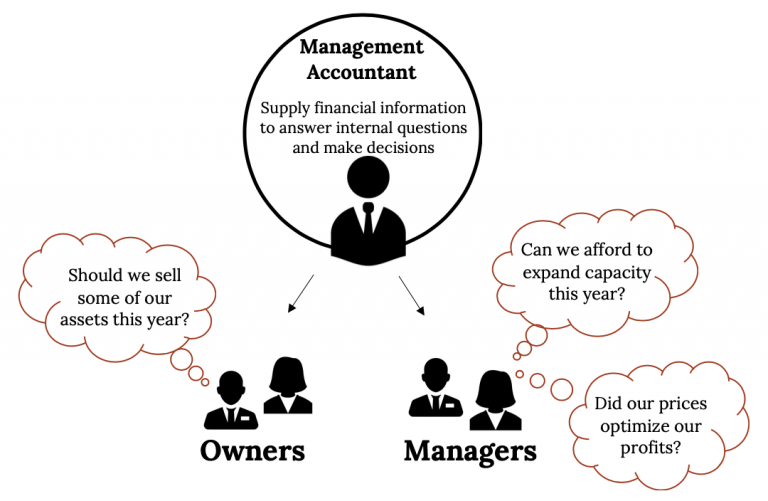
Financial accountants provide information to individuals and groups both inside and outside the organization in order to help them assess its financial performance. Their primary focus, however, is on external parties. In other words, management accounting helps you keep your business running while financial accounting tells the outside world how well you’re running it.
Financial accounting is responsible for preparing the organization’s financial statements—including the income statement, the statement of owner’s equity, the balance sheet, and the statement of cash flows—that summarize a company’s past performance and evaluate its current financial condition. If a company is traded publicly on a stock market such as the NASDAQ, these financial statements must be made public, which is not true of the internal reports produced by management accountants. In preparing financial statements, financial accountants adhere to a set of standards or guidelines, known as Generally Accepted Accounting Principles (GAAP). GAAP is used mainly by companies headquartered in the U.S., while most other countries follow the International Financial Reporting Standards (IFRS). These multinational standards, which are issued by the International Accounting Standards Board (IASB), differ from US GAAP in a number of important ways, but exploring these fine distinctions is not part of this chapter. Bear in mind, however, that, according to most experts, a single set of worldwide standards will eventually emerge to govern the accounting practices of both US and non-US companies.
As of 2011 the Canadian Accounting Standards Board (CASB) requires that all publicly accountable enterprises use the International Financial Reporting Standards (IFRS) when preparing financial statements. While IFRS is mandatory for publicly owned companies, private companies can choose to use the Canadian Generally Accepted Accounting Principles (Canadian GAAP). Users want to be sure that financial statements have been prepared according to IFRS or GAAP because they want to be sure that the information reported in them is accurate. They also know that when financial statements have been prepared by the same rules, they can be compared from one company to another.
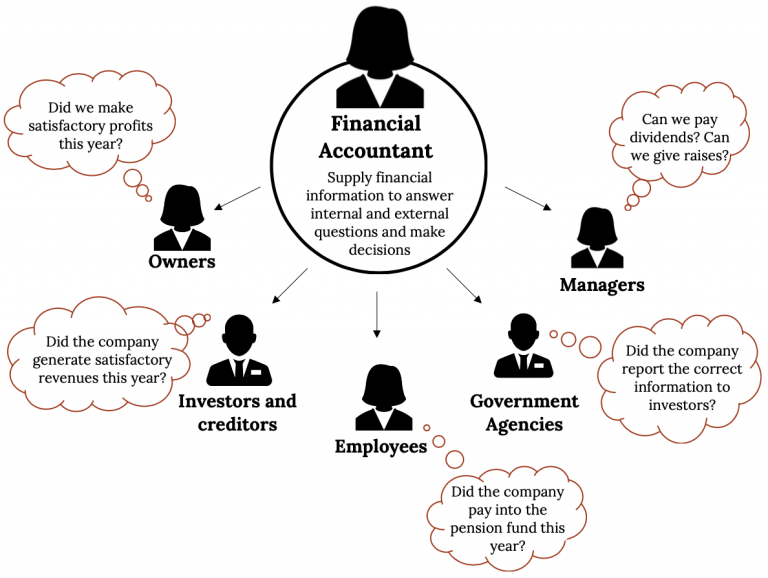
Figures 10.1 and 10.2 illustrate the main users of management and financial accounting and the types of information produced by accountants in the two areas. In the rest of this chapter, we’ll learn how to prepare a set of financial statements and how to interpret them. We’ll also discuss issues of ethics in the accounting communities and career opportunities in the accounting profession.
The users of managerial accounting information are pretty easy to identify—basically, they’re a firm’s managers. In summarizing the outcomes of a company’s financial activities over a specified period of time, financial statements are, in effect, report cards for owners and managers. They show, for example, whether the company did or didn’t make a profit and furnish other information about the firm’s financial condition. They also provide some information that managers and owners can use in order to take corrective action, though reports produced by management accountants offer a much greater level of depth.
Investors and creditors furnish the money that a company needs to operate, and not surprisingly, they want to know how that business is performing. Because they know that it’s impossible to make smart investment and loan decisions without accurate reports on an organization’s financial health, they study financial statements to assess a company’s performance and to make decisions about continued investment.
Businesses are required to furnish financial information to a number of government agencies. Publicly-owned companies, for example—the ones whose shares are traded on a stock exchange—must provide annual financial reports to the Securities and Exchange Commission (SEC), a federal agency that regulates stock trades and which is charged with ensuring that companies tell the truth with respect to their financial positions. Companies must also provide financial information to local, state, and federal taxing agencies, including the Internal Revenue Service (IRS).
A number of other external users have an interest in a company’s financial statements. Suppliers, for example, need to know if the company to which they sell their goods is having trouble paying its bills or may even be at risk of going under. Employees and labor unions are interested because salaries and other forms of compensation are dependent on an employer’s performance.
Since this book is an introductory level, the focus will remain on the basic financial statements: the income statement, balance sheet, and cash flow statement, even though there are many other types of financial statements. Later in your business studies when you complete accounting, finance, management and other courses you will learn more about these concepts.
Three core financial statements include:
Meet Connor. He operates a business out of his home, “Connor’s Confections”. He loves what he does, and he feels that he’s doing pretty well. In fact, he has an opportunity to take over a nearby store at very reasonable rent, and he can expand by getting a modest bank loan and investing some more of his own money. So, it’s decision time for Connor. He knows that the survival rate for start-ups isn’t very good, and before taking the next step, he’d like to get a better idea of whether he’s actually doing well enough to justify the risk.
Figure 10.3 shows the information Connor will obtain by analyzing the three basic financial statements: Income statement, balance sheet and statement of cash flows. Connor determines that his income was better than expected as it grew very fast this past year after he opened the option for customers to order online and have confections shipped to their home. While the shipping costs could be high, depending on shipping location, Connor opted for customer-paid shipping, and he already had a business website, so he had few additional expenses from opening the online ordering option to customers.
Although Connor is nervous about expansion because he knows as a sole proprietor, he will be liable for all expenses, he has decided he has enough equity in the business that he can afford the risk of expansion. Go Connor!
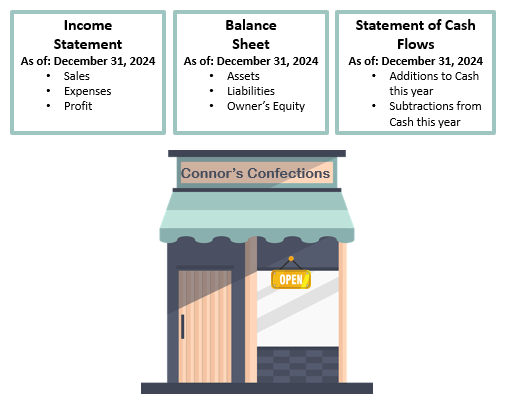
An interactive H5P element has been excluded from this version of the text. You can view it online here:
https://ecampusontario.pressbooks.pub/businessfundamentals/?p=269#h5p-16
To bring this concept closer to home, let’s assume that you need to earn money while you’re in college and that you’ve decided to start a small business. Your business will involve selling stuff to other college students, and to keep things simple, we’ll assume that you’re going to operate on a “cash” basis: you’ll pay for everything with cash, and everyone who buys something from you will pay in cash.
You may have at least a little cash on you right now—some currency, or paper money, and coins. In accounting, however, the term cash refers to more than just paper money and coins. It also refers to the money that you have in chequing and savings accounts and includes items that you can deposit in these accounts, such as money orders and different types of cheques.
Your first task is to decide exactly what you’re going to sell. You’ve noticed that with homework, exams, social commitments, and the hectic lifestyle of the average college student, you and most of the people you know always seem to be under a lot of stress. Sometimes you wish you could just lie back between meals and bounce a ball off the wall. And that’s when the idea hits you: Maybe you could make some money by selling a product called the “Stress-Buster Play Pack.” Here’s what you have in mind: you’ll buy small toys and other fun stuff—instant stress relievers—at a local dollar store and pack them in a rainbow-colored plastic treasure chest labeled “Stress-Buster.”
And here’s where you stand: You have enough cash to buy a month’s worth of plastic treasure chests and toys. After that, you’ll use the cash generated from sales of Stress-Buster Play Packs to replenish your supply. Each plastic chest will cost $2.00, and you’ll fill each one with a variety of five simple toys, all of which you can buy for $1.00 each.
You plan to sell each Stress-Buster Play Pack for $10 from a rented table stationed outside a major dining hall. Renting the table will cost you $20 a month. In order to make sure you can complete your schoolwork, you decide to hire fellow students to staff the table at peak traffic periods. They’ll be on duty from noon until 2:00 p.m. each weekday except Fridays, and you’ll pay them a generous $17.50 an hour. Wages, therefore, will cost you $560 a month (2 hours × 4 days × 4 weeks = 32 hours × $17.50). Finally, you’ll publish ads in the college newspaper at a monthly cost of $40. Thus, your total monthly costs will amount to $620 ($20 + $560 + $40).
Let’s say that during your first month, you sell 220 play packs. Not bad, you say to yourself, but did I make a profit? To find out, you prepare an income statement showing revenues, or sales, and expenses—the costs of doing business. You divide your expenses into two categories:
Now you need to do some subtracting:
The difference between sales and cost of goods sold is your gross profit, also known as gross margin. The difference between gross profit and operating expenses is your net income or profit, which is the proverbial “bottom line.”
Your income statement for the first month is shown in Figure 10.4 . (Remember that we’ve made things simpler by handling everything in cash.)
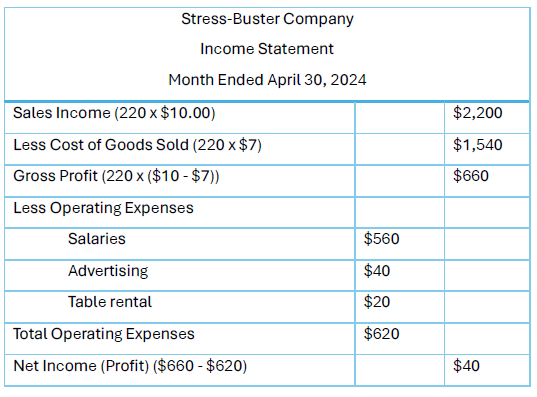
Did You Make Any Money? Not in your first month. Many businesses operate at a net loss when they first open. It takes time to build a customer following and begin to earn profits. Human resources are one of the highest expenses for many companies. If you could run your business without the need for hiring others, how much profit would you have made?
What does your income statement tell you? It has provided you with four pieces of valuable information:
The balance sheet shows the cumulative effect of the income statement over time.
Companies prepare financial statements on at least a twelve-month basis—that is, for a fiscal year which ends on December 31 or some other logical date, such as June 30 or September 30. Fiscal years can vary because companies generally pick a fiscal-year end date that coincides with the end of a peak selling period; thus a crabmeat processor might end its fiscal year in October, when the crab supply has dwindled. Most companies also produce financial statements on a quarterly or monthly basis.
A balance sheet reports the following information:
Whereas your income statement tells you how much income you earned over some period of time, your balance sheet tells you what you have at a specific point in time.
It’s important to mention that Debits and credits are used in a company’s bookkeeping in order for its books to balance. Debits increase asset or expense accounts and decrease liability, revenue or equity accounts. Credits do the reverse of debits, they decrease asset or expense accounts and increase liability, revenue or equity accounts. The individual entries on a balance sheet are referred to as debits and credits. Debits (often represented as DR) record incoming money, while credits (CR) record outgoing money. How these show up on your balance sheet depends on the type of account they correspond to. In double-entry accounting, every transaction is recorded with a debit and credit in two or more accounts, which categorize different types of financial activities in a company’s general ledger. You will put these concepts into practice when you complete your first accounting course.
For Stress-Buster, you’ll want to prepare them monthly to stay on top of how your new business is doing. Let’s prepare a balance sheet at the start and end of your first month in business.
To prepare a balance sheet, one must first understand the fundamental accounting equation:
Assets = Liabilities + Owner’s Equity
This simple but important equation highlights the fact that a company’s assets came from somewhere: either from investments made by the owners (owner’s equity) or from loans (liabilities). This means that the asset section of the balance sheet on the one hand and the liability and owner’s-equity section on the other must be equal, or balance. Thus, the term balance sheet. The Accounting Coach has a comprehensive online tutorial that you may wish to review. It includes the following information about the Accounting Equation.
Let’s prepare the two balance sheets we mentioned: one for the first day you started and one for the end of your first month of business. We’ll assume that when you started Stress-Buster, you borrowed $400 from your parents and put in $200 of your own money. If you refer to Figure 10.5, your business’s first balance sheet, you’ll find that your business has $600 in cash (your assets). Of this total, you borrowed $400 (your liabilities) and invested $200 of your own money (your owner’s equity). So far, so good, your assets section balances with your liabilities and owner’s equity section.
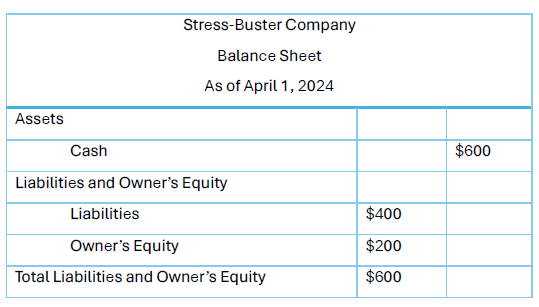
Now let’s see how things have changed on the balance sheet by the end of the month. Recall that Stress-Buster your income statement showed a net income of $40 during the month of April (first month in operation). The $40 gain increases two items on your balance sheet: the assets of the company (its cash) and your investment in it (its owner’s equity). Figure 10.6 shows what your balance sheet will look like on April 30. You now have $640 in cash, $400 that you borrowed, plus a positive amount you invested of $240 (your original $200 investment plus the gain of $40 from the first month of operations).
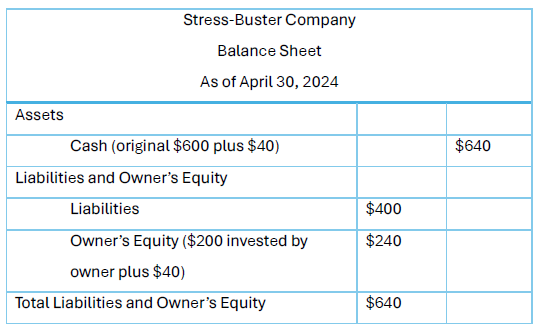
Let’s take a short detour to see how this information might be put to use. As you look at your first financial statements, you might ask yourself: is there some way to figure out the level of sales you need to avoid losing money—to “break even”? This can be done using breakeven analysis: To break even (have no profit or loss), your total sales revenue must exactly equal all your expenses (both variable and fixed). Variable costs depend on the quantity produced and sold; for example, each Stress-Buster includes the treasure chest and the toys inside. Fixed costs don’t change as the quantity sold changes; for example, you’ll pay for your advertising whether you sell Stress-Busters or not. The balance between revenue and expenses will occur when gross profit equals all other (fixed) costs. To determine the level of sales at which this will occur, you need to do the following (using data from the previous example):
Your calculation means that if you sell 206.667 units, you’ll end up with zero profit (or loss) and will exactly break even. To test your calculation, you can prepare a what-if income statement for 206.667 units in sales (your breakeven number). The resulting income statement is shown in Figure 10.7 below. You sold 220 units at $3 gross profit per unit =$660 and to break even you only need to sell 206.667 units at $3 gross profit per unit = $620, therefore, you made $40 net income.
Of course, you want to do better than just break even, so you could modify this analysis to a targeted level of profit by adding that amount to your fixed costs and repeating the calculation. Breakeven analysis is rather handy. It enables you to determine the level of sales that you must reach to avoid losing money and the level of sales that you have to reach to earn a certain profit. Such information will be vital to planning your business.
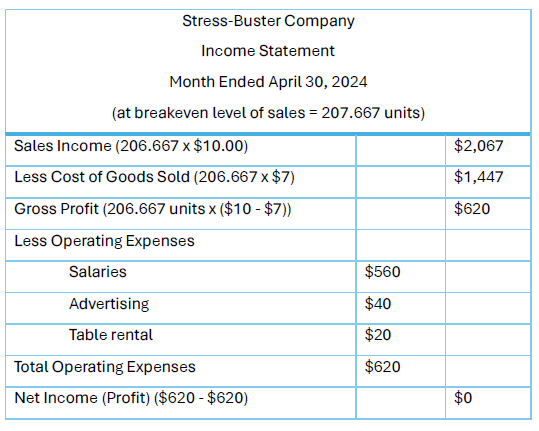
The cash flow statement provides valuable information about a company’s expenses and receipts and allows insights into its future income needs in order to be able to meet its future obligations (expenses and receipts). The cash flow statement reports cash inflows and outflows, and it will identify the amount of cash the company currently holds, which is also reported in the balance sheet.
Typically, the cash flow statement is reported on a month to month basis, however, a statement of cash flow will consolidate month to month cash flow to meet the requirements of the International Financial Reporting Standards.
A statement of cash flow will report cash in three distinct areas of business:
Refer to Figure 10.8 to review the statement of cash flow for Stress-Buster company for the one month period ending April 30, 2024. Stress-Buster would have incurred a Net Income of $40 from Operations during the first month of operation, after deducting the month’s expenses from the month’s revenues. The business also incurred cash from Financing from the initial $400 loan taken out to start the business and the additional $200 of personal income. As Stress-Buster did not invest in new equipment, machinery or other assets for the business or use prior cash flows and/or retained earnings to earn further investment income, Stress-Buster would not report any cash from investing activities.
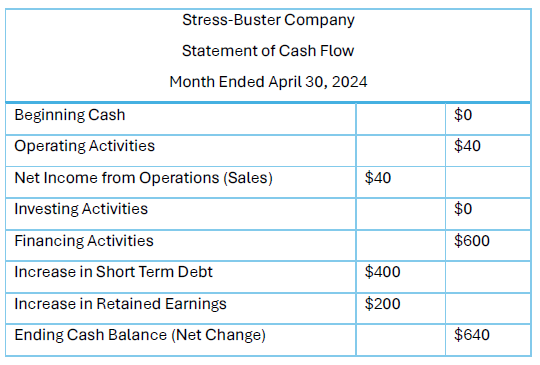
Now that you know a bit about financial statements, let’s see how they’re used to help owners, managers, investors, and creditors assess a firm’s performance and financial strength. You can glean a wealth of information from financial statements, but first you need to learn a few basic principles for “unlocking” it.
A trend analysis is done by collecting data at selected times and then plotting any observed changes over longer periods. A trend analysis examines the factors that drive business success. The analysis is used to make projections for the future, identify areas that need attention from managers, and benchmark the business against others in the industry. Some of the most common operating factors tracked in trend analysis include gross margin, sales (in units/dollars), earnings before interest and taxes (EBIT), earnings per common share (EPS), stock price, etc. The most common line items on the balance sheet included in a trend analysis are total assets, total liabilities, total shareholder equity, debt-to-equity ratio, current ratio, and acid test ratio.
Refer to Figure 10.9 which is an abbreviated financial statement for Apple for 2017 taken directly from their website (also available for download in PDF form via Google search). You will note that instead of showing only the current year’s results, the company has shown data for the prior year as well. From this relatively simple exhibit, considerable information about Apple’s performance can be obtained.
For example:
Many other calculations are possible from Apple’s data, and we will look at a few more as we explore ratio analysis.
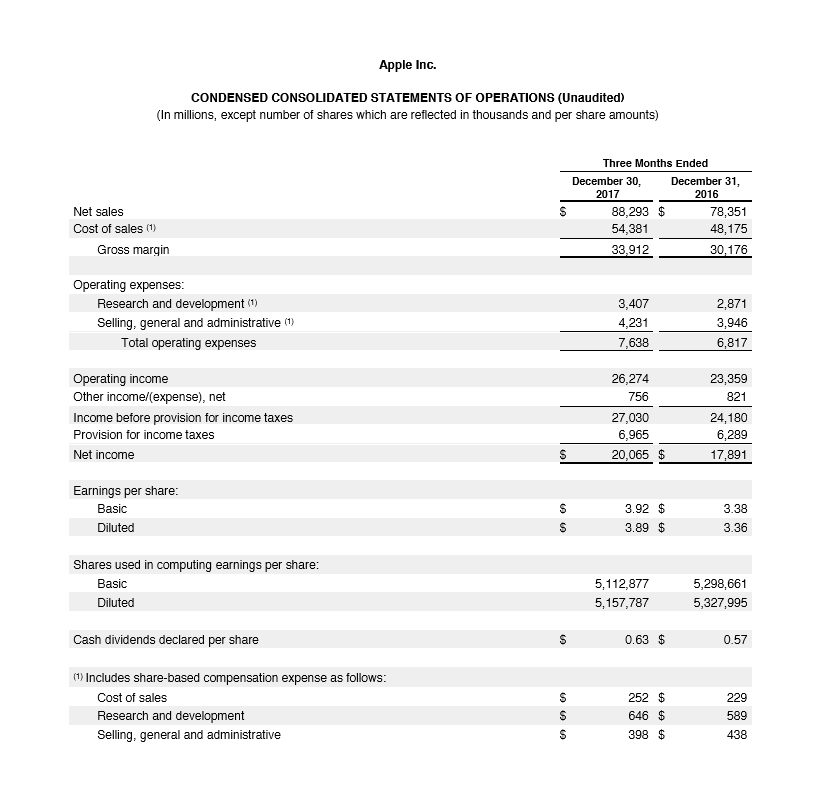
How do you compare Apple’s financial results, shown in Figure 10.10, with those of other companies in your industry or with the other companies whose stock is available to investors? And what about your balance sheet? Are there relationships on this statement that also warrant investigation? These issues can be explored by using ratio analysis, a technique for evaluating a company’s financial performance.
Remember that a ratio is just one number divided by another, with the result expressing the relationship between the two numbers. It’s hard to learn much from just one ratio, or even a number of ratios covering the same period. Rather, the deeper value in ratio analysis lies in looking at the trend of ratios over time and in comparing the ratios for several time periods with those of other companies. There are a number of different ways to categorize financial ratios.
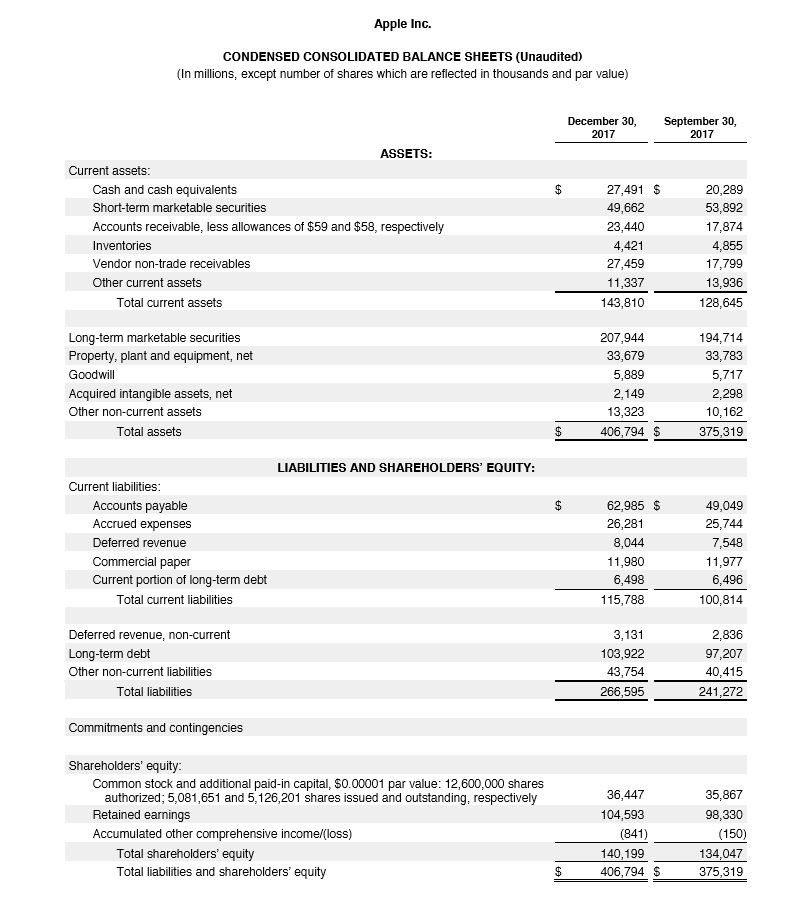
Here’s one set of categories:
We could employ many different ratios, but we’ll focus on a few key examples.
Profitability ratios include gross profit margin, net profit margin, and return on equity. Earnings per share (EPS) is a measure of a company’s profitability that indicates how much profit each outstanding share of common stock has earned. It’s calculated by dividing the company’s net income by the total number of outstanding shares. The higher a company’s EPS, the more profitable it is considered to be. Earlier we looked at the return on sales for Apple and now we will look at its EPS. According to the earlier Figure 10.9 and 10.10, Apple saw its EPS increase from $3.38 in 2016 to $3.92 in 2017, which indicates a profit of about 15% an excellent return for a company that is already among the world’s largest. Well-paid analysts will spend hours to understand how these results were achieved every time Apple issues new financial statements.
A liquidity ratio is a type of financial ratio used to determine a company’s ability to pay its short-term debt obligations. The metric helps determine if a company can use its current, or liquid, assets to cover its current liabilities. Liquidity ratios are one element of measuring the financial strength of a company. A key liquidity ratio is called the current ratio. It simply examines the relationship between a company’s current assets and its current liabilities. On December 30, 2017 (remember that balance sheets reflect a point in time), Apple had $68.5 billion in current assets and $63.5 billion in current liabilities. Simply, what this means is that Apple has more money on hand than they need to pay their bills. When a company has a current ratio greater than 1, they are in good shape to pay their bills; companies selling to Apple on credit would not need to worry that it is likely to run out of money.
Apple’s current ratio = $68.5 Billion / $63.5 Billion = 1.08 (greater than >) 1
Now, let’s look quickly at something that is not part of the ratio; look down one line on the balance sheet to long-term marketable securities and see that Apple owns $207.9 billion. While they are long term and so not part of the current ratio, these securities are still easily convertible to cash. So, Apple has far more cushion than the current ratio reflects, even though it reflected a healthy financial position already.
A key debt ratio, which tells us how the company is financed, is the debt-to-equity ratio, which calculates the relationship between funds acquired from creditors (debt) and funds invested by owners (equity). For this ratio calculation, we use Apple’s total liabilities, not just the line on the balance sheet that says long-term debt, because in effect, Apple is borrowing from those who it owes but has not yet paid. Apple’s total liabilities at the end of 2017 were $266.6 billion versus owner’s equity of $140.2 billion, a ratio of 1.9, which means Apple has borrowed more than it has invested in the business.
Apple’s debt to equity ratio: $266.6 / $140.2 Billion = 1.9
To some investors, that high level of debt might seem alarming. But remember that Apple has $207.9 billion invested in marketable securities. If it wished to do so, Apple could sell some of those securities and pay down its debts, thus improving its ratio. It’s likely that anyone thinking about lending money to Apple and seeing these figures would be confident that Apple has the ability to pay back what they borrow.
Efficiency ratios include the inventory turnover ratio, asset turnover ratio, and receivables turnover ratio. These ratios measure how efficiently a company uses its assets to generate revenues and its ability to manage those assets.
There are many more ratios which we could apply to Apple to more completely understand its performance. Yet going deeper into ratios would be beyond the scope of an introductory business course. If you continue your study of business, you will get ample exposure to these ratios in your accounting and finance courses. So, we’ll leave the rest for another day.
Check your understanding of this chapter’s concepts by completing this short self-check quiz.
An interactive H5P element has been excluded from this version of the text. You can view it online here:
https://ecampusontario.pressbooks.pub/businessfundamentals/?p=269#h5p-17
The contents of this chapter is a compilation sourced from various OER resources, please refer to the Book Information for details.
(Note: This reference list was produced using the auto-footnote and media citation features of Pressbooks)
Pesqueno, A. (2024, June 18). Nvidia now world’s most valuable company–topping Microsoft and Apple. https://www.forbes.com/sites/antoniopequenoiv/2024/06/18/nvidia-now-worlds-most-valuable-company-topping-microsoft-and-apple/
Liberto, D. (2024, October 16). Biggest companies in the world by market cap. https://www.investopedia.com/biggest-companies-in-the-world-by-market-cap-5212784
Tobin, J. (2024, Ocotber 7). What does a financial manager do? https://www.accounting.com/careers/financial-manager/
Khan, F. (2023, September 22). Financial controls. https://www.wallstreetoasis.com/resources/skills/finance/financial-controls#:~:text=Key%20Takeaways%201%20Financial%20controls%20are%20procedures%20and,creditworthiness%2C%20and%20efficient%20resource%20use.%20…%20More%20items
PM4NGOs. (2024, April 19). Financial control and management best practices.[Video]. YouTube. https://youtu.be/1pdwnyqrimY?si=_5suq6BZpMnO9NvM
Maverick, J. (2024, June 13). Equity financing vs. debt financing: What’s the difference? https://www.investopedia.com/ask/answers/042215/what-are-benefits-company-using-equity-financing-vs-debt-financing.asp
Maverick, J. (2024, June 13). Equity financing vs. debt financing: What’s the difference? https://www.investopedia.com/ask/answers/042215/what-are-benefits-company-using-equity-financing-vs-debt-financing.asp
Maverick, J. (2024, June 13). Equity financing vs. debt financing: What’s the difference? https://www.investopedia.com/ask/answers/042215/what-are-benefits-company-using-equity-financing-vs-debt-financing.asp
Daddey, F. & Newton, R. (2022). The Fundamentals of Business. https://pressbooks.bccampus.ca/fundamentalsbusiness/chapter/economics-and-business/#term_46_663
WallStreetMojo. (2024, August 21). Long-term financing. https://www.wallstreetmojo.com/long-term-financing/
University of Windsor & Ryerson University. (2022). Indigenous lifeways in Canadian business. https://ecampusontario.pressbooks.pub/indigenousbusinesstopics/chapter/chapter-1/
Gavin, M. (2020, June 2). 5 ways managers can use finance to make better decisions. https://online.hbs.edu/blog/post/financial-decision-making
Quickbooks Canada Team. (2020, September 18). Understanding IFRS and GAAP. https://quickbooks.intuit.com/ca/resources/accounting/understanding-ifrs-and-gaap/
bdc. (n.d.) Trend analysis. https://www.bdc.ca/en/articles-tools/entrepreneur-toolkit/templates-business-guides/glossary/trend-analysis
11
After reading this chapter, you should be able to do the following:

Human Resource Management (HRM) is the strategic practice of managing an organization’s workforce to achieve its goals effectively and efficiently. It encompasses the recruitment, training, development, and retention of employees, ensuring their skills and contributions align with the organization’s objectives. HRM involves a range of functions, including workforce planning, performance management, employee relations, compensation and benefits, compliance with labor laws, and fostering a positive organizational culture. By focusing on both employee well-being and organizational needs, HRM aims to maximize employee performance, satisfaction, and productivity, driving overall business success.
Employees at Starbucks are vital to the company’s success. They are its public face, and every dollar of sales passes through their hands. According to Howard Schultz, they can make or break the company. If a customer has a positive interaction with an employee, the customer will come back. If an encounter is negative, the customer is probably gone for good. That’s why it’s crucial for Starbucks to recruit and hire the right people, train them properly, motivate them to do their best, and encourage them to stay with the company. Thus, the company works to provide satisfying jobs, a positive work environment, appropriate work schedules, and fair compensation and benefits. These activities are part of Starbucks’s strategy to deploy human resources in order to gain competitive advantage. The process is referred to as human resource management (HRM) and consists of all actions that an organization takes to attract, develop, and retain quality employees. Each of these activities is complex. Attracting talented employees involves the recruitment of qualified candidates and the selection of those who best fit the organization’s needs. Development encompasses both new-employee orientation and the training and development of current workers. Retaining good employees means motivating them to excel, appraising their performance, compensating them appropriately, and doing what’s possible to keep them.
How does Starbucks make sure that its worldwide retail locations are staffed with just the right number of committed employees? How does Norwegian Cruise Lines make certain that when the Norwegian Dawn pulls out of New York harbor, it has a complete, fully trained crew on board to feed, entertain, and care for its passengers? Managing these tasks is a matter of strategic human resource planning—the process of developing a plan for satisfying an organization’s human resources (HR) needs.
The Human Resource (HR) Planning Process is a strategic approach to ensuring that an organization has the right number of employees, with the right skills, at the right time to meet its goals. It involves analyzing and forecasting an organization’s human resource needs and aligning HR practices to support the overall business strategy.
Here are the key steps in the HR planning process:
A Strategic HR Plan lays out the steps that an organization will take to ensure that it has the right number of employees with the right skills in the right places at the right times. HR managers begin by analyzing the company’s mission, objectives, and strategies. Starbucks’s objectives, for example, include the desire to “develop enthusiastically satisfied customers” as well as to foster an environment in which employees treat both customers and each other with respect. Thus, the firm’s HR managers look for people who are “adaptable, self-motivated, passionate, creative team members.” The main goal of Norwegian Cruise Lines—to lavish passengers with personal attention—determines not only the type of employee desired (one with exceptionally good customer-relation skills and a strong work ethic) but also the number needed (one for every two passengers on the Norwegian Dawn).
Once they’ve analyzed the jobs within the organization, HR managers must forecast future hiring (or firing) needs. HR forecasting is the process of predicting how a company’s staffing needs change with time so that it can remain prepared to operate successfully. Organizations use HR forecasting to decide to hire more people, reduce their staffing or adjust how they divide responsibilities. There are three steps to forecasting HR needs:
Starbucks, for instance, might find that it needs three hundred new employees to work at stores scheduled to open in the next few months. Disney might determine that it needs two thousand new cast members to handle an anticipated surge in visitors. The Norwegian Dawn might be short two dozen restaurant workers because of an unexpected increase in reservations.
After calculating the disparity between supply and future demand, HR managers must draw up plans for bringing the two numbers into balance. If the demand for labour is going to outstrip the supply, they may hire more workers, encourage current workers to put in extra hours, subcontract work to other suppliers, or introduce labour-saving initiatives. If the supply is greater than the demand, they may deal with overstaffing by not replacing workers who leave, encouraging early retirements, laying off workers, or (as a last resort) firing workers.
By predicting future workforce needs, HR can strategically recruit, train, and develop employees to align with business objectives, ensuring the organization stays competitive and adaptable in an evolving market. Forecasting staffing requirements allows HR to implement focused recruitment efforts, succession planning, and professional development initiatives that promote employee growth and reduce turnover, ensuring key roles are filled with qualified individuals, which enhances organizational performance. HR planning also helps organizations optimize staffing levels, enabling better control over labor costs while reducing the risk of both understaffing and overstaffing. By accurately forecasting workforce needs, HR can effectively manage budgets, prevent staffing shortages, and ensure compliance with labor laws and regulations, thus mitigating operational risks.
Before we go any further, it is important to point out that in recruiting and hiring, managers must comply with anti-discrimination laws; violations can have legal consequences. Discrimination occurs when a person is treated unfairly on the basis of a characteristic unrelated to ability.
Under Section 3 of the Canadian Human Rights Act (CHRA), it’s illegal to discriminate on the basis of “race, national or ethnic origin, colour, religion, age, sex, sexual orientation, gender identity or expression, marital status, family status, genetic characteristics, disability or conviction for an offence for which a pardon has been granted or in respect of which a record suspension has been ordered.” The Canadian Human Rights Act applies to workplaces in federal organizations or industries that are regulated by the federal government (e.g., banks, telecommunications, federal government departments). The Canadian Human Rights Commission (CHRC) investigates complaints of discrimination, ensures compliance with the CHRA, and promotes equality and human rights awareness. It focuses on addressing discrimination within federally regulated entities. Equal Pay in Section 11 of the CHRA protects employees who perform work of equal value, in the same establishment, by ensuring they receive equal pay. Individuals who experience discrimination or harassment in federally regulated workplaces or services can file a complaint with the CHRC. An investigation takes place and CHRC may mediate between the complainant and the respondent to resolve the issue. If mediation fails or the complaint involves complex legal issues, the CHRC may refer the case to the Canadian Human Rights Tribunal (CHRT) for a formal hearing. The Tribunal can order remedies (e.g., reinstatement of employment, changes to workplace policies, wage compensation, training) and the decisions are enforceable in Federal Court.
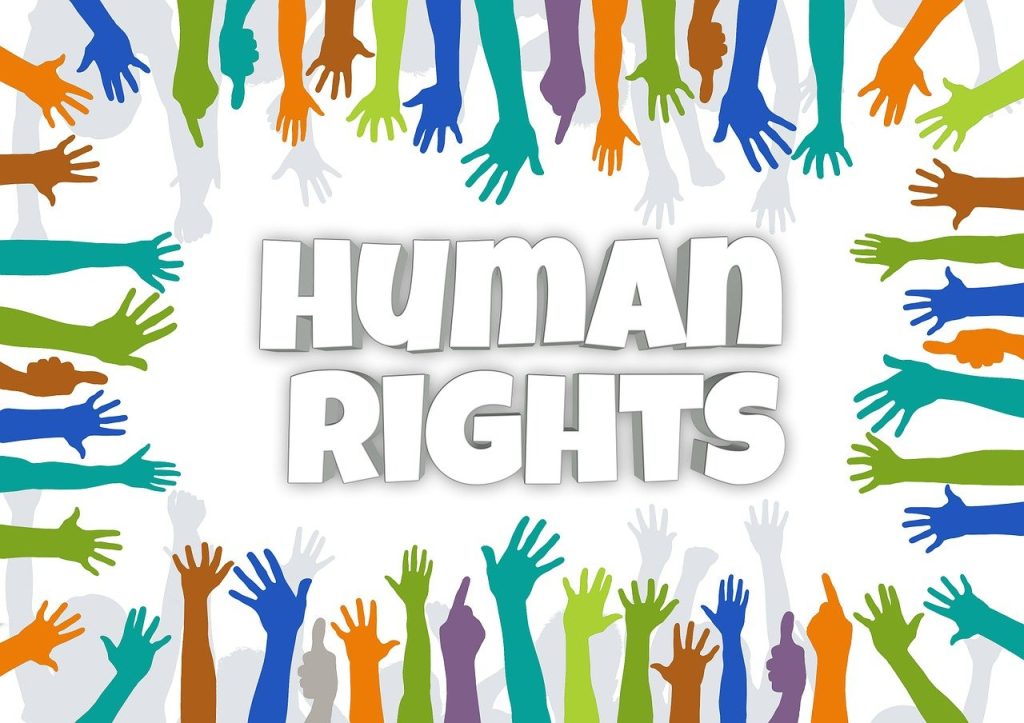
Canada’s Charter of Rights and Freedoms (CCRF) applies to interactions between individuals and all levels of government (federal, provincial, and territorial). It covers broader rights, such as freedom of expression, equality rights, mobility rights, and legal rights, and provides protection from government action that violates these rights. The Charter applies broadly, protecting Canadians from actions by any government entity that infringe on their constitutional rights. The Charter is part of Canada’s Constitution, making it the supreme law, while the CHRA is a federal statute with narrower jurisdiction. Section 15(1) of the Charter protects every Canadian’s right to equal treatment with respect to employment regardless of race, national or ethnic origin, colour, religion, sex, age or mental or physical disability.
The Ontario Human Rights Code (OHRC) is a provincial law, and its role complements federal human rights legislation, like the CHRA and the CCRF. The OHRC applies specifically to individuals and organizations operating in Ontario, including private businesses, public services, housing, and employment. It prohibits discrimination and harassment based on protected grounds such as race, sex, age, disability, family status, and sexual orientation in key areas like employment, housing, and services. Complaints are handled by the Human Rights Tribunal of Ontario (HRTO), which resolves disputes under the OHRC. Each province and territory has its own human rights code or version of it (e.g., Ontario, British Columbia, Quebec), tailored to address regional issues and provide an additional layer of protection against discriminatory practices. The OHRC is Ontario’s version, ensuring that local businesses, landlords, and service providers comply with anti-discrimination laws. Under the Code, you have the right to be free from discrimination in five parts of society – called social areas – based on one or more grounds. The five social areas are: employment, housing, services, unions and vocational associations and contracts. The Ontario Human Rights Code (OHRC) does not apply to federal organizations. Both of these laws, the CHRA and the OHRC, cannot apply at the same time. If one applies, the other does not.
The Canada Labour Code (CLC) governs employment standards, workplace health and safety, and industrial relations for federally regulated workplaces. Key areas include hours of work, overtime, wages, vacation, holiday entitlements, termination, severance pay, workplace safety requirements, and collective bargaining rules.
The Employment Equity Act (EEA) is a key piece of Canadian legislation that complements the Canadian Human Rights Act (CHRA), the Canadian Charter of Rights and Freedoms (CCRF), and provincial laws like the Ontario Human Rights Code (OHRC). The Employment Equity Act of 1986 identifies specific populations which are protected from discrimination (women, visible minorities, indigenous peoples, and people with disabilities). EEA applies only to federally regulated employers. It does not apply to provincially regulated workplaces, which are governed by provincial human rights codes like the OHRC. The EEA is distinct in its proactive approach to workplace diversity and equity. Unlike laws that solely prohibit discrimination (e.g., CHRA, OHRC), the EEA requires employers to actively remove barriers and promote inclusion for the four designated groups. Individuals who feel that they have been discriminated against can take their case to the Canadian Human Rights Commission. If an employer fails to address non-compliance or refuses to cooperate, the CHRC can refer the matter to the Employment Equity Review Tribunal. The Tribunal has the authority to issue orders compelling compliance and impose penalties. Non-compliant employers may face fines or other legal consequences as determined by the Tribunal.

The Occupational Health and Safety Act (OHSA) is designed to ensure that workers are provided with safe and healthy working conditions. These laws outline the responsibilities of employers to maintain a safe work environment, including providing necessary safety equipment, conducting risk assessments, and implementing safety protocols. Employers must take steps to minimize hazards and protect their employees from potential injuries or health risks. On the other hand, employees have the right to refuse work that they believe is unsafe, ensuring they are not forced to work under hazardous conditions. In addition, these laws also facilitate workplace inspections and hazard reporting to identify and rectify potential risks. For example, the Ontario Occupational Health and Safety Act (OHSA) sets out specific regulations regarding workplace safety in Ontario. It covers everything from the duties of employers to the rights of employees, emphasizing the importance of both proactive safety measures and the right of employees to report hazards or unsafe practices without fear of retaliation. These protections are essential to promoting a safe and secure work environment for all employees. Each province and territory in Canada has its own occupational health and safety legislation that applies within their jurisdiction. These laws are similar in nature, but they may have regional variations in terms of enforcement, penalties, and specific requirements. For example: British Columbia has the WorkSafeBC program and the Workers Compensation Act and Alberta has the Occupational Health and Safety Act (OHS Act) specific to Alberta and Quebec has La Loi sur la santé et la sécurité du travail (LSST). Federally regulated employers, such as those in transportation, banking, and telecommunications, must comply with the Canada Labour Code (CLC), which also includes health and safety regulations for federally regulated workplaces.
There are other additional labour laws such as the Accessible Canada Act (ACA)(federal), Accessibility for Ontarians with Disabilities Act (AODA)(Ontario), Workplace Safety and Insurance Act (Ontario), Ontario’s Pay Equity Act, Personal Information Protection and Electronic Documents Act (PIPEDA)(federal), Personal Information Protection Acts (Alberta, British Columbia), Ontario Employment Standards Act, 2000 (ESA), but for purposes of this chapter we will not go into additional details.
Refer to Table 11.1 for a comparison of Employment Law and Human Rights discussed in this section.
| Aspect | Canada Labour Code (CLC) | Employment Equity Act (EEA) | Occupational Health and Safety (OHS) Laws | Ontario Human Rights Code (OHRC) | Canadian Charter of Rights and Freedoms (CCRF) | Canadian Human Rights Act (CHRA) |
|---|---|---|---|---|---|---|
| Purpose | Governs employment and labor relations in federally regulated workplaces, ensuring fair treatment and workplace safety. | Promotes workplace equity by removing systemic barriers for designated groups (women, Indigenous peoples, persons with disabilities, visible minorities). | Ensures workplace safety and health, protecting employees from hazards, injuries, and illnesses. | Prohibits discrimination and harassment in Ontario workplaces, housing, and services, ensuring equal treatment. | Guarantees fundamental freedoms and rights, including equality and protection from discrimination by government actions. | Prohibits discrimination and harassment in employment and services based on protected grounds such as race, gender, religion, disability, and age. |
| Scope | Applies to all federally regulated industries (e.g., transportation, telecommunications, banking, and other federally governed sectors). | Federally regulated employers (e.g., banks, transportation, telecommunications) with 100+ employees. | Applies to all workplaces in Canada, with specific legislation in each province/territory. | Provincially regulated workplaces, housing, and services in Ontario. | Applies to all levels of government actions and laws across Canada. Does not apply to private sector actions directly. | Federally regulated workplaces and services, as well as discrimination complaints from individuals. |
| Key Enforcement Body | Enforced by the Labour Program of Employment and Social Development Canada (ESDC). | Canadian Human Rights Commission (CHRC) oversees compliance. | Provincial/territorial workplace safety regulators (e.g., Ontario’s Ministry of Labour). | Ontario Human Rights Commission (OHRC) oversees policy, with complaints handled by the Human Rights Tribunal of Ontario (HRTO). | Enforced through the judicial system, with challenges brought to the courts, including the Supreme Court of Canada. | Canadian Human Rights Commission (CHRC) investigates complaints and refers cases to the Tribunal. |
| Escalation/Tribunal | Violations of employment standards or labor relations issues can be addressed through dispute resolution mechanisms and the Federal Labour Relations Board. | Cases of non-compliance may be referred to the Employment Equity Review Tribunal. | Violations may lead to orders, fines, or prosecutions through provincial/territorial safety bodies. | Discrimination complaints are heard by the Human Rights Tribunal of Ontario (HRTO). | Cases are escalated through provincial or federal courts, up to the Supreme Court of Canada if necessary. | Discrimination complaints may be referred to the Canadian Human Rights Tribunal (CHRT). |
| Penalties | Non-compliance can result in penalties, fines, or mandatory corrective actions to meet employment standards and safety regulations. | Corrective action orders, fines, or further legal action for non-compliance. | Penalties include fines, stop-work orders, or criminal charges for severe violations. | Remedies include monetary compensation, public apologies, policy changes, and reinstatement. | Court rulings may invalidate laws or policies, and governments may need to make changes or provide remedies. | Remedies include compensation, reinstatement, and policy changes. |
| Notable Legislation Examples | Canada Labour Code (Federal), covering employment standards, occupational health and safety, and labor relations for federally regulated industries. | Employment Equity Act (Federal). | Ontario Occupational Health and Safety Act (OHSA), Alberta OHS Act, etc. | Ontario Human Rights Code (Provincial). | Section 15 (Equality Rights), Section 2 (Fundamental Freedoms), Section 7 (Life, Liberty, and Security). | Canadian Human Rights Act (Federal). |
The recruitment and selection process is a strategic approach to finding and hiring the right talent for an organization. It begins with workforce planning and job analysis to identify staffing needs and create detailed job descriptions and specifications. The recruitment phase involves sourcing candidates through various channels like job boards, social media, internal promotions, and networking. Once applications are received, the selection process evaluates candidates through resume screening, interviews, assessments, and reference checks to determine their suitability for the role. The process concludes with extending a job offer to the chosen candidate, followed by onboarding to integrate them into the organization. This streamlined approach ensures that the best-fit candidates are hired efficiently while aligning with organizational goals.
The recruitment and selection process in Human Resources (HR) is the series of steps taken to identify, attract, and hire the right candidates for a job position. It typically involves the following stages:

Recruiting Process:
Selection Process:
Armed with information on the number of new employees to be hired and the types of positions to be filled, the HR manager then develops a strategy for recruiting potential employees. Recruiting is the process of identifying suitable candidates and encouraging them to apply for openings in the organization. When the organization is seeking to hire talent, recruiters within the HR department assume this responsibility by creating job postings, screening candidates and setting up interviews. While recruiting refers to the broader effort of attracting and sourcing candidates, selection specially focuses on evaluating and choosing the best candidate for the job.
Job analysis and planning is the foundational step in the recruitment process, focusing on understanding the specific requirements of a role and preparing for effective talent acquisition. Job analysis involves examining the tasks, responsibilities, skills, and qualifications (knowledge and abilities) needed for a position, resulting in a clear and detailed job description and specification. Planning complements this by aligning recruitment efforts with organizational goals, determining the number and type of positions to be filled, and setting timelines and budgets for the hiring process. This stage ensures clarity about the role and provides a strategic framework to attract the most suitable candidates, aligning workforce capabilities with business objectives.
To develop an HR plan, HR managers must be knowledgeable about the jobs that the organization needs performed. HR managers gather information about a given job by performing a job analysis and use the information collected to prepare two documents:
Sourcing candidates is a critical step in the recruitment process that involves identifying and attracting potential candidates who meet the qualifications and requirements of a job opening. This process can include internal sourcing, such as promoting or transferring current employees, and external sourcing, which involves advertising on job boards, leveraging social media platforms, using recruitment agencies, attending career fairs, and tapping into employee referrals or professional networks. The goal is to reach a diverse and qualified talent pool while optimizing the methods used to align with the organization’s needs. Effective sourcing ensures that the recruitment process begins with a strong foundation of capable and suitable candidates, increasing the chances of finding the right fit for the role.
The first step in recruiting is to find qualified candidates. Where do you look for them, and how do you decide whether they’re qualified? Companies must assess not only the ability of a candidate to perform the duties of a job, but also whether he or she is a good “fit” for the company– i.e., how well the candidate’s values and interpersonal style match the company’s values and culture.
Where do you find people who satisfy so many criteria? Basically, you can look in two places: inside and outside your own organization. Both options have pluses and minuses. Hiring internally sends a positive signal to employees that they can move up in the company—a strong motivation tool and a reward for good performance. In addition, because an internal candidate is a known quantity, it’s easier to predict his or her success in a new position. Finally, it’s cheaper to recruit internally. On the other hand, you’ll probably have to fill the promoted employee’s position. Hiring externally gives you an opportunity to bring fresh ideas and skills into the company. In any case, it’s often the only alternative, especially if no one inside the company has just the right combination of skills and experience. Entry-level jobs are usually filled from the outside.

Whether you search inside or outside the organization, you need to publicize the opening. If you’re looking internally in a small organization, you can alert employees informally. In larger organizations, HR managers generally post openings on bulletin boards (often online) or announce them in newsletters. They can also seek direct recommendations from various supervisors.
Recruiting people from outside is more complicated. It’s a lot like marketing a product to buyers: in effect, you’re marketing the virtues of working for your company. Starbucks uses the following outlets to advertise openings:
When asked what it takes to attract the best people, Starbucks’s senior executive Dave Olsen replied, “Everything matters.” Everything Starbucks does as a company bears on its ability to attract talent. Accordingly, everyone is responsible for recruiting, not just HR specialists. In fact, the best source of quality applicants is often the company’s own labour force.
Though most people prefer to hold permanent, full-time positions, there’s a growing number of individuals who work at temporary or part-time jobs, either by choice or as the only available option. Many of these are contingent workers hired to supplement a company’s permanent workforce. Most of them are independent contractors, consultants, or freelancers who are paid by the firms that hire them. Others are on-call workers who work only when needed, such as substitute teachers. Still others are temporary workers (or “temps”) who are employed and paid by outside agencies or contract firms that charge fees to client companies.
The use of contingent workers provides companies with a number of benefits. Because they can be hired and fired easily, employers can better control labour costs. When things are busy, they can add temps, and when business is slow, they can release unneeded workers. Temps are often cheaper than permanent workers, particularly because they rarely receive costly benefits. Employers can also bring in people with specialized skills and talents to work on special projects without entering into long-term employment relationships. Finally, companies can “try out” temps: if someone does well, the company can offer permanent employment; if the fit is less than perfect, the employer can easily terminate the relationship. There are downsides to the use of contingent workers, including increased training costs and decreased loyalty to the company. Also, many employers believe that because temps are usually less committed to company goals than permanent workers, productivity suffers.
Referrals and professional networking are commonly used methods of identifying job prospects, particularly for managerial, professional, and technical positions. Several software applications and social networks facilitate employee referrals, reference checking, and hiring based on networks of personal relationships. ExecuNet and ExecRank are just two of the many career sites that allow members to search for contacts and network with other professionals in their fields.
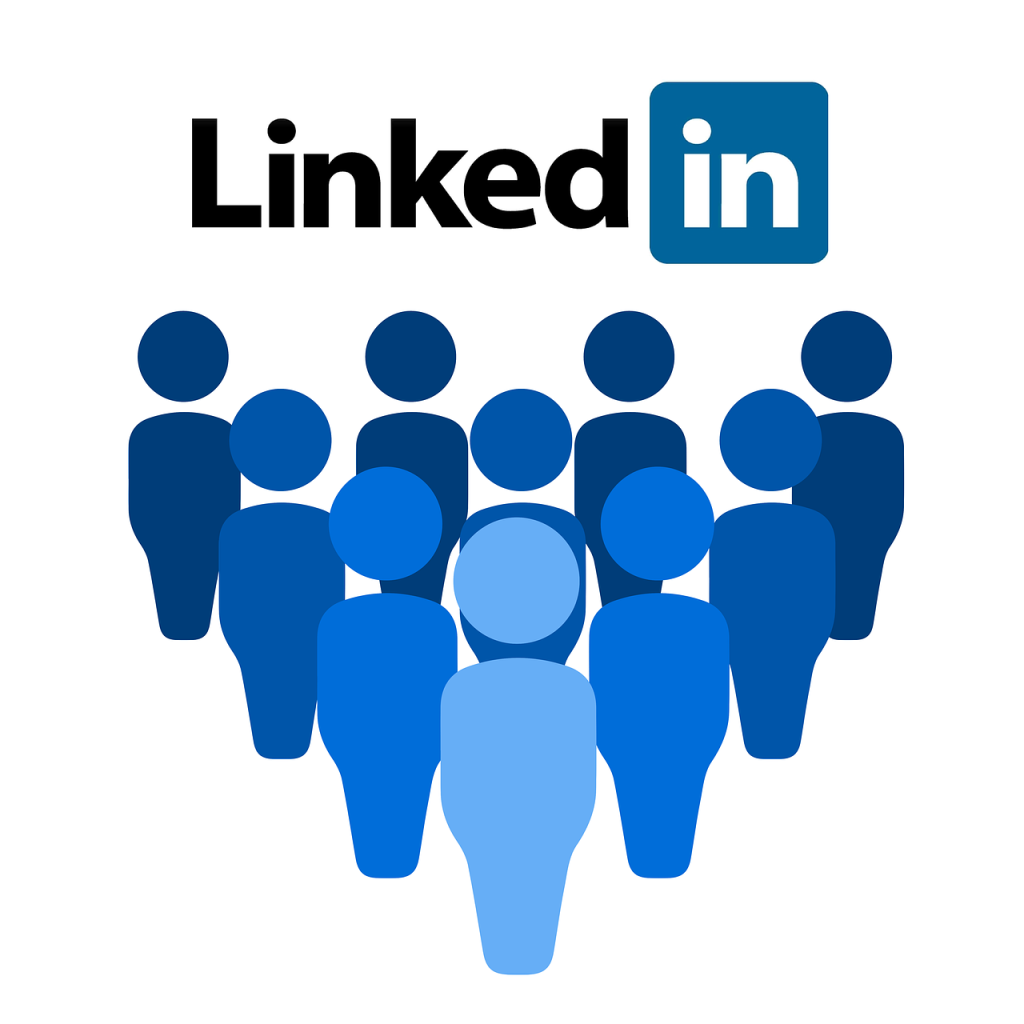
LinkedIn is the most popular social network for professionals. It is a giant database of contacts with profiles that provide an overview of a person’s past and present professional experience, skills, professional referrals, and affiliations with business and professional associations. A member can search through an extended network of contacts based on his or her professional acquaintances. The basis for a search can be job, job title, company, geography, zip code, or membership in a professional organization. LinkedIn uses the concept that there are no more than six degrees of separation between two people, or one person can be linked to any other individual through no more than six other people. With 1 billion members in more than 200 countries and territories worldwide, LinkedIn’s extensive platform is an ideal network for both recruiters and those looking to make their next career move.
Did you know that 90% of recruiters report hiring someone from LinkedIn? That’s the power of social media recruiting; it offers a host of advantages, such as broader reach, cost-effectiveness, and real-time engagement!
Recruiters utilize various social media platforms because they provide unparalleled reach to potential candidates. By utilizing these platforms, recruiters can access a vast pool of talent and increase the visibility of job opportunities. Social media recruiting is also more cost-effective than traditional recruitment methods. Posting job ads, sharing content, and engaging with candidates on social media platforms are generally more affordable than other advertising channels. Moreover, with the rise of remote work and digital nomadism, job seekers increasingly use their mobile devices for job hunting. Social media platforms are easily accessible via mobile devices, making them convenient for job seekers to browse job postings anytime, anywhere.
After a firm has attracted enough job applicants, employment specialists begin the selection process. Selection is the process of determining which people in the applicant pool possess the qualifications necessary to be successful on the job. The steps in the employee selection process are shown in Figure 10.1. An applicant who can jump over each step, or hurdle, will very likely receive a job offer; thus, this is known as the successive hurdles approach to applicant screening. Alternatively, an applicant can be rejected at any step or hurdle. Selection steps or hurdles are shown in Figure 11.1 below.
During the initial screening phase, applicants typically complete an application form and/or submit a résumé and participate in a brief interview lasting 30 minutes or less. The job application generally includes details about the applicant’s educational background, prior work experience, and specific job responsibilities performed. For some positions, applicants may be asked to provide additional materials such as work samples, certificates, credentials, or other supporting documents, either along with the résumé or shortly after advancing past the selection interview.
Initial screenings can vary in format—they may take place over the phone, through online conferencing, or occasionally be bypassed altogether, with candidates proceeding directly to the interview stage. These variations depend on factors such as the position’s seniority, the hiring company’s practices, industry norms, and specific job requirements.
Following initial screening, the applicant may be asked to take one or more tests, such as the Wonderlic Personnel Tests. Wonderlic offers a suite of pre-employment tests for each phase of the hiring process. Used individually or together, the tests can assess cognitive ability (ability to learn, adapt, and solve problems), motivation potential (attitude, behavior performance, and productivity), and knowledge and skills (math, verbal, data entry, software proficiency). Job candidates are scored on how well they complete the employment tests.
McDonald’s, for example, employs over 1.7 million people across the globe and the company uses personality tests to assess whether a candidate is a good fit to become a part of the McD family. Personality questionnaires are tools to gauge a candidate’s behavioural preferences, and the company uses these tools to assess a wide range of applicants. By gleaning the results of such standardized questionnaires, the company quickly determines the most suitable candidates for particular roles.
Another example is Ford Motor. The multinational automaker employs over 190,000 people across the globe, with a widespread presence in 73 countries. Building and managing such a diverse workforce requires an exceptional hiring strategy. The company uses a two-part psychometric test, namely, numerical reasoning and verbal reasoning tests. These tests enable recruiters to objectively assess a wide range of candidates with diverse qualifications and experience. As a result, Ford Motor can quickly identify suitable applicants for a given role by analyzing the tests’ outcomes. Gathering such granular insights into candidates’ skills from just interviews and resumes seems rather unlikely, so the company employs professional psychometric tests at various stages of the hiring process.
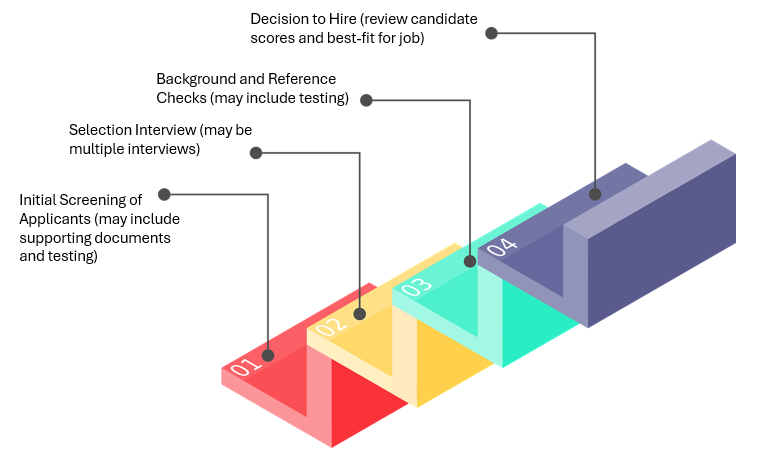
The tool most widely used in making hiring decisions is the selection interview, an in-depth discussion of an applicant’s work experience, skills and abilities, education, and career interests. For managerial and professional positions, an applicant may be interviewed by several people, including the line manager, for the position to be filled. This interview is designed to determine a person’s communication skills and motivation. During the interview, the applicant may be presented with realistic job situations, such as dealing with a disgruntled customer, and asked to describe how they would handle the problem. Some organizations have multiple interviews with candidates at various levels of management. When designing interviews, the HR department will provide the interviewer(s) with score sheets. The candidates are scored on how well they answer the questions during the interview. In Canada, it’s illegal for job applications to ask questions about race-related grounds, such as physical characteristics like eye color, hair, height, and weight. When you complete a course in career planning you will learn how to complete a successful interview.

A firm may require an applicant to have a medical checkup to ensure they are physically able to perform job tasks. In the U.S. Drug testing is common in the transportation and health care industries. Southwest Airlines, BNSF Railway, Texas Health Resources, and the U.S. Postal Service use drug testing for reasons of workplace safety, productivity, and employee health. In Canada, pre-employment drug testing could be considered discriminatory (Canadian human rights law). This is because drug and alcohol testing could reveal a person’s substance dependency and addiction and poses a risk of discrimination against the candidate if a job offer is rescinded. Unless an employer can prove that there is a bona fide occupational requirement (BFOR) for testing, it is best practice for employers not to conduct pre-employment drug testing for non-safety positions. If an employer is recruiting for a safety-sensitive position, then pre-employment drug testing could be justifiable as policy for the promotion of workplace safety. Generally, you do not need a physical exam to get a job, but certain jobs that require physical strength or endurance or jobs in the public health sector may require a physical exam. A few of these job examples include firefighter, police officer, lifeguard, truck driver, bus driver, and military personnel.
If applicants pass the selection interview, most firms examine their background and check their references. References are people who will attest to your skills and abilities because they have observed you in action. The most valuable references are those from former or current employers, as they carry the most weight with potential employers. While friends and family may offer positive feedback, hiring managers are more interested in learning about your past performance in a professional setting. In recent years, an increasing number of employers, such as American Airlines, Disney, and Microsoft, are carefully researching applicants’ backgrounds, particularly their legal history, reasons for leaving previous jobs, and even creditworthiness. If the company has not already collected supporting evidence of your credentials (e.g., educational credentials, industry certifications, etc.) then they will most likely do so at this stage. Not all job positions require that you have supporting evidence, but higher-level jobs usually do. If a candidate were to, for example, submit fraudulent credential documents and then the company were to discover this after hiring, the company would most probably terminate employment.
If an applicant successfully completes all stages of the selection process, a decision to hire is made. For higher-level positions or roles within unionized environments, this decision is often based on a combination of test results (if applicable) and interview scores. However, not all jobs require testing or a formal scoring process for interview questions. To ensure fairness and objectivity, many companies adopt scoring methods to evaluate candidates systematically. Ultimately, the job offer is extended to the candidate who best aligns with the role’s requirements and organizational needs.
Because companies can’t survive unless employees do their jobs well, it makes economic sense to train them and develop their skills. This type of support begins when an individual enters the organization and continues as long as he or she stays there.
Have you ever started your first day at a new job feeling upbeat and optimistic only to walk out at the end of the day thinking that maybe you’ve taken the wrong job? If this happens too often, your employer may need to revise its approach to orientation—the way it introduces new employees to the organization and their jobs. Starting a new job is a little like beginning college; at the outset, you may be experiencing any of the following feelings:
The employer who understands how common such feelings are is more likely not only to help newcomers get over them but also to avoid the pitfalls often associated with new-employee orientation:
Initially, when an employee is hired the organization uses an orientation program to introduce the employee to the company’s people, policies, and procedures. A good employer will take things slowly, providing you with information about the company and your job on a need-to-know basis while making you feel as comfortable as possible. You’ll get to know the company’s history, traditions, and culture over time. You’ll learn more about salary and benefits and how your performance will be evaluated. Most importantly, you’ll find out how your job fits into overall operations and what’s expected of you. Over the first few weeks, the manager should schedule check-in meetings to review expectations, progress, responsibilities and answer any questions the new employee may have. Failure to integrate new hires into a company adequately leads to low retention rates.
When you start a new job, you may enter that job role with many skills and knowledge gained through education or previous work experience. Even with some experience, knowledge, and skills your new employer will still want to provide you with training specific to the technologies, processes, and practices used by the organization.
As you grow with your new employer you will need to continually learn, after all, life is about life-long learning and our world continues to grow around us. We need to keep up with the times. Companies ensure their employees have the skills and knowledge to support company goals and for the company to remain competitive in its field. Often, employers pay for programs/courses whereby employees can update their knowledge and skills. This helps retain employees, increase employee satisfaction and brings new ideas and skills into the business.
Corporate training is essential for employee onboarding and employee retention. Onboarding is a perfect moment to deliver training. A new staff member is bursting with excitement about joining your company. Existing employees are also eager to extend and develop their skills. In any case, for the sake of learning effectiveness, the training method is as important as the content and activities.
Below are seven of the best types of employee training methods:
Why Choose this Training Course?
This PetroKnowledge training course will provide participants with comprehensive understanding of the full spectrum of oil and gas contracts. It is a highly interactive training course covering the key legal and commercial aspects of these contracts and the inherent risks in the different types of contracts. Participants will learn how to deal with negotiating, drafting and administrating these contracts in the oil and gas and marine sectors. Further, we will also focus on the pros and cons of the different types of contracts and the suitability of each one for your specific needs. We delve into specific contracts like Production Sharing Contracts (PSC), Licensing and Concessions used in upstream operations and EPCIC (Engineering, Procurement, Construction, Installation & Commissioning) Contracts, EPCM and Alliance contracts used for complex offshore and onshore projects.
How will this Training be Presented?
Participants will gain greater knowledge through presentations by an experienced international practitioner designed to both educate and challenge. This PetroKnowledge training course will utilize a variety of proven adult learning techniques to ensure maximum understanding, comprehension and retention of the information presented. This includes exercises designed to improve and sharpen the skill sets of delegates in planning, negotiating and managing Oil and Gas contracts, through interactive session with case studies, role playing and discussion groups and scenario building. The objective of the interactive sessions is to enable participants to apply the knowledge and understanding gained during the course to certain factual scenarios. This will help participants gain invaluable practical insights into managing the risks and enhancing their rewards and improving bottom lines for their corporations.
Can I Get a Customized Training Course for My Team?
Yes, PetroKnowledge offers customized in-house training solutions for organizations looking to upskill their teams. We work closely with companies to design bespoke training courses for oil and gas professionals that address specific challenges and objectives. Whether you need on-site training or online solutions, we can tailor the training courses to suit your organization’s needs.
It would be nice if employees came with all the skills they need to do their jobs. It would also be nice if job requirements stayed the same: once you’ve learned how to do a job, you’d know how to do it forever. In reality, new employees must be trained; moreover, as they grow in their jobs or as their jobs change, they’ll need additional training. Unfortunately, training is costly and time-consuming. How costly?
In a U.S. analysis of corporations and educational institutions with 100 or more employees, companies spent $954 per employee for training in 2023, and the average hours of training each employee received was 57. Services organizations spent the most per learner this year ($1,172), followed by nonprofits ($1,105). Small ($1,420) and midsize ($751) companies spent more per learner than large corporations ($481). On average, organizations allocated the biggest portions of their training budget to mandatory compliance training (13 percent), management/supervisory training (12 percent), and onboarding (11 percent). Diversity, equity, and inclusion was a new category added this year (2023)—it came in at 7 percent.
Canadian firms invest modestly in training—an estimated $240 per employee annually—and lag their international peers in rates and hours of instruction. Larger firms are more likely than smaller firms to provide training. Employers in utilities, finance and insurance, and other knowledge-based, technology-rich industries train at above-average rates, while firms in retail, forestry, and oil and gas extraction provide below-average levels of training. Firms in Québec and Ontario are more likely to provide training than firms in the Prairies or Atlantic provinces. Given their concern for return on investment (ROI), firms tend to invest in training for immediate needs—such as onboarding and orientation, technology adoption, addressing skills gaps, and implementing innovations—and favour on-the-job and at-workplace modes of delivery over classroom and other external options.
Compliance training covers the standards for a healthy working environment and teaches safety and accident prevention procedures.
Play the YouTube video below, “Planning an Effective Employee Training Program ” YouTube video below to learn about how a business can train their employees and specifically provide compliance training for employees. Transcript for “Planning an Effective Employee Training Program” Video [PDF–New Tab]. Closed captioning is available on YouTube.
Performance appraisals are structured evaluations that assess an employee’s job performance, contributions, and achievements over a defined period. The process typically includes reviewing goals, providing constructive feedback, and identifying areas for growth or development. Employees often seek clarity from their managers on three key points: what is expected of them, how well they are meeting those expectations, and how they can enhance their performance. While effective managers provide ongoing feedback, formal appraisals are generally conducted annually or semiannually. These evaluations may involve methods such as self-assessments, peer reviews, and manager evaluations. When implemented effectively, performance appraisals promote open communication, boost employee motivation, and inform decisions regarding promotions, salary adjustments, and career development. Appraisal systems differ between organizations and vary based on the employee’s role and level within the company.
The Basic Three-Step Performance Appraisal Process:
It sounds fairly simple, but why do so many managers report that, except for firing people, giving performance appraisals is their least favorite task?
Performance appraisals serve multiple purposes:
As for disadvantages, most stem from the fact that appraisals are often used to determine salaries for the upcoming year. Consequently, meetings to discuss performance tend to take on an entirely different dimension: the manager may appear judgmental (rather than supportive), and the employee may get defensive. This adversarial atmosphere can make many managers not only uncomfortable with the task but also less likely to give honest feedback. (They may give higher marks in order to avoid delving into critical evaluations.) HR professionals disagree about whether performance appraisals should be linked to pay increases. Some experts argue that the connection eliminates the manager’s opportunity to use the appraisal to improve an employee’s performance. Others maintain that it increases employee satisfaction with the process and distributes raises on the basis of effort and results.

Instead of being evaluated by one person, how would you like to be evaluated by several people—not only those above you in the organization but those below and beside you? The approach is called 360-degree feedback, and the purpose is to ensure that employees (mostly managers) get feedback from all directions—from supervisors, reporting subordinates, coworkers, and even customers. If it’s conducted correctly, this technique furnishes managers with a range of insights into their performance in a number of roles. Some experts, however, regard the 360-degree approach as too cumbersome.
“It should be no surprise that tech companies like Google and Netflix are among the adherents to 360 feedback. Another use case from our own roster of clients is the Nissan Corporation, where 360 feedback took off among its North American engineering team. It all started with a senior manager wanting to improve their leadership skills by taking the G360 Survey for Managers. Before long, 360 feedback fever had spread to other teams and different departments.”
The acronym used to refer to equity, diversity and inclusion may appear in various resources such as EDI, DEI, IDE, or IDEA, but they all represent the same concepts. Inclusion, diversity, equity, and accessibility (IDEA) are a set of practices that aim to ensure that people from a variety of backgrounds are represented and can thrive.
Most companies today strive for diverse workforces. HR managers work hard to recruit, hire, develop, and retain a diverse workforce. In part, these efforts are motivated by legal concerns: discrimination in recruiting, hiring, advancement, and firing is illegal under federal law and is prosecuted by the Canadian Human Rights Tribunal. Companies that violate anti-discrimination laws are subject to severe financial penalties and also risk reputational damage.
Reasons for building a diverse workforce go well beyond mere compliance with legal standards. It even goes beyond commitment to ethical standards. It’s good business. People with diverse backgrounds bring fresh points of view that can be invaluable in generating ideas and solving problems. In addition, they can be the key to connecting with an ethnically diverse customer base. In short, capitalizing on the benefits of a diverse workforce means that employers should view differences as assets rather than liabilities.
Equity is a process that ensures everyone has access to the same opportunities. Equity appreciates that privileges and barriers exist and, as a result, we all don’t start from the same place. Instead, each of us comes from a different background. Equity is an approach that begins with acknowledging this unequal starting place and making efforts to address and change this imbalance.
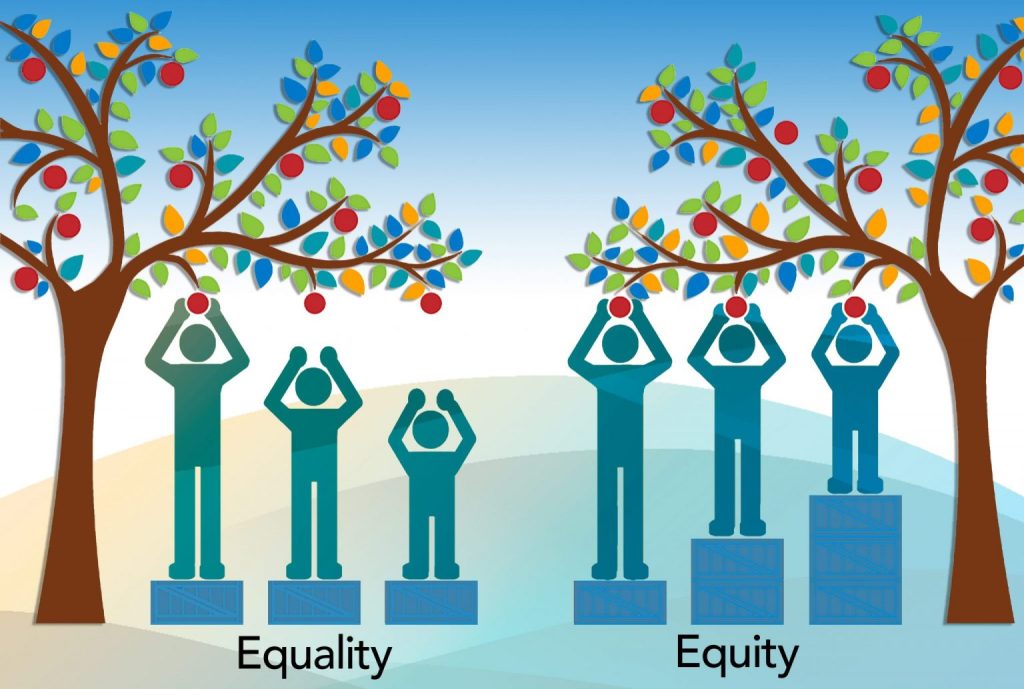
Diversity is the presence, in an organization or a community, of a wide range of people with different backgrounds, abilities and attributes including ethnicity, race, colour, religion, age, gender and sexual orientation.
Inclusion refers to taking into account differences among individuals and groups when designing something (e.g., policy, program, curriculum, building, shared space) to avoid creating barriers. Inclusion is about people with different identities feeling or being valued and welcomed within a given setting.
A key part of equity is accessibility. Accessibility is the practice of making information, activities, and/or environments sensible, meaningful, and usable for as many people as possible. As an overview:
The makeup of the Canadian workforce has changed dramatically over the past 50 years. In the 1950s, more than 70 percent was composed of males. Today’s workforce reflects the broad range of differences in the population—differences in gender, race, ethnicity, age, physical ability, religion, education, and lifestyle. A diverse workforce benefits organizations by supplying a broad range of viewpoints necessary to compete in a globalized marketplace. Such variety promotes creative problem solving with improved results. Products and services need to cater to customers and clients with diverse backgrounds, and if a company’s workforce does not understand the nuances of different cultural needs, it may be missing some opportunities.
Unfortunately, a diverse workforce can have its obstacles. Differences in culture, age, religion, and sexual orientation can create misunderstandings and conflict, even over the most well-intentioned behaviors. Therefore, it is important that employers provide effective diversity training for their employees. It is also important for co-workers to look at situations from a perspective different from their own. Modifications to workplace practices, policies or procedures, such as flexible scheduling, voluntary substitutions, swaps, job reassignments and lateral transfers, are a few examples of how an employer might accommodate an employee’s religious beliefs, practices and observances.
Following the Truth and Reconciliation Commission’s Calls to Action in 2015, corporations are struggling to engage with Indigenous communities and knowledge systems in a manner that is both ethical and meaningful. Equity, Diversity, and Inclusion (EDI) programs are tools that are utilized to address inequality in the workplace, including the inequities experienced by Indigenous populations in corporate environments. EDI initiatives that are designed for Indigenous populations in Canada must first become informed about the historic relationship between the settler government and its First Nations, Métis, and Inuit inhabitants. Corporations attempt to address the anti-Indigenous racism within their own companies by providing opportunities for their employees to engage with Indigenous culture, language, and art; offering financial support for Indigenous community non-profit organizations and the advancement of Indigenous education. If EDI principles are not sufficiently applied, corporations have established protocols and policies that are built to do so in its place. Dr Russell Evans, an Indigenous professor at the University of Windsor, speaks about the manner in which EDI and Indigenization serves to improve corporate culture for Indigenous populations and other marginalized groups.
One or more interactive elements has been excluded from this version of the text. You can view them online here: https://ecampusontario.pressbooks.pub/businessfundamentals/?p=267
What makes a company a great place to work? Ask yourself, what would you want as an employee? Flexible hours, high pay, prestige, recognition, autonomy, empowerment, interesting projects, friendly colleagues, fun events, medical benefits, or something else? We each have our own intrinsic and extrinsic motivators when it comes to work. Managers need to find ways to motivate employees to perform at a high level. This may mean motivating different employees in different ways. Many organizations offer several perks or benefits to employees in an attempt to satisfy many different employees’ needs and wants. Companies would much rather make their employees happy and retain them than have a continuous rotation of hiring new employees; it costs more to hire new employees than it does to keep existing employees. Happy employees also are shown to provide better customer service and take more interest in doing quality work. Employers strive to provide employees with a work-life balance, challenging and interesting work, and rewards that will motivate employees.
Great Place to Work® provided a 2024 list of the best places to work in Canada based on the organizations 1000+ employees that provide an outstanding employee experience. Some of the companies on the list include Cisco, SAP, Deloitte, ATB Financial, KPMG, TD Canada Trust, FedEx Express Canada, RBC, and Sun Life.
The average employee spends more than two thousand hours a year at work. If the job is tedious, unpleasant, or otherwise unfulfilling, the employee probably won’t be motivated to perform at a very high level. Many companies practice a policy of job redesign to make jobs more interesting and challenging. Common strategies include job rotation, job enlargement, and job enrichment.
Specialization promotes efficiency because workers get very good at doing particular tasks. The drawback is the tedium of repeating the same task day in and day out. The practice of job rotation allows employees to rotate from one job to another on a systematic basis, often but not necessarily cycling back to their original tasks. A computer maker, for example, might rotate a technician into the sales department to increase the employee’s awareness of customer needs and to give the employee a broader understanding of the company’s goals and operations. A hotel might rotate an accounting clerk to the check- in desk for a few hours each day to add variety to the daily workload. Through job rotation, employees develop new skills and gain experience that increases their value to the company. So great is the benefit of this practice that many companies have established rotational training programs that include scheduled rotations during the first 2-3 years of employment. Companies benefit because cross-trained employees can fill in for absentees, thus providing greater flexibility in scheduling, offering fresh ideas on work practices, and becoming promotion-ready more quickly.
Instead of a job in which you performed just one or two tasks, wouldn’t you prefer a job that gave you many different tasks? In theory, you’d be less bored and more highly motivated if you had a chance at job enlargement—the policy of enhancing a job by adding tasks at similar skill levels. The job of sales clerk, for example, might be expanded to include gift-wrapping and packaging items for shipment. The additional duties would add variety without entailing higher skill levels.
Merely expanding a job by adding similar tasks won’t necessarily “enrich” it by making it more challenging and rewarding. Job enrichment is the practice of adding tasks that increase both responsibility and opportunity for growth. It provides the kinds of benefits that, according to Maslow and Herzberg, contribute to job satisfaction: stimulating work, sense of personal achievement, self-esteem, recognition, and a chance to reach your potential.
Consider, for example, the evolving role of support staff in the contemporary office. Today, employees who used to be called “secretaries” assume many duties previously in the domain of management, such as project coordination and public relations. Information technology has enriched their jobs because they can now apply such skills as word processing, desktop publishing, creating spreadsheets, and managing databases. That’s why we now use a term such as administrative assistant instead of secretary.
Giving employees the freedom to make decisions within their roles and empowering them to take ownership of their work fosters a sense of trust and responsibility. This autonomy leads to greater job satisfaction and motivation to stay with the organization.

Work-life balance generally refers to a balance between your personal and work life. The goal is to strive to keep that balance so that we are managing stress and burnout by fulfilling other areas of our lives that aren’t swallowed up by work.
Building a career requires a substantial commitment in time and energy, and most people find that they aren’t left with much time for non-work activities. Fortunately, many organizations recognize the need to help employees strike a balance between their work and home or personal lives. By helping employees combine satisfying careers and fulfilling personal lives, companies tend to end up with a happier, less stressed, and more productive workforce. The financial benefits include lower absenteeism, turnover, and healthcare costs.
One way, companies help employees maintain a work-life balance by offering flexible work arrangements, such as remote work options, flexible hours, and compressed workweeks, allowing employees to adjust their schedules based on personal needs and preferences. This flexibility helps employees manage their time more effectively, balancing work with family, hobbies, and other responsibilities.
The accounting firm KPMG LLP is committed to help “employees balance work and their personal lives through a variety of flexible work options” and has consistently made the list of the “Canada’s Top Family-Friendly Employers”.
Remote work, also known as Telecommuting, means that you regularly work from home (or from some other non-work location). You’re connected to the office by computer and cell phone. You save on commuting time, enjoy more flexible work hours, and have more opportunity to spend time with your family.
While roughly 40% of Canadian jobs can be done from home, telework capacity varies substantially across industries. For example, about 85% of workers in finance and insurance can work remotely, compared to only 4% of those in the agricultural fields. One challenge for employers seeking to implement telework is to accommodate the diversity of employee preferences. Around 90% of Canadians feel as productive or more productive when working from home. Approximately, 41% of remote workers would prefer to work half their weekly hours remotely.
Telecommuting isn’t for everyone. Working at home means that you have to discipline yourself to avoid distractions, such as TV, personal phone calls, and home chores and also not be impacted by feeling isolated from the social interaction in the workplace.
Employers who provide for flextime set guidelines that allow employees to designate starting and quitting times. Guidelines, for example, might specify that all employees must work eight hours a day (with an hour for lunch) and that four of those hours must be between 10 a.m. and 3 p.m. Thus, you could come in at 7 a.m. and leave at 4 p.m., while coworkers arrive at 10 a.m. and leave at 7 p.m. With permission you could even choose to work from 8 a.m. to 2 p.m., take two hours for lunch, and then work from 4 p.m. to 6 p.m.
With compressed workweeks, rather than work eight hours a day for five days a week, you might elect to earn a three-day weekend by working ten hours a day for four days a week.
Under job sharing, two people share one full-time position, splitting the salary and benefits of the position as each handles half the job. Often, they arrange their schedules to include at least an hour of shared time during which they can communicate about the job.
Additionally, generous paid time off policies, including vacation days, parental leave, and personal time, give employees the opportunity to recharge and attend to personal matters without financial stress. Employers also support work-life balance by promoting wellness programs, providing access to mental health resources, and fostering a work environment that encourages employees to take breaks and disconnect from work outside of business hours. Employee Assistance Programs (EAPs) provide confidential support for personal issues, ranging from stress management to financial and legal advice.
Both KPMG LLP and BASF Canada provide employees with generous vacation allowances and personal days for employees to use in any way they want, in addition to offering employees comprehensive health and dental benefit coverage programs. Both organizations also offer an Employee Assistance Program for employees experiencing personal and/or work-related problems that may negatively affect their job performance and overall well-being. If staying fit makes you happier and more productive, BASF Canada offers a $400 fitness club subsidy and KPMG LLP offers the equivalent of 1.25% of an employee’s salary for home gym equipment.
Beyond the standard maternity and paternity leave, many companies offer extended paid parental leave for both primary and secondary caregivers. This provides employees with time to care for their new child without the financial strain of taking unpaid leave. New parents in Canada are guaranteed paid leave via Employment Insurance Maternity and Parental Benefits. BASF Canada tops-up these payments for new parents to 100% of salary for up to 17 weeks. KPMG LLP further supports new parents by providing those on leave support with their transition back to work.
Some companies offer concierge services to help employees with personal tasks such as scheduling appointments, making travel arrangements, or even organizing home services. This service allows employees to delegate time-consuming tasks, freeing up personal time for other activities.
Some employers provide on-site amenities like childcare services, dry-cleaning, fitness centers, or even grocery delivery services. These perks save employees time that would otherwise be spent outside of work, allowing them to focus on their job and personal life.
Moreover, many companies offer benefits that assist employees in managing family responsibilities, such as on-site childcare, family leave policies, or subsidies for childcare services.
In addition to alternative work arrangements, many employers, including KPMG LLP and BASF Canada, offer programs and benefits designed to help employees meet family and home obligations while maintaining busy careers. As exemplar companies, they offer the following benefits.

Caring for dependents—young children and elderly parents—is of utmost importance to some employees, but combining dependent-care responsibilities with a busy job can be particularly difficult.
Some employers provide on-site childcare which allows employees to pop-in at lunch to see their child. This also reduces time spent commuting to and from daycare and offers peace of mind knowing their child is nearby. Many employers provide access to backup or emergency childcare services for employees who experience last-minute disruptions in their regular care arrangements. This can include a network of approved childcare providers or services that offer temporary care when needed. Employers may offer financial assistance to help employees cover the cost of childcare. This could include subsidies, vouchers, or a reimbursement program that partially or fully offsets childcare expenses.
Flexible schedules, remote work, or compressed workweeks are often offered to employees with dependent care responsibilities. These arrangements allow employees to manage their work and caregiving duties more effectively by adjusting hours or working from home.
Employers are increasingly offering support for employees who care for aging parents or other elderly dependents. This can include access to elder care resources, counseling, and even subsidies for caregiving services.
The Personal Care program at KPMG LLP provides employees with up to 50 hours of paid time off annually to help with a range of personal matters. They also offer emergency backup dependent care all year round, either at a provider’s facility or in the employee’s home. KPMG LLP also has a Working Parents Network, Special Parents Network, offering support for parents raising children with physical, emotional and behavioural (virtual support group for parents raising children with physical, emotional and behavioural issues. Meanwhile, BASF Canada offers its employees a privately-run on-site childcare facility.
A company’s work culture is the shared set of values, beliefs and attitudes that guide your organization, and it’s reflected in the way customers and employees are treated. Companies create a positive work culture by fostering an environment where employees feel valued, respected, and motivated. This is achieved through clear communication of organizational values, promoting openness and transparency, and recognizing employee achievements. Emphasizing diversity, equity, and inclusion, as well as supporting work-life balance and providing opportunities for professional growth, also contributes to a positive atmosphere. Supportive leadership, team collaboration, and a healthy work environment further strengthen this culture, leading to increased employee satisfaction, engagement, and long-term success for the organization.
Regularly recognizing and appreciating employees’ hard work, contributions, and achievements boosts morale and motivation. This can be done through verbal praise, awards, or other forms of recognition, fostering a positive workplace culture where employees feel valued.
A positive workplace culture that encourages open communication, sets clear expectations about work hours, and discourages an “always on” mentality also plays a critical role in maintaining work-life balance. By promoting a healthy, supportive work environment, companies can help employees achieve a better balance between their professional and personal lives, leading to greater job satisfaction, productivity, and overall well-being.
Workplace culture impacts the types of candidates a firm attracts for open positions, and having a strong work culture also boosts productivity, decreases turnover and improves employee engagement. Work culture can have a profound impact on several significant aspects of the employee experience, like individual and team morale, workplace engagement and job satisfaction. For example, experiencing happiness in the workplace could raise employees’ productivity by 12 percent.
Research from the MIT Sloan School of Management and CultureX based on Glassdoor data identified 10 elements of culture employees care most about:
People report experiencing workplace culture most strongly through their employers’ approach to performance, recognition and celebrations and company mission and values, according to a 2022 Quantum Workplace survey. These foundational elements of work culture involve making sure employees feel their individual contributions are valued and their voices are being heard.
Researchers have pinpointed six key signs that a work culture is toxic:

In addition to salary and wages, compensation packages often include other financial incentives, such as bonuses and profit-sharing plans, as well as benefits, such as medical insurance, vacation time, sick leave, and retirement accounts. Offering attractive salaries, bonuses, and comprehensive benefits packages, including health insurance, retirement plans, and paid time off, helps ensure that employees feel valued and financially secure, making them more likely to stay with the company.
The largest, and most important, component of a compensation package is the payment of wages or salary. Salaried employees are paid the same amount each time they receive a paycheck, while wages can fluctuate depending on how many hours an employee works. The benefits of salaried employment include access to employee benefits like health insurance, greater job security, steady pay, higher income, and better chances for career advancement, while disadvantages include less flexibility and the potential for longer working hours. Wage-based employment has advantages, including greater job flexibility and fewer working hours, and disadvantages, including a lack of employment benefits, less job security, fluctuating pay, lower income, and fewer opportunities for career advancement.
Sometimes it makes more sense to pay workers according to the quantity of products that they produce or sell. Piecework pays employees based on how much work they complete. Commission is typically a percentage paid on sales or deals closed. It’s commonly used in sales and real estate jobs.
In addition to regular paychecks, many people receive financial rewards based on performance, whether their own, their employer’s, or both. Other incentive programs designed to reward employees for good performance include bonus plans and stock options.
If the company has a profitable year, and if you contributed to that success, you’ll get a bonus.
Cisco Systems Canada’s year-end bonuses—annual income given in addition to salary—are based on individual and company-wide performance. If the company has a profitable year, and if you contributed to that success, you’ll get a bonus. They refer to it as “rewarding people for their performance, not their seniority”.
Bonus plans have become quite common, and the range of employees eligible for bonuses has widened in recent years. In the past, bonus plans were usually reserved for managers above a certain level. Today, companies have realized the value of extending plans to include employees at virtually every level. The magnitude of bonuses still favors those at the top.
An employee’s profit share is paid annually as a percentage of the employee’s earnings and is based on the company’s net profit.
Nature’s Path Foods and Canadian Tire both have profit-sharing arrangements with employees. Today, many Canadian companies offer some type of profit-sharing program. Canadian Tire’s plan has long been part of its operating principles —having been around since the late 1960’s. Here’s how it works. An employee’s profit share is paid annually as a percentage of the employee’s earnings and is based on the company’s net profit. Profits in the most recent years have averaged to be about 10%. Interestingly, because this profit share is part of an employee’s retirement savings, it is put into a deferred profit-sharing account.
WestJet’s compensation plan also gives employees the right to participate in their Employee Share Purchase Plan. This enables employees to purchase WestJet shares amounting to up to 20 per cent of their gross salary and the company will match their contributions. This is used as an incentive to attract and retain good people.
U.S.-based Starbucks, by contrast, isn’t nearly as selective in awarding stock options. At Starbucks, all employees can earn “Bean Stock”—the Starbucks employee stock-option plan. Both full- and part-time employees get Starbucks shares based on their earnings and their time with the company. If the company does well and its stock goes up, employees make a profit. CEO Howard Schultz believes that Bean Stock pays off because employees are rewarded when the company does well, they have a stronger incentive to add value to the company (and so drive up its stock price). Starbucks has a video explaining their employee stock option program on this webpage.
Another major component of an employee’s compensation package is benefits— compensation other than salaries, hourly wages, or financial incentives. Types of benefits include the following:
Because Canadian health and dental plans vary, it’s difficult to know an average cost. According to MaRS, the average annual premium works out to about 15% of payroll for a smaller businesses or up to 30% of payroll for large companies.
Many workers received benefits in addition to those required by law, including vision care, semi-private hospital stays and out-of-country medical coverage. Some companies also provide benefits to permanent part-time employees who work a minimum number of hours per week.
When designing the benefits program, employers can use strategies to limit or contain costs in the longer term. These may include:
When a valued employee quits, the loss to the employer can be serious. Not only will the firm incur substantial costs to recruit and train a replacement, but it also may suffer temporary declines in productivity and lower morale among remaining employees who have to take on heavier workloads. Given the negative impact of turnover—the permanent separation of an employee from a company—most organizations do whatever they can to retain qualified employees. Compensation plays a key role in this effort: companies that don’t offer competitive compensation packages tend to lose employees. Other factors also come into play, such as training and development, as well as helping employees achieve a satisfying work/non-work balance. In the following sections, we’ll look at a few other strategies for reducing turnover and increasing productivity.
Voluntary termination is when an employee chooses to leave their job of their own accord, without pressure from their employer. It’s also known as voluntary resignation.
As important as such initiatives can be, one bad boss can spoil everything. The way a person is treated by their manager may be the primary factor in determining whether an employee stays or goes. According to the Indeed Career Guide, employees quit for many reasons, a few of which are listed below:
Holding managers accountable for excessive turnover can help alleviate the “bad-boss” problem, at least in the long run. In any case, whenever an employee quits, it’s a good idea for someone—other than the individual’s immediate supervisor—to conduct an exit interview to find out why. Knowing why people are quitting gives an organization the opportunity to correct problems that are causing high turnover rates.
Involuntary termination is when an employer ends an employee’s employment without the employee’s consent. It can happen for a number of reasons, including poor performance, unprofessional behavior, policy violations, economic factors, and organizational changes.
While voluntary separations can create problems for employers, they’re not nearly as devastating as the effects of involuntary termination on employees. Losing your job is what psychologists call a “significant life change,” and it’s high on the list of “stressful life events” regardless of the circumstances. Sometimes, employers lay off workers because revenues are down and they must resort to downsizing—to cutting costs by eliminating jobs. Sometimes a particular job is being phased out, and sometimes an employee has simply failed to meet performance requirements.
A good practice in managing terminations is to maintain written documentation so that employers can demonstrate just cause when terminating an employee. If it’s a case of poor performance, the employee would be warned in advance that his or her current level of performance could result in termination and then be permitted an opportunity to improve performance. When termination is necessary, communication should be handled in a private conversation, with the manager explaining precisely why the action is being taken.
A union is a group of workers who join together to negotiate with an employer over pay, benefits, scheduling, and other workplace policies and conditions. The process of negotiating with an employer as a unified entity is known as collective bargaining, and it gives workers some power to set the terms of their employment.
Collective bargaining is a formal negotiation process where union representatives and employers work together to create or renew a contract that sets the terms of employment, such as wages, benefits, and working conditions. When negotiations between unions and employers stall, they may use mediation or arbitration to resolve disputes. Mediation involves a neutral third party helping both sides reach a voluntary agreement, while arbitration entails a neutral arbitrator making binding decisions. If these processes fail, unions or employers may employ tactics to strengthen their positions.
Unions have several options at their disposal to pressure company management into accepting the terms and conditions union members are demanding. The tactics available to the union include striking, picketing, and boycotting.
A strike is a collective work stoppage by employees in response to an employer to force them to agree to certain terms of employment. Strikes are usually a last resort when a union and employer are unable to reach an agreement during collective bargaining.
Picketing is a labor tactic where workers gather outside a workplace to protest and persuade others to take industrial action.
A boycott is a nonviolent, organized protest where workers encourage the public to refuse to buy the company’s products or services, or participate in activities, as a way to express their disapproval. Boycotts are often used by unions to protest unfair practices and demand better working conditions and wages.
Employers might respond with a lockout, preventing workers from entering the workplace until an agreement is reached. These measures are intended to exert pressure on the opposing side to finalize negotiations.
Convincing workers to unionize can be challenging due to a combination of social, economic, and organizational factors:
Starbucks workers: On July 19, 2024, workers at a Starbucks located in The Mall at Robinson in Pittsburgh voted to unionize. On July 18, workers at a Starbucks located on Mass. Ave in downtown Indianapolis announced it would unionize with Starbucks Workers United. On July 17, workers at Starbucks location at Speedway & Park in Tucson, Arizona voted to unionize. Some 10,500 baristas at 460 Starbucks locations nationwide are now unionized with Starbucks Workers United.
Disney character workers: On May 18, 2024, about 1,700 Disneyland Resort cast members voted to unionize under the Actors’ Equity Association. On May 29, federal labor officials certified the vote.
The Canadian Union of Public Employees (CUPE) is Canada’s largest union, with 750,000 members across the country. CUPE represents workers in health care, emergency services, education, early learning and child care, municipalities, social services, libraries, utilities, transportation, airlines and more. CUPE has 68 offices across the country, in every province.
OPSEU/SEFPO represents approximately 180,000 members across Ontario. They are full- and part-time workers, young and old. They trace their ancestry to all parts of the globe – as diverse a group as you could imagine. Our members work for the Ontario government, inside community colleges, for the LCBO, in the health care sector, and they are employed in a wide range of community agencies within the broader public sector.
The United Food and Commercial Workers union (UFCW Canada) – a proud union that feeds, serves, and provides for Canada’s hard-working families. It is a private sector union with more than a quarter million members. Some of the most recognizable companies and brands are members, including Coca-Cola Canada, FreshCo, Loblaw Companies, Swiss Chalet, The Keg, Molson Breweries, Rexall, and LensCrafters. UFCW is one of Canada’s most youthful unions with more than 40 percent of UFCW Canada members under the age of 30.
Statistics Canada reports union membership across Canada from 1981 to 2022 in Figure 11.2
Review Table 11.1 below to compare the percentage of the workforce being members of labour unions in various countries as of 2019 and 2020.
| Canada | Mexico | Ireland | Malta | New Zealand | Japan | USA | Philippines |
| 29.4% | 13.2% | 25.4% | 41.9% | 18.9% | 16.8% | 10.3% | 8.5% |
Table 11.1 data source: (statista, 2022)
Review the video below to learn about what’s happening with unions in North America.
Play the YouTube video below, “Are labour unions making a comeback in North America?” YouTube video below for some time management tips for stress-free productivity. Transcript for “Are labour unions making a comeback in North America?” Video [PDF–New Tab]. Closed captioning is available on YouTube.
Check your understanding of this chapter’s concepts by completing this short self-check quiz.
An interactive H5P element has been excluded from this version of the text. You can view it online here:
https://ecampusontario.pressbooks.pub/businessfundamentals/?p=267#h5p-18
The contents of this chapter is a compilation sourced from various OER resources, please refer to the Book Information for details.
(Note: This reference list was produced using the auto-footnote and media citation features of Pressbooks)
Starbucks. (2016). Working at Starbucks. http://www.starbucks.com/careers/working-at-starbucks
Starbucks. (2016). Working at Starbucks. http://www.starbucks.com/careers/working-at-starbucks
Fortune. (2007). 100 top MBA employers. http://archive.fortune.com/magazines/fortune/mba100/2007/full_list/index.html
Cruise International. (n.d.). The Norwegian Dawn. http://www.cruise-international.com/cruise-search/ShpDetailsQuery?nShp=290&nLine=18&nOperator=Norwegian+Cruise+Line
Thompson, C. (n.d.). In Focus: Target your recruitment market. http://www.net-temps.com/recruiters/infocus/article.htm?op=view&id=662#axzz4BVFt5rJY
Lee, D. (2006). Your first task as a recruiter: Recruit senior management onto your team. https://web.archive.org/web/20130529204750/http://www.humannatureatwork.com/Recruiting-Employees.htm
LinkedIn. (n.d.). About LinkedIn. https://about.linkedin.com/#:~:text=About%20LinkedIn&text=1%20billion%20members%20in%20more%20than%20200%20countries%20and%20territories%20worldwide.
Baloun, S. (2024, January 17). Redefining recruitment: How to excel at social media recruiting in 2024. https://www.socialpilot.co/blog/social-media-recruiting
Wonderlic. (2018, February 8). The Wonderlic personnel tests. https://www.wonderlic.com
Mercer. (n.d.). Twenty-five companies that use psychometric testing for hiring. https://blog.mettl.com/companies-using-psychometric-tests/
Mercer. (n.d.). Twenty-five companies that use psychometric testing for hiring. https://blog.mettl.com/companies-using-psychometric-tests/
Vacaflor, C. (2023, October 25). Pre-employment drug testing in Canada: An employer’s guide. https://www.peninsulagrouplimited.com/ca/resource-hub/employer-advice/pre-employment-drug-testing-in-canada/
Recruiters. (n.d.). Starting a new job? These 5 feelings are completely normal. https://www.recruiters.ie/blog/starting-a-new-job-anxiety/#:~:text=These%205%20feelings%20are%20completely%20normal%201%20Nerves,4%20Stress%20and%20exhaustion%20…%205%20Loneliness%20
HRM Handbook. (n.d.) Avoiding the onboarding pitfalls: 12 worst practices that hinder new employee success. https://hrmhandbook.com/hrp/onboarding/pitfalls/#:~:text=Avoid%2012%20onboarding%20pitfalls%20for%20new%20hires%3A%20prepare,train%2C%20integrate%2C%20personalize%2C%20follow-up%2C%20involve%20managers%20%26%20coworkers.
Gore, E. (2023, February 9). 7 types of training methods (and how to choose). https://elmlearning.com/blog/training-methods/
PetroKnowledge. (2024/2025). The 10-day oil & gas contracts training. https://petroknowledge.com/courses/the-10-day-oil-and-gas-contracts-training
PetroKnowledge. (2024/2025). The 10-day oil & gas contracts training. https://petroknowledge.com/courses/the-10-day-oil-and-gas-contracts-training
PetroKnowledge. (2024/2025). The 10-day oil & gas contracts training. https://petroknowledge.com/courses/the-10-day-oil-and-gas-contracts-training
Freifeld, L. (2023, November 14). 2023 training industry report. https://trainingmag.com/2023-training-industry-report/#:~:text=Average%20training%20expenditures%20for%20large%20companies%20decreased%20from,companies%20rose%20from%20%24368%2C891%20to%20%24459%2C177%20in%202023.
LMIC. (2023, March). Employer-sponsored skills training: A picture of skills training opportunities provided by Canadian employers. https://lmic-cimt.ca/employer-sponsored-training/
HR360Inc. (2018, November 9). Planning an effective employee training program . [Video]. YouTube. https://www.youtube.com/watch?v=AZjnBPDYh2Y&t=123s
Heathfield, S. (2018). Performance appraisals don’t work: The traditional performance appraisal process. About Money. http://humanresources.about.com/od/performanceevals/a/perf_appraisal.htm
Archer North & Associates. (2010). Reward Issues. http://www.performance-appraisal.com/rewards.htm
OneAdvanced. (2024, December 8). 8 reasons why 360-degree feedback fails. https://www.oneadvanced.com/news-and-opinion/8-reasons-why-360-degree-feedback-fails/
G360 Surveys. (n.d.). Examples of companies that use 360 degree feedback. https://g360surveys.com/examples-of-companies-that-use-360-feedback/
General Assembly. (2020, May 24). What’s the difference between diversity, inclusion, and equity? https://generalassemb.ly/blog/diversity-inclusion-equity-differences-in-meaning/
University of Southern Queensland. (2022). Enhancing Inclusion, Diversity, Equity and Accessibility (IDEA) in Open Educational Resources (OER). https://usq.pressbooks.pub/diversityandinclusionforoer/front-matter/definitions/
University of Southern Queensland. (2022). Enhancing Inclusion, Diversity, Equity and Accessibility (IDEA) in Open Educational Resources (OER). https://usq.pressbooks.pub/diversityandinclusionforoer/front-matter/definitions/
SeeWriteHear. (n.d.) What is accessibility? https://www.seewritehear.com/learn/what-is-accessibility/
Usalcas, J. & Kinack, M. (2017). History of the Canadian Labour Force Survey, 1945 to 2016. Statistics Canada. https://www150.statcan.gc.ca/n1/en/pub/75-005-m/75-005-m2016001-eng.pdf?st=VUjdeAww
University of Windsor & Ryerson University. (2022). Indigenous lifeways in Canadian business. https://ecampusontario.pressbooks.pub/indigenousbusinesstopics/chapter/chapter-1/
Great Place to Work®. (2024). Best workplaces in Canada in 2024. https://www.greatplacetowork.ca/en/best-workplaces-in-canada-2024-over-1000-employees
Kerka, S. (1995). The changing role of support staff. http://www.calpro-online.org/eric/docgen.asp?tbl=archive&ID=A019
Forsythe, G. (2019). Fundamentals of Business: Canadian Edition. https://openlibrary.ecampusontario.ca/catalogue/item/?id=9d2935f5-c088-4207-a25f-a813dce8e5ae
Forsythe, G. (2019). Fundamentals of Business: Canadian Edition. https://openlibrary.ecampusontario.ca/catalogue/item/?id=9d2935f5-c088-4207-a25f-a813dce8e5ae
Bush, O. (2024, November 4). Working from home statistics in Canada. https://madeinca.ca/working-from-home-canada-statistics/
Yerema, R. & Leung, K. (2018). KPMG LLP: Recognized as one of Canada’s top 100 employers (2019). https://content.eluta.ca/top-employer-kpmg
Yerema, R. & Leung, K. (2018). BASF Canada Inc: Recognized as one of Canada’s top 100 employers (2019). https://content.eluta.ca/top-employer-basf-canada
Heinz, K. (2024, May 21). What is work culture? 12 ways to build a positive environment. https://builtin.com/company-culture/positive-work-culture
Heinz, K. (2024, May 21). What is work culture? 12 ways to build a positive environment. https://builtin.com/company-culture/positive-work-culture
Indeed Editorial Team. (2024, July 23). Wages vs. salary: Differences, advantages, and disadvantages. https://ca.indeed.com/career-advice/career-development/wages-vs-salary
Cisco. (n.d.). Benefits and perks. https://www.cisco.com/c/en/us/about/careers/we-are-cisco/benefits-and-perks.html#~stickynav=1
Canadian Tire. (n.d.). Distribution center careers. https://corp.canadiantire.ca/English/careers/distribution-centres/default.aspx
Starbucks. (n.d.). About bean stock. https://starbucksbeanstock.com/en-us/
Canada Life. (2021, December 1). Insights & advice. https://www.canadalife.com/insurance/business-insurance/cost-of-benefits-for-employers.html
MaRS. (n.d.). Employee benefits and benefits packages: What Ontario employers should know. https://learn.marsdd.com/article/employee-benefits-and-benefits-packages-what-ontario-employers-should-know/
Smith, G. P. (2017). 5 tips to attract, keep and motivate your employees. http://www.businessknowhow.com/manage/attractworkforce.htm
Indeed Editorial Team. (2024, September 9). 16 reasons why employees choose to leave their jobs. https://www.indeed.com/career-advice/career-development/reasons-employees-leave
Phaneuf, T. (2023, November 29). What is a union and how does a union work? https://www.nerdwallet.com/article/finance/what-is-a-union
Helhoski, A. (2024, July 31). What Is a union and how does a union work?https://www.nerdwallet.com/article/finance/what-is-a-union
CUPE. (n.d.). About us. https://cupe.ca/about-us
OPSUE/SEFPO. (n.d.) About us. https://opseu.org/about/
UFCW Canada. (n.d.). About our union. https://www.ufcw.ca/index.php?option=com_content&view=article&id=59&Itemid=2&lang=en
Statistics Canada. (2022, November 23). Unionization in Canada, 1981 to 2022. https://www150.statcan.gc.ca/n1/pub/36-28-0001/2022011/article/00001-eng.htm
statista. (2022, May). Countries with the highest percentage share of their workforce being members of labor unions worldwide as of 2020. https://www.statista.com/statistics/1356735/labor-unions-most-unionized-countries-worldwide/
Young Entrepreneurs Forum. (2016, August 15). Are labour unions making a comeback in North America? [Video]. YouTube. https://www.youtube.com/watch?v=Oc0nOIsrns4&t=265s
12
After reading this chapter, you should be able to do the following:
Business information refers to collective data related to a company and its operations, including statistical information, raw analytical data, customer feedback, and sales numbers.
In today’s fast-evolving digital era, businesses depend heavily on data and information for operations, customer relations, innovation, and strategic planning. The effective use and management of information have become fundamental to achieving organizational goals. While the benefits of robust information systems are significant, they come with challenges, particularly in ensuring security and effective utilization.
The integration of technology in modern business has brought about a revolutionary transformation by automating processes and enhancing efficiency. Today, businesses are leveraging technology to gain a competitive edge, improve customer experience, and optimize resource allocation. Emerging technologies such as artificial intelligence (AI), machine learning (ML), and robotic process automation (RPA) are now part of a solid business strategy. These technologies help businesses to streamline operations, reduce human error, and optimize resource allocation. For instance, AI-powered chatbots can help businesses to provide 24/7 customer support, while RPA can automate repetitive tasks, thus freeing employees to focus on more complex tasks.
Big data refers to datasets that are so large and complex that traditional data-processing methods cannot handle them. Its defining characteristics are volume, velocity, variety, veracity, and value (the 5Vs). Organizations use big data to gain actionable insights by analyzing patterns and trends across various domains. It impacts various sectors, including transportation, finance, marketing, and healthcare.

Here are a few ways some companies use Big Data:
The financial industry puts Big Data and analytics to highly productive use, for:
Big data presents challenges in storage, processing, and ensuring the accuracy of analyses. Companies need robust infrastructures and skilled professionals to extract meaningful insights from massive datasets.
Data security is paramount to protect sensitive information from breaches, unauthorized access, and cyberattacks. As businesses store vast amounts of data, securing this information is critical to maintaining customer trust and meeting regulatory requirements. For example, financial institutions implement advanced cybersecurity measures, such as anomaly detection systems, to protect customer data. The 2017 Equifax data breach exposed the personal data of over 147 million individuals due to unpatched software vulnerabilities, underscoring the importance of proactive cybersecurity measures.
A few of the major threats include:
A few of the best practices include:
Effective information sharing is crucial for fostering collaboration and improving decision-making both within and across organizations. For instance, supply chain partners exchange real-time inventory data to streamline logistics, minimize delays, and enhance operational efficiency. While seamless information flow supports collaboration, it also introduces potential risks, particularly in terms of data security and privacy. To mitigate these risks, companies rely on secure communication platforms such as Slack or Microsoft Teams, implementing stringent access controls to safeguard sensitive information. A notable example is McDonald’s, which collects and analyzes data from its global outlets to refine its drive-thru service, optimize customer experiences, and customize its digital offerings based on local preferences and patterns. By balancing efficient information sharing with robust security measures, companies can unlock operational efficiencies while protecting their data.
While information sharing offers significant benefits, it also carries inherent risks. Shared data can be misappropriated or lead to privacy violations, and the use of interconnected networks can amplify the risk of a breach affecting multiple stakeholders simultaneously. This makes it essential for organizations to prioritize security when facilitating the exchange of information.
Fortunately, advancements in technology provide robust solutions to ensure secure information sharing. Blockchain technology, for instance, guarantees data integrity and secure transactions in decentralized environments, making it ideal for safeguarding shared information. Additionally, secure file sharing platforms like Dropbox Business and Google Workspace offer controlled access to sensitive data, enabling organizations to manage permissions and protect confidential information while still fostering collaboration. These technologies help mitigate the risks associated with information sharing by providing a secure, transparent, and efficient means of exchanging data.
Play the YouTube video below, “What are the Six Important Business Objectives of Information Technology?” to learn more about how technology supports business processes. Transcript for “What are the Six Important Business Objectives of Information Technology?” Video [PDF–New Tab]. Closed captioning is available on YouTube.
Data mining is the process of extracting valuable patterns, trends, and relationships from large volumes of data. Businesses leverage various techniques such as clustering, classification, and predictive modeling to uncover actionable insights that drive decision-making and strategic initiatives. Two common examples of data mining applications are:
By utilizing data mining, organizations can gain deeper insights into their operations, enhance decision-making, and improve customer experiences. Data mining helps businesses identify market trends, predict consumer behavior, and reduce business risk by uncovering hidden patterns in customer data.
Information mining, on the other hand, is sometimes used as a broader term that encompasses the process of gathering, analyzing, and extracting knowledge from various sources, not just data. It can refer to the process of mining both structured data (e.g., databases) and unstructured information (e.g., text documents, websites, or social media content) to uncover valuable insights. While data mining focuses primarily on the extraction of patterns from large datasets, information mining may involve a more general exploration of data and unstructured information for knowledge discovery. In many cases, especially in business and analytics, the terms overlap, and “data mining” is more commonly used to describe the specific practice of extracting valuable patterns from large data sets.
Visualization converts data into graphical representations, making complex datasets easier to understand and interpret. Popular tools include Tableau, Power BI, and Google Charts. Netflix uses advanced visualization to analyze viewer data and recommend personalized content, increasing customer retention and satisfaction.
Information mining and visualization facilitates quick understanding of trends and anomalies and enhances communication of findings to stakeholders.
Despite the advantages, these technologies come with challenges such as privacy concerns and ethical dilemmas. Organizations must balance innovation with regulatory compliance to build trust with customers and stakeholders.
Information management encompasses the collection, storage, organization, and distribution of information to optimize business operations and decision-making. Managing large volumes of information comes with some challenges. It requires balancing accessibility with security and avoiding information silos that hinder collaboration.
Some of the key elements in information management include:
A few trends in information management include:
Business information plays a crucial role in today’s competitive environment. Leveraging big data, ensuring data security, adopting efficient information-sharing mechanisms, and using visualization tools can provide significant advantages. However, these benefits come with challenges, including cyber threats, compliance requirements, and data overload. Organizations must adopt best practices in information management and invest in emerging technologies to stay resilient and competitive in a data-driven world.
Check your understanding of information management concepts by completing this short self-check quiz.
An interactive H5P element has been excluded from this version of the text. You can view it online here:
https://ecampusontario.pressbooks.pub/businessfundamentals/?p=275#h5p-34
Risk is defined according to its context. For example, if you are camping in the woods there is the risk of meeting a bear; if you are walking down stairs there is the risk of falling; if you are investing in stocks there is the risk of losing money, if you are hiring a new employee there is the risk they won’t work out, and so on.
Business risk refers to the potential for a company to experience financial losses or other challenges that could impact its ability to achieve its objectives. These risks arise from uncertainties in the internal and external environment in which the business operates.
Organizations face a wide array of uncertainties that can disrupt operations, threaten profitability, and damage reputation. Whether it’s market volatility, technological disruptions, or regulatory changes, the ability to anticipate, assess, and mitigate risks has become a crucial part of successful management. This is where risk management comes into play. Risk management is how organizations anticipate and address potential threats. Risk management in business is a structured process that identifies, evaluates, and mitigates risks to minimize their impact.
Understanding the various types of risks helps leaders create a risk mitigation plan tailored to their specific industry. Here’s a look at some key risk categories:

Real risks are backed by data, evidence, or historical trends. They are measurable and often require proactive mitigation. For example, there is a real risk of a car accident when driving on icy roads during a Canadian winter. This is a genuine hazard as icy conditions have been proven to increase the likelihood of accidents. Individuals can mitigate this risk by installing winter tires, reducing speed, and checking weather reports. A real risk to a manufacturing company is supply chain disruptions due to geopolitical tensions or natural disasters. These risks can halt production or increase costs. By diversifying suppliers, maintaining inventory buffers, and creating contingency plans a manufacturing company can mitigate this risk.
Perceived risks are based on feelings, fears, or assumptions and may lack concrete evidence. They often result from misinformation, cognitive biases, or heightened awareness. For example, some people have a fear of flying in an airplane due to hearing about high-profile crashes or turbulence, despite the fact that air travel is statistically much safer than driving. The perception arises from media coverage and the dramatic nature of plane crashes compared to car accidents. A perceived risk for a business starting up is competition from established companies within its market. While this is a valid concern, the more pressing real risk might be inadequate cash flow or poor internal management, which pose a higher likelihood of failure. The perceived risk may distract management from addressing the more immediate operational risks.
It’s important to differentiate real risks from perceived risks in both personal and business contexts. This allows individuals and companies to allocate resources and attention effectively to mitigate genuine threats while avoiding unnecessary anxiety or misdirection.
Risk tolerance in a business context refers to the degree of uncertainty and potential loss an organization is willing to accept to achieve its objectives. It reflects the company’s capacity and willingness to take on risks as part of its strategy and decision-making processes.
Factors influencing business risk tolerance include:
A startup investing heavily in research and development (R&D) for an untested product is an example of high risk tolerance. While the potential for failure is high, the company is willing to take the risk for significant market rewards. Example: Tesla’s early years involved large investments in electric vehicle technology without guaranteed returns.
A family-owned retail business focusing on incremental growth and avoiding aggressive expansion to preserve stability is an example of low risk tolerance. Example: A local grocery store choosing to maintain its single location rather than expanding into new markets.
Risk tolerance must align with the company’s mission, values, and objectives to avoid taking on unnecessary risks or missing growth opportunities. Businesses must periodically reassess their risk tolerance to adapt to changing internal and external conditions, such as market shifts, economic downturns, or technological advancements.
Personal risk tolerance refers to an individual’s ability or willingness to accept uncertainty and potential loss in pursuit of a goal. It plays a critical role in decision-making, particularly in areas like investments, career choices, and lifestyle decisions. While personal risk tolerance focuses on individual comfort and goals, business risk tolerance considers organizational objectives, resources, and stakeholder expectations. However, both require balancing the potential for loss with the pursuit of rewards.
Risk management is the structured process of identifying potential threats, evaluating their likelihood and impact, and developing strategies to minimize or eliminate their adverse effects. By integrating risk management into their decision-making processes, organizations can not only safeguard their assets but also seize opportunities that arise from taking calculated risks.
The five primary steps in risk management are as follows:
Best business practices in risk management include:

Proactive risk management helps businesses safeguard operations, protect resources, and adapt to uncertainties effectively.
To mitigate business risks, companies can take a variety of proactive measures designed to identify, mitigate, and manage risks.
Here are several strategies businesses can adopt:
By taking these steps, businesses can significantly reduce risks and increase their resilience in the face of uncertainties. Proactively managing risks and having plans in place can help companies avoid disruptions and maintain their long-term success.
Risk management helps organizations anticipate and address potential threats and uncertainties in areas such as:
Risk management is equally important in project management, where uncertainties and potential risks can significantly impact project success. By incorporating risk management into project planning and execution, project managers can identify potential obstacles, allocate resources effectively, and implement contingency plans to minimize project delays and cost overruns. Almost everything that happens in a business is a project. For example, developing a new product, implementing a new process, hiring a new employee, upgrading to a new computer system–all business projects. Most likely you will be part of one of these types of project teams in the future.
Creating a comprehensive project plan is crucial for ensuring the smooth execution and successful completion of any project. A well-structured plan serves as a strategic guide, detailing the tasks, timelines, required resources, and project objectives necessary to meet the desired outcomes. For example, consider a large organization undertaking the implementation of an enterprise resource planning (ERP) system.
To manage potential project risks effectively, the organization could take several key actions:
Project management tools can help reduce risks. Tools like Trello, Asana, Monday.com and Microsoft Project help organize tasks, track progress, and manage resources. Gantt Charts and PERT Charts are visual timelines that show project progress against deadlines. While both visualize timelines, Gantt charts are more explicit about specific dates, whereas PERT charts emphasize task relationships and sequences without necessarily focusing on calendar-specific details. Many project managers use both tools together for comprehensive project planning and execution. RiskWatch is risk management software that tracks and analyzes risks.
Information technology (IT) is another sector where risk management is of utmost importance. With the increasing reliance on digital systems and the rise of cyberthreats, organizations must implement robust risk management practices to protect sensitive data, maintain system integrity, and ensure business continuity. Cybersecurity risks, such as data breaches and malware attacks, can have severe consequences, including financial losses and reputational damage.
Information risk management is defined as the policies, procedures, and technology an organization adopts to reduce the threats, vulnerabilities, and consequences that could arise if data is not protected.
To continuously manage information risk, a business should do the following:
In the financial sector, risk management is crucial for banks, insurance companies, and investment firms. These institutions face a wide range of risks, including credit risk, market risk, operational risk, and liquidity risk. Effective risk management practices in the financial industry help ensure stability and prevent financial crises. Canadian financial institutions face an increasingly complex regulatory web as regulators in Canada and globally are imposing greater pressures to assess, monitor and mitigate regulatory and operational risks. Also, today’s financial institutions need to keep up with new regulations, deal with new issues, including those created by remote work and emerging technologies, and manage the human resources and technological requirements to get the job done. The speed of change is rapid and the demands are increasing.
Risk management in the financial world is the process of identification, analysis, and acceptance or mitigation of uncertainty in investment decisions. Essentially, risk management occurs when an investor or fund manager analyzes and attempts to quantify the potential for losses in an investment.
A few of the alternatives financial institutions might choose to mitigate to risk include:
JPMorgan Chase uses advanced data analytics and stress-testing models to manage its credit and market risk exposures. It also employs a robust cybersecurity framework to protect against data breaches, integrating these efforts into its broader enterprise risk management strategy.
The financial industry’s reliance on technology, global markets, and complex financial instruments underscores the importance of a proactive and comprehensive approach to risk management.

The healthcare industry relies heavily on risk management to ensure patient safety and quality of care. Health care organizations face risks related to medical errors, patient privacy breaches, and regulatory compliance. By implementing robust risk management strategies, providers can identify and mitigate potential risks, leading to improved patient outcomes and reduced legal liabilities.
Risks in health care include medication errors, patient safety incidents (e.g., falls, infections), data breaches involving patient records, and legal risks from malpractice claims. Strategies to reduce risks might include staff training, installing electronic health records with safety checks, and ensuring compliance with infection control protocols.
Some challenges experienced in the health care sector include balancing patient care with cost control, integrating new technologies without compromising security, and navigating evolving regulations and industry standards.
Risk management in healthcare requires a proactive and multidisciplinary approach, involving clinicians, administrators, and compliance experts to create a safe and efficient care environment.
Supply chain management is yet another area where effective risk management is critical. Supply chains are vulnerable to various risks, such as disruptions in logistics, supplier failures, and natural disasters. By implementing risk management strategies, organizations can identify potential vulnerabilities, establish alternative supply sources, and develop contingency plans to minimize the impact of supply chain disruptions.
Here are a few examples of supply chain risks:
Technological Tools in Supply Chain Relationship Management that help monitor and reduce risks:
Supply chain risk management is a critical component of modern business operations, enabling companies to proactively handle disruptions, reduce costs, and improve their resilience. By using a combination of strategic planning, risk assessment, and technological solutions, companies can minimize vulnerabilities and maintain a competitive edge even in times of uncertainty.

The choice of risk response for an organization depends on:
Risk response strategies include:
An example, a software company identifies the risk of data breaches in its cloud storage services. It may choose one of the following risk responses:
Risk response planning ensures risks are managed proactively, helping businesses achieve their objectives while minimizing potential disruptions.
There are a number of risk management standards designed to consolidate best practice principles and help to streamline and improve risk management implementations for businesses. Another factor driving the standardization of risk management frameworks has been the increased scrutiny that organizations must face with regard to their risk management systems. Risk management systems are often required to stand up to rigorous internal audits and assessments, in order to prove that they are effective in their implementation, and that they are in line with company goals and objectives.
The family of risk management standards defined by ISO 31000 is one such example of a leading international standardization of a risk management approach.
ISO refers to the International Organization for Standardization; the 31000 portion refers to a family of standards for risk management. As well as being an umbrella term for a bunch of different standards, ISO 31000 also refers to a singular standard, specifically known as ISO 31000:2018. This standard defines a set of guidelines for managing risk, designed to be used by organizations of any size, working in any area, to implement effective risk management systems. Unlike many other ISO standards like 9001 for quality management, or 14001 for environmental management, ISO 31000 is a set of guidelines. That means you can’t get an ISO 31000 certification in the same way you could for other standards with specific requirements. Nonetheless, ISO 31000 is a leading framework for organizations seeking to get started with risk management.
There are several standards organizations and committees that have developed risk management frameworks, guidance, and approaches that business teams can leverage and adapt for their own company.
Some of the more popular risk management frameworks available include:
Each of these frameworks provides valuable insights and methods for organizations to manage risks effectively, but the choice of framework depends on the organization’s industry, structure, and specific risk management needs.
In the dynamic landscape of business and technology, the importance of effective risk management cannot be overstated. The ever-evolving global environment brings forth new challenges and opportunities that demand a proactive and adaptive approach to risk.
Here are six of the key risk management trends shaping the corporate landscape (in 2024):
Check your understanding of risk management concepts by completing this short self-check quiz.
An interactive H5P element has been excluded from this version of the text. You can view it online here:
https://ecampusontario.pressbooks.pub/businessfundamentals/?p=275#h5p-35
The contents of this chapter is a compilation sourced from various OER resources, please refer to the Book Information for details.
(Note: This reference list was produced using the auto-footnote and media citation features of Pressbooks)
Indeed Editorial Team. (2024, August 15). What is data in business? (Plus importance and examples). https://www.indeed.com/career-advice/career-development/data-in-business
Arora, R. (2024, August 23). Technology in today’s business world. https://www.m-inc.com/article/the-role-of-information-technology-in-todays-business-world/
U-Tech Electronics. (n.d.). The impact of technology on modern business: A comprehensive analysis. https://utech.co/blog/the-impact-of-technology-on-modern-business/
Hillier, W. (2023, September 23). What are some real-world examples of big data? https://careerfoundry.com/en/blog/data-analytics/big-data-examples/
MongoDB. (n.d.). 9 big data examples & use cases. https://www.mongodb.com/resources/basics/big-data-explained/examples
MongoDB. (n.d.). 9 big data examples & use cases. https://www.mongodb.com/resources/basics/big-data-explained/examples
Equifax. (n.d.). Equifax. https://www.equifax.com/
Hillier, W. (2023, September 23). What are some real-world examples of big data? https://careerfoundry.com/en/blog/data-analytics/big-data-examples/
BusinessGuide360. (2024, November 30). What are the six important business objectives of information technology?. [Video]. YouTube. https://www.youtube.com/watch?v=4IvdzLRyDSo
Hillier, W. (2023, September 23). What are some real-world examples of big data? https://careerfoundry.com/en/blog/data-analytics/big-data-examples/
Hillier, W. (2023, September 23). What are some real-world examples of big data? https://careerfoundry.com/en/blog/data-analytics/big-data-examples/
MongoDB. (n.d.). 9 big data examples & use cases. https://www.mongodb.com/resources/basics/big-data-explained/examples
MongoDB. (n.d.). 9 big data examples & use cases. https://www.mongodb.com/resources/basics/big-data-explained/examples
Peterson, O. (2019, August 9). The ultimate risk management guide: Everything you need to know. https://www.process.st/risk-management/
Peterson, O. (2019, August 9). The ultimate risk management guide: Everything you need to know. https://www.process.st/risk-management/
IMD. (2024, November). Risk management: Understanding the basics and importance. https://www.imd.org/blog/management/risk-management/
OpenAI. (2023). ChatGPT (Jan 21 version) [Large language model]. https://chat.openai.com
Holmes, R. (2024, June 4). What is information risk management? https://www.bitsight.com/blog/what-is-information-risk-management
Holmes, R. (2024, June 4). What is information risk management? https://www.bitsight.com/blog/what-is-information-risk-management
BCCampus. (2022). Fundamentals of business. https://pressbooks.bccampus.ca/fundamentalsbusiness/chapter/chapter-17-financial-decisions-and-risk-management/
OpenAI. (2023). ChatGPT (Jan 21 version) [Large language model]. https://chat.openai.com
OpenAI. (2023). ChatGPT (Jan 21 version) [Large language model]. https://chat.openai.com
OpenAI. (2023). ChatGPT (Jan 21 version) [Large language model]. https://chat.openai.com
OpenAI. (2023). ChatGPT (Jan 21 version) [Large language model]. https://chat.openai.com
Peterson, O. (2019, August 9). The ultimate risk management guide: Everything you need to know. https://www.process.st/risk-management/
Villanueva, E. (2023, August 16). Risk management 1010: Process, examples, strategies. https://www.auditboard.com/blog/risk-management-101/
Aragon Research. (2024, January 5). 6 emerging risk management trends in 2024. https://aragonresearch.com/6-emerging-risk-management-trends-in-2024/
13
After reading this chapter, you should be able to do the following:
Before we go any further, you need to understand a couple of key concepts. First, just what, exactly, do is meant by personal finances? Finance itself concerns the flow of money from one place to another, and your personal finances concern your money and what you plan to do with it as it flows in and out of your possession. Essentially, then, personal finance is the application of financial principles to the monetary decisions that you make either for your individual benefit or for that of your family.
Second, as suggested earlier, monetary decisions work out much more beneficially when they’re planned rather than improvised. Thus, our emphasis on financial planning—the ongoing process of managing your personal finances in order to meet goals that you’ve set for yourself or your family.
Financial planning requires you to address several questions, some of them relatively simple:
Others will require some investigation and calculation:
Still others will require some forethought and forecasting:
Another question that you might ask yourself—and certainly would do if you worked with a professional in financial planning—is, “How will my financial plans change over the course of my life?” Figure 13.3 illustrates the financial planning life cycle of a typical individual—one whose financial outlook and likely outcomes are probably a lot like yours. As you can see, the diagram divides this individual’s life into three stages, each of which is characterized by different life events (such as beginning a family, buying a home, planning an estate, retiring).
At each stage, there are recommended changes in the focus of the individual’s financial planning:
At each stage, of course, complications can set in—changes in such conditions as marital or employment status or in the overall economic outlook, for example. Finally, as you can also see, your financial needs will probably peak somewhere in stage 2, at approximately age 55, or 10 years before typical retirement age.
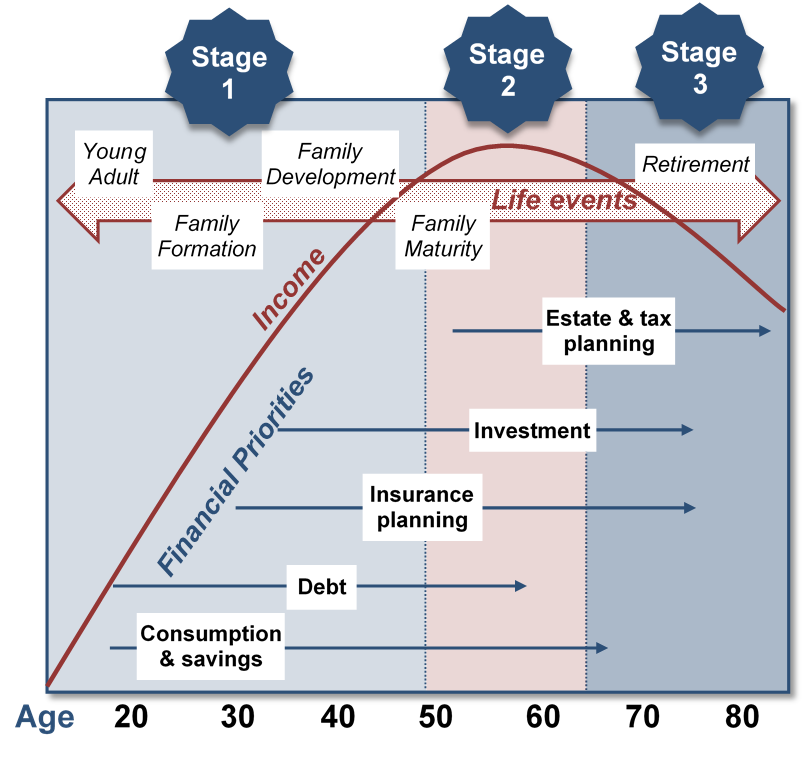
Until you’re on your own and working, you’re probably living on your parents’ wealth right now. In our hypothetical life cycle, financial planning begins in the individual’s early twenties. If that seems like rushing things, consider a basic fact of life: this is the age at which you’ll be choosing your career—not only the sort of work you want to do during your prime income-generating years, but also the kind of lifestyle you want to live.
Your “personal debt” is how much money you owe to other people, businesses, banks, credit card companies, and other creditors. Do you sometimes wonder where your money goes? Do you worry about how you’ll pay off your student loans? Would you like to buy a new car or even a home someday and you’re not sure where you’ll get the money? If these questions seem familiar to you, you could benefit from help in managing your personal finances.
Let’s say that you’re 28 and single. You have a good education and a good job—you’re pulling down $60K working with a local accounting firm. You have $6,000 in a retirement savings account, and you carry three credit cards. You plan to buy a condo in two or three years, and you want to take your dream trip to the world’s hottest surfing spots within five years. Your only big worry is the fact that you’re $70,000 in debt, due to student loans, your car loan, and credit card debt. In fact, even though you’ve been gainfully employed for a total of six years now, you haven’t been able to make a dent in that $70,000. You can afford the necessities of life and then some, but you’ve occasionally wondered if you’re ever going to have enough income to put something toward that debt.
With increased demand for college education, students are willing to take on debt for the potential benefits, such as better earning potential and more job opportunities.
Here are a few statistics (2022/2023) about Canadians student loans:
Your potential savings from refinancing will vary based on your loan terms. For example, say you have a $50,000 loan balance with a 6.22% interest rate — the average student loan interest rate for graduate students. On the standard 10-year repayment plan, you’d pay $561 per month and $17,277 in interest over time.
College and university graduates earn significantly more per year than those without these credentials throughout their careers. Statistics Canada provides the following statistics from 2020 within Ontario’s 35-44-year-old population:
Naturally, there are exceptions to these average outcomes. You’ll find some college graduates stocking shelves or serving coffee, and you’ll find college dropouts running multibillion-dollar enterprises. Microsoft cofounder Bill Gates dropped out of college after two years, as did his founding partner, Paul Allen. Generally, a college or university education opens doors to increased job opportunities, increased earning potential, and a path to advancement.
A few ways to get out of personal debt include consolidating debt, increase your income, create a budget, reduce monthly bills, curb impulse spending, use a debt repayment strategy, consider credit counselling, use cashback rewards, scale back on savings temporarily, and create an emergency fund. Bankruptcy is a final option, but not the best one as it negatively affects your future credit rating.
Here are some ways to get out of personal debt:
By following these steps, you can begin to regain control of your finances and work toward becoming debt-free.
If you’re unable to get out of debt, you may need to consider bankruptcy. However, bankruptcy is a lengthy process and it won’t erase all debts, like student loans. It can also ruin your credit rating and make it difficult to get loans or credit for future years.
A budget is a plan that helps you manage your money. It helps you figure out how much money you get, spend, and save. Making a budget can help you balance your income with your savings and expenses. It guides your spending to help you reach your financial goals (Government of Canada, n.d.). To learn how to make a personal budget and stick to it, visit Making a Budget from the Financial Consumer Agency of Canada.
Apps like Mint, YNAB (You Need a Budget), or Excel spreadsheets can simplify budgeting and track spending. Regularly review of the budget is important to ensure you stay on track and you will need to adjust categories if unexpected expenses arise or your priorities change.
A budget is especially important if you:
Making a budget can help you:
Below are a few suggestions on how college students can more effectively manage their money while furthering their education:
Creating and using a budget is not just for those who need to closely monitor their cash flows from month to month because money is tight. Almost everyone can benefit from budgeting. Building the right college student budget for your situation can help you stay on track for your financial life after graduation. Plus, learning to build and maintain a budget is an important skill to carry with you for the rest of your life. If you aren’t sure how to create the perfect college budget that works for you, then check out this free budgeting course. It will walk you through the steps of building a budget that actually sticks.
One of the best ways to manage your money and personal finances is to build a personal budget.
A personal budget (for an individual) or household budget (for a group sharing a household) is a plan for the coordination of income and expenses.
You will need to have all your information gathered. This includes what you bring in – from employment to student loans – and what goes out – for food, entertainment, health and wellness, rent, utilities, etc. Be honest and thorough.
The Government of Canada, through the Financial Agency of Canada, created a tool that provides an in-depth account of your personal finances. Use the Budget Calculator to document your situation. Export your budget as an Excel spreadsheet. You will now be able to make improvements, if appropriate. If your balance is negative, or when your expenses exceed your income, you need to make some choices based on what you learned when you tracked your spending. Ask yourself some tough questions:
After you have made some difficult choices, turn back to the budget worksheet and create a new “revised” column. You will want to work toward achieving a positive balance.
Should you end up with a surplus or positive balance, you need to make some choices about what to do with the extra money. Perhaps you could put it toward your financial SMARTER goal. Avoid the temptation to spend it.
Here are a few suggestions to help you reduce your monthly bills:

Here are a few suggestions to help you curb impulse spending:
You’ll probably be surprised at how much of your money can quickly become somebody else’s money. If, for example, you spend $3 every day for one cup of coffee at a coffee shop, you’re laying out nearly $1,100 a year just for coffee. If you use your ATM card at a bank other than your own, you’ll probably be charged a fee that can be as high as $3. If you do this even twice per month, that adds up to $72 per year in ATM fees. To avoid ATM fees choose a bank with no ATM fees or a bank that refunds ATM fees for student accounts. You might also consider spending on your credit card then paying off the balance each month. To do this you must be self-disciplined in not charging more than you have saved for. This way you won’t pay so many bank fees, nor will you pay interest on your credit card balances. Planning ahead, reading the fine print, and making sure you’re knowledgeable about the banking services you’re using, are the three most important things everyone who is looking for free banking should do.
You may or may not be among the Canadian consumers, reported by Statistics Canada, who purchased more than 2 billion litres of beer (equivalent to 3.7 bottles of beer per week per person of legal drinking age) during the 2021/2022 fiscal year, or purchased one or more of the over 2 billion Tim Hortons coffees sold each year. You may or may not be one of the 40% percent of Canadian consumers that regret holiday-spending bills. Bottom line – if, at age 28, you have a good education and a good job, a $60,000 income, and $70,000 in debt—by no means an implausible scenario—there’s a very good reason why you should think hard about controlling your debt: your level of indebtedness will be a key factor in your ability—or inability—to reach your longer-term financial goals, such as home ownership, a dream trip, and, perhaps most importantly, a reasonably comfortable retirement.
How financially savvy are you? Are you good at managing your money month-to-month or do you need a budget? Quiz yourself to find out.
An interactive H5P element has been excluded from this version of the text. You can view it online here:
https://ecampusontario.pressbooks.pub/businessfundamentals/?p=934#h5p-15
Choosing a career early in your financial life cycle is just one reason to start financial planning as soon as possible. Consider this scenario: it’s your eighteenth birthday, and you receive $10,000 that your grandparents had set aside in a trust for you. You could spend it, perhaps fulfilling a long-held dream like funding flight training for a private pilot’s license. Alternatively, your grandfather might encourage you to save it instead, taking advantage of the power of interest.
Interest is either the cost of borrowing money or the extra payment made to you by an investing institution, typically expressed as an annual percentage rate. If you deposit the $10,000 into a savings account earning 5 percent interest annually and leave it untouched until after college, your savings will grow to approximately $12,000—$10,000 in principal and $2,000 in interest. That extra $2,000 could be reinvested or spent on something else.
This prospect sparks curiosity: if $10,000 can grow to $12,000 in just four years, what might it be worth by the time you retire at age 65? A quick search using a compound interest calculator reveals that, after 47 years at a 5 percent interest rate, your $10,000 would grow to $104,345. While not enough to fully fund a retirement, it’s a solid foundation.
But let’s take it a step further. Imagine that your college education pays off as planned, leading to a good job that allows you to add $10,000 annually to your retirement savings. With consistent contributions and the same 5 percent annual interest rate, your nest egg could grow to over $1.6 million by age 65. This example underscores the value of starting early with financial planning and making the most of compound interest to secure your financial future.
Investing is what someone does when they buy something in hopes that it will grow in value over time. While students don’t have a lot of money to invest after paying tuition and their bills, it is important to start early. Investing doesn’t have to be complicated. If you can afford to invest a small amount each month as a student, it could pay off big in the long run. Here are a few investment options for students:
If you’re in a position to start investing as a student, you can set yourself up on the right financial path.

Compound interest is the process of earning interest on both the original principal and the accumulated interest from previous periods. Unlike simple interest, which is calculated only on the principal amount, compound interest allows your investment or loan to grow at an accelerating rate over time because interest is added to the principal at regular intervals.
Imagine, for instance, you follow your grandfather’s advice and invest $10,000 (your principal) in a savings account with an annual interest rate of 5 percent. At the end of the first year, your investment will earn $500 in interest, bringing your total balance to $10,500. If you then reinvest the entire $10,500 at the same 5 percent rate, you’ll earn $525 in interest during the second year, resulting in a total of $11,025. This process continues each year, with interest being earned on both your initial investment and the accumulated interest. Over time, this compounding effect can lead your investment to grow to $81,496.67 by the time you reach 65.
Prefer a video to help you decipher and understand compound interest? Visit Khan Academy’s seven minute explanation.
The time value of money is a key financial concept that emphasizes that a dollar received today holds more value than the same dollar received in the future. This principle stems from the earning potential of money: money available now can be invested to generate returns, such as interest or dividends, over time. The sooner money is received, the sooner it can be utilized to grow wealth, making it inherently more valuable in the present.
Inflation plays a significant role in this principle. Over time, the general increase in prices reduces the purchasing power of money, meaning that a dollar in the future will buy less than it can today. Additionally, the opportunity cost of delaying money is another critical factor. For example, if you lend someone money, you forgo your chance to invest or spend it now. To compensate for this sacrifice, interest is charged, which also accounts for factors like inflation and risk. Lending money to a government, for instance, might involve minimal risk, but lending to an individual introduces uncertainties, requiring higher compensation.
Ultimately, the time value of money reflects both the financial and practical realities of managing resources, emphasizing the importance of immediate access to funds for maximizing their potential. This principle underpins many financial decisions, from borrowing and lending to investment strategies.
The time value of money principle emphasizes that a dollar received today begins earning interest immediately, while a dollar received tomorrow starts earning later. For example, suppose you receive $2,000 in cash gifts upon graduating from college. At 23, with your degree in hand and no immediate need for the money, you decide to invest the $2,000 in an account earning 10 percent interest compounded annually, adding another $2,000 each year (roughly $167 per month) for the next 11 years. Note that the 10 percent rate is used for illustration and is not representative of today’s market conditions.
The orange line in Figure 13.1 illustrates how your account balance grows each year, showing your total savings at various ages between 24 and 67. By age 36, you’d have almost $52,000, and by age 50, over $196,000. By the time you reach 67, you’d have nearly $1 million. In contrast, the yellow line shows what would happen if you didn’t start saving until age 36. Although you’d still accumulate a respectable sum by age 67, it would be less than half of what you would have accumulated by starting at 23. More importantly, to reach this amount, you would need to contribute $2,000 every year for 32 years, instead of just 12.

Here’s another way of looking at the same principle. Suppose that you’re 20 years old, don’t have $2,000, and don’t want to attend college full-time. You are, however, a hard worker and a conscientious saver, and one of your financial goals is to accumulate a $1 million retirement nest egg. As a matter of fact, if you can put $33 a month into an account that pays 12 percent interest compounded, you can have your $1 million by age 67. (Again, 12 percent may be unrealistic in today’s market). That is, if you start at age 20. As you can see from Figure 13.2, if you wait until you’re 21 to start saving, you’ll need $37 a month. If you wait until you’re 30, you’ll have to save $109 a month, and if you procrastinate until you’re 40, the ante goes up to $366 a month. Unfortunately in today’s low interest rate environment, finding 10–12 percent return is not likely. Nevertheless, these figures illustrate the significant benefit of saving early.
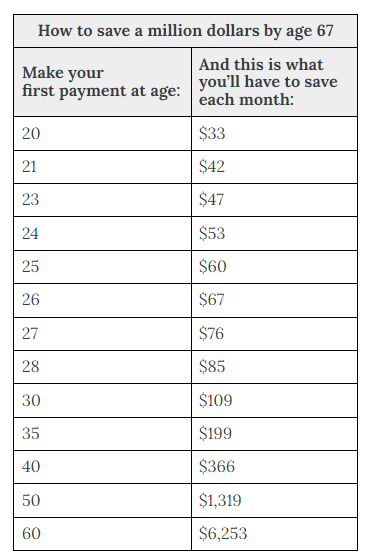
The reason should be fairly obvious: a dollar saved today not only starts earning interest sooner than one saved tomorrow (or 10 years from now) but also can ultimately earn a lot more money in the long run. Starting early means in your 20s—early in stage 1 of your financial life cycle. As one well-known financial advisor puts it, “If you’re in your 20s and you haven’t yet learned how to delay gratification, your life is likely to be a constant financial struggle.”
Suppose you want to save or invest – do you know how or where to do so? You probably know that your branch bank can open a savings account for you, but interest rates on such accounts can be pretty unattractive. Investing in individual stocks or bonds can be risky, and usually require a level of funds available that most students don’t have. In those cases, mutual funds can be quite interesting. A mutual fund is a professionally managed investment program in which shareholders buy into a group of diversified holdings, such as stocks and bonds. Any of the big 5 banks in Canada (RBC, CIBC, BMO, TD Canada Trust, or Scotiabank) offer a range of investment options including indexed funds, which track with well-known indices such as the Toronto Stock Exchange, a.k.a. the TSX. Minimum investment levels in such funds can actually be within the reach of many students, and the funds accept electronic transfers to make investing more convenient. We’ll leave a more detailed discussion of investment vehicles to your more advanced courses.
You may choose to do your banking with a major bank, or with a local credit union. Most people never notice the differences between credit unions and banks. They offer similar products and services, but they’re not the same. The following are some key points which highlight the differences:
As a college or university student, you might be out on your own for the first time. Part of handling your own finances will be choosing a banking institution or institutions that best suit your needs. Banks are eager to gain new clientele and establish brand loyalty early on. It should come as no surprise, then, that just about every major banking institution in Canada offers student-banking plans.
Any of the big 5 banks in Canada (RBC, CIBC, BMO, TDCanadaTrust, or Scotiabank) offer a range of investment options including indexed funds, which track with well-known indices such as the Toronto Stock Exchange, a.k.a. the TSX. Minimum investment levels in such funds can be within the reach of many students, and the funds accept electronic transfers to make investing more convenient.
An interactive H5P element has been excluded from this version of the text. You can view it online here:
https://ecampusontario.pressbooks.pub/businessfundamentals/?p=934#h5p-13
You may wish to review this article for more information on How to Choose a Bank That’s Right for You.
Now you are ready to start planning for your financial future.
If you can create a budget, and stay on budget, that’s a good thing; however, as the saying goes, life happens and you may find that your car breaks down when you least expect it and the bill could be over $1000 – that may not have been in your budget. You may require a loan so ensure you understand the different types of loans. You won’t get a bank loan unless you have a good credit rating. A good thing to do is plan for crises and contingencies, which will help you mitigate these risks. It is always a good idea to have a special reserve of money, a “rainy day” fund, for emergencies or large expenditures you did not plan for.
The amount of money you should have in your emergency fund can vary depending on your personal and financial goals. As a rule of thumb, financial experts recommend having enough savings to cover three to six months’ worth of living expenses.
For now, you are probably thinking about credit cards more than anything else. They are a great way to establish your credit history so that you can apply and qualify for some of those other loans later. There are some important things about credit cards that you need to know though, a big part of that has to do with the way that you use the credit card and how the banks interpret that use – it’s called utilization. Read “How Does the Credit Utilization Percentage Impact My Credit Score?” to learn more.
Do you often find yourself splurging or impulse shopping? Are your monthly bills more than you can comfortably afford? If you find yourself unable to make timely payments on loans or rent, you risk damaging your credit rating, which could affect your ability to borrow money in the future.
So, how do potential lenders determine if you are a good or bad credit risk? If your credit is poor, how might this affect your ability to secure a loan or the interest rates you’ll be offered? In Canada, a credit rating is a numerical score that reflects an individual’s or business’s creditworthiness, based on their financial behavior and credit history. Every time you use a credit card or borrow money, such as from a bank, your spending and debt habits are recorded. This information is then used by lenders, such as banks and financial institutions, to assess the risk of lending money or extending credit. Credit ratings in Canada are typically provided by two main credit bureaus—Equifax Canada and TransUnion Canada.
While Canadian credit scores are similar to the U.S. FICO score, they are not exactly the same. Credit bureaus in Canada, like Equifax and TransUnion, use their own scoring models to assess creditworthiness. Canadian credit scores range from 300 to 900, with most individuals falling in the 600–700 range, which is considered a good score. Your score is influenced by factors such as payment history, debt-to-income ratio, length of credit history, and the types of credit accounts you have. While Canadians may not use FICO scores, the concept is similar: both systems assess an individual’s ability to repay debt and manage credit responsibly. You can access your Equifax score for free online or by mail, and residents of Quebec can access their TransUnion score for free. Some banks also provide free credit scores through online banking services. Ultimately, your credit score plays a key role in determining whether you qualify for credit and the interest rates you’ll pay.
A credit score is calculated by considering five main criteria:
This score, along with other credit history information, is shared by the credit bureaus with their subscribers, helping lenders assess credit risk when considering loan applications.
So, what does this mean for you? It depends on your credit behavior. If you pay your bills on time and don’t take on excessive debt, you’re likely to have a high credit score, which will make you more attractive to lenders. This could result in receiving loans with reasonable interest rates. However, if your credit score is low, lenders may be hesitant to approve your loan applications, or they might offer loans at higher interest rates. A low credit score can even impact your ability to rent an apartment or secure certain jobs. That’s why it’s crucial to do everything you can to maintain a strong credit score.
Although the exact credit score ranges may vary slightly depending on the credit bureau or scoring agency, understanding where your credit score falls is essential for assessing your financial health. Knowing your score will help you understand what actions you may need to take to improve your creditworthiness and achieve your financial goals.
Here’s a breakdown of typical Canadian credit score ranges and their implications:
As a young person, building a strong credit history that will lead to a higher credit score can be achieved with a few key steps:
If you qualify for your own credit card, aim for one with a low-interest rate and no annual fee to build your credit responsibly.

Credit cards can be secured or unsecured. Unsecured credit cards don’t require a deposit and offer a credit limit based on your creditworthiness, such as your credit score and income. If you carry a balance, you’ll be charged interest, typically between 15% to 25% APR. The interest compounds, meaning you’ll pay interest on both the principal and any accumulated interest if the balance isn’t paid off in full each month. Secured credit cards, on the other hand, require a deposit that acts as collateral for your credit limit. These are often used by people building or rebuilding credit and may have similar interest rates to unsecured cards but carry less risk for the issuer.
Your credit card usage directly impacts your credit score, particularly through factors like credit utilization (the percentage of your limit used) and payment history. Many cards offer rewards such as cashback, points, or miles, along with benefits like purchase protection or travel insurance. However, credit cards can also come with fees, including annual fees, late payment fees, or foreign transaction fees. By managing your credit card well—paying on time, keeping balances low, and avoiding high-interest debt—you can build a strong credit history and minimize interest charges.
Bank loans come in both secured and unsecured varieties, and the type of loan you choose impacts factors like interest rates, required collateral, and the potential for compound interest.
In both types of loans, interest is generally calculated as simple interest for personal loans, mortgages, and auto loans, meaning the interest is only charged on the initial loan amount. However, with credit cards and some other types of revolving credit, compound interest is used, leading to interest on both the principal and any accrued interest. To minimize the impact of interest, it’s important to understand the loan terms, make timely payments, and pay more than the minimum required whenever possible. For both secured and unsecured loans, maintaining a strong credit score can help you secure better interest rates and more favorable loan terms.
Check your understanding of this chapter’s concepts by completing this short self-check quiz.
An interactive H5P element has been excluded from this version of the text. You can view it online here:
https://ecampusontario.pressbooks.pub/businessfundamentals/?p=934#h5p-14
The contents of this chapter is a compilation sourced from various OER resources, please refer to the Book Information for details.
(Note: This reference list was produced using the auto-footnote and media citation features of Pressbooks)
Gallager T. J., & and Andrews, J. D. Jr., (2003). Financial Management: Principles and Practice, 3rd ed. Upper Saddle River, NJ: Prentice Hall. p. 34, 196.
Gerson, E. & Simon, J. (2016). “10 ways students can build good credit. CreditCards.com. http://www.creditcards.com/credit-card-news/help/10-ways-students-get-good-credit-6000.php
Siege Media. (2024, February 5). What’s the average student loan debt in Canada? 19 staggering statistics. https://www.robertsoncollege.com/blog/studying-at-robertson/average-student-loan-debt-canada/#:~:text=The%20average%20student%20loan%20debt%20in%20Canada%20is%20approximately%20%2428%2C000,the%20most%20student%20loan%20debt.
OCUFA. (2024, September 6, 2024). CBC asks: Is university still worth it? We answered. https://ocufa.on.ca/general/cbc-asks-is-university-still-worth-it/#:~:text=Statistics%20Canada%20proves%20this%3A%20in,with%20a%20bachelor’s%20made%20%2480%2C100
Ganti, A. (2024, October 17). What is a budget? Plus 11 budgeting myths holding you back. https://www.investopedia.com/terms/b/budget.asp
Sharkey, S. (2024, September 27). How to create a college student budget you’ll actually use. https://www.clevergirlfinance.com/college-student-budget/
Wood, C. (2024, November 1). Canadian bank fees: The good, the bad and the ugly. https://loanscanada.ca/money/canadian-bank-fees-the-good-the-bad-and-the-ugly/
Statistics Canada. (2023, July 4). Hot summer day…cold beer or cooler. https://www.statcan.gc.ca/o1/en/plus/4017-hot-summer-day-cold-beer-or-cooler
Tim Hortons. (n.d.). Fresh facts. https://company.timhortons.com/us/en/corporate/fresh-facts.php#:~:text=Each%20year%2C%20we%20serve%20more,maintain%20our%20consistently%20high%20quality.
Bazian, G. (2018, December 21). Over 40 percent of Canadians anticipate feelings of anxiety and regret over holiday-spending bills. https://mnpdebt.ca/en/resources/mnp-debt-blog/over-40-per-cent-of-canadians-anticipate-feelings-of-anxiety-and-regret-over-holiday-spending-bills
Scotiabank. (n.d.). Student banking 101: What you need to know about investing as a student. https://www.scotiabank.com/ca/en/personal/advice-plus/features/posts.investing-as-a-student.html#:~:text=Investment%20options%20for%20students%201%201.%20Guaranteed%20investment,a%20single%20fund.%20…%205%205.%20ETFs%20
Keown, A. J. (2007). Personal Finance: Turning Money into Wealth, 4th ed. Upper Saddle River, NJ: Pearson Education. p. 23.
All Financial Matters. (2006, February 10). An interview with Jonathan Clements – Part 2. http://allfinancialmatters.com/2006/02/10/an-interview-with-jonathan-clements-part-2/.
Horton, C. (2023, July 19). Emergency fund calculator. https://www.forbes.com/advisor/banking/emergency-fund-calculator/
Government of Canada. (n.d.). Credit report and score basics. https://www.canada.ca/en/financial-consumer-agency/services/credit-reports-score/credit-report-score-basics.html
1
Instead of being evaluated by one person, how would you like to be evaluated by several people—not only those above you in the organization but those below and beside you? The approach is called 360-degree feedback, and the purpose is to ensure that employees (mostly managers) get feedback from all directions—from supervisors, reporting subordinates, coworkers, and even customers.
A nation has an absolute advantage if, (1) it’s the only source of a particular product, or, (2) it can make more of a product using fewer resources than other countries.
Academic integrity is a commitment to acting with honesty, trust, fairness, respect, and responsibility in academic work and studies.
Accessibility is the practice of making information, activities, and/or environments sensible, meaningful, and usable for as many people as possible.
Accounting is the organizational function that is focused on recording, keeping, analyzing and communicating financial information.
Advertising is paid, non-personal communication designed to create an awareness of a product or company.
Assets: the business resources from which it expects to gain some future benefit.
An audit involves an examination and verification of records and supporting documents.
Directive leaders who prefer to make decisions and solve problems on their own with little input from subordinates.
Balance of payments is the difference, over a period of time, between the total flow of money coming into a country and the total flow of money going out.
Calculate the balance of trade by subtracting the value of its imports from the value of its exports. If a country sells more products than it buys, it has a favourable balance, called a trade surplus. If it buys more than it sells, it has an unfavourable balance, or a trade deficit.
Balance Sheet = Show assets and liabilities, the amount invested in the business.
The Bank of Canada is a special type of Crown corporation that is owned by the federal government, but has considerable independence to carry out its responsibilities and therefore operates separately from the political process.
Benchmarking involves comparisons to other organizations’ practices and processes with the objective of learning and improvement in both efficiency and effectiveness.
Benefits— compensation other than salaries, hourly wages, or financial incentives.
Big data refers to datasets that are so large and complex that traditional data-processing methods cannot handle them. Its defining characteristics are volume, velocity, variety, veracity, and value (the 5Vs).
A boycott is a nonviolent, organized protest where people refuse to buy products or services, or participate in activities, to express disapproval.
Brand strategy is "The entire experience your prospects and customers have with your company, product or service. Your brand strategy defines what you stand for, a promise you make, and the personality you convey."
Breakeven analysis: to break even (have no profit or loss), the total sales revenue must exactly equal all the expenses (both variable and fixed).
Lavish or undisclosed gifts designed to influence decision-making cross the line into bribery.
A budget is a financial plan that estimates how much money you'll make and spend over a specific period of time. It can be used by individuals, families, businesses, and governments.
A budget audit provides information about where the organization is with respect to what was planned or budgeted for, whereas a performance audit might try to determine whether the figures reported are a reflection of actual performance.
A business is an organization that strives for a profit by providing goods and services desired by its customers.
The business cycle is the regular economic pattern of upturns and downturns in demand and output within the economy that tend to repeat themselves every three to five years or may last much longer.
A business environment analysis is a systematic process that evaluates the internal and external factors impacting a business.
Business etiquette is a type of social and business behaviour that team members (whether at school or work) are expected to exhibit. It includes how people communicate, dress, and conduct themselves in meetings and social events.
Business information refers to collective data related to a company and its operations, including statistical information, raw analytical data, customer feedback, and sales numbers.
Business law refers to rules, statutes, codes, and regulations established to provide a legal framework within which business may be conducted.
Business participants are the people who participate in conducting the work of the business. These always include the employees and managers, but often include suppliers, customers, and shareholders.
Business risk refers to the potential for a company to experience financial losses or other challenges that could impact its ability to achieve its objectives. These risks arise from uncertainties in the internal and external environment in which the business operates.
CAD refers to the use of computer software to create, modify, analyze, or optimize a design.
CAM refers to the use of computer software and hardware to control and automate manufacturing processes.
The Canadian Charter of Rights and Freedoms is a binding legal document that protects the basic human rights of all Canadians, such as fundamental freedoms, democratic rights, mobility rights, legal rights, equality rights, and language rights.
The Canadian Human Rights Act extends the law to ensure equal opportunity to individuals who may be victims of discriminatory practices based on a set of prohibited grounds (e.g., gender, disability, or religion).
The capacity requirements of the production facility is the maximum number of goods that it can produce over a given time under normal working conditions.
capital budget, which considers the company's long-range plans and outlines the expected financial needs for significant capital purchases such as real estate, manufacturing equipment, plant expansions, or technology.
Capitalism is an economic system that promotes the creation and ownership of capital and wealth.
Carroll’s Pyramid is a well-respected resource for situating corporate social responsibility. In this model, the focus is on managers—not owners—as the principals involved in the company's relationships with its stakeholders.
The cash flow statement reports cash inflows and outflows, and it will identify the amount of cash the company currently holds, which is also reported in the balance sheet.
Centralized decision making is done at the top level of management which makes decision making consistent, but can make lower-level managers feel under-utilized and impedes the development of decision-making skills in these managers.
CIM represents a comprehensive approach to manufacturing where CAD, CAM, and other business and manufacturing processes are integrated using computer systems.
Circular business models offer an alternative that shifts the focus from selling products to providing and preserving value, whether through traditional sales or innovative circular services and activities, such as repair or resale.
The circular economy represents a paradigm shift from the traditional linear model of "take-make-dispose" to a regenerative approach that emphasizes the restoration and regeneration of products, materials and energy. It challenges conventional metrics of value creation and encourages manufacturers to design products and business models with durability, repairability and recyclability in mind.
The circular flow model is simply a way of depicting how money circulates through the economy from individuals to firms in the form of labor and buying goods and services.
A citation style dictates the information necessary for a citation and how the information is ordered, as well as punctuation and other formatting. Popular citation styles such as APA and MLA provide guidelines to authors in how to format documents for professionalism, for crediting other people's words and ideas via citations and references to avoid plagiarism, and for describing other people using inclusive, bias-free language.
Coincident indicators show the state of the economy today.
The process of negotiating with an employer as a unified entity is known as collective bargaining.
Communicate, both orally and in writing. Whether you’re talking informally or making a formal presentation, you must express yourself clearly and concisely.
Communalism is a political and economic system that aims to eliminate class struggles by having the public own the means of production, such as factories and mines. In a communist society, there is no private property or currency, and wealth is shared equally or based on need. Communism is not the same as a planned economy, but communism is often associated with centrally planned economies.
Comparative advantage, which exists when a country can produce a product at a lower opportunity cost compared to another nation.
In addition to salary and wages, compensation packages often include other financial incentives, such as bonuses and profit-sharing plans, as well as benefits, such as medical insurance, vacation time, sick leave, and retirement accounts.
A competitor analysis in business involves examining similar brands in the same industry to gain insight into other companies offerings, brands, sales, and marketing approaches.
Compound interest refers to the effect of earning interest on your interest.
With compressed workweeks, rather than work eight hours a day for five days a week, you might elect to earn a three-day weekend by working ten hours a day for four days a week.
Conceptual skills — the ability to reason abstractly and analyze complex situations.
Conflicts of interest occur when individuals must choose between taking actions that promote their personal interests over the interests of others or taking actions that don’t.
Conflicts of loyalty can arise when individuals in leadership positions prioritize personal gains over their professional obligations, leading to ethical and legal repercussions.
Leaders who encourage discussion about issues and then require that all parties involved agree to the final decision.
Leaders who confer with subordinates before making a decision but retain the final decision-making authority.
The consumer buying process involves five steps: Need recognition, Information search, Evaluation of Alternatives, Purchase or No Purchase Decision, Post-purchase Evaluation.
The CPI measures the rate of inflation by determining price changes of a hypothetical basket of goods, such as food, housing, clothing, medical care, appliances, automobiles, and so forth, bought by a typical household.
Contingency and Crisis Planning are plans for what actions to take when things go wrong.
Contingent workers are hired to supplement a company’s permanent workforce.
Controlling involves ensuring that performance does not deviate from standards.
The set of attitudes, values, and standards that distinguishes one organization from another.
Corporate social responsibility is a business model by which companies make a concerted effort to operate in ways that enhance rather than degrade society and the environment.
Corporation—When a business is incorporated ownership shares are created, which produce a taxation and legal distance between the company and its shareholders.
Cost of goods sold: the total cost of the goods that a business has sold.
Costs are expenses including rent, salaries, supplies, transportation, and many other expenses a company incurs from creating and selling goods and services.
In Canada, a credit rating is a numerical score that reflects an individual's or business's creditworthiness, based on their financial behavior and credit history. Every time you use a credit card or borrow money, such as from a bank, your spending and debt habits are recorded.
Credits do the reverse of debits, they decrease asset or expense accounts and increase liability, revenue or equity accounts.
The cultural environment is the set of factors that shape the way people interact with each other and their physical and social environment.
Cultural norms are the standards we live by. They are the shared expectations and rules that guide behavior of people within social groups.
Structuring the company based on the needs of the customers.
Customer rights: the right to safe products, the right to be informed about a product, the right to choose what to buy, and the right to be heard.
Retaining customers is the purpose of customer-relationship management—a marketing strategy that focuses on using information about current customers to nurture and maintain strong relationships with them.
Customers buy the products and/or services from the business. Customers are extremely important to the business. In fact, they are participants, stakeholders, and an external environmental influence.
Data mining involves extracting valuable patterns and relationships from large datasets. Businesses use techniques like clustering, classification, and predictive modeling to derive actionable insights.
Data security is paramount to protect sensitive information from breaches, unauthorized access, and cyberattacks.
Debits increase asset or expense accounts and decrease liability, revenue or equity accounts.
Debt financing, on the other hand, does not require giving up a portion of ownership.
Debt ratios look at how much borrowing a company has done in order to finance the operations of the business. The more borrowing, the more risk a company has taken on, and so the less likely it would be for new lenders to approve loan applications.
Decentralized decision making is spread throughout the organization. Since the responsibilities and decision-making are given to various people holding different positions in an organization, top management can work towards the growth and long-term vision of the company.
Decision-making is the action or process of thinking through possible options and selecting one.
Drawing on your decision-making skills is often a process in which you must define a problem, analyze possible solutions, and select the best outcome.
Deflation is downward pressure upon the level of economic activity. It is a period of falling demand and prices. It is usually accompanied by reduce output and rising unemployment.
Delegating is the process of entrusting work to subordinates, letting go, trusting – this is challenging for many managers to do; however, it is a necessary skill to learn.
Demand is the quantity of a product that buyers are willing to purchase at various prices.
Leaders who encourage discussion about issues and then require that all parties involved agree to the final decision.
Departmentalization is grouping specialized jobs into meaningful units.
Digital currencies are currencies that are only accessible with computers or mobile phones because they only exist in electronic form.
Discrimination occurs when a person is treated unfairly on the basis of a characteristic unrelated to ability.
Diversity is the presence, in an organization or a community, of a wide range of people with different backgrounds, abilities and attributes including ethnicity, race, colour, religion, age, gender and sexual orientation.
A divisional organizational structure is a type of organizational structure where a company is divided into independent divisions that operate like their own companies within the larger organization. Each division has its own resources, teams, and responsibilities.
In double-entry accounting, every transaction is recorded with a debit and credit in two or more accounts, which categorize different types of financial activities in a company’s general ledger.
Dumping is the practice of selling exported goods below the price that producers would normally charge in their home markets (and often below the cost of producing the goods).
Economic corporate responsibility refers to the practice of making financial decisions based on a commitment to doing good.
Economic development refers to the process through which a region, country, or community improves the well-being of its citizens by increasing income, reducing poverty, creating jobs, and expanding access to healthcare and education.
An economic indicators are the monthly statistics that provide information on the country's economic performance. There are different types of indicators which are all subject to considerable error, so it is unwise to draw any conclusions from just one month's data.
Economics is the study of how individuals, businesses, governments and nations allocate their limited resources to satisfy their unlimited wants and needs.
Effectiveness is the ability to produce a desired result.
Efficiency is using the least possible amount of resources to get work done, whereas effectiveness is the ability to produce a desired result.
Efficiency ratios tell you how well your assets are being managed.
An extreme form of quota is the embargo, which, for economic or political reasons, bans the import or export of certain goods to or from a specific country.
Employability skills are the skills you need to enter, stay in, and progress in the world of work—whether you work on your own or as part of a team.
The Employment Equity Act of 1986 identifies specific populations which are protected from discrimination (women, visible minorities, indigenous peoples, and people with disabilities).
Employment-related legislation covers the following subjects: employment standards, human rights, federal and provincial privacy, occupational health and safety, workers' compensation, and labour regulations legislation.
The process of giving employees increased autonomy and discretion to make decisions, as well as control over the resources needed to implement those decisions.
ERP is a broader, integrated system that manages and automates a company’s core business processes across multiple departments, including finance, HR, manufacturing, supply chain, sales, and customer relationship management (CRM). It often incorporates MRP as a module.
Equity is a process that ensures everyone has access to the same opportunities.
Equity financing carries no repayment obligation and provides extra working capital that can be used to grow a business.
The equity theory of motivation is the idea that what an individual receives for their work has a direct effect on their motivation.
ESG stands for Environmental, Social, and Governance. It refers to a set of standards used by businesses to evaluate and address their impact on the world, beyond just financial performance.
Creating an ethical business environment involves adherence to laws and regulations, strong corporate governance, and proactive efforts to ensure the well-being of employees, customers, and the community.
Ethical dilemmas are situations in which it is difficult for an individual to make decisions either because the right course of action is unclear or carries some potential negative consequences for the person or people involved.
Ethical issues are the difficult social questions that involve some level of controversy over what is the right thing to do.
An ethical lapse is a mistake or error in judgment that produces a harmful outcome. It is a failure to follow proper ethical principles.
An ethical lapse in honesty and integrity occurs when an individual, organization, or company fails to uphold fundamental ethical principles, such as truthfulness, transparency, and adherence to moral standards. It typically involves actions or decisions that prioritize self-interest, convenience, or profit over fairness, accountability, and ethical responsibility.
Businesses have ethical responsibilities to ensure fair practices and treat customers, employees, and stakeholders with respect.
Ethics is the philosophical discipline concerned with what is morally good and bad, and morally right and wrong
Today, the European Union (EU) is a unique economic and political union between 27 countries that have eliminated trade barriers among themselves.
Currencies are traded in the foreign exchange market. Like any other market, when something is exchanged there is a price. In the foreign exchange market, a currency is being bought and sold, and the price of that currency is given in some other currency. That price is expressed as an exchange rate.
Vroom argues that an employee will be motivated to exert a high level of effort to obtain a reward under three conditions – the employee: believes that his or her efforts will result in acceptable performance, believes that acceptable performance will lead to the desired reward, and values the reward.
Exporting is selling domestic products to foreign customers.
Extrinsic motivation. This is when motivation comes from external factors; in other words, a person needs an incentive to be, stay, or become motivated.
The facility layout is the physical arrangement of resources.
The resources used to create goods and services.
A FICO credit score is a tool used by many lenders to determine if a person qualifies for a credit card, mortgage, or other loan.
Managers have what is known as a fiduciary responsibility to owners: they’re responsible for safeguarding the company’s assets and handling its funds in a trustworthy manner.
Financial accountants furnish information to individuals and groups both inside and outside the organization in order to help them assess its financial performance.
The financial budget plans the use of assets and liabilities and results in a projcted balance sheet.
Financial controllers are responsible for updating financial controls and overseeing all the accounting activities in an organization.
Financial controls are procedures and policies that monitor and manage financial resources to prevent errors, fraud, and optimize allocation.
The financial functional area of a business is responsible for managing the company’s financial resources, including budgeting, accounting, financial reporting, cash flow management, and investment decisions. Its role is to ensure the financial stability and growth of the organization by optimizing financial performance and minimizing risks.
Financial management involves the strategic planning and budgeting of short- and long-term funds for current and future needs. In most companies the finance department comprises two divisions: accounting and financial management.
A financial manager oversees the financial operations of a company. Many financial managers have backgrounds in accounting, banking, business management, economics, or finance. In most organizations, financial managers hold mid to upper-level roles requiring multiple years of experience. They can work in the private or public sectors.
Financial planning—the ongoing process of managing your personal finances in order to meet goals that you’ve set for yourself or your family
The financial planning life cycle of a typical individual’s life has three stages, each of which is characterized by different life events. Stage 1: Focus on building wealth, Stage 2: Focus on preserving and increasing wealth, and Stage 3: Focus on living on one's saved wealth after retirement.
First-line managers (also referred to as customer-facing or front-line) coordinate activities, supervise employees, report to middle-managers, and are involved in day-to-day operations.
Fiscal policy is a government towards its raising of revenue and its level of public spending.
Employers who provide for flextime set guidelines that allow employees to designate starting and quitting times.
Forecasts predict revenue, costs and expenses for a specific future period. Short-term forecasts would include predictions for the upcoming year, while long-term forecasts would include predictions for a period longer than one year into the future.
Foreign direct investment (FDI) refers to the formal establishment of business operations on foreign soil—the building of factories, sales offices, and distribution networks to serve local markets in a nation other than the company’s home country.
On a semiannual or annual basis, they also conduct formal performance appraisals to discuss and evaluate employees’ work performance.
A free market economy is an economic system where the laws of supply and demand determine prices, and the government has limited or no involvement
Free market system is defined as an economy operating by free competition.
The opposite end of the continuum from the autocratic style, is free-rein or laissez-faire(French for “leave it alone”) leadership. Managers who use this style turn over all authority and control to subordinates.
The FTSE4Good Index Series is designed to measure the performance of companies demonstrating specific Environmental, Social and Governance (ESG) practices.
Functional areas in a business refer to different departments or sections that perform specific tasks, such as human resources, operations, accounting, and finance.
fundamental accounting equation: Assets = Liabilities + Owner’s Equity
A Gantt chart, named after the designer, Henry Gantt, is an easy-to-use graphical tool that helps operations managers determine the status of projects.
In preparing financial statements, financial accountants adhere to a set of standards or guidelines, known as Generally Accepted Accounting Principles (GAAP). GAAP is used mainly by companies headquartered in the U.S., while most other countries follow the international financial reporting standards (IFRS).
Structuring the company so that responses to customers in their geographical areas can be done more effectively.
A gift intended to maintain goodwill or celebrate a partnership might be ethical if it’s modest and transparent.
Globalization is the process of increasing economic and social integration between countries, and the increased flow of goods, services, and people across borders.
Goods are tangible items manufactured by businesses, such as laptops.
Your GPA score (Grade Point Average) is a cumulation of the grades across the courses throughout your program. To graduate your institution will have a minimum GPA score you must achieve, and should you wish to further your education in the future your GPA score may factor into whether or not you will be accepted for enrollment at specific colleges or universities.
The grapevine represents the informal communication network within an organization. It is a natural part of corporate culture, where employees share information unofficially through casual conversations, rumors, or personal interactions.
Greenwashing refers to the practice of misleading consumers or stakeholders into believing that a company, product, or initiative is more environmentally friendly or sustainable than it actually is.
Gross domestic product (GDP) is defined as the market value of all goods and services produced by the economy in a given year.
Gross national product is the value of all products and services produced by citizens of a country both domestically and internationally minus income earned by foreign residents.
The difference between sales and cost of goods sold is your gross profit, also known as gross margin.
In Canada, workplace health and safety are governed by several key pieces of legislation designed to protect workers and ensure safe working environments: Canada Labour Code, provincial and territorial health and safety legislation, occupational health and safety regulations, and workers' compensation legislation.
Herzberg’s two-factor theory. Note that motivation factors (such as promotion opportunities) relate to the nature of the work itself and the way the employee performs it. Hygiene factors (such as physical working conditions) relate to the environment in which it’s performed.
If an applicant progresses satisfactorily through all the selection steps, a decision to hire the person is made. Usually for higher-level jobs or jobs within unionized environments, the decision will be based on the test scores (if applicable) and the interview scores each candidate obtained.
Hiring externally gives you an opportunity to bring fresh ideas and skills into the company.
Hiring internally sends a positive signal to employees that they can move up in the company—a strong motivation tool and a reward for good performance.
HR forecasting is the process of predicting how a company's staffing needs change with time so that it can remain prepared to operate successfully. Organizations use HR forecasting to decide to hire more people, reduce their staffing or adjust how they divide responsibilities.
Human resource (HR) management is the process of hiring, developing, motivating, and evaluating employees to achieve organizational goals.
human resource management (HRM) consists of all actions that an organization takes to attract, develop, and retain quality employees.
The Human Resources (HR) functional area is an organizational function that is about searching for, selecting, training, and maintaining workers.
Inclusion, diversity, equity, and accessibility (IDEA) are a set of practices that aim to ensure that people from a variety of backgrounds are represented and can thrive.
Importing is buying products overseas and reselling them in one’s own country.
Inclusion refers to taking into account differences among individuals and groups when designing something (e.g., policy, program, curriculum, building, shared space) to avoid creating barriers.
In addition to complying with equal employment opportunity laws, many companies make special efforts to create an inclusive workforce by recruiting employees who are underrepresented in the workforce according to sex, race, or some other characteristic.
Income Statement = Shows sales, expenses, and whether or not a profit was made.
Understanding of the four stages of the industry life cycle include expansion, peak, contraction, and trough (discussed in the chapter on economics) and industry dynamics informs management's investment decisions and risk management strategies. External factors that affect a business are often analyzed through a PEST analysis.
Inflation is a sustained rise in the average prices of goods within an economy. It can also be explained as the fall in the purchasing power of money, since it is usual for wages to move ahead at least as fast as the price level.
Information management encompasses the collection, storage, organization, and distribution of information to optimize business operations and decision-making.
Effective information sharing enhances collaboration and decision-making within and between organizations.
Information technology is the organizational function that aims to understand the information and data needs of the company in terms of obtaining, analyzing, and protecting information.
During initial screening, an applicant completes an application form and/or submits a résumé, and has a brief interview of 30 minutes or less.
Inputs are the elements which goes into producing a good or service such as labor, raw materials, capital, land, entrepreneurship etc.
Retailers are marketing intermediaries that sell products to the eventual consumer.
The internal business environment in business refers to the elements within the organization that influence its operations and decision-making. It encompasses factors like the company’s culture, management practices, employees, and work processes.
Because of high domestic labour costs, many U.S. companies manufacture their products in countries where labour costs are lower. This arrangement is called international contract manufacturing, a form of outsourcing.
Under an international franchise agreement, a company (the franchiser) grants a foreign company (the franchisee) the right to use its brand name and to sell its products or services. The franchisee is responsible for all operations but agrees to operate according to a business model established by the franchiser. The franchisee pays royalties to the franchiser. In turn, the franchiser usually provides advertising, training, and new-product assistance.
An international licensing agreement allows a foreign company (the licensee) to sell the products of a producer (the licensor) or to use its intellectual property (such as patents, trademarks, copyrights) in exchange for what is known as royalty fees.
The IMF loans money to countries with troubled economies
The International Monetary Fund (IMF) is governed by and accountable to its 191 member countries and has three critical missions: furthering international monetary cooperation, encouraging the expansion of trade and economic growth, and discouraging policies that would harm prosperity.
Interpersonal skills, also known as relational skills — the ability to get along with and motivate other people — are critical for managers in mid-level positions.
Intrinsic motivation. This is when motivation comes from within; in other words, a person has it within themselves to be, stay, or become motivated
The task of striking a balance between two threats to productivity: not enough inventory and carrying too much inventory. The process of striking this balance is called inventory control, and companies now regularly rely on a variety of inventory-control methods.
Investing is what someone does when they buy something in hopes that it will grow in value over time.
Involuntary termination is when an employer ends an employee's employment without the employee's consent. It can happen for a number of reasons, including: poor performance, unprofessional behavior, policy violations, economic factors, and organizational changes
ISO refers to the International Organization for Standardization; the 31000 part refers to a family of standards for risk management. As well as being an umbrella term for a bunch of different standards, ISO 31000 also refers to a singular standard, specifically known as ISO 31000:2018.
A job analysis identifies the tasks, responsibilities, and skills that a job entails, as well as the knowledge and abilities needed to perform it.
A job description, which lists the duties and responsibilities of a position
Job enlargement—the policy of enhancing a job by adding tasks at similar skill levels.
Job enrichment is the practice of adding tasks that increase both responsibility and opportunity for growth.
The practice of job rotation allows employees to rotate from one job to another on a systematic basis, often but not necessarily cycling back to their original tasks.
Under job sharing, two people share one full-time position, splitting the salary and benefits of the position as each handles half the job.
Organizing activities into clusters of related tasks that can be handled by certain individuals or groups is called job specialization.
A job specification, which lists the qualifications—skills, knowledge, and abilities— needed to perform the job
A joint venture involves two or more companies forming a new, independent legal entity to pursue a specific business objective or project. The companies share ownership, profits, risks, and governance in the newly created entity.
With just-in-time (JIT) production: the manufacturer arranges for materials to arrive at production facilities just in time to enter the manufacturing process.
Labelling not only identifies the product but also provides information on the package contents: who made it and where or what risks are associated with it (such as being unsuitable for small children).
Lagging indicators show the health of the economy in the recent past.
The law of supply and demand is an economic theory that explains how the relationship between supply and demand determines prices. When supply is greater than demand, prices fall, and when demand is greater than supply, prices rise.
The relatively consistent way that individuals in leadership positions attempt to influence the behaviour of others.
Leading is providing focus and direction to others and motivating them to achieve organizational goals.
Leading indicators give a prediction of future events.
Learning Styles refers to the different methods of learning or understanding new information, the way a person takes in, understands, expresses and remembers information. There are 4 predominant learning styles: Visual, Auditory, Read/Write, and Kinaesthetic.
Legal compliance refers to conducting a business within the boundaries of all the legal regulations of that industry.
Businesses have legal responsibilities to comply with laws and regulations at the local, national, and international levels.
Liabilities: the business debts that it owes to outside individuals or organizations.
Lifelong learning is the ongoing, voluntary, and self-motivated pursuit of knowledge for either personal or professional reasons.
Liquidity ratios tell you how well positioned a company is to pay its bills in the near term. Liquidity refers to how quickly an asset can be turned into cash. For example, share of stock is substantially more liquid than a building or a machine.
Long-term financing refers to borrowing or issuing equity shares for more than one year.
When costs and expenditures are greater than revenue.
M-1 is the narrowest measure, and it includes the most liquid forms of money — the forms, such as cash and chequing account funds, that are spent immediately.
M-2 includes everything in M-1 plus near-cash items invested for the short term — savings accounts, time deposits and money market mutual funds.
The macro-environment refers to the broader condition of an economy as opposed to specific markets.
Macroeconomics looks at the decisions of countries and governments.
Products are customized to meet the needs of the buyers who order them. This process, is called a make-to-order strategy.
The main objective of managerial accounting is to assist the management of a company in efficiently performing its functions: planning, organizing, directing, and controlling.
Managers are designated leaders according to the organizational structure but may need to use negative consequences or coercion to achieve change.
Market research is the process of gathering, analyzing, and interpreting information about a market, product, service, and customers. It helps companies understand their customers, competitors, and industry, and make strategic decisions about marketing and selling.
Market segments are groups of potential customers with common characteristics that influence their buying decisions. You can use a number of characteristics to segment a market including demographic, geographic, behavioral, and psychographic.
Marketing plays a crucial role in a business by helping to identify, create, and satisfy customer needs and wants through the promotion of products or services. It is defined as "Marketing is the activity, set of institutions, and processes for creating, communicating, delivering, and exchanging offerings that have value for customers, clients, partners, and society at large."
The marketing concept is a business philosophy where the organization's goals are achieved by identifying customer needs and delivering value more effectively than competitors.
The marketing mix is the combination of four factors, known as the "4 Ps" of marketing. The 4 Ps are designed to serve the target market and include product, price, promotion, and place.
A marketing strategy consists of two major elements: the organization must determine its target market and then develop a marketing mix to meet the needs of that market.
According to Maslow’s theory, the idea is that we need to satisfy lower-level needs before we move to the other levels; once we have satisfied said need(s), we move on to the next level as the previous one no longer satisfies us.
Mass customization combines the advantages of customized products with those of mass production. This approach requires that a company interact with the customer to find out exactly what the customer wants and then manufacture the good, using efficient production methods to hold down costs.
Mass production (or make-to-stock strategy), the practice of producing high volumes of identical goods at a cost low enough to price them for large numbers of customers.
A software tool called material requirements planning (MRP), relies on sales forecasts and ordering lead times for materials to calculate the quantity of each component part needed for production and then determine when they should be ordered or made.
Corporate Social Responsibility (CSR) is typically measured through a combination of quantitative and qualitative metrics that assess how well a company is meeting its social, environmental, and ethical obligations. Different organizations use various frameworks, tools, and reporting standards to evaluate CSR performance.
The micro-environment may be defined as including groups and organizations that have a direct relationship with the business.
Microeconomics is the study of individuals and business decisions.
Middle-level managers allocate resources, oversee first-line managers, report to top-level managers and develop and implement activities.
Employers must obey laws governing minimum wage and overtime pay. A minimum wage is set by the provincial government.
A mixed economy is an economic system where some resources are planned for by the government, while citizens control others. The world's dominant economic organization is a mixed economy.
A mixed market economy is defined as an economic system blending elements of a market economy with elements of a planned economy, markets with state interventionism, or private enterprise with public enterprise.
Monetary policy is concerned with the money supply, rates of interest, exchange rates and the amount of credit available in order to control the level of spending within the economy.
Money is anything that is acceptable as payment for goods and services. It affects our lives in many ways.
Monopolistic competition occurs when an industry has many firms offering products that are similar but not identical. Unlike a monopoly, these firms have little power to curtail supply or raise prices to increase profits.
A monopoly is a market structure characterized by a single seller, selling a unique product in the market. In a monopoly market, the seller faces no competition, as he is the sole seller of goods with no close substitute.
A company that operates in many countries is called a multinational corporation (MNC).
A nation's deficit is when a government spends more money than it receives in revenue over a period of time.
National debt is the liabilities of the government sector. Historically, government deficits have occurred much more often than surpluses since government typically spends more than it takes in.
The difference between gross profit and operating expenses is your net income or profit, which is the proverbial “bottom line.”
The non-profit or voluntary sector includes non-governmental, non-profit organizations that receive support from individual citizens, government, and businesses.
An organization that exists to achieve some goal other than gaining profit.
Oligopoly means few sellers. In such an oligopolistic market, each seller supplies a large portion of all the products sold in the marketplace.
The operating budget helps plan future revenue and expenses and results in a projected income statement.
Operating expenses: the costs of operating a business except for the costs of things that were sold.
Operational planning generally assumes the existence of organization-wide or sub-unit goals and objectives and specifies ways to achieve them.
Operations is the organizational function that is focused on producing the goods and/or services of the business.
Operations management is a vital component of any business, encompassing the practices, techniques, and tools that organizations use to produce and deliver goods and services efficiently and effectively.
Operations managers manage the process that transforms inputs into outputs. Their responsibilities can be grouped as follows: production planning, production control., and quality control.
Opportunity cost indicates what must be given up to obtain something that is desired.
Businesses use organizational charts to depict the reporting structure within the organization.
Organizing is the second management function and it is the process of coordinating and allocating a firm's resources in order to carry out its plans.
An orientation program introduces a new employee to the company's people, policies, and procedures.
Output is the finished product coming from a production process.
Outsourcing in business refers to the practice of contracting out certain business functions, tasks, or processes to external vendors or service providers, rather than handling them in-house.
Owner’s equity: the investment in the business.
Packaging can influence a consumer’s decision to buy a product or pass it up. Packaging gives customers a glimpse of the product, and it should be designed to attract their attention, with consideration given to color choice, style of lettering, and many other details.
Leaders who share decision making with group members and encourage discussion of issues and alternatives; includes democratic, consensual, and consultative styles.
Partnership— A partnership is similar to a sole proprietorship, but instead of one proprietor there are two or more.
The impact of disputes can be lessened if the partners have executed a well-planned partnership agreement that specifies everyone’s rights and responsibilities.
Perceived Risks are based on feelings, fears, or assumptions and may lack concrete evidence. They often result from misinformation, cognitive biases, or heightened awareness.
Perfect competition exists when there are many consumers buying a standardized product from numerous small businesses. Because no seller is big enough or influential enough to affect price, sellers and buyers accept the going price.
A personal budget (for an individual) or household budget (for a group sharing a household) is a plan for the coordination of income and expenses.
Personal credit is a measure of an individual’s creditworthiness, represented by a credit score. It serves as a determining factor for lenders when assessing loan applications and setting interest rates.
Your “personal debt” is how much money you owe to other people, businesses, banks, credit card companies, and other creditors.
Personal finance is the application of financial principles to the monetary decisions that you make either for your individual benefit or for that of your family.
Personal risk tolerance refers to an individual's ability or willingness to accept uncertainty and potential loss in pursuit of a goal. It plays a critical role in decision-making, particularly in areas like investments, career choices, and lifestyle decisions.
Personal selling refers to one-on-one communication with customers or potential customers.
PERT (which stands for Program Evaluation and Review Technique) charts are designed to diagram the activities required to produce a good, specify the time required to perform each activity in the process, and organize activities in the most efficient sequence. It also identifies a critical path: the sequence of activities that will entail the greatest amount of time.
PEST is the term used for an external environment scan, whereby a business collects and analyzes data on the political, economic, social, and technological aspects of the business environment in which the business operates.
Pet peeves are the thing that annoy you, often things other people do that bother you.
Philanthropic responsibility is a business's commitment to improving society through charitable activities, community support, and social initiatives. It's a key aspect of corporate social responsibility (CSR), and it emphasizes that businesses should not only focus on profit-making.
Many large corporations support various charities, an activity called philanthropy.
Picketing is a labor tactic where workers gather outside a workplace to protest and persuade others to take industrial action.
Place" is the third of the "4Ps" of marketing and refers to where and how a company sells its products to consumers. The goal is to reach the target audience and meet sales targets.
Planned economy is a system where the state determines production levels and regulates prices. In a centrally planned economy, the state uses advanced planning mechanisms to determine production levels, rather than supply and demand.
Planned system is an economic system in which the elements of an economy (such as labor, capital, and natural resources) are subject to government control and regulation designed to achieve the objectives of a comprehensive plan of economic development.
Planning is the function of management that involves setting objectives and determining a course of action for achieving those objectives.
The ability to influence others to behave in a particular way.
Price is the only element of the marketing mix that directly generates revenue for a company. It's also the most flexible element, and it's important to continuously monitor and revise it.
Price stability is the stable level of prices in the economy, which avoids long periods of inflation or deflation and sustains the value of money over time.
Primary data is newly collected information that addresses specific questions.
The private business sector includes goods and services produced and delivered by private individuals or groups as a means of enterprise for profit.
Structuring the company based on processes needed to create the product or service.
The producer price index (PPI) tracks the average change in prices at the wholesale level (e.g., raw materials, product components that require further processing, and finished goods sold to retailers).
It’s important to remember that when it comes to this first ‘P” of the marketing mix, the term "product" refers to both products and services.
Product division is structuring a company based on its product lines.
A product life cycle is a theoretical model describing a product's sales and profits over the course of its lifetime. During this cycle the product typically goes through four stages: an introductory stage, a growth stage, a maturity stage, and a declining stage.
Production refers to the process of transforming inputs (such as labour, capital, and raw materials) into outputs (goods and services) that a firm wishes to sell.
Effective production planning requires a thorough analysis of market demand, capacity capabilities, and available resources.
Productivity refers to how efficiently goods and services are being produced.
Professionalism is a broad concept that includes a person's attitude, work ethic, and conduct. It also involves being punctual, dressing appropriately, and having a positive attitude.
If Microsoft has money left over after it pays all costs, it has a profit.
Profitability ratios tell you how much profit is made relative to the amount invested (return on investment) or the amount sold (return on sales).
Promotional mix is the means by which a company communicates with its customers and includes advertising, social media, email marketing, personal selling, sales promotion, public relations, and more.
During prosperity, the economy expands, unemployment is low, incomes rise, and consumers buy more products.
The public business sector includes goods and services produced, delivered, and allocated by the government and public sector organizations (publicly controlled government business enterprises).
Public relations (PR) refers to managing how others see and feel about a person, brand, or company
The process of acquiring the materials and services to be used in production is called purchasing (or procurement).
Quality is defined as the degree to which a product or service meets or exceeds customer expectations and adheres to established standards or specifications. It is a multifaceted concept that can be viewed through different lenses, such as product characteristics, customer satisfaction, and continuous improvement.
Quality of life refers to the general level of human happiness based on factors including life expectancy, educational standards, health, sanitation, and leisure time.
A quota imposes limits on the quantity of a good that can be imported over a period of time.
Real Risks are backed by data, evidence, or historical trends. They are measurable and often require proactive mitigation.
Recruiting is the process of identifying suitable candidates and encouraging them to apply for openings in the organization.
References are people who will attest to your skills and abilities. The best references are former or current employers.
Relationship-building roles help team members understand their roles, support them in their roles, and maintain or improve group cohesiveness.
Revenue is the money a company receives by providing services or selling goods to customers.
The potential to lose time and money or otherwise not be able to accomplish an organization's goals.
Risk management is the structured process of identifying potential threats, evaluating their likelihood and impact, and developing strategies to minimize or eliminate their adverse effects.
Risk tolerance in a business context refers to the degree of uncertainty and potential loss an organization is willing to accept to achieve its objectives. It reflects the company's capacity and willingness to take on risks as part of its strategy and decision-making processes.
A sales promotion is a marketing strategy that uses temporary offers or campaigns to increase sales, encourage customer loyalty, or build brand awareness
Scarcity is one of the key concepts of economics. It means that the demand for a good or service is greater than the availability of the good or service.
Secondary data is information already collected, whether by the company or by others, that pertains to the target market.
Loans that involve some type of collateral are referred to as secured loans or secured credit.
The tool most widely used in making hiring decisions is the selection interview, an in-depth discussion of an applicant’s work experience, skills and abilities, education, and career interests.
Selection is the process of determining which people in the applicant pool possess the qualifications necessary to be successful on the job.
Intangible offerings of business that can't be held, touched, or stored
The SERVQUAL model (Parasuraman et al., 1988) is commonly used in service industries to measure quality across five dimensions: reliability, responsiveness, assurance, empathy, and tangibles. This framework allows businesses to identify specific areas where they can improve to meet or exceed customer expectations.
Sexual harassment occurs when an employee makes “unwelcome sexual advances, requests for sexual favours, and other verbal or physical conduct of a sexual nature” to another employee.
Short-term financing means business financing from short-term sources, which are for less than one year.
Site selection involves measuring the needs of a new project against the merits of potential locations.
Selecting a leadership style based on the maturity and competency level of those who will complete the task.
SMART is an acronym used to guide and set goals: Specific, Measurable, Attainable, Relevant, and Time Based.
Social media marketing is the practice of including social media as part of a company’s marketing program.
Socialism is an economic and political system where the means of production are owned by the public or the state, rather than private individuals. It's based on the idea that shared ownership of resources leads to a more equal society.
Sole proprietorship—A sole proprietorship is quite informal and easily created, which is why it’s the most common structure chosen by new entrepreneurs.
Span of Control can be defined as the total number of direct subordinates that a manager can control or manage.
The SQ4R reading system is designed to help you study your textbook and apply reading and notetaking skills. The letters in SQ4R stand for five steps: survey, question, read, reflect, recite, and review.
Stakeholders are those affected by the business's operations and its decisions. Examples of stakeholders include shareholders, investors, the community, customers, competitors, and governmental agencies.
The standard of living of any country is measured by the output of goods and services people can buy with the money they have.
Statement of Cash Flows = Show how much cash is coming in and going out.
Statistical process control (SPC) is defined as the use of statistical techniques to control a process or production method. SPC tools and procedures can help you monitor process behavior, discover issues in internal systems, and find solutions for production issues. Statistical process control is often used interchangeably with statistical quality control (SQC).
A strategic alliance is an agreement between two companies (or a company and a nation) to pool resources in order to achieve business goals that benefit both partners.
A strategic HR plan lays out the steps that an organization will take to ensure that it has the right number of employees with the right skills in the right places at the right times.
Strategic marketing planning involves setting goals and objectives, analyzing internal and external business factors, product planning, implementation, and tracking your progress.
Strategic planning involves analyzing competitive opportunities and threats, as well as the strengths and weaknesses of the organization, and then determining how to position the organization to compete effectively in their environment.
Stress is a physical, mental, and emotional response to a difficult event. Stress Management offers a range of ways to help you better deal with stress and difficulty in your life.
A strike is a collective work stoppage by employees in response to an employer to force them to agree to certain terms of employment.
Supply is the quantity of a product that sellers are willing to sell at various prices.
A supply chain refers to the network of individuals, organizations, resources, activities, and technologies involved in the production and distribution of a product or service. It encompasses every stage from sourcing raw materials to delivering the final product or service to the consumer.
Supply chain management (SCM) is the monitoring and optimization of the production and distribution of a company’s products and services. It seeks to improve and make more efficient all processes involved in turning raw materials and components into final products and getting them to the ultimate customer.
SWOT analysis is an examination of the internal and external factors that impact the organization and its strategies. Generally, the internal factors are strengths and weaknesses; the external factors are opportunities and threats.
Tactical planning is intermediate-range (one to three years) planning that is designed to develop relatively concrete and specific means to implement the strategic plan. Middle-level managers often engage in tactical planning.
The target market is the specific group of consumers, with similar needs and wants, toward which a firm directs its marketing efforts. A target market is the group of people who are most likely to buy your product or service.
Tariffs are taxes on imports.
Task-facilitating roles help the team accomplish goals.
A team is a group of people with certain skills who share a common purpose, approach, and performance goals.
Team cohesion is the strength and extent of interpersonal connection existing among the members of a group. It is this interpersonal bond that causes members to participate readily and remain motivated to accomplish the set goals.
Team conflict is the breakdown of interpersonal relationships between members of a team.
Technical skills — the ones you need to perform specific tasks
Telecommuting means that you regularly work from home (or from some other non-work location).
"The 7 Habits of Highly Effective People" written by Stephen R. Covey based on Covey's belief that the way we see the world is entirely based on our own perceptions. In order to change a given situation, we much change ourselves, and in order to change ourselves, we must be able to change our perceptions.
The Equilibrium Price is the price point at which the demand and supply curves intersect.
The four functions of management--planning, organizing, leading and controlling--serve as the pillars that allow organizations to meet their goals.
Time management is the practice of planning and controlling how you use your time to be more productive and efficient. It involves prioritizing tasks, setting deadlines, and avoiding distractions. The goal of time management is to complete important tasks on time while also balancing your personal, professional, and academic responsibilities.
Time management skills are techniques that help you plan and organize your time to complete tasks and achieve goals.
The time value of money, or TVM, means that any amount of money has more value now than it will have in the future.
Top-level managers set objectives, scan the business environment, and plan and make decisions that affect the overall health of the organization.
Total quality management (TQM) is the continual process of detecting and reducing or eliminating errors in manufacturing. It streamlines supply chain management, improves the customer experience, and ensures that employees are up to speed with training.
Trade controls are policies that restrict free trade, and governments continue to control trade.
A country has a trade surplus when it sells more to other countries than it buys from them.
Even with some experience, knowledge, and skills your new employer will still want to provide you with training specific to the technologies, processes, and practices used by the organization.
Transformational leadership is a leadership style that can inspire positive changes in those who follow.
ransparency International reports on corruption and publishes an annual Corruption Perceptions Index that rates the world’s countries. Transparency International annually rates nations according to “perceived corruption" and defines corruption as "the abuse of entrusted power for private gain." A score of 100 would be perfect (corruption free) and anything below 30 establishes that corruption is rampant.
The time value of money, or TVM, means that any amount of money has more value now than it will have in the future.
Statistics Canada tracks unemployment and reports the unemployment rate: the percentage of the labour force who are at least 15 years old that is unemployed and actively seeking work.
A union is a group of workers who join together to negotiate with an employer over pay, benefits, scheduling, and other workplace policies and conditions.
The United Nations' Sustainable Development Goals (SDGs) are a set of 17 goals that aim to achieve peace and prosperity for people and the planet.
Unsecured loans, on the other hand, do not require collateral. Because there is no asset backing the loan, these loans are considered higher risk for the lender, which typically results in higher interest rates. Unsecured loans, such as personal loans or credit card debt, often come with interest rates ranging from 10% to 30%, depending on your credit score and financial history.
USMCA is a free trade agreement between the United States, Mexico, and Canada which replaced the NAFTA free trade agreement.
Utility refers to the inherent usefulness or the ability of a product or service to satisfy a customer's needs and wants. It is often measurable and tied directly to functionality.
Value is the customer’s perception of the benefits they receive compared to the cost or effort required to obtain the product. It is subjective and influenced by factors like branding, emotional appeal, and customer experience.
Visualization converts data into graphical representations, making complex datasets easier to understand and interpret. Popular tools include Tableau, Power BI, and Google Charts.
Voluntary termination is when an employee chooses to leave their job of their own accord, without pressure from their employer. It's also known as voluntary resignation.
A whistleblower is someone who reports waste, fraud, abuse, corruption, or dangers to public health and safety to someone who is in the position to rectify the wrongdoing.
Your work culture is the shared set of values, beliefs and attitudes that guide your organization, and it’s reflected in the way you treat your customers and employees.
Work-life balance generally refers to a balance between your personal and work life.
The World Bank is an important source of economic assistance for poor and developing countries.
The World Trade Organization (WTO) encourages global commerce and lower trade barriers, enforces international rules of trade, and provides a forum for resolving disputes.